D Link AP1350B1 Wireless N Pocket Router/Access Point User Manual
D Link Corporation Wireless N Pocket Router/Access Point
D Link >
User Manual
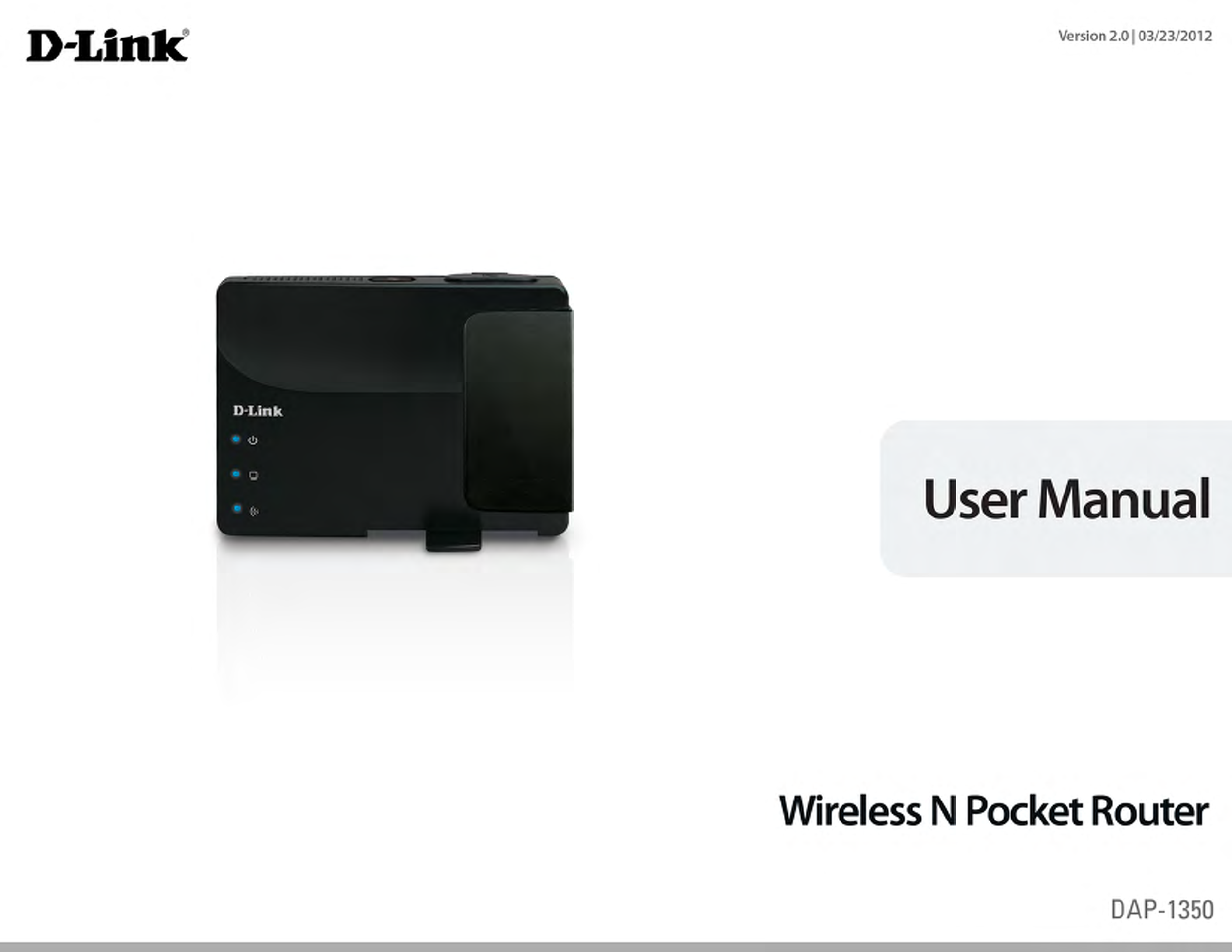

2D-Link DAP-1350 User Manual
Table of Contents
Product Overview .............................................................. 5
Package Contents ......................................................................... 5
System Requirements ................................................................. 6
Introduction ................................................................................... 7
Features ............................................................................................ 9
Hardware Overview ...................................................................10
Connections .........................................................................10
Side ..........................................................................................11
Bottom ....................................................................................11
LEDs .........................................................................................12
Installation .......................................................................13
Operation Modes ........................................................................13
Access Point Mode .............................................................14
Wireless Client Mode .........................................................15
Router Mode .........................................................................16
Wireless Installation Considerations ....................................17
Conguration ...................................................................18
Access Point Mode .....................................................................18
Wireless Setup Wizard .......................................................19
Wireless Setup ......................................................................23
LAN Setup ..............................................................................25
IPV6 Settings.........................................................................26
MAC Address Filter .............................................................28
Advanced Wireless .............................................................29
Wi-Fi Protected Setup .......................................................30
Add Wireless Device With WPS .................................31
User Limit ...............................................................................33
Admin .....................................................................................34
System ....................................................................................35
Language Pack ................................................................36
Firmware ................................................................................36
Time .........................................................................................37
System Check .......................................................................38
Schedules ..............................................................................39
Device Info ............................................................................40
Logs .........................................................................................41
Statistics .................................................................................42
Wireless ..................................................................................43
IPv6 ..........................................................................................44
Help .........................................................................................45
Wireless Client Mode .................................................................46
Wireless Setup Wizard .......................................................47
Manual Wireless Setup ......................................................51
LAN Settings .........................................................................52
Advanced Wireless .............................................................53
Admin .....................................................................................54
System ....................................................................................55
Language Pack ................................................................56
Firmware ................................................................................56
Time .........................................................................................57
Device Info ............................................................................58
Logs .........................................................................................59
Statistics .................................................................................60
Table of Contents

3D-Link DAP-1350 User Manual
Table of Contents
Help .........................................................................................61
Router Mode ................................................................................62
Setup Wizard ........................................................................63
Internet Setup ......................................................................66
Dynamic IP (DHCP) ........................................................67
Static IP ..............................................................................68
PPPoE .................................................................................69
PPTP ....................................................................................70
L2TP ....................................................................................71
USB3G ................................................................................72
Wireless Setup Wizard .......................................................73
Wireless Settings .................................................................77
Network Settings ................................................................78
DHCP Server Settings ...................................................79
DHCP Reservation .........................................................80
USB Settings .........................................................................81
Virtual Server ........................................................................82
Application Rules ................................................................84
MAC Address Filter .............................................................85
Website Filters ......................................................................86
Firewall Settings ..................................................................87
Advanced Wireless Settings ............................................88
Wi-Fi Protected Setup .......................................................89
Add Wireless Device with WPS Wizard ...................90
UPnP Settings.......................................................................91
Guest Zone ............................................................................92
DMZ .........................................................................................93
IPV6 Settings.........................................................................94
Static IPv6 (Stateful) ......................................................94
Static IPv6 (Stateless) ....................................................95
Autoconguration IPv6 (Stateless) ..........................96
Autoconguration IPv6 (Stateful) ............................97
IPv6 over IPv4 Tunnel (Stateless) ..............................98
IPv6 over IPv4 Tunnel (Stateful) ................................99
6 to 4 Tunneling (Stateless) ..................................... 100
6 to 4 Tunneling (Stateful) ....................................... 101
Administrator Settings ................................................... 102
Time Settings .................................................................... 103
System Settings ................................................................ 104
Language Pack ............................................................. 105
Firmware Update ............................................................. 105
System Check .................................................................... 106
Schedules ........................................................................... 107
Device Information ......................................................... 108
Wireless ............................................................................... 109
Logs ...................................................................................... 110
Statistics .............................................................................. 111
Internet Sessions .............................................................. 112
IPv6 ....................................................................................... 114
Help ...................................................................................... 115
Wireless Security ...........................................................116
What is WEP? ............................................................................. 116
What is WPA? ............................................................................. 117
Congure WEP .......................................................................... 118
Congure WPA/WPA2 Personal .......................................... 119
Congure WPA/WPA2 Enterprise ....................................... 120

4D-Link DAP-1350 User Manual
Table of Contents
Connect to a Wireless Network .....................................121
Using Windows® 7 ................................................................... 121
Congure WPS .................................................................. 124
Using Windows Vista® ............................................................ 128
Congure WEP .......................................................................... 130
Congure WPA-PSK ................................................................. 131
Using Windows® XP ................................................................. 132
Congure WEP .......................................................................... 133
Congure WPA-PSK ................................................................. 135
Troubleshooting ............................................................137
Wireless Basics ...............................................................141
What is Wireless? ...................................................................... 142
Tips ................................................................................................ 144
Wireless Modes ......................................................................... 145
Networking Basics .........................................................146
Check your IP address ............................................................ 146
Statically Assign an IP address ............................................ 147
Technical Specications ................................................148
Warranty .........................................................................149
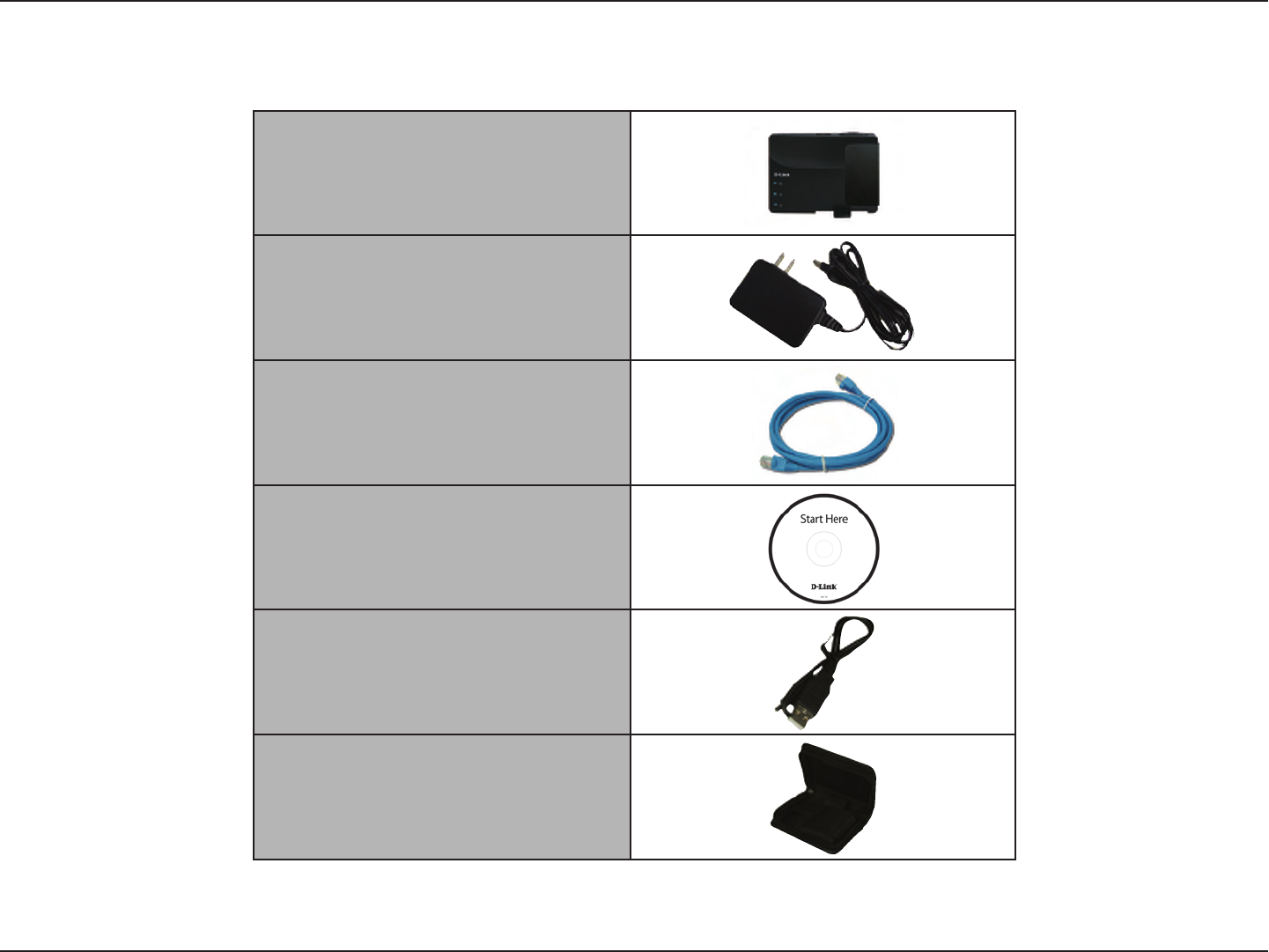
5D-Link DAP-1350 User Manual
Section 1 - Product Overview
Product Overview
Note: Using a power supply with a dierent voltage rating than the one included with the DAP-1350 will cause damage and void the warranty for this product.
D-Link DAP-1350
Wireless N
Pocket Router/Access Point
Power Adapter
Ethernet Cable
CD-ROM
USB Power Cable
Travel Case
Package Contents

6D-Link DAP-1350 User Manual
Section 1 - Product Overview
Network Requirements
• An Ethernet-based Cable or DSL modem (router mode only)
• IEEE 802.11n or 802.11g wireless clients (router or AP mode)
• IEEE 802.11n or 802.11g wireless AP or router (client mode)
• 10/100 Ethernet
Web-based Conguration
Utility Requirements
Computer with the following:
• Windows®, Macintosh®, or Linux-based operating system
• An installed Ethernet adapter
Browser Requirements:
• Internet Explorer 6.0 or higher
• Firefox 3.0 or higher
• Safari 3.0 or higher
• Chrome 2.0 or higher
Windows® Users: Make sure you have the latest version of Java installed. Visit www.
java.com to download the latest version.
CD Installation Wizard
Requirements
Computer with the following:
• Windows® 7, Vista®, or XP (with Service Pack 2 or higher)
• An installed Ethernet adapter
• CD-ROM drive
System Requirements

7D-Link DAP-1350 User Manual
Section 1 - Product Overview
Introduction
D-Link, an industry leader in networking, introduces the new D-Link DAP-1350 Wireless N Router/Access Point. With the ability
to transfer les with a maximum wireless signal rate of up to 300Mbps*, the DAP-1350 gives you high-speed wireless network
access for your home or when you travel.
The DAP-1350 is Wi-Fi IEEE 802.11n compliant, meaning that it can connect and interoperate with other 802.11n compatible
wireless client devices. The DAP-1350 is also backwards compatible with 802.11b/g. It can be exibly congured to operate in
3 dierent modes: Access Point, Wireless Client, and Router. With its Setup Wizard, the DAP-1350 ensures that you will be
up and running on a wireless network in just a matter of minutes.
The DAP-1350 features Wi-Fi Protected Access (WPA-PSK/WPA2-PSK) to provide an enhanced level of security for wireless
data communications. The DAP-1350 also includes additional security features to keep your wireless connection safe from
unauthorized access.
The DAP-1350 supports WPS on all three operation modes, with each capable of being conveniently set up by using the PIN
method or Push Button.
• Actual data throughput will vary. Network conditions and environmental factors, including volume of network trac, building materials and construction, and network
overhead, lower actual data throughput rate.

8D-Link DAP-1350 User Manual
Section 1 - Product Overview
TOTAL PERFORMANCE
Combines award winning access point features and 802.11n wireless technology to provide the best wireless performance.
TOTAL SECURITY
The most complete set of security features including WPA/WPA2 encryption to protect your network against outside intruders.
TOTAL COVERAGE
Provides greater wireless signal rates even at farther distances for best-in-class Whole Home Coverage.
ULTIMATE PERFORMANCE
The D-Link Wireless N Pocket Router/Access Point (DAP-1350) is a 802.11n compliant device that delivers real world performance
of up to 650% faster than an 802.11g wireless connection (also faster than a 100Mbps wired Ethernet connection). Create a
secure wireless network to share photos, les, music, video, printers, and network storage throughout your home. Connect the
DAP-1350 to router and share your high-speed Internet access with everyone on the network.
EXTENDED WHOLE HOME COVERAGE
This high performance Wireless AP provides superior Whole Home Coverage while reducing dead spots. The DAP-1350 is designed for
use in bigger homes and for users who demand higher performance networking.
TOTAL NETWORK SECURITY
The DAP-1350 supports all of the latest wireless security features to prevent unauthorized access, be it from over the wireless network
or from the Internet. Support for WPA and WPA2 standards ensure that you’ll be able to use the best possible encryption method,
regardless of your client devices.
* Maximum wireless signal rate derived from IEEE Standard 802.11g, 802.11a and 802.11n specications. Actual data throughput will vary. Network conditions and environmental
factors, including volume of network trac, building materials and construction, and network overhead, lower actual data throughput rate. Environmental conditions will
adversely aect wireless signal range.

9D-Link DAP-1350 User Manual
Section 1 - Product Overview
• Faster Wireless Networking - The DAP-1350 provides up to 300Mbps* wireless connection with other 802.11n wireless
clients. This capability allows users to participate in real-time activities online, such as video streaming, online gaming,
and real-time audio. The performance of this 802.11n wireless access point gives you the freedom of wireless networking
at speeds 650% faster than 802.11g.
• Compatible with 802.11b and 802.11g Devices - The DAP-1350 is still fully compatible with the 802.11b/g standards,
so it can connect with existing 802.11b/g PCI, USB, and Cardbus adapters.
• WPS PBC- (Wi-Fi Protected Setup Push Button Conguration) Push Button Conguration is a button that can be pressed
to add the device to an existing network or to create a new network. A virtual button can be used on the utility while
a physical button is placed on the side of the device.
This easy setup method allows you to form a secured wireless link between the DAP-1350 and another WPS enabled
device. A PC is no longer needed to log into the Web-based interface.
• WPS PIN - (Wi-Fi Protected Setup Personal Identication Number ) A PIN is a unique number that can be used to add
the access point to an existing network or to create a new network. The default PIN may be printed on the bottom of
the access point. For extra security, a new PIN can be generated. You can restore the default PIN at any time. Only the
Administrator (“admin” account) can change or reset the PIN.
• User-friendly Setup Wizard - Through its easy-to-use web-based user interface, you can congure your access point
to your specic settings within minutes.
Features
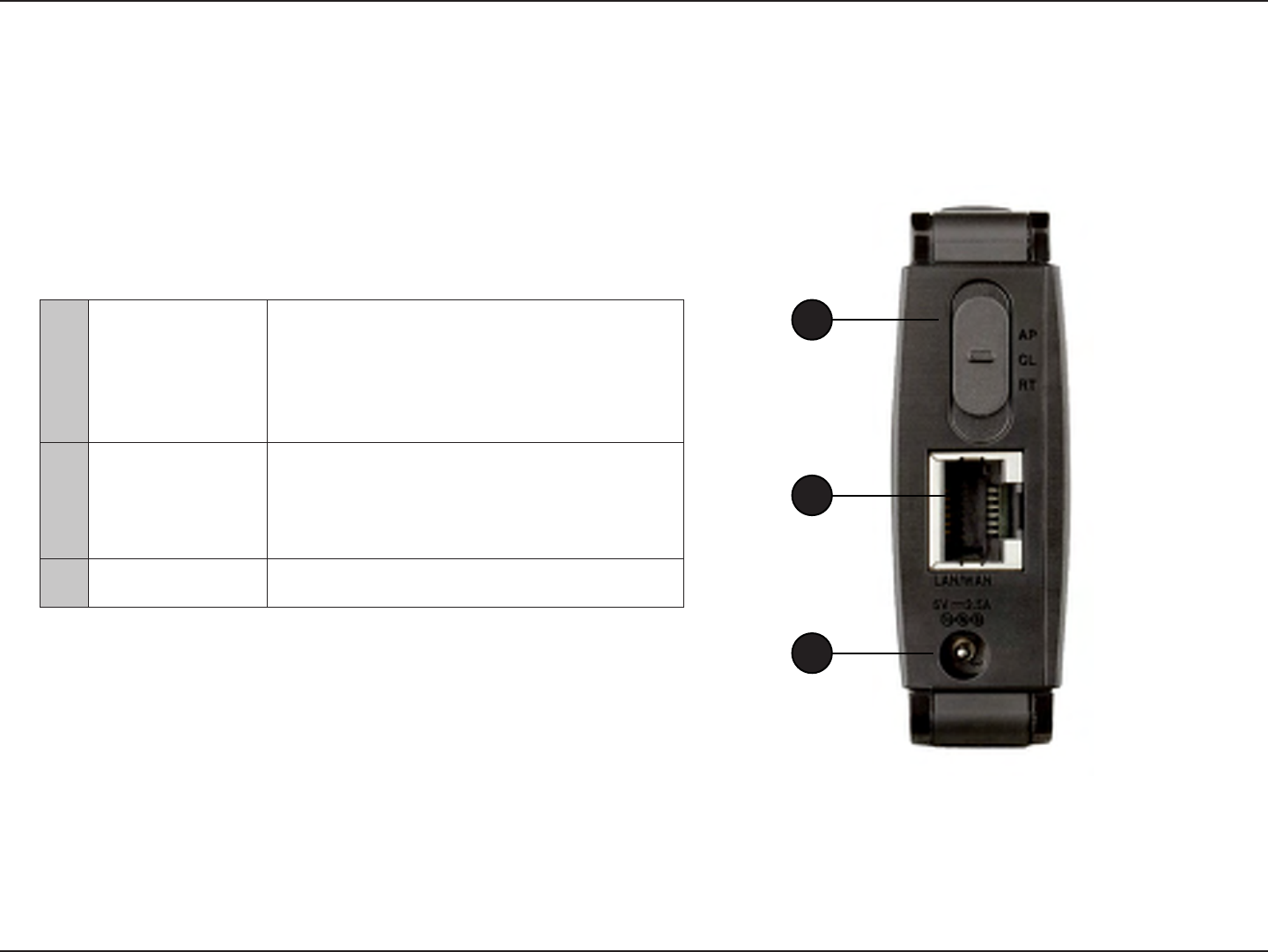
10D-Link DAP-1350 User Manual
Section 1 - Product Overview
Hardware Overview
Connections
1Mode Selector
Mode Selector
Select from one of the three modes:
AP (top) - Access Point (AP) Mode
CL (middle) - Wireless Client Mode
RT (bottom) - Router Mode
2LAN/WAN Port
When using as a LAN port, connect Ethernet
devices such as computers or game consoles.
When using as a WAN port, connect your
Broadband modem or Internet connection.
3Power Receptor Receptor for the supplied power adapter.
1
3
2
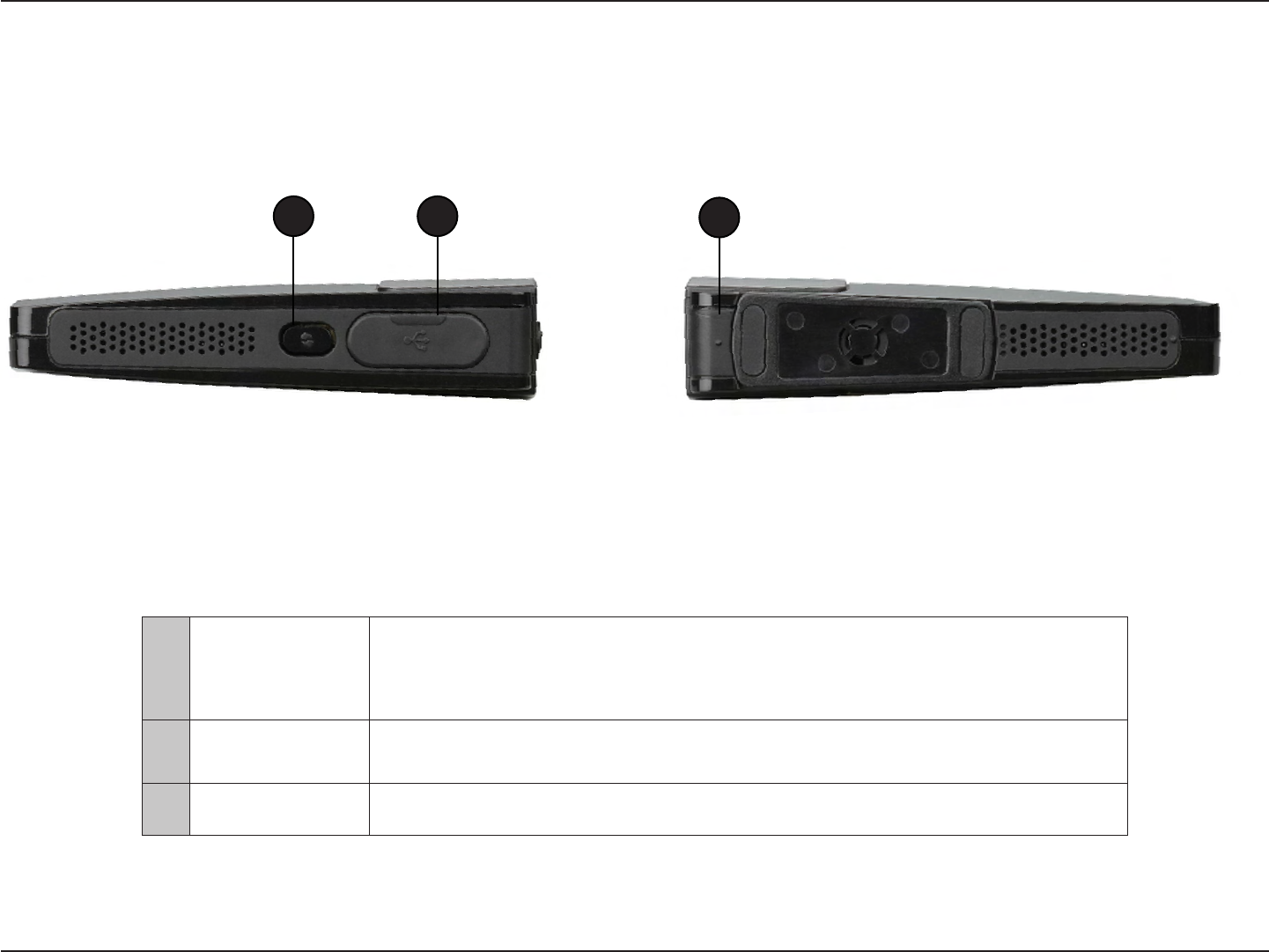
11D-Link DAP-1350 User Manual
Section 1 - Product Overview
Hardware Overview
1WPA Button/LED
Press to start the WPS process. You will have 120 seconds to start the WPS process on
another wireless device. When enabling WPS, the light will blink during broadcast.
Once connected, the LED will stay solid for 5 seconds and then turn o.
2USB Port The USB port is used to connect USB devices such as a printer to share on your
network.
3Reset Button Press and hold to reset the device back to the factory default settings
Bottom
3
Side
1 2
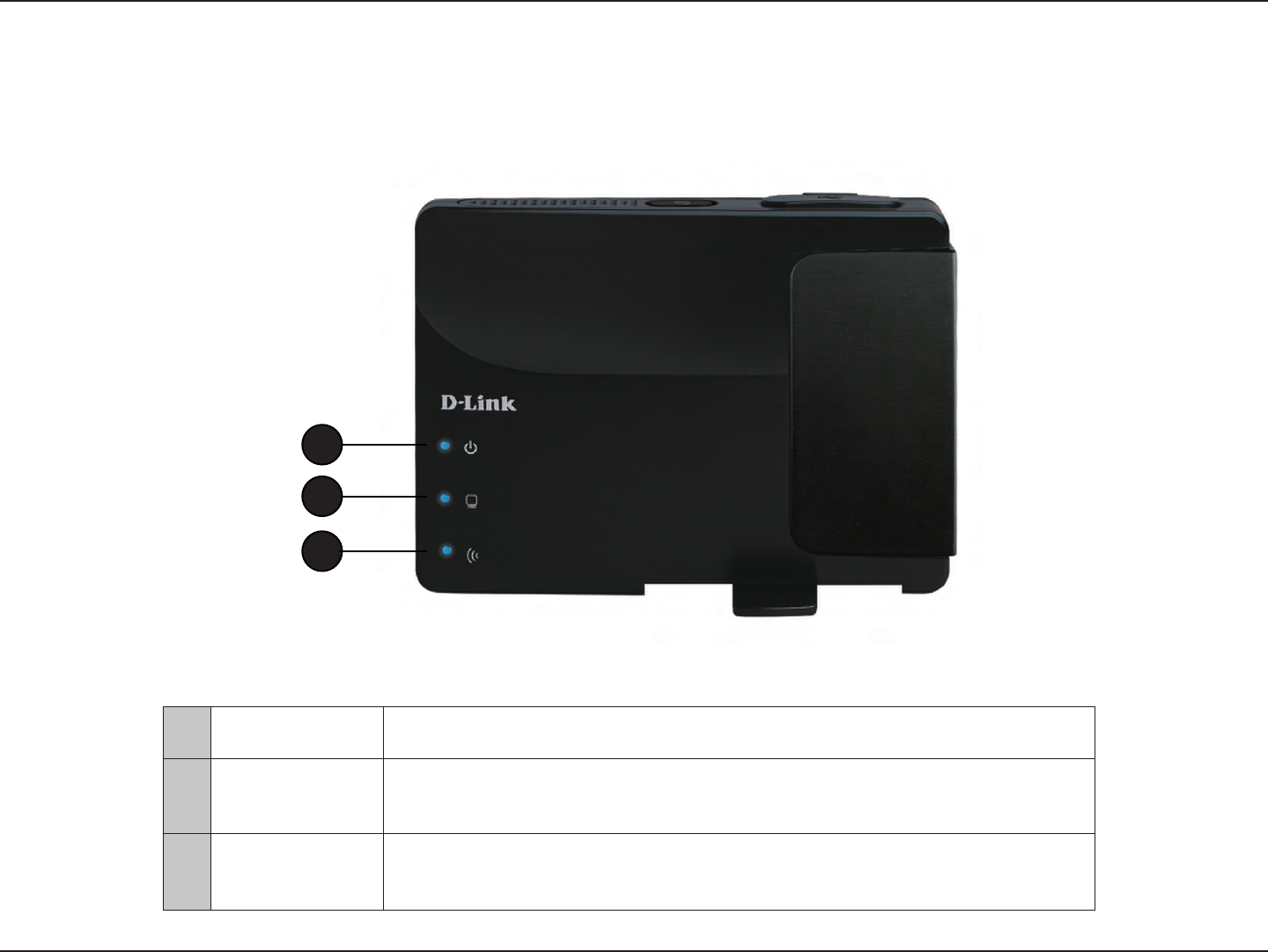
12D-Link DAP-1350 User Manual
Section 1 - Product Overview
Hardware Overview
LEDs
1Power LED A solid light indicates a proper connection to the power supply.
2LAN/WAN LED A solid light indicates a connection to an Ethernet-enabled device. This LED
blinks during data transmission.
3Wireless LED A solid light indicates that the wireless segment is ready. This LED blinks during
wireless data transmission.
3
1
2

13D-Link DAP-1350 User Manual
Section 2 - Installation
Installation
Please congure the DAP-1350 by following the Install Guide poster. The next few pages will explain the dierent operational
modes you can use.
Operation Modes
Depending on how you want to use your DAP-1350 will determine which mode you use. This section will help you gure out
which setting works with your setup.
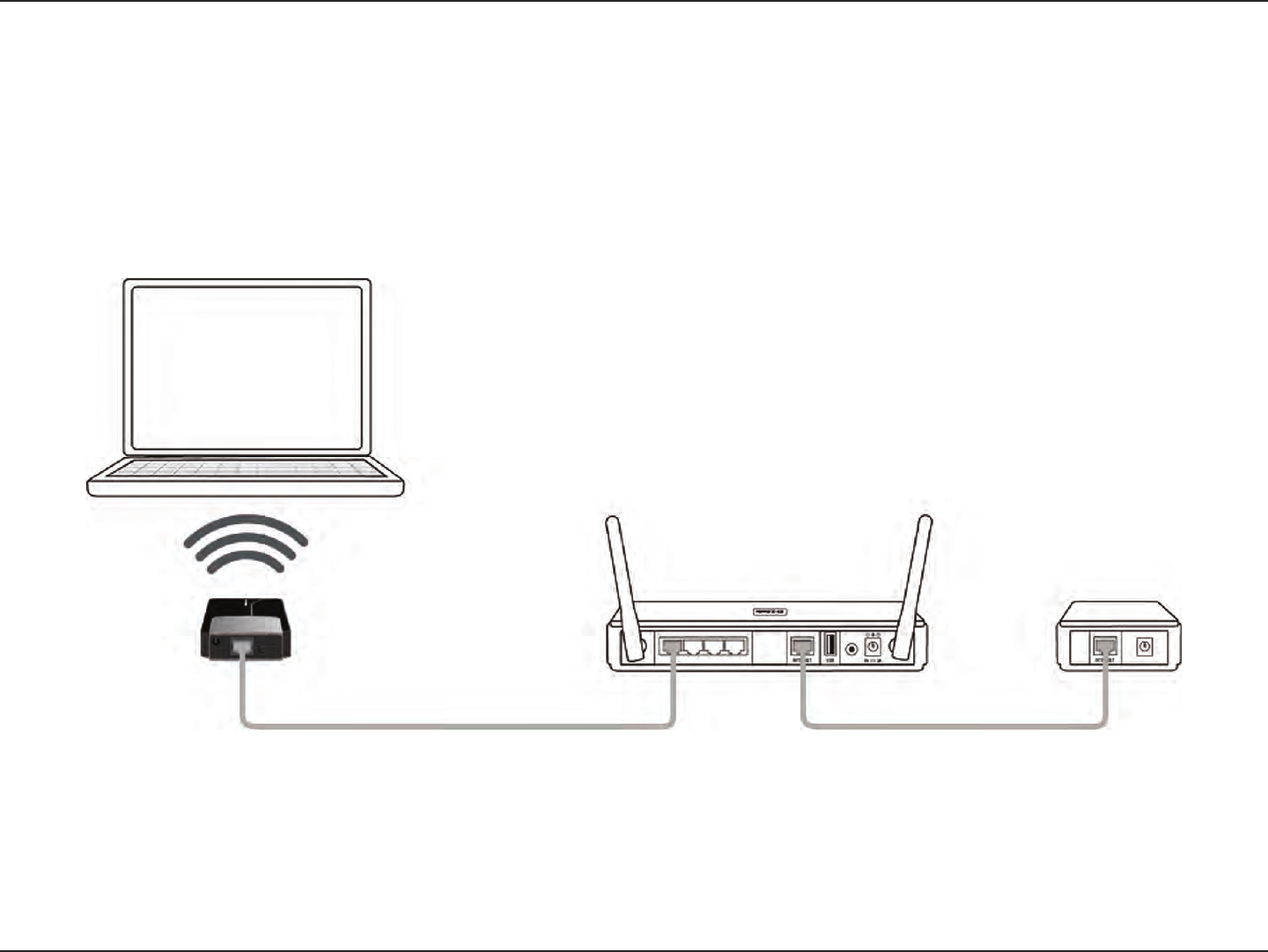
14D-Link DAP-1350 User Manual
Section 2 - Installation
Access Point Mode
In the Access Point mode, the DAP-1350 acts as a central connection point for any computer (client) that has a 802.11n or
backward-compatible 802.11b/g wireless network interface and is within range of the AP. Clients must use the same SSID
(wireless network name) and channel as the AP in order to connect. If wireless security is enabled on the AP, the client will need
to enter a password to connect to the AP. In Access Point mode, multiple clients can connect to the AP at the same time.
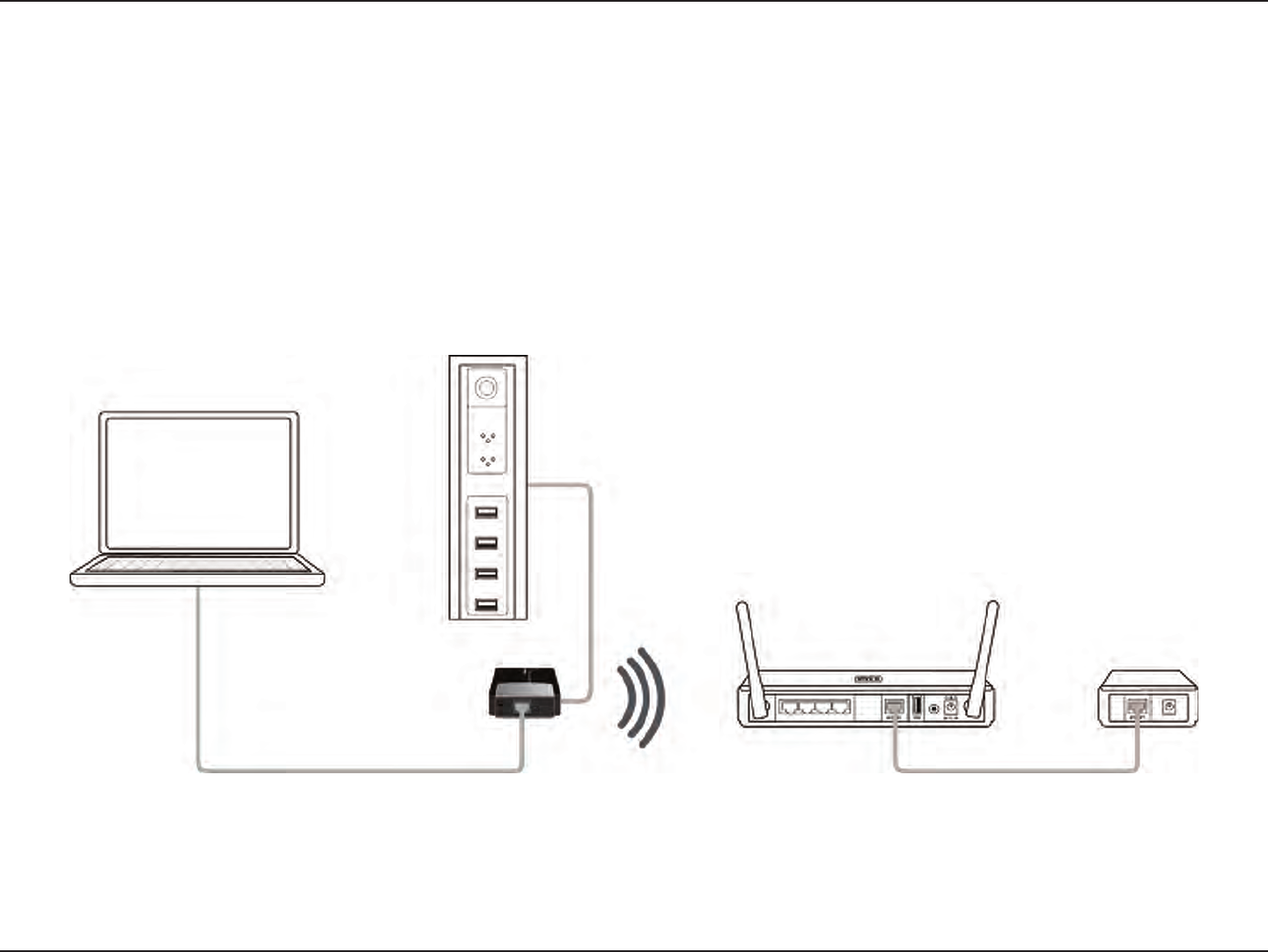
15D-Link DAP-1350 User Manual
Section 2 - Installation
Wireless Client Mode
In the Wireless Client mode, the DAP-1350 acts as a wireless network adapter for your Ethernet-enabled device (such as a
game console or a laptop). Connect your Ethernet-enabled device to the AP using an Ethernet cable. The AP Client mode can
support one wired client.
Example: Connect a gaming console using an Ethernet cable to the DAP-1350. The unit is set to Wireless Client mode which
will wirelessly connect to a wireless router on your network.
OR
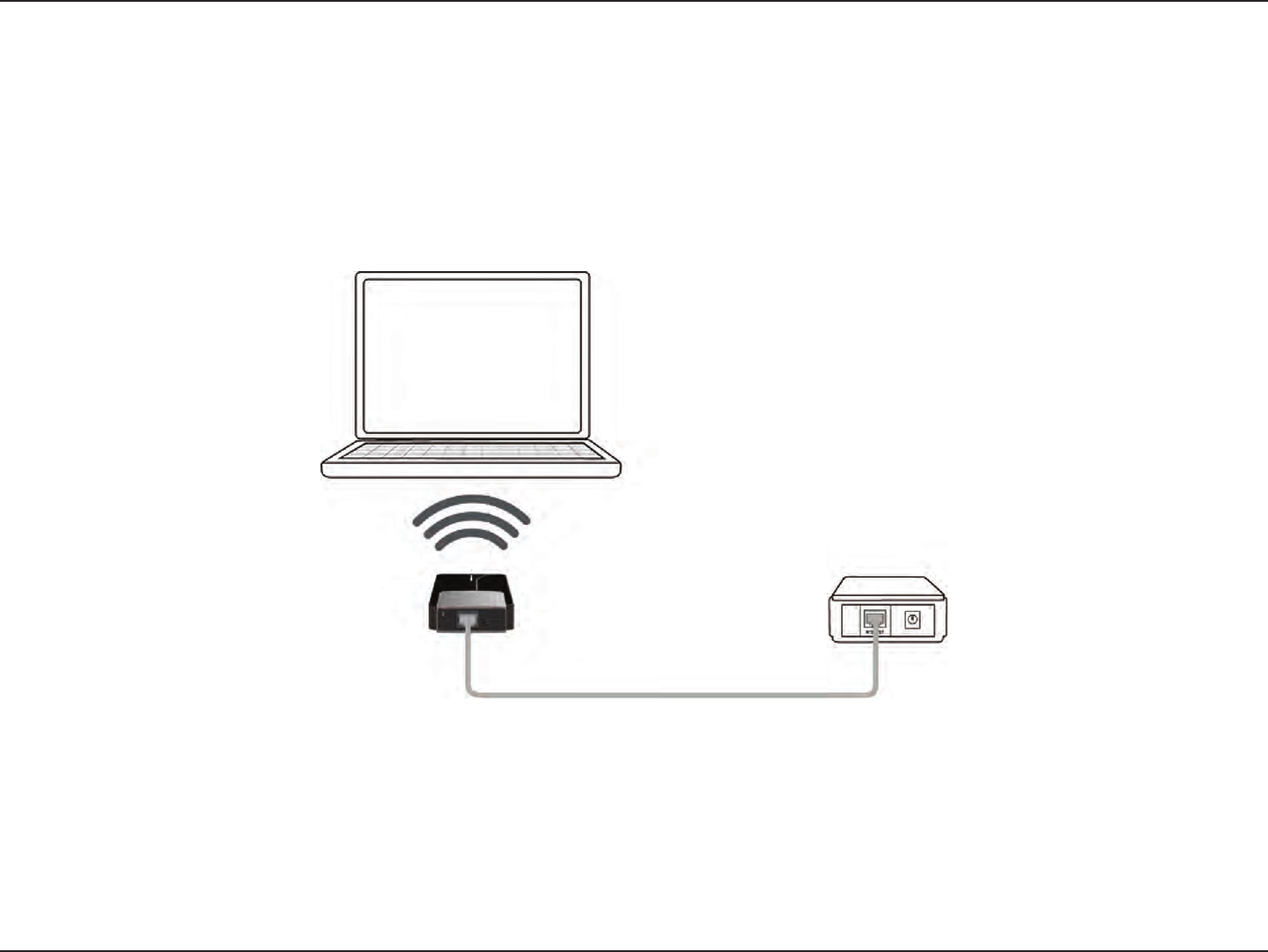
16D-Link DAP-1350 User Manual
Section 2 - Installation
Router Mode
In the Router mode, the DAP-1350 connects to a broadband modem. In this mode, the DAP-1350 also acts as a router for
wireless clients on your network and provides NAT (Network Address Translation) and a DHCP server to generate IP addresses.
NAT and the DHCP server allow many computers to share the same Internet connection.

17D-Link DAP-1350 User Manual
Section 2 - Installation
Wireless Installation Considerations
The D-Link wireless access point lets you access your network using a wireless connection from virtually anywhere within the
operating range of your wireless network. Keep in mind, however, that the number, thickness and location of walls, ceilings,
or other objects that the wireless signals must pass through, may limit the range. Typical ranges vary depending on the types
of materials and background RF (radio frequency) noise in your home or business. The key to maximizing wireless range is to
follow these basic guidelines:
1. Keep the number of walls and ceilings between the D-Link access point and other network devices to a minimum.
Each wall or ceiling can reduce your adapter’s range from 3-90 feet (1-30 meters.) Position your devices so that
the number of walls or ceilings is minimized.
2. Be aware of the direct line between network devices. A wall that is 1.5 feet thick (.5 meters), at a
45-degree angle appears to be almost 3 feet (1 meter) thick. At a 2-degree angle it looks over 42 feet (14 meters)
thick! Position devices so that the signal will travel straight through a wall or ceiling (instead of at an angle) for
better reception.
3. Building Materials make a dierence. A solid metal door or aluminum studs may have a negative eect on
range. Try to position access points, wireless access points, and computers so that the signal passes through
drywall or open doorways. Materials and objects such as glass, steel, metal, walls with insulation, water (sh
tanks), mirrors, le cabinets, brick, and concrete will degrade your wireless signal.
4. Keep your product away (at least 3-6 feet or 1-2 meters) from electrical devices or appliances that generate RF
noise.
5. If you are using 2.4GHz cordless phones or X-10 (wireless products such as ceiling fans, lights, and home security
systems), your wireless connection may degrade dramatically or drop completely. Make sure your 2.4GHz phone
base is as far away from your wireless devices as possible. The base transmits a signal even if the phone is not
in use.
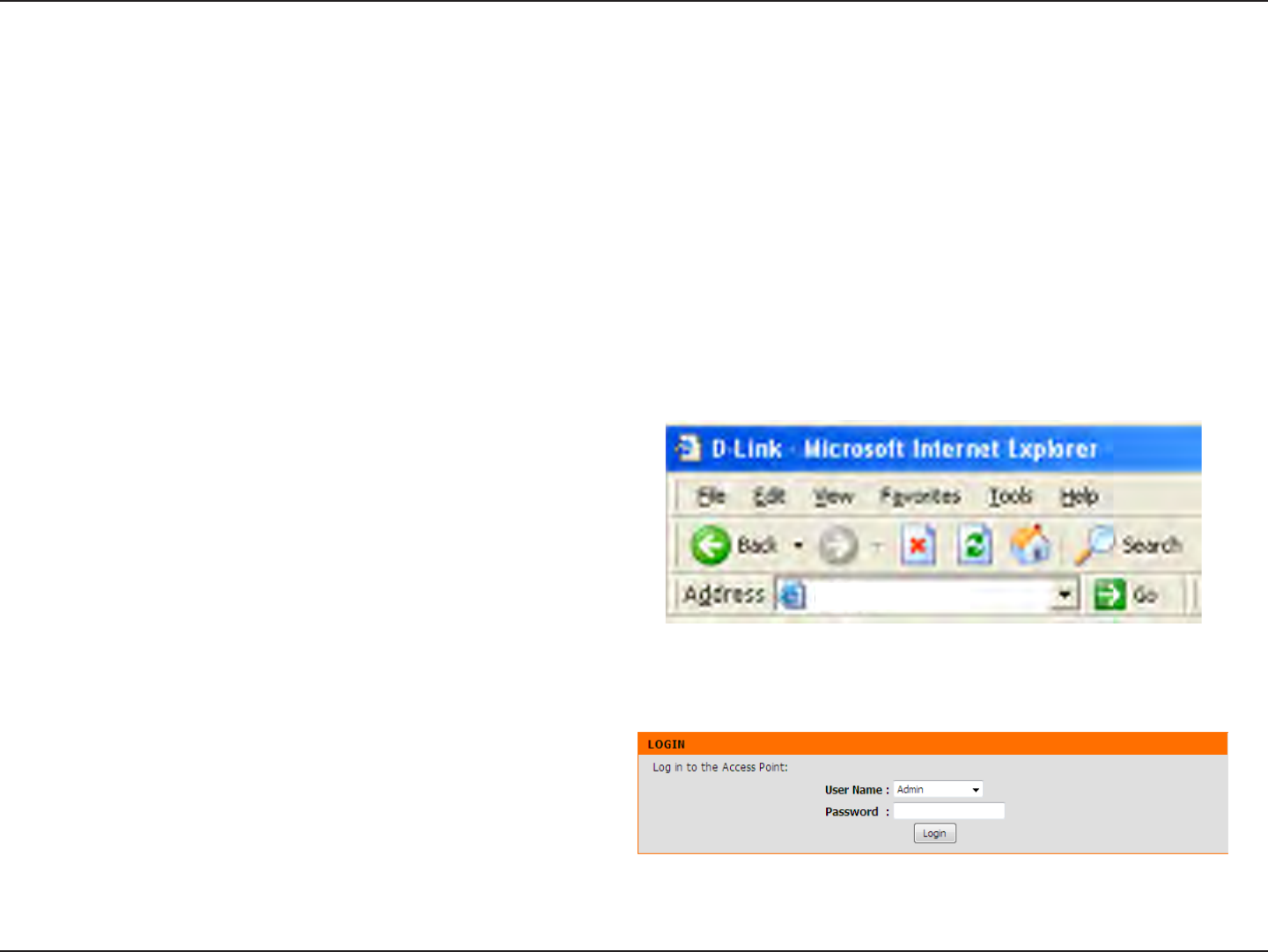
18D-Link DAP-1350 User Manual
Section 3 - Conguration
Conguration
This section will show you how to congure your new D-Link wireless access point using the web-based conguration
utility.
Access Point Mode
If you wish to change the default settings or optimize the
performance of the DAP-1350, you may use the web-based
conguration utility.
To access the conguration utility, open a web browser
such as Internet Explorer and enter http://dlinkap or
http://192.168.0.50 in the address eld.
Enter your password. Leave the password blank by default.
If you get a Page Cannot be Displayed error, please refer to
the Troubleshooting section for assistance.
Change the mode selector to AP on the device. Connect an Ethernet cable from the Ethernet port on the DAP-1350 to a
computer for conguration.
http://dlinkap
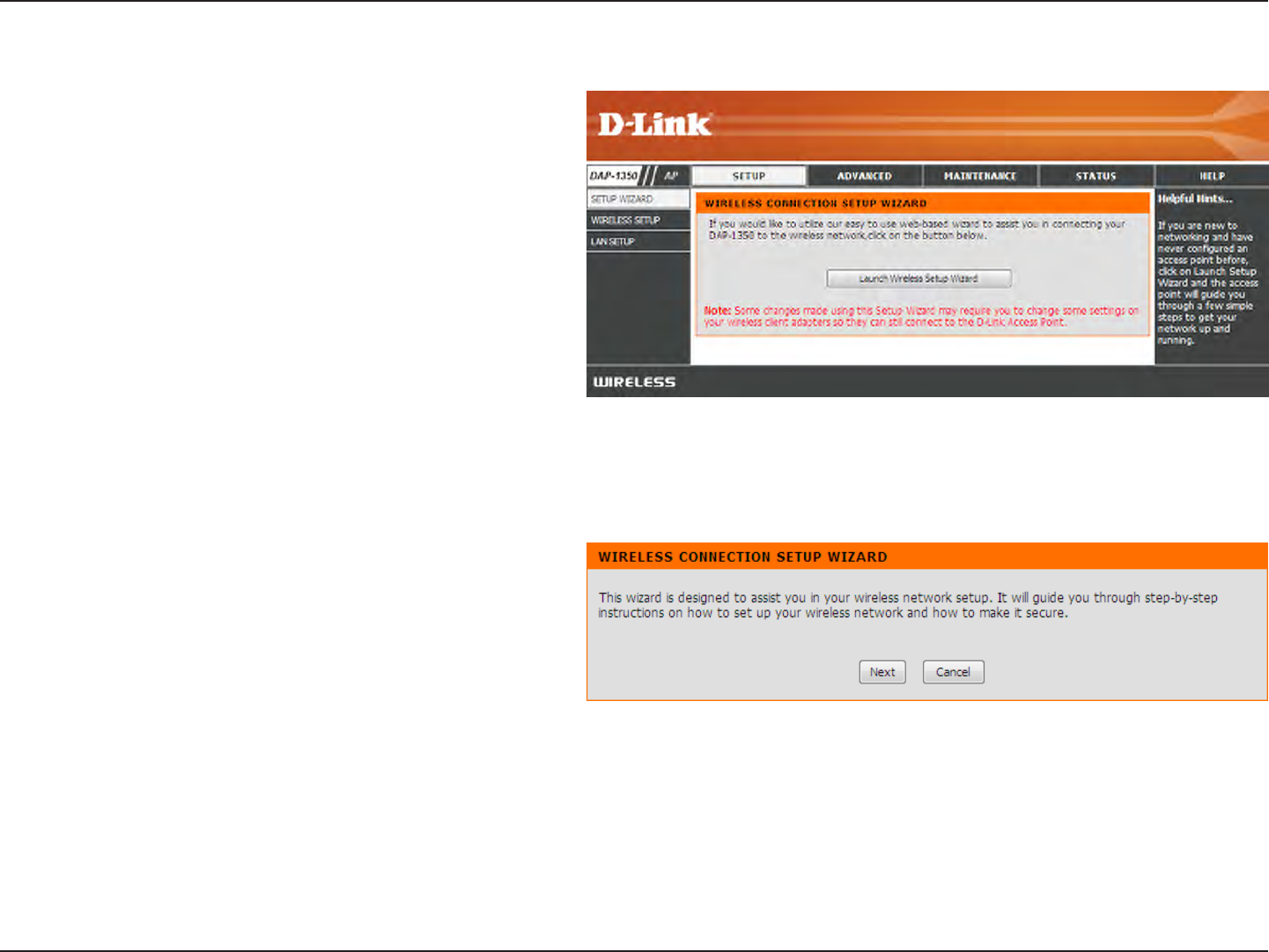
19D-Link DAP-1350 User Manual
Section 3 - Conguration
Click Launch Wireless Setup Wizard to congure your
access point and skip to the next page.
If you want to enter your settings without running the
wizard, click Wireless Setup on the left side and skip
to page 25.
Wireless Setup Wizard
Click Next to continue.
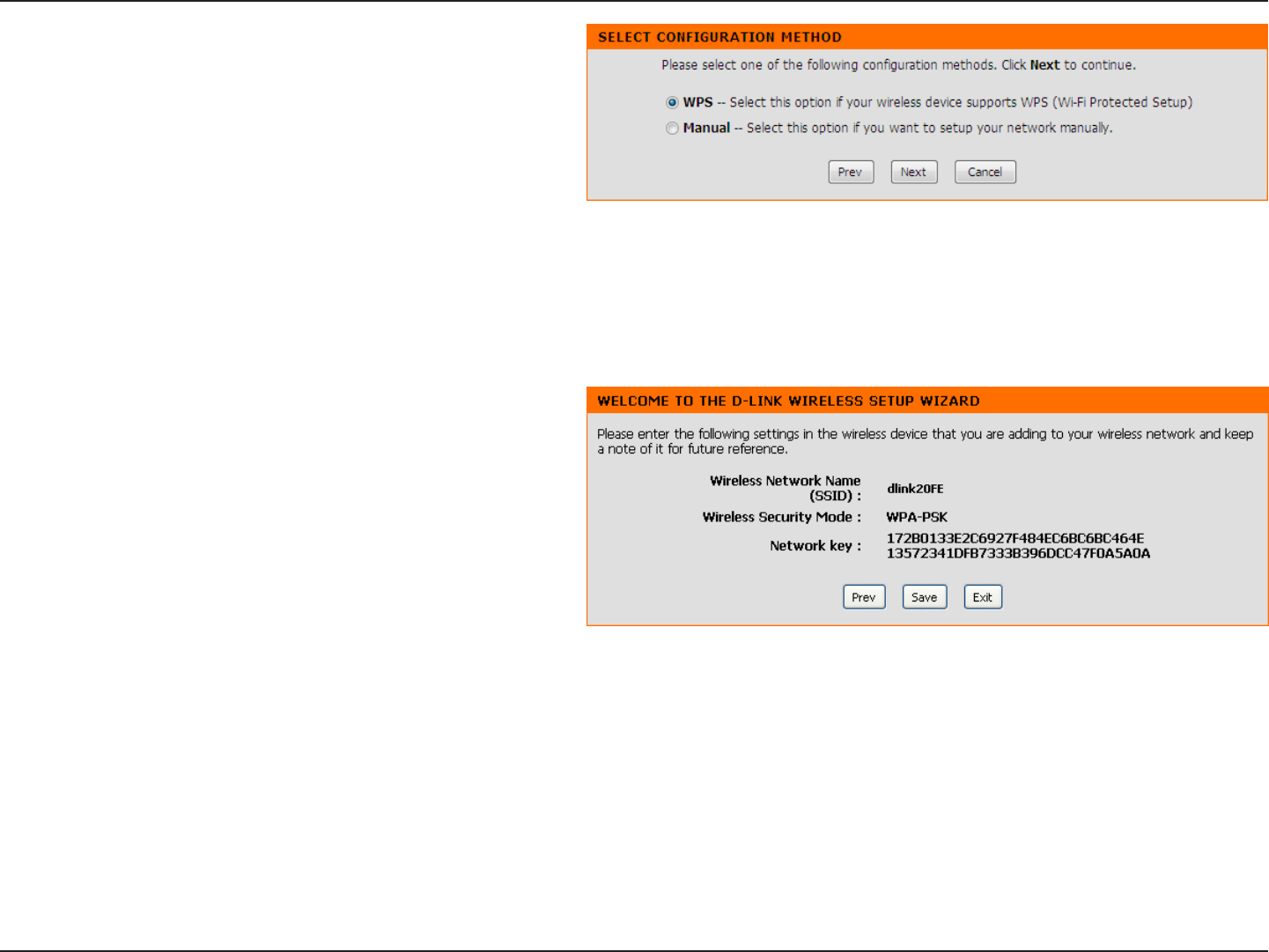
20D-Link DAP-1350 User Manual
Section 3 - Conguration
Click Save to save your network settings.
In order for your network settings to take eect the AP
will reboot automatically.
When the device has nished rebooting the main screen
will display.
Select WPS as the conguration method only if your
wireless device supports Wi-Fi Protected Setup (WPS).
For Manual setup, skip to the next step.
Click Next to continue.
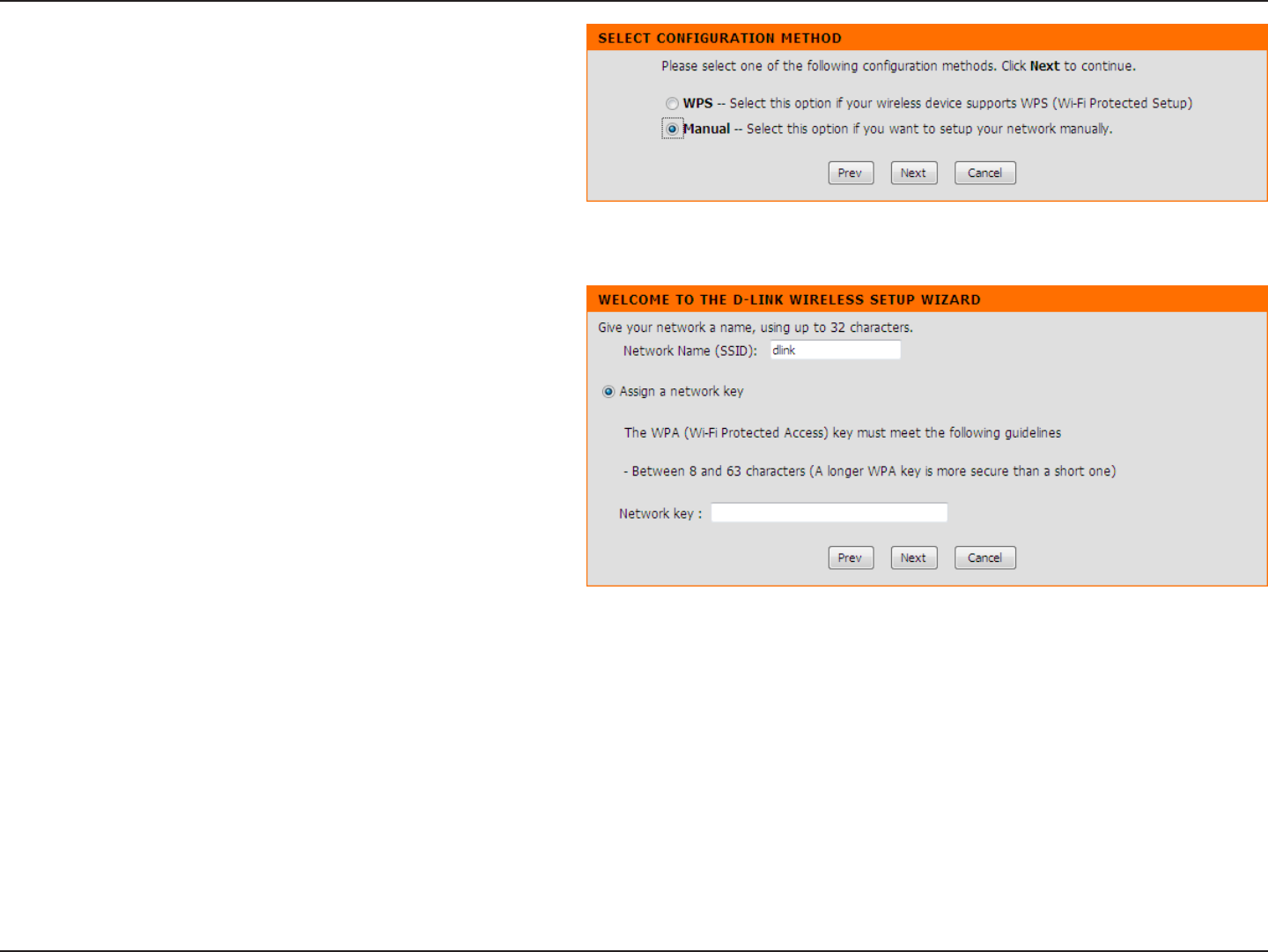
21D-Link DAP-1350 User Manual
Section 3 - Conguration
Select Manual as the conguration method to set up
your network manually.
Click Next to continue.
Enter a name for your wireless network (SSID). This
name can be up to 32 characters and is case-sensitive.
Enter your network key (passphrase).
Click Next to continue.
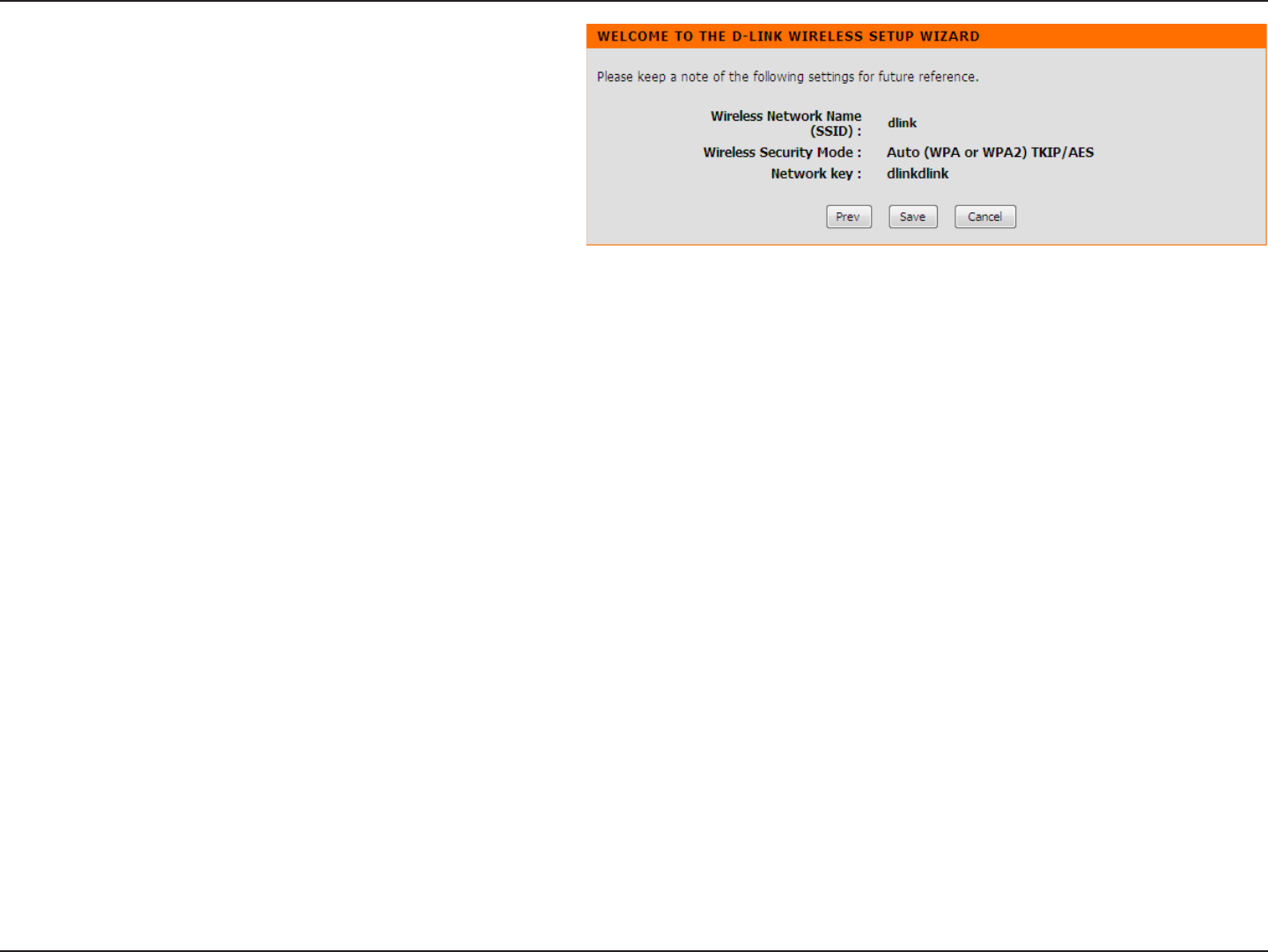
22D-Link DAP-1350 User Manual
Section 3 - Conguration
The following screen will show you your network key to
enter on your wireless clients.
Click Save to nish the Setup Wizard.
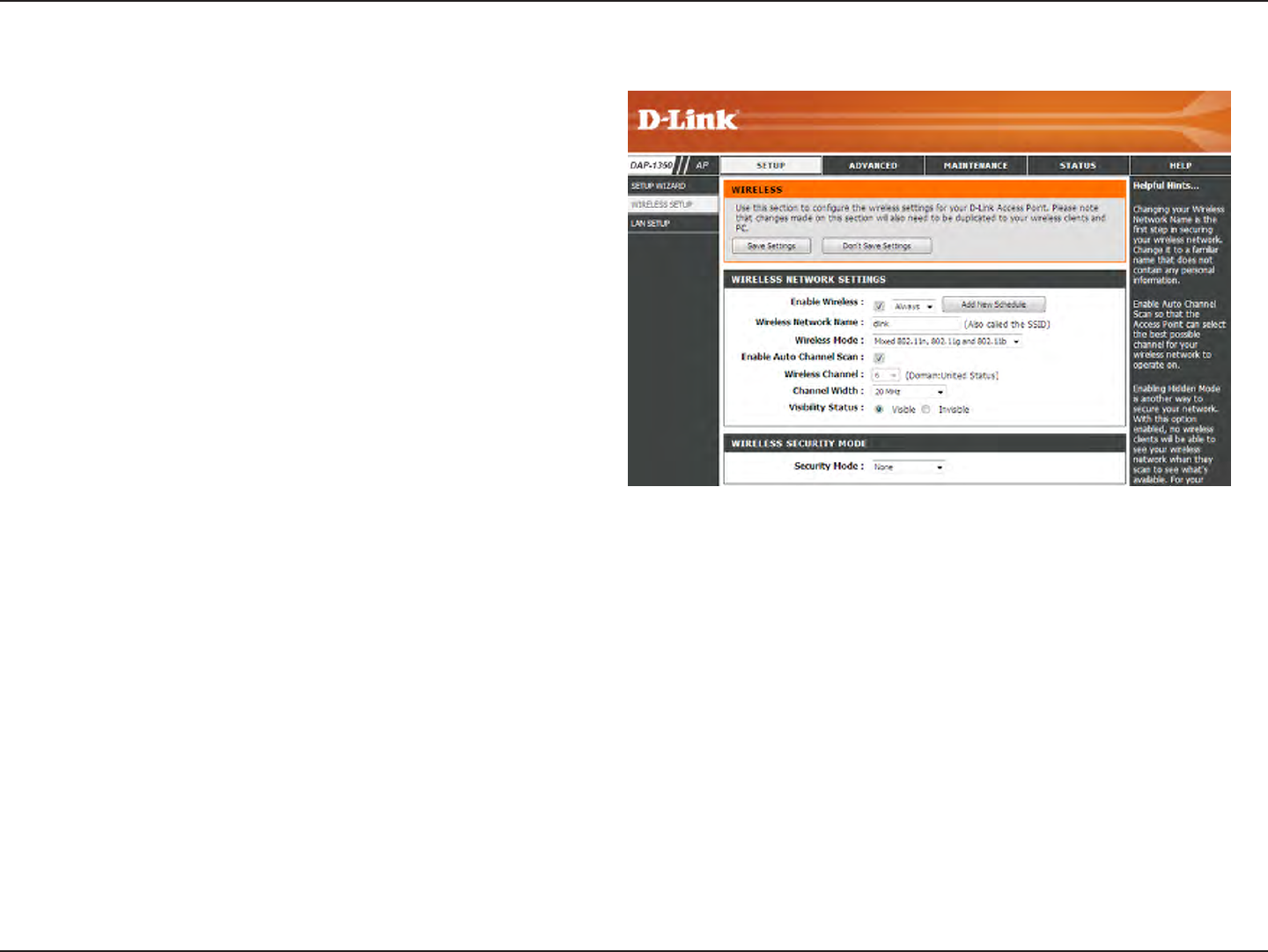
23D-Link DAP-1350 User Manual
Section 3 - Conguration
Enable Wireless:
Wireless
Network Name:
Wireless Mode:
Enable Auto
Channel Scan:
Wireless
Channel:
Check the box to enable the wireless function. If you
do not want to use wireless, uncheck the box to disable
all the wireless functions. You may also set up a specic
time range (schedule). Select a schedule from the drop
down menu or click Add New Schedule to create a
new schedule.
When you are browsing for available wireless networks,
this is the name that will appear in the list (unless
Visibility Status is set to Invisible, see below). This name
is also referred to as the SSID. For security purposes,
it is highly recommended to change from the default
network name.
Select one of the following:
802.11n Only - Select if you are only using 802.11n
wireless clients.
Mixed 802.11n and 802.11g - Select if you are using
a mix of 802.11n and 11g wireless clients.
Mixed 802.11n, 802.11g and 802.11b - Select if
you are using a mix of 802.11n, 11g, and 11b wireless
clients.
The Auto Channel Scan setting can be selected to
allow the DAP-1350 to select the channel with the least
amount of interference (during boot-up).
Indicates the channel setting for the DAP-1350. The
Channel can be changed to t the channel setting
for an existing wireless network or to customize the
wireless network. If you enable Auto Channel Scan,
this option will be grayed out.
Wireless Setup

24D-Link DAP-1350 User Manual
Section 3 - Conguration
Select the Channel Width:
Auto 20/40 - Select if you are using both 802.11n and non-802.11n wireless devices.
20MHz - Select if you are not using any 802.11n wireless clients.
Select Invisible if you do not want the SSID of your wireless network to be broadcasted by the DAP-1350. If checked, the SSID of
the DAP-1350 will not be seen by Site Survey utilities so your wireless clients will have to know the SSID of your DAP-1350 in order
to connect to it.
Channel Width:
Visibility Status:
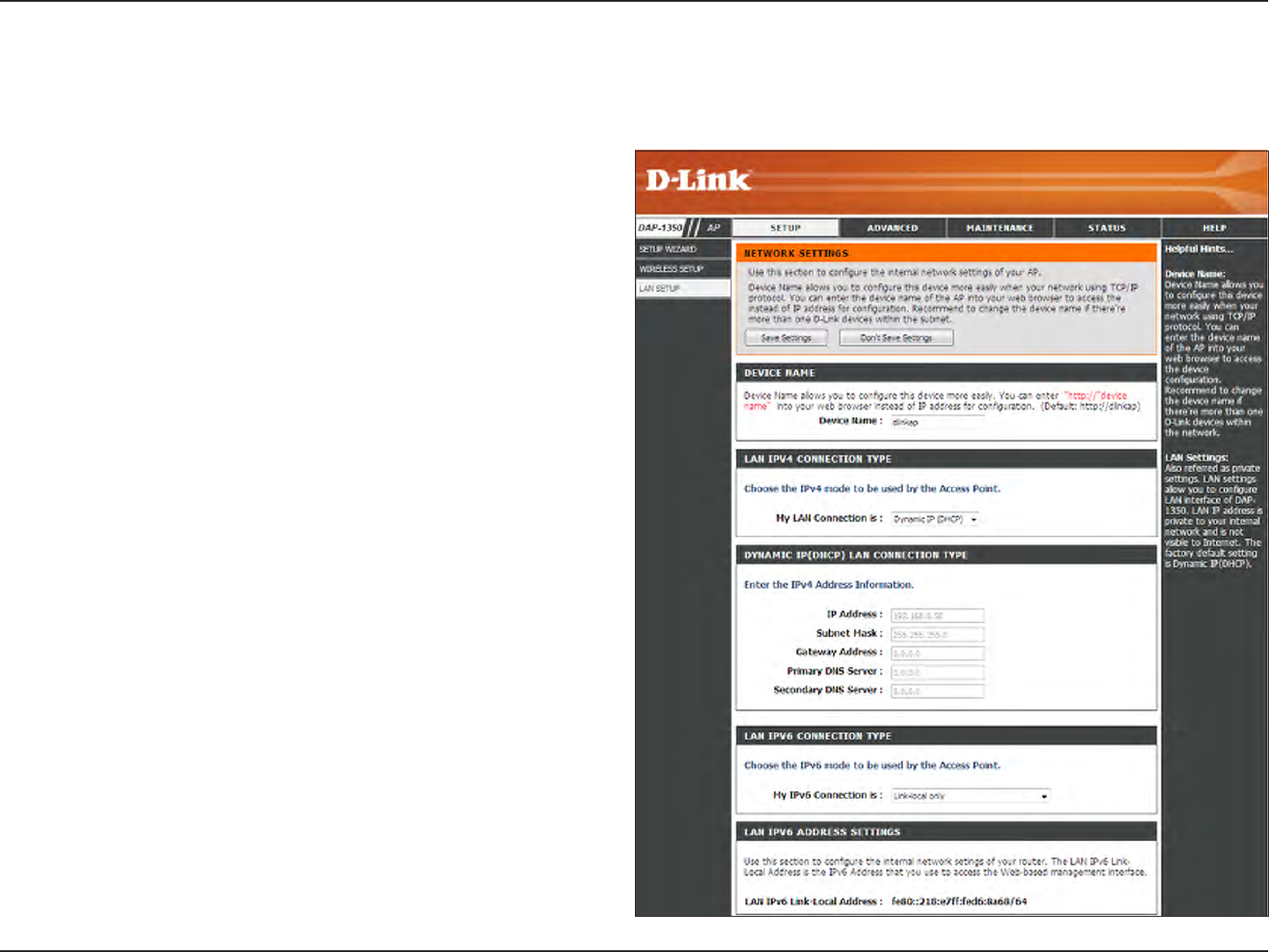
25D-Link DAP-1350 User Manual
Section 3 - Conguration
LAN Setup
This section will allow you to change the local network settings of the access point and to congure the DHCP settings.
Device Name:
My LAN
Connection Is:
IP Address:
Subnet Mask:
Default Gateway:
Enter the Device Name of the AP. It is recommended
to change the Device Name if there is more than one
D-Link device within the subnet.
Use the drop-down menu to select Dynamic IP (DHCP)
to automatically obtain an IP address on the LAN/
private network.
Select Static IP to manually enter the IP settings of
your access point.
(For Static IP only) - Enter the IP address of the access
point. The default IP address is 192.168.0.50. If you
change the IP address, once you click Apply, you will
need to enter the new IP address in your browser to
get back into the conguration utility.
(For Static IP only) - Enter the Subnet Mask.
(For Static IP only) - Enter the Gateway. This is usually
the LAN or internal IP address of your router.
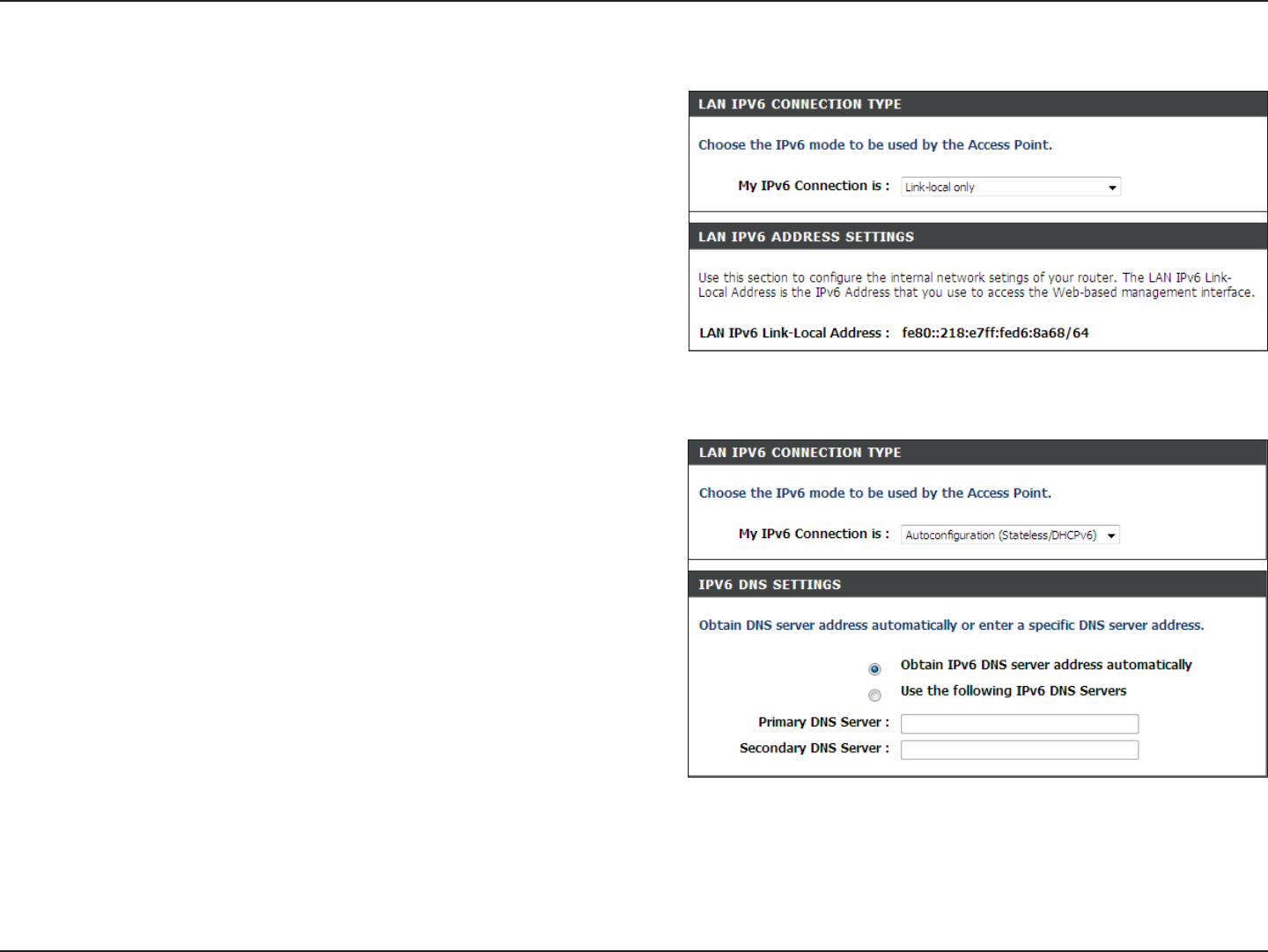
26D-Link DAP-1350 User Manual
Section 3 - Conguration
IPV6 Settings
My LAN
Connection Is:
LAN IPV6 Settings:
My LAN
Connection Is:
LAN IPV6 Settings:
Select Link-Local Only from the drop-down menu.
Displays the IPv6 address of the router.
Select Autoconguration (Stateless/DHCP v6) from
the drop-down menu.
Click Obtain IPv6 DNS server address automatically
to have your router or DHCP server assign the DNS
servers to your access point or click Use the following
IPv6 DNS Servers to manually enter the primary and
secondary DNS servers.
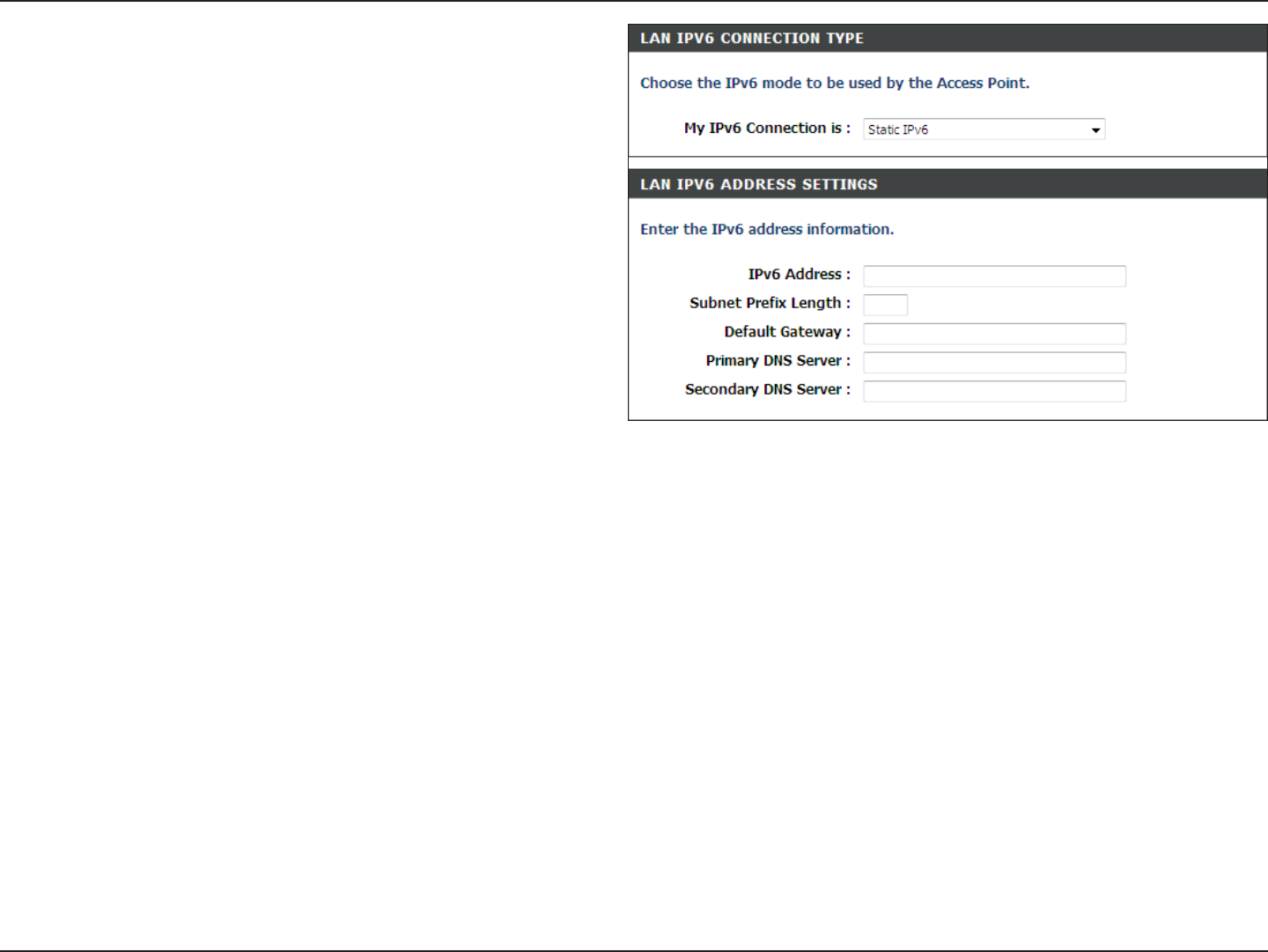
27D-Link DAP-1350 User Manual
Section 3 - Conguration
My LAN
Connection Is:
LAN IPV6 Settings:
Select Static IPv6 from the drop-down menu.
Enter your IPv6 settings.
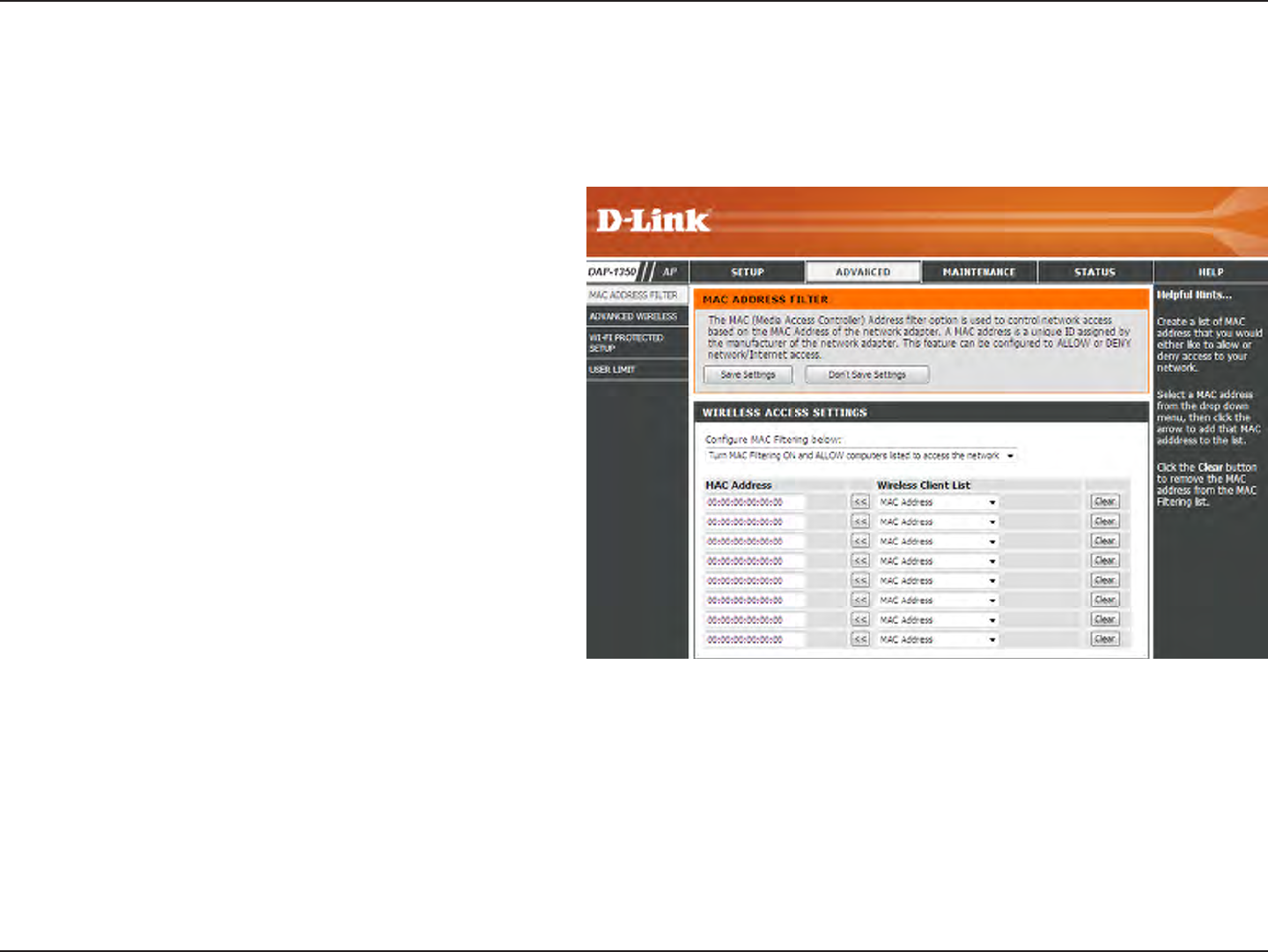
28D-Link DAP-1350 User Manual
Section 3 - Conguration
MAC Address Filter
When Disable is selected, MAC addresses are not
used to control network access.
When Turn MAC Filtering ON and ALLOW
computers listed... is selected, only computers
with MAC addresses listed in the MAC Address List
are granted network access.
When Turn MAC Filtering ON and DISALLOW
computers listed... is selected, any computer
with a MAC address listed in the MAC Address List
is refused access to the network.
Enter the MAC address you would like to lter.
You can select a client currently connected to
your access point from the Wireless Client List
drop-down menu and then click << to populate
the MAC Address eld.
Click Save Settings to activate and save.
Click to remove the client from the MAC address
lter rule.
MAC Address
Filter:
MAC Address:
Clear:
Use MAC (Media Access Control) Filters to authorize wireless clients by their MAC addresses to access your network. When
enabled, any client not on the MAC lter list will not be able to access your network.
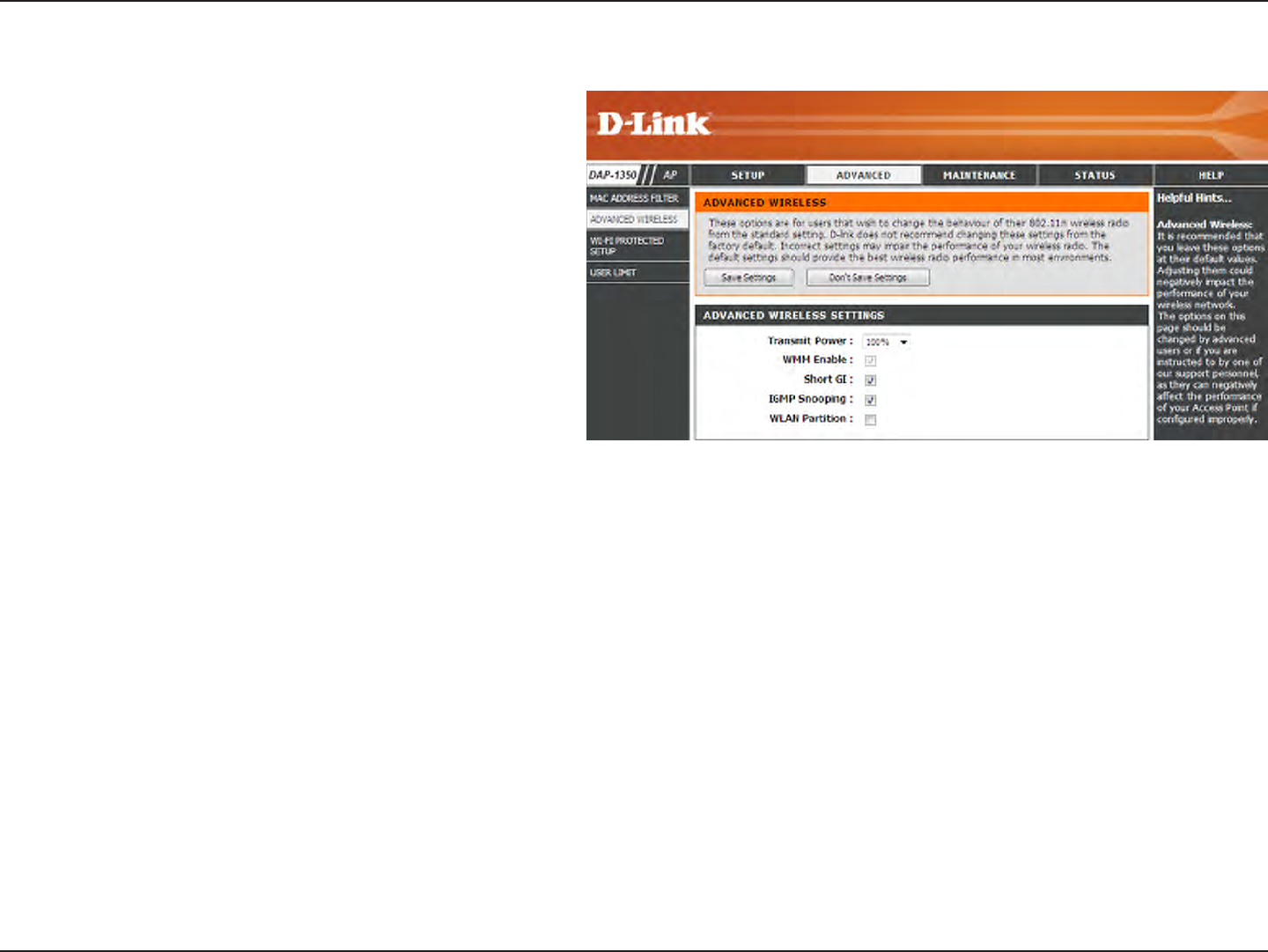
29D-Link DAP-1350 User Manual
Section 3 - Conguration
Advanced Wireless
Transmit Power:
WMM Enable:
Short GI:
IGMP Snooping:
WLAN Partition:
Sets the transmit power of the antennas.
Note: Transmit power is regulated by international
standard. Users are forbidden to change its
maximum limit.
WMM is QoS for your wireless network. This will
improve the quality of video and voice applications
for your wireless clients.
Check this box to reduce the guard interval time
therefore increasing the data capacity. However,
it’s less reliable and may create higher data loss.
This enables IGMP snooping for the wireless
onnection. We recommend enabling this if you often
use multicast services such as video conferencing
and streaming audio/video.
Check to enable WLAN Partition.
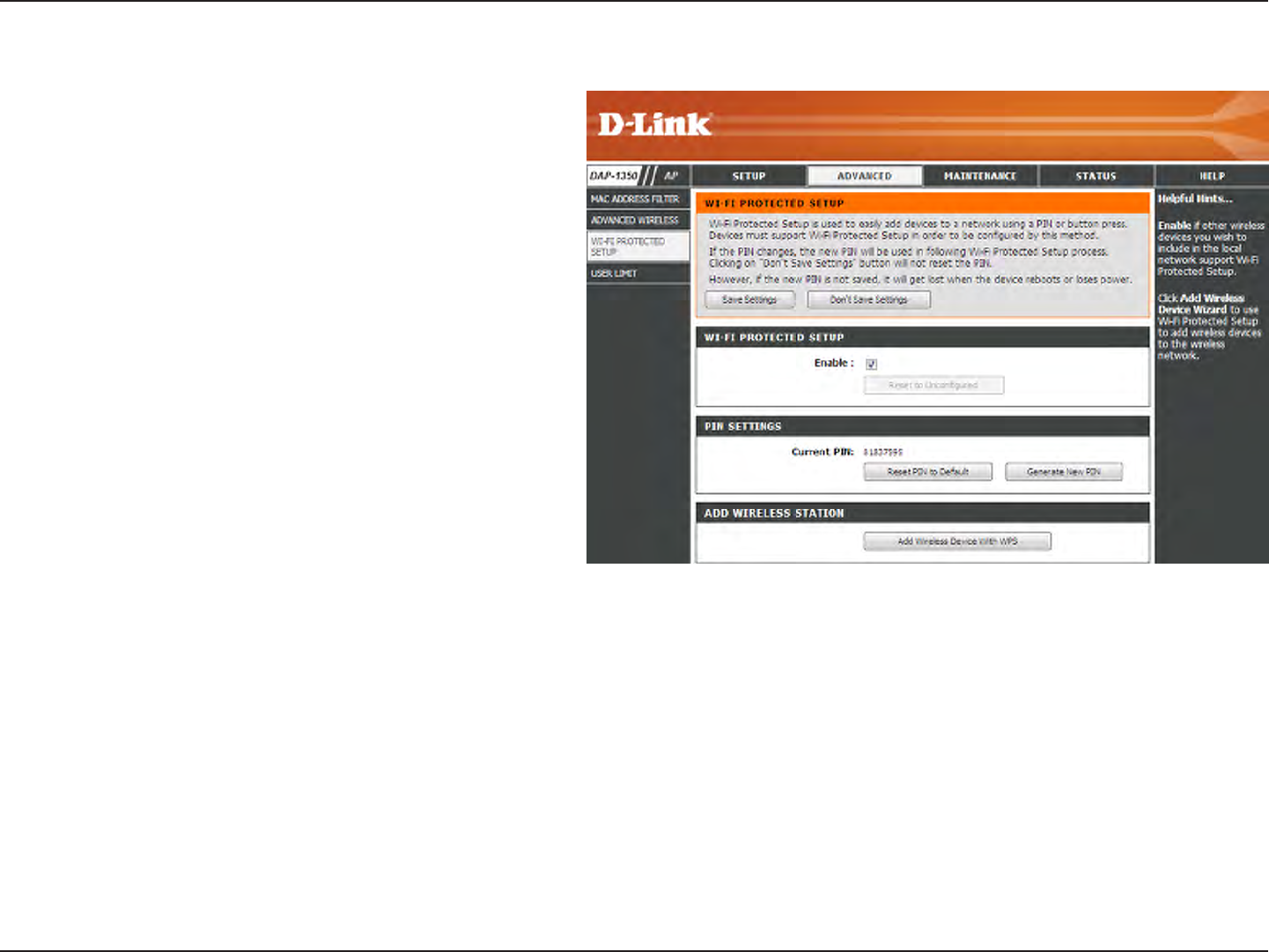
30D-Link DAP-1350 User Manual
Section 3 - Conguration
Wi-Fi Protected Setup
Enable:
Current PIN:
Reset to
Uncongured:
Reset Pin to Default:
Add Wireless Device
with WPS:
Enable the Wi-Fi Protected Setup feature.
Shows the current value of the access point’s PIN.
Resets Wi-Fi Protected Status to Not Congured.
Vista WPS icon will only be displayed when the
Wi-Fi Protected Status is Not Congured.
Restores the default Pin of the access point.
Refer to the next page for the WPS wizard.
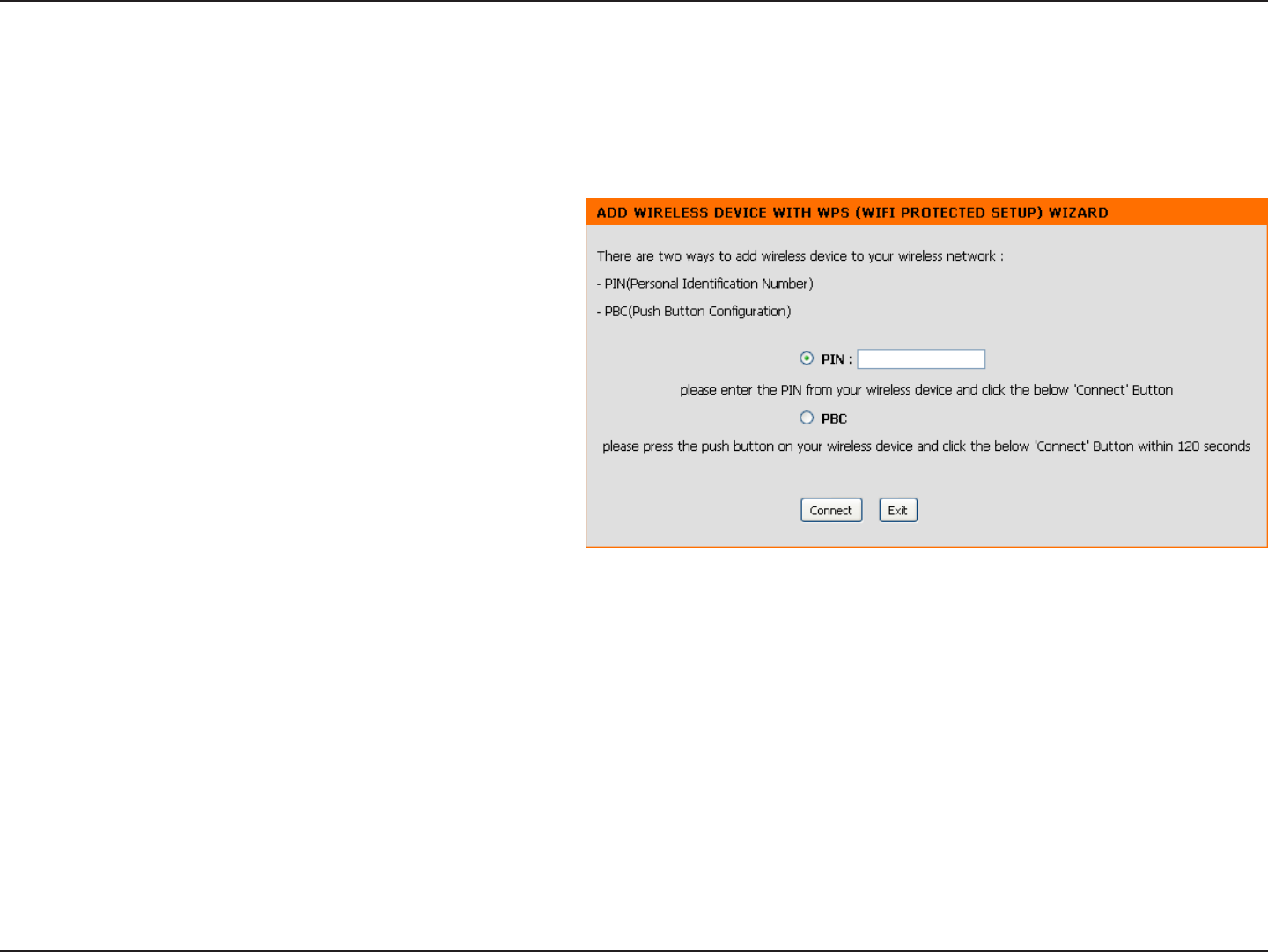
31D-Link DAP-1350 User Manual
Section 3 - Conguration
This Wizard is designed to assist you in your wireless network setup. It will guide you through step-by-step instructions on how
to set up your wireless network and how to make it secure.
Select PIN to use your PIN number from your wireless
device to connect to your network.
For PBC conguration, skip to the next page.
Click Connect to continue.
Start WPS on the wireless device you are adding to you
wireless network to complete the setup.
Add Wireless Device With WPS
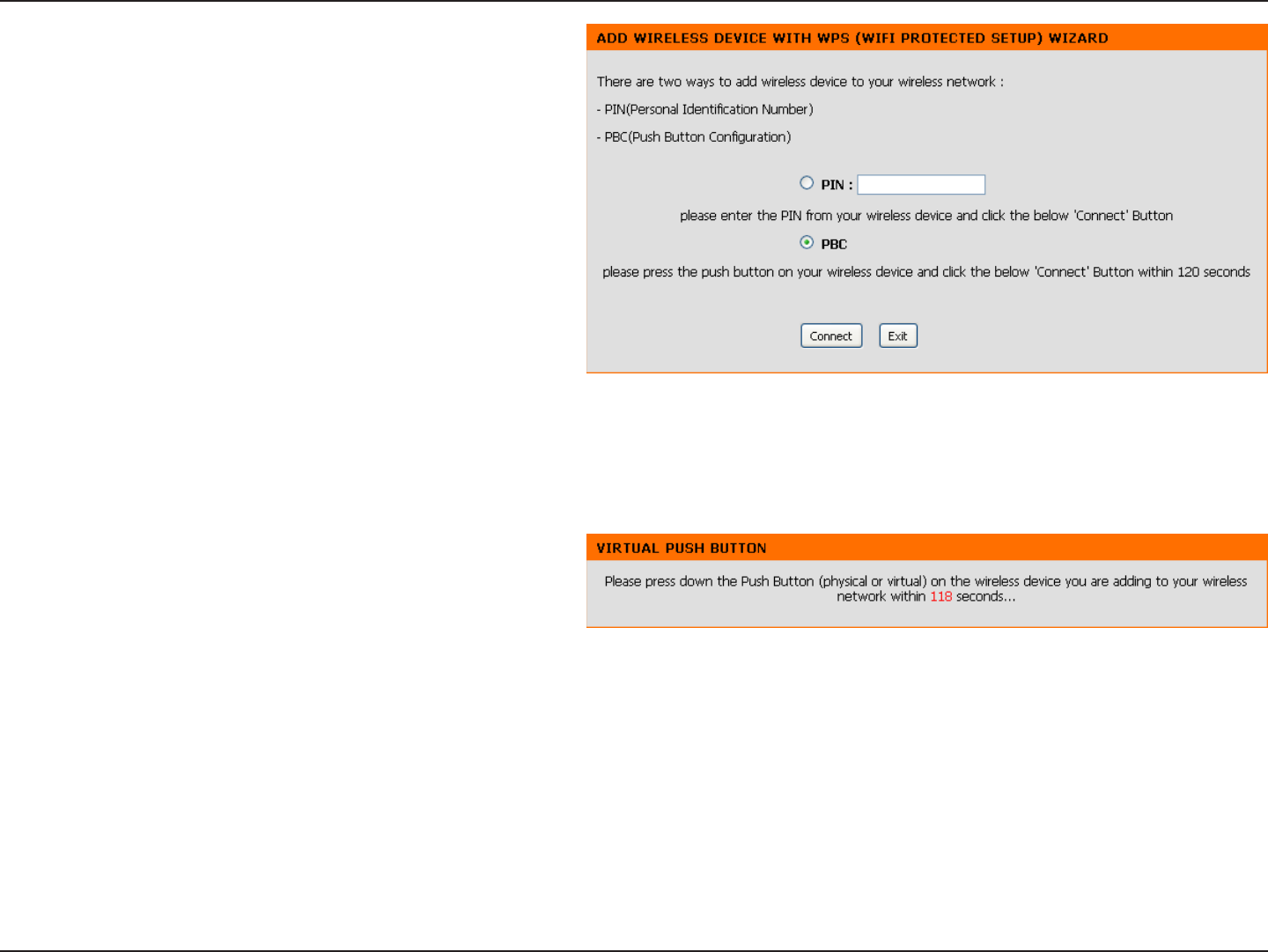
32D-Link DAP-1350 User Manual
Section 3 - Conguration
Press the Push Button on the wireless device that you
are adding to your network to complete the setup.
Select PBC to use the Push Button Conguration in order
to connect to your network.
Click Connect to continue.
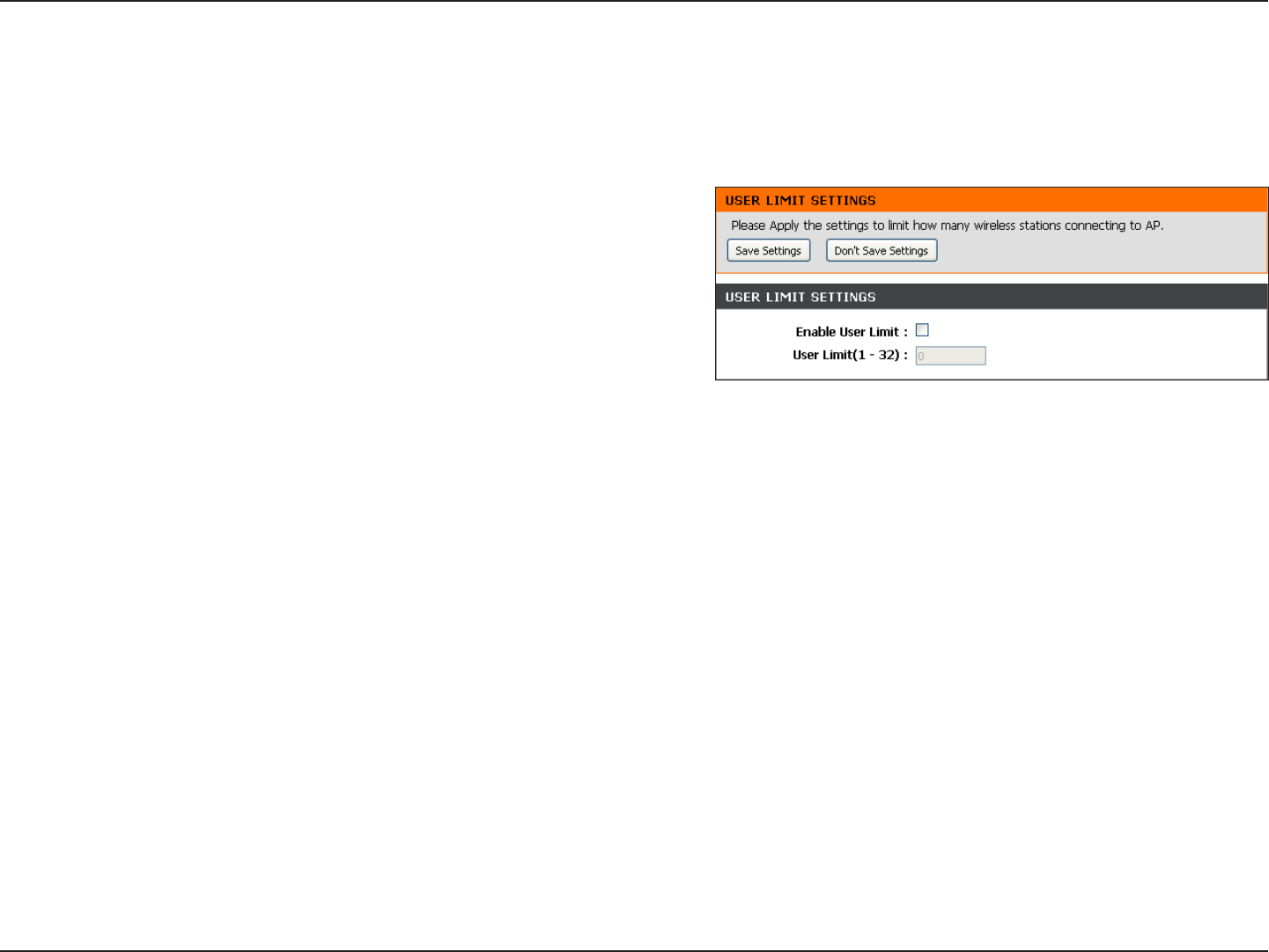
33D-Link DAP-1350 User Manual
Section 3 - Conguration
User Limit
Check the Enable User Limit box to enable this
feature.
Enter the maximum number of clients, between 1
and 32.
Click Save Settings to save and activate the new
changes.
Enable User
Limit:
User Limit:
Save
Settings:
Enter the maximum number of wireless clients that can connect at one time to your access point.
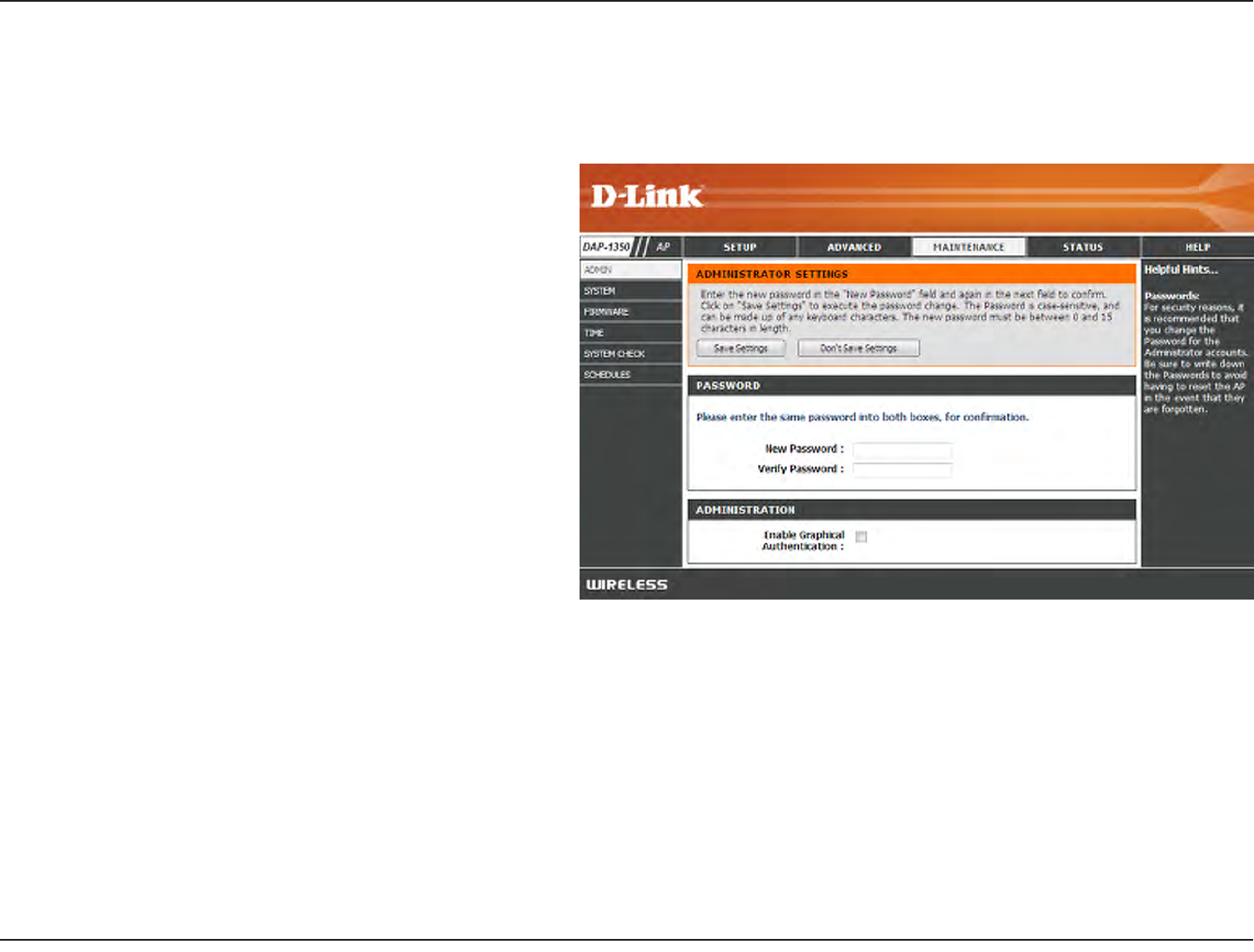
34D-Link DAP-1350 User Manual
Section 3 - Conguration
New Password:
Verify
Password:
Enable
Graphical
Authentication:
Enter a new password for the Administrator Login
Name. The administrator can make changes to the
settings.
Enter the same password that you entered in the
previous textbox in order to conrm its accuracy.
Enables a challenge-response test to require users
to type letters or numbers from a distorted image
displayed on the screen to prevent online hackers
and unauthorized users from gaining access to
your router’s network settings. This feature is
disabled by default.
Admin
This page will allow you to change the Administrator password. The administrator password has read/write access.
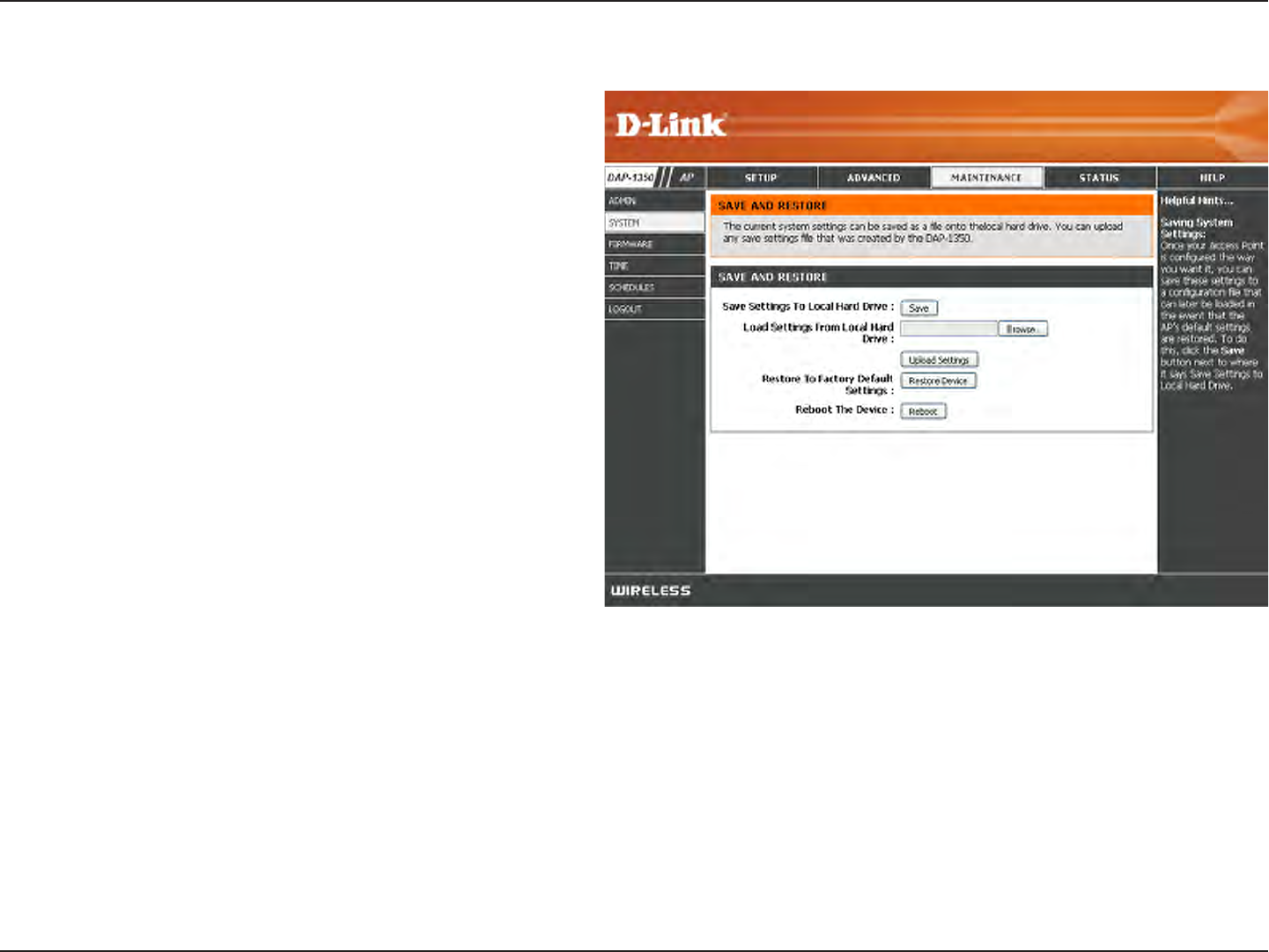
35D-Link DAP-1350 User Manual
Section 3 - Conguration
Save to Local
Hard Drive:
Upload from Local
Hard Drive:
Restore to Factory
Default:
Reboot the Device:
Use this option to save the current access point
conguration settings to a le on the hard disk of
the computer you are using. Click the Save button.
You will then see a le dialog where you can select
a location and le name for the settings.
Use this option to load previously saved access
point conguration settings. Click Browse to nd
a previously saved conguration le. Then, click the
Upload Settings button to transfer those settings
to the access point.
This option will restore all conguration settings
back to the settings that were in eect at the time
the access point was shipped from the factory.
Any settings that have not been saved will be lost,
including any rules that you have created. If you
want to save the current access point conguration
settings, use the Save button above.
Note: Restoring the factory default settings will not
reset the Wi-Fi Protected Status to Not Congured.
Click to reboot the access point.
System
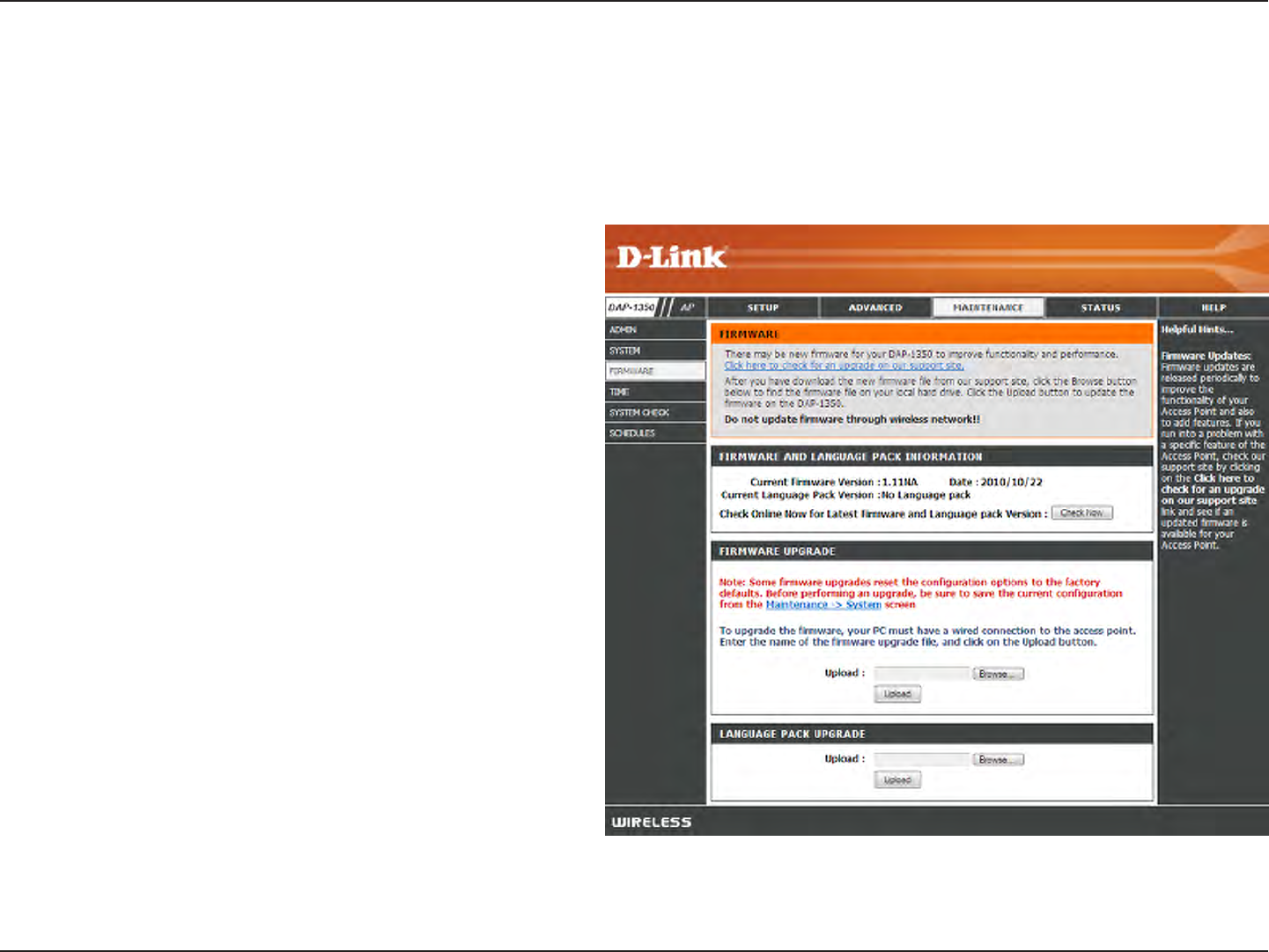
36D-Link DAP-1350 User Manual
Section 3 - Conguration
Firmware
Upgrade:
Browse:
Upload:
Click on Check Now to nd out if there is an updated
rmware; if so, download the new rmware to your
hard drive.
After you have downloaded the new rmware, click
Browse to locate the rmware update on your hard
drive. Click Upload to complete the rmware upgrade.
Once you have a rmware update on your computer,
use this option to browse for the le and then upload
the information into the access point.
Firmware
You can upgrade the rmware of the access point here. Make sure the rmware you want to use is on the local hard drive of
the computer. Click on Browse to locate the rmware le to be used for the update. Please check the D-Link support website
for rmware updates at http://support.dlink.com. You can download rmware upgrades to your hard drive from this site.
After you have downloaded the new language pack,
click Browse to locate the language pack le on your
hard drive. Click Upload to complete the language
pack upgrade.
Note: In most cases you must unzip the le rst before
uploading.
Language Pack
You can change the language of the web UI by uploading
available language packs.
Browse:
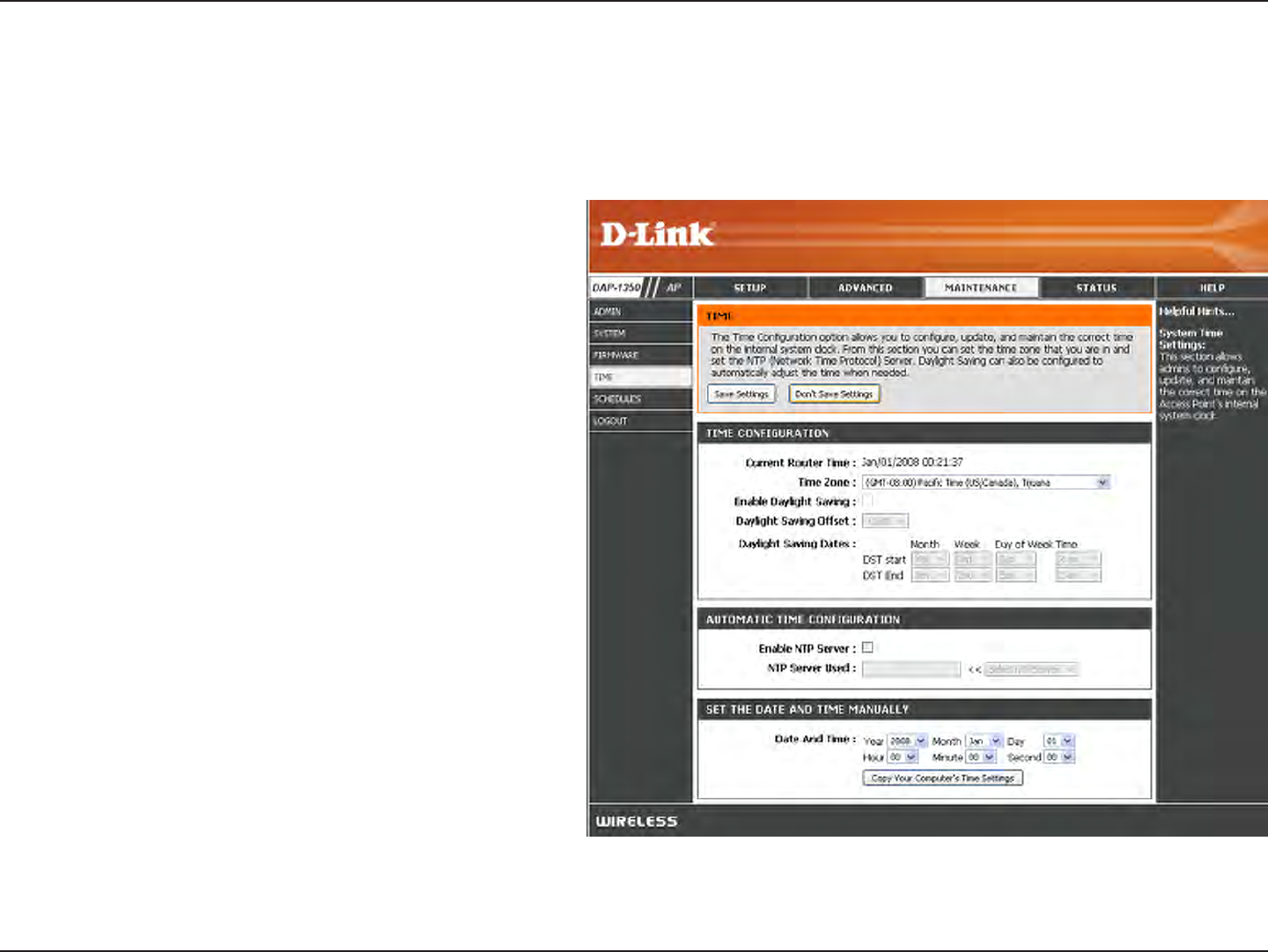
37D-Link DAP-1350 User Manual
Section 3 - Conguration
Time Zone:
Daylight Saving:
Enable NTP Server:
NTP Server Used:
Date and Time:
Select the Time Zone from the drop-down menu.
To select Daylight Saving time manually, click the
Enable Daylight Saving check box. Next use the
drop-down menu to select a Daylight Saving Oset
and then enter a start date and an end date for
daylight saving time.
NTP is short for Network Time Protocol. NTP
synchronizes computer clock times in a network
of computers. Check this box to use a NTP server.
This will only connect to a server on the Internet,
not a local server.
Enter the NTP server or select one from the
drop-down menu.
To manually input the time, enter the values in
these elds for the Year, Month, Day, Hour, Minute,
and Second and then click Save Settings. You
can also click the Copy Your Computer’s Time
Settings button at the bottom of the screen.
Time
The Time Conguration option allows you to congure, update, and maintain the correct time on the internal system clock.
From this section you can set the time zone that you are in. Daylight Saving can also be congured to automatically adjust the
time when needed.
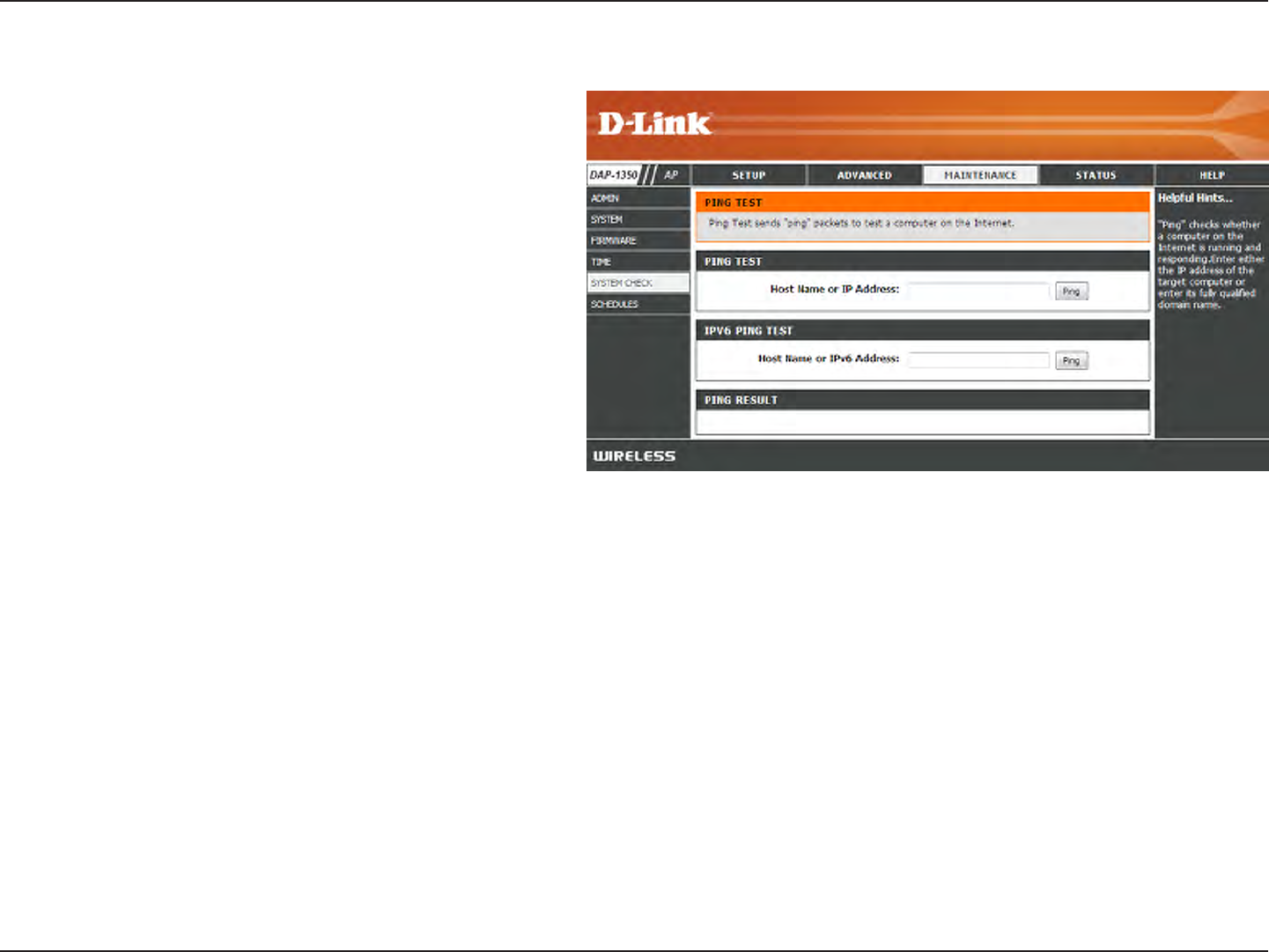
38D-Link DAP-1350 User Manual
Section 3 - Conguration
Ping Test/IPv6 Ping
Test:
Ping Result:
The Ping Test is used to send Ping packets to test if
a computer or device is on the Internet. Enter the
IP Address that you wish to ping, and click Ping.
The results of your ping attempts will be displayed
here.
System Check
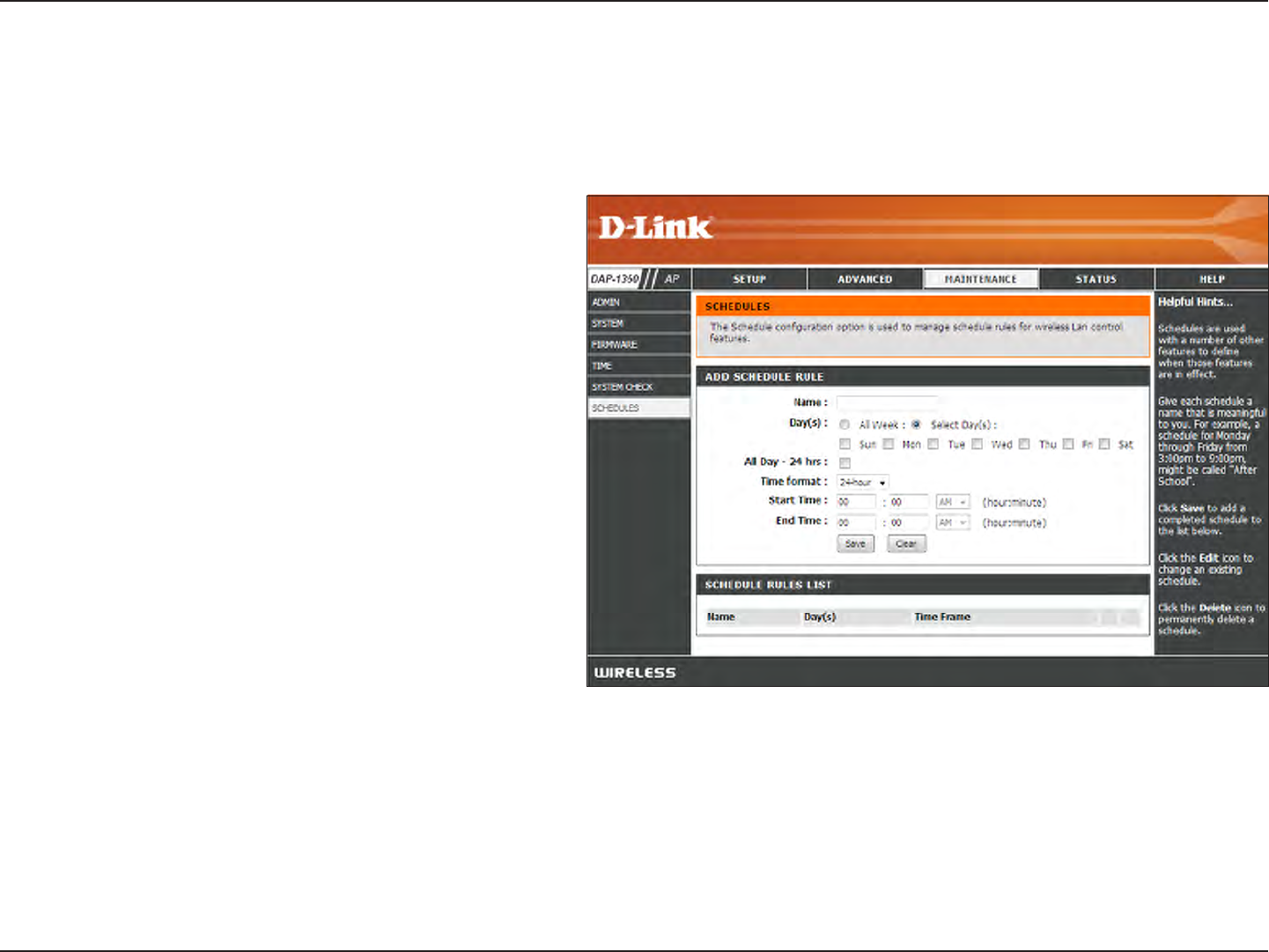
39D-Link DAP-1350 User Manual
Section 3 - Conguration
Enter a name for your new schedule.
Select a day, a range of days, or All Week to
include every day.
Check All Days or enter a start and end time for
your schedule.
Select the time format you want from the
drop-down menu.
Click Save to save your schedule. You must click
Save Settings at the top for your schedules to
go into eect.
The list of schedules will be listed here. Click the
Edit icon to make changes or click the Delete
icon to remove the schedule.
Name:
Days:
Time:
Time Format:
Save:
Schedule Rules
List:
Schedules
Schedules can be created for use with enforcing rules. For example, if you want to restrict web access to Mon-Fri from 3pm to
8pm, you could create a schedule selecting Mon, Tue, Wed, Thu, and Fri and enter a Start Time of 3pm and End Time of 8pm.
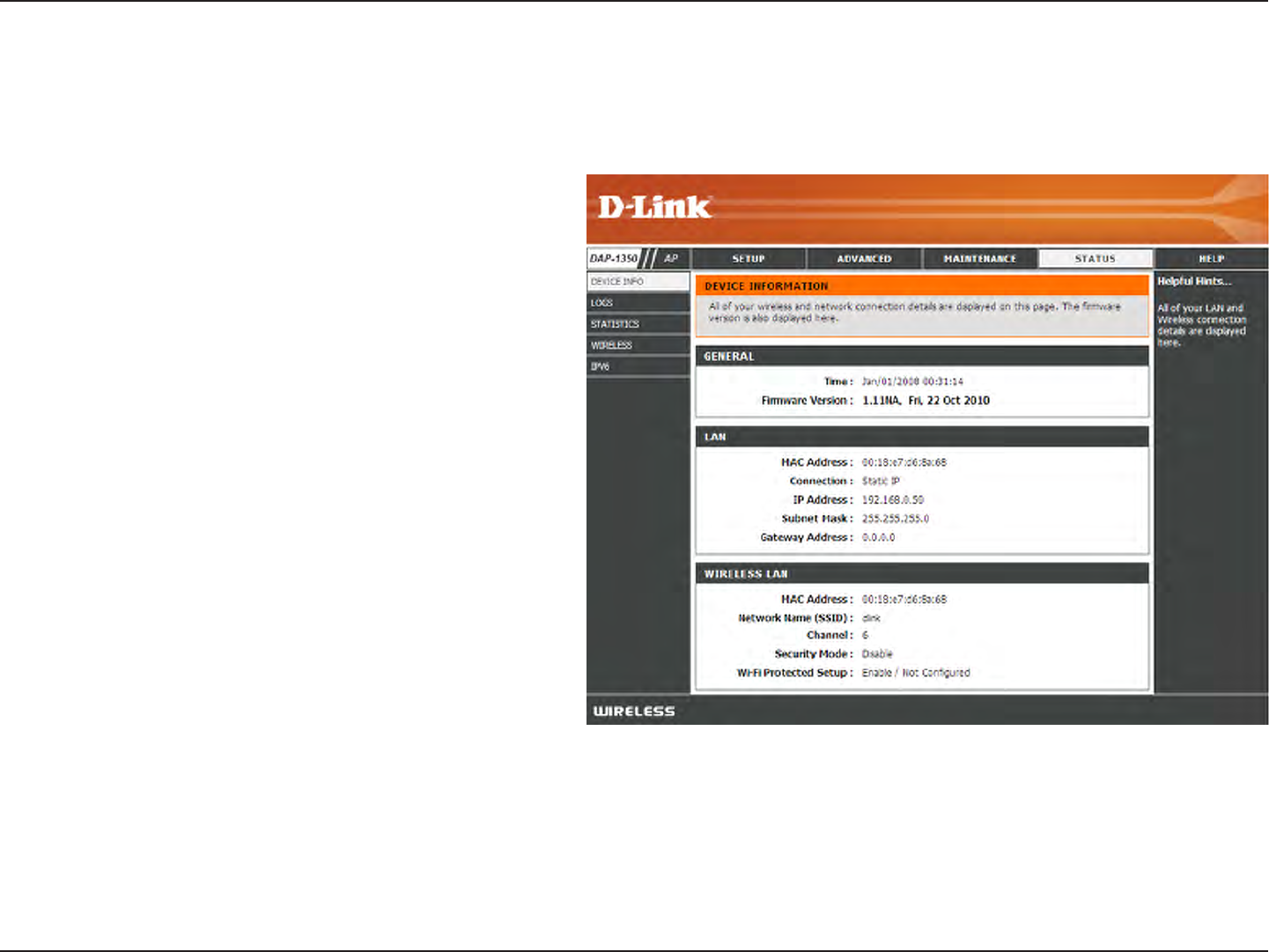
40D-Link DAP-1350 User Manual
Section 3 - Conguration
General:
LAN:
Wireless LAN:
Displays the access point’s time and firmware
version.
Displays the MAC address and the private (local) IP
settings for the access point.
Displays the wireless MAC address and your
wireless settings such as SSID and Channel.
Device Info
This page displays the current information for the DAP-1350. It will display the LAN and wireless LAN information.
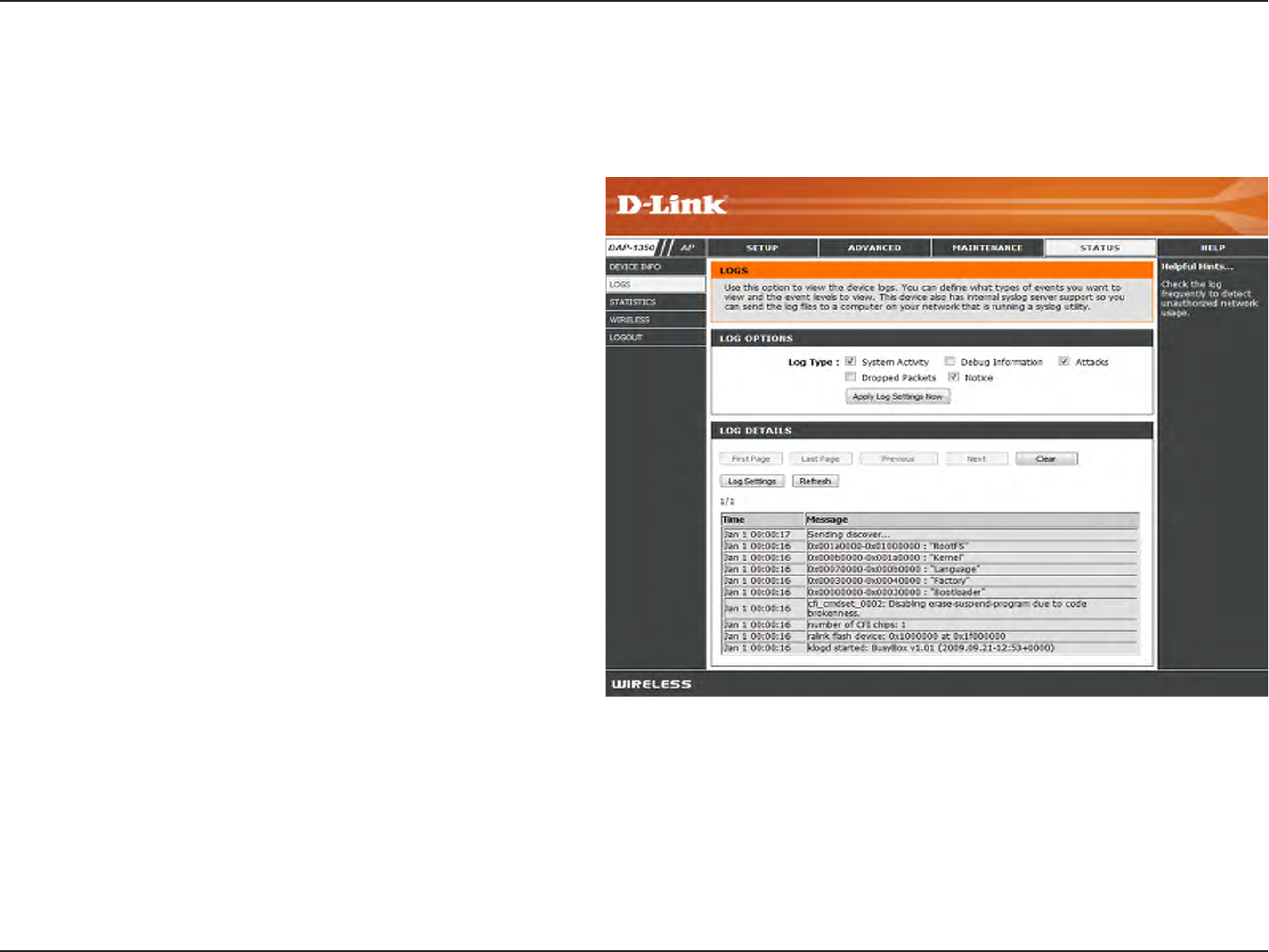
41D-Link DAP-1350 User Manual
Section 3 - Conguration
Logs
The DAP-1350 keeps a running log of events and activities occurring on the AP. If the AP is rebooted, the logs are automatically cleared. You can
save the log les under Log Settings.
Log Options:
First Page:
Last Page:
Previous:
Next:
Clear:
Log Settings:
Refresh:
You can select the types of messages that you want
to display from the log: System Activity, Debug
Information, Attacks, Dropped Packets, and Notice.
Select and click Apply Log Settings Now.
This button directs you to the rst page of the log.
This button directs you to the last page of the log.
This button directs you to the previous page of the
log.
This button directs you to the next page of the log.
This button clears all current log content.
This button opens a new menu where you can
congure the log settings.
This button refreshes the log.
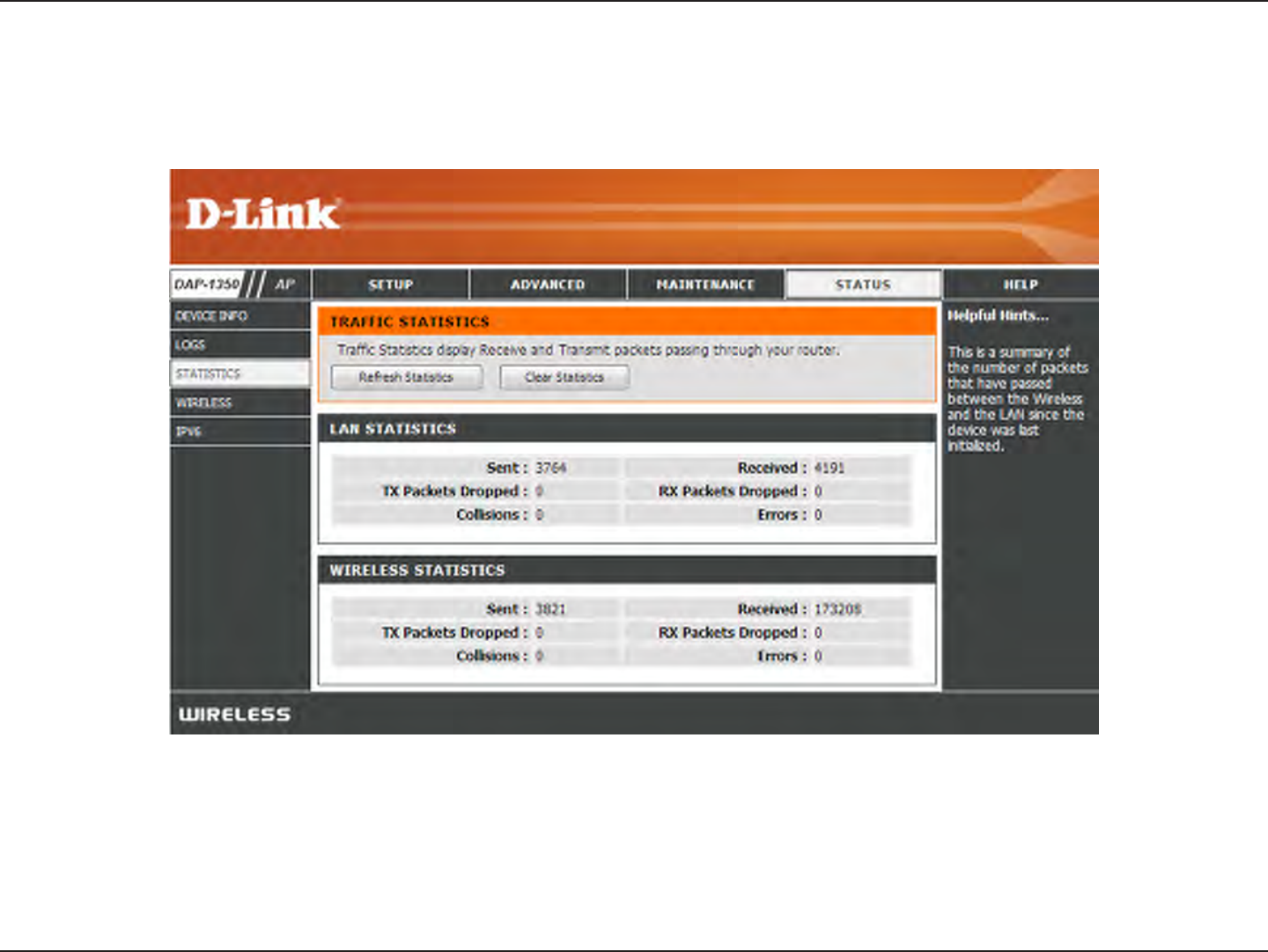
42D-Link DAP-1350 User Manual
Section 3 - Conguration
Statistics
The DAP-1350 keeps statistics of the trac that passes through it. You can view the amount of packets that pass through the LAN
and wireless portions of the network. The trac counter will reset if the access point is rebooted.
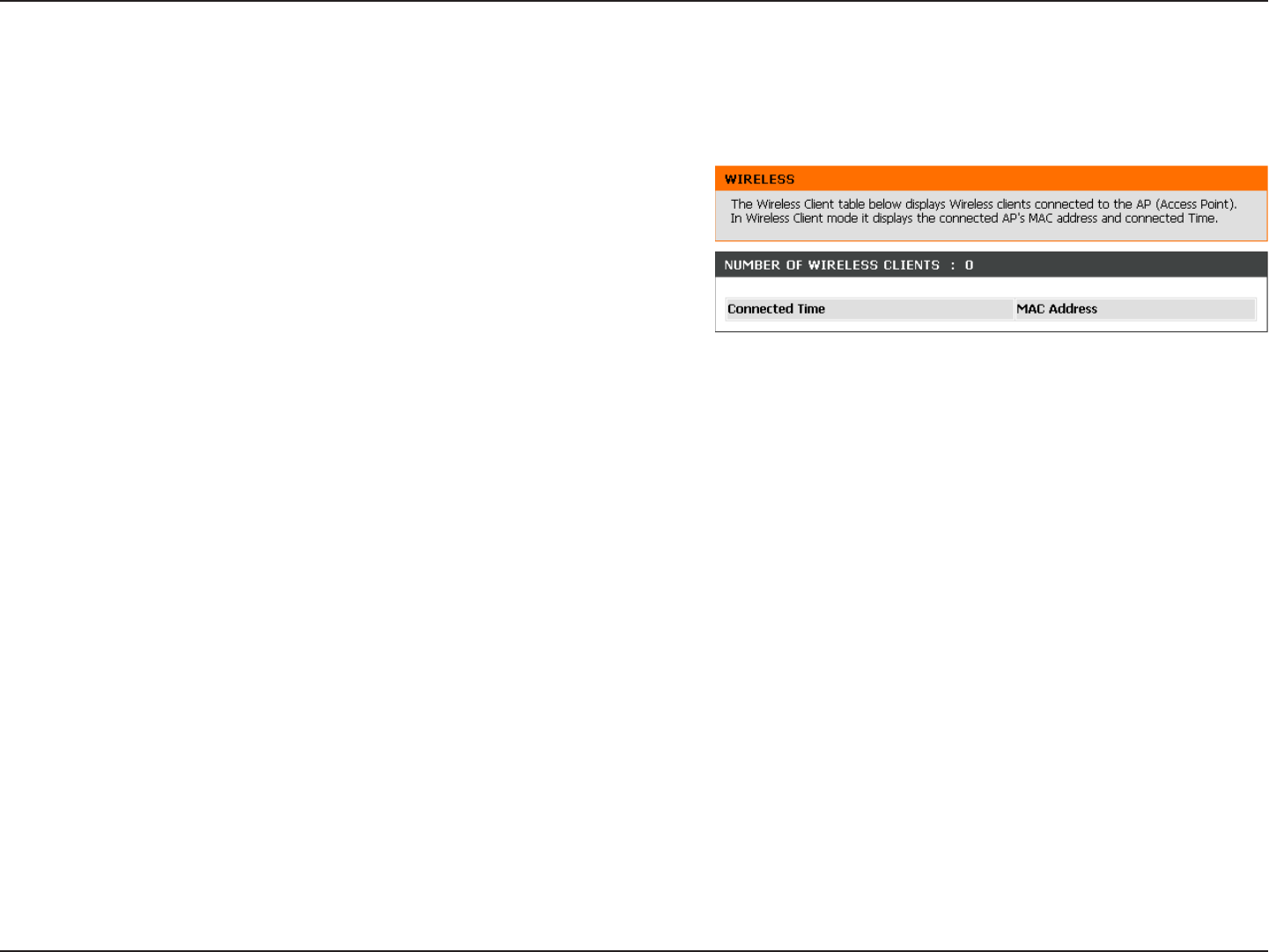
43D-Link DAP-1350 User Manual
Section 3 - Conguration
Wireless
The wireless section allows you to view the wireless clients that are connected to your wireless access point.
Connection Time:
MAC Address:
Displays the amount of time the wireless client has been
connected to the access point.
The Ethernet ID (MAC address) of the wireless client.
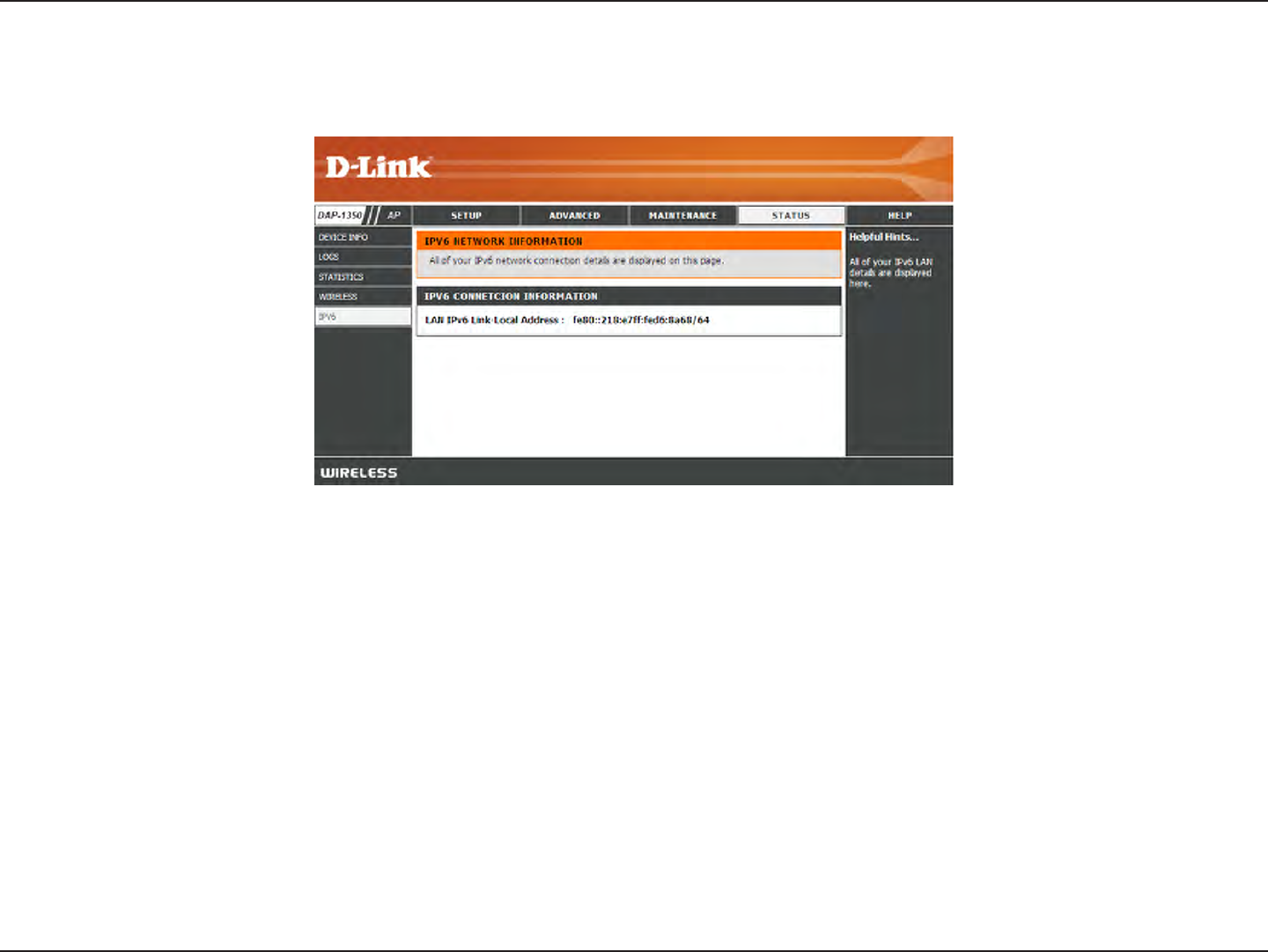
44D-Link DAP-1350 User Manual
Section 3 - Conguration
IPv6
The IPv6 section allows you to view the IPv6 network connections.
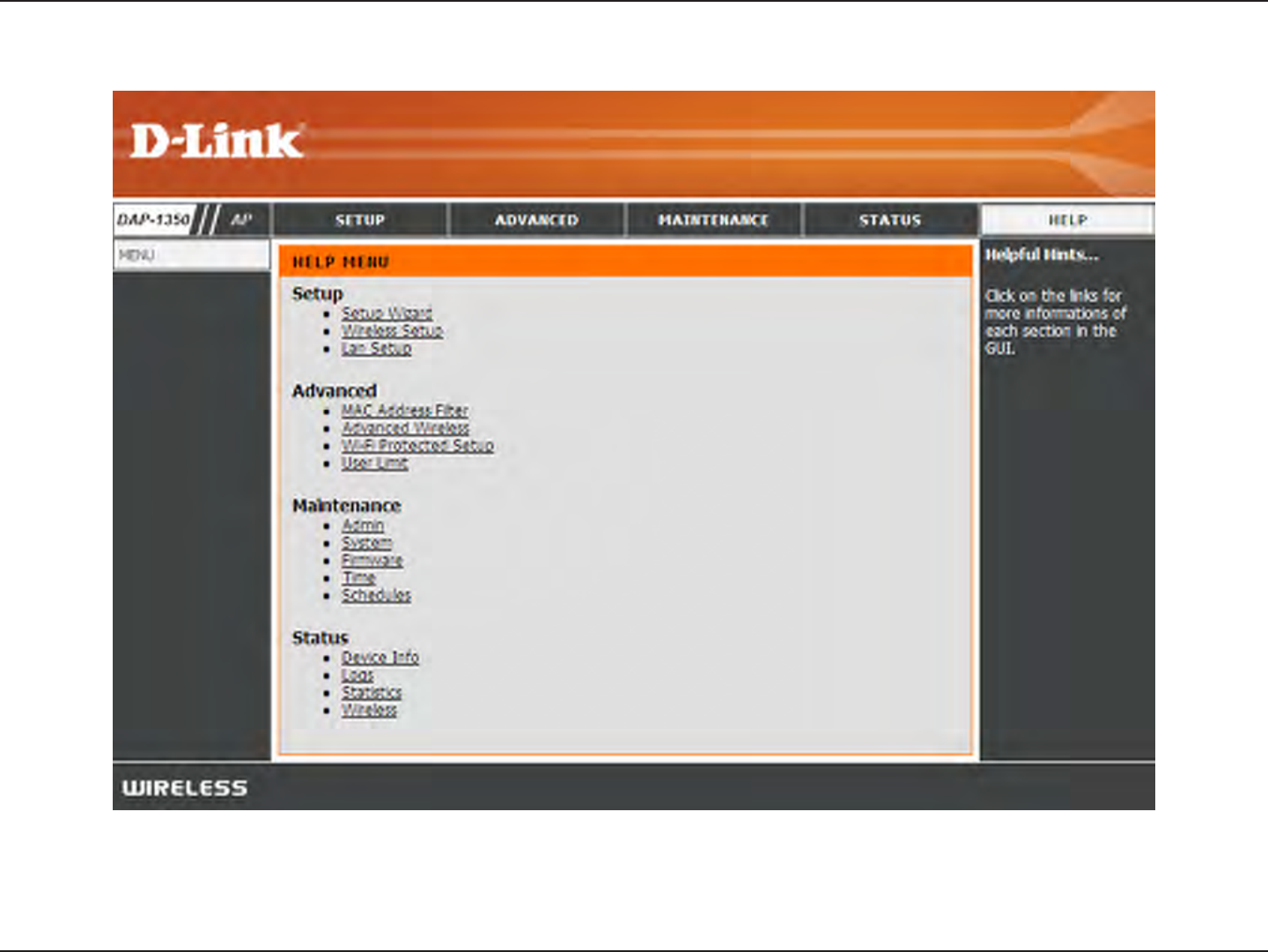
45D-Link DAP-1350 User Manual
Section 3 - Conguration
Help
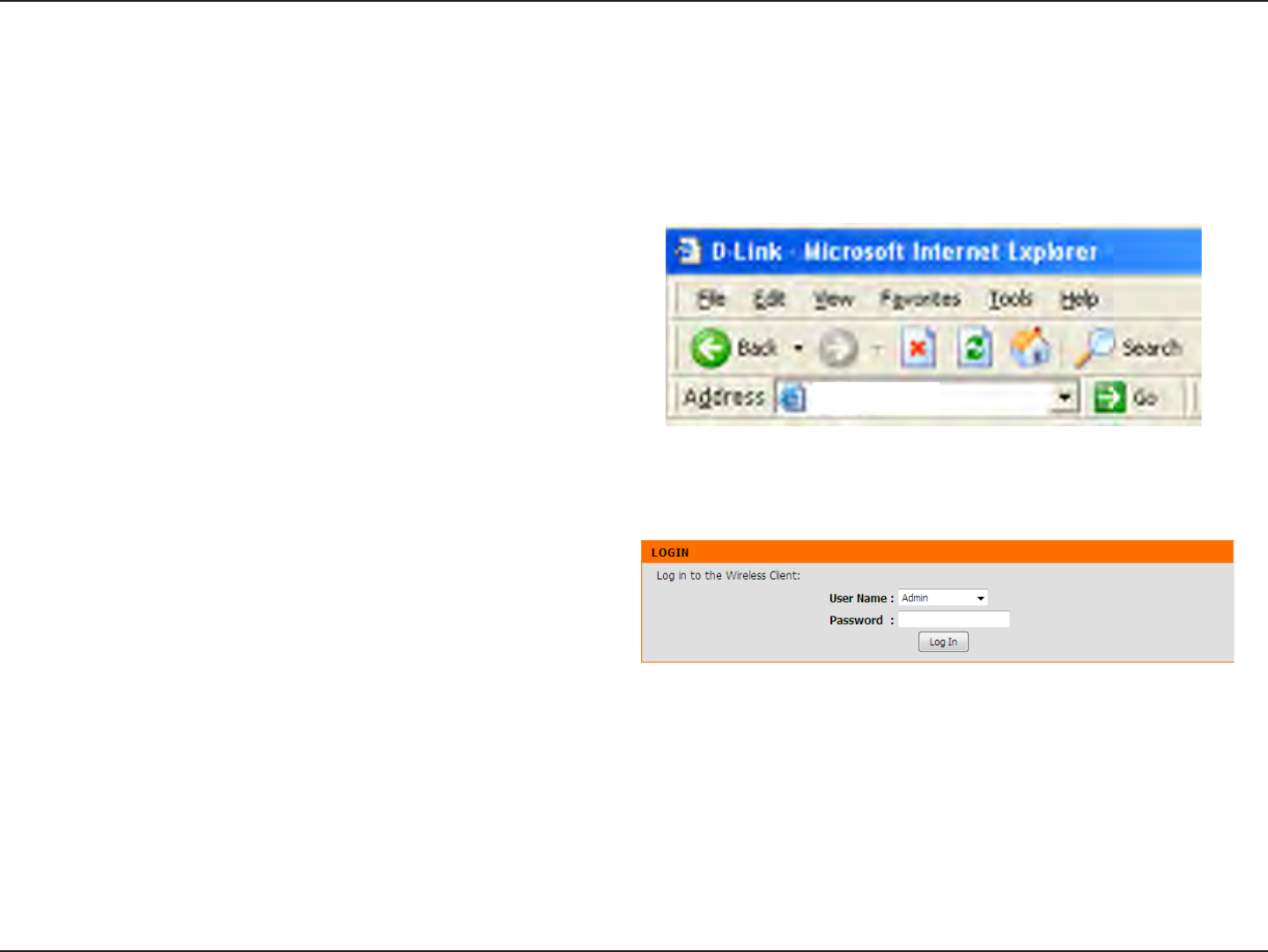
46D-Link DAP-1350 User Manual
Section 3 - Conguration
Wireless Client Mode
If you wish to change the default settings or optimize the
performance of the DAP-1350, you may use the web-based
conguration utility.
To access the conguration utility, open a web browser
such as Internet Explorer and enter http://dlinkap or
http://192.168.0.50 in the address eld.
Enter your password. Leave the password blank by default.
If you get a Page Cannot be Displayed error, please refer to
the Troubleshooting section for assistance.
Change the mode selector to CL on the device. Connect an Ethernet cable from the Ethernet port on the DAP-1350 to a
computer for conguration.
http://dlinkap
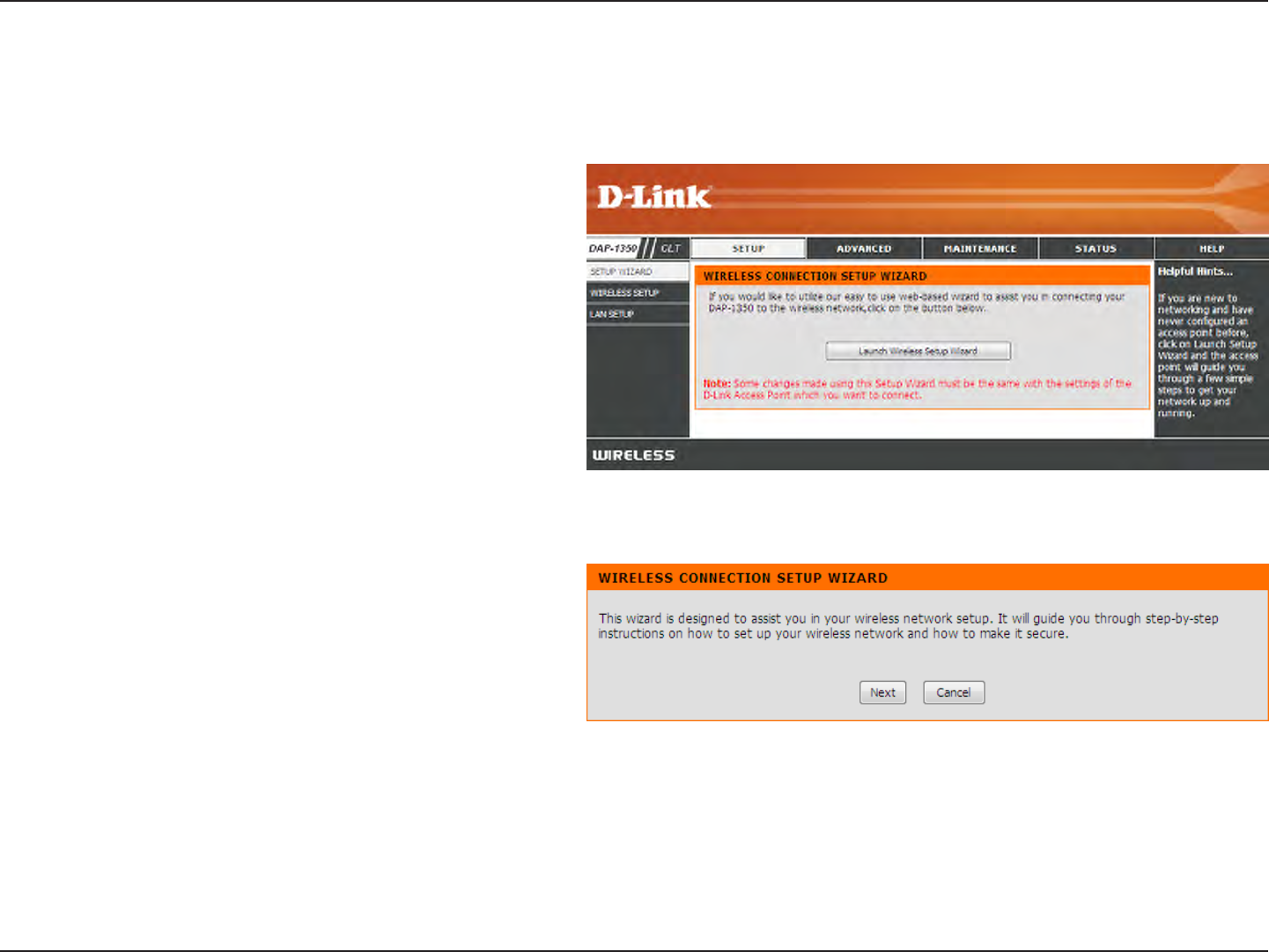
47D-Link DAP-1350 User Manual
Section 3 - Conguration
This Wizard is designed to assist you in conguring your DAP-1350 as a wireless client.
Wireless Setup Wizard
Click Next to continue.
Click the Launch Wireless Setup Wizard button to use
the wizard to setup your network.
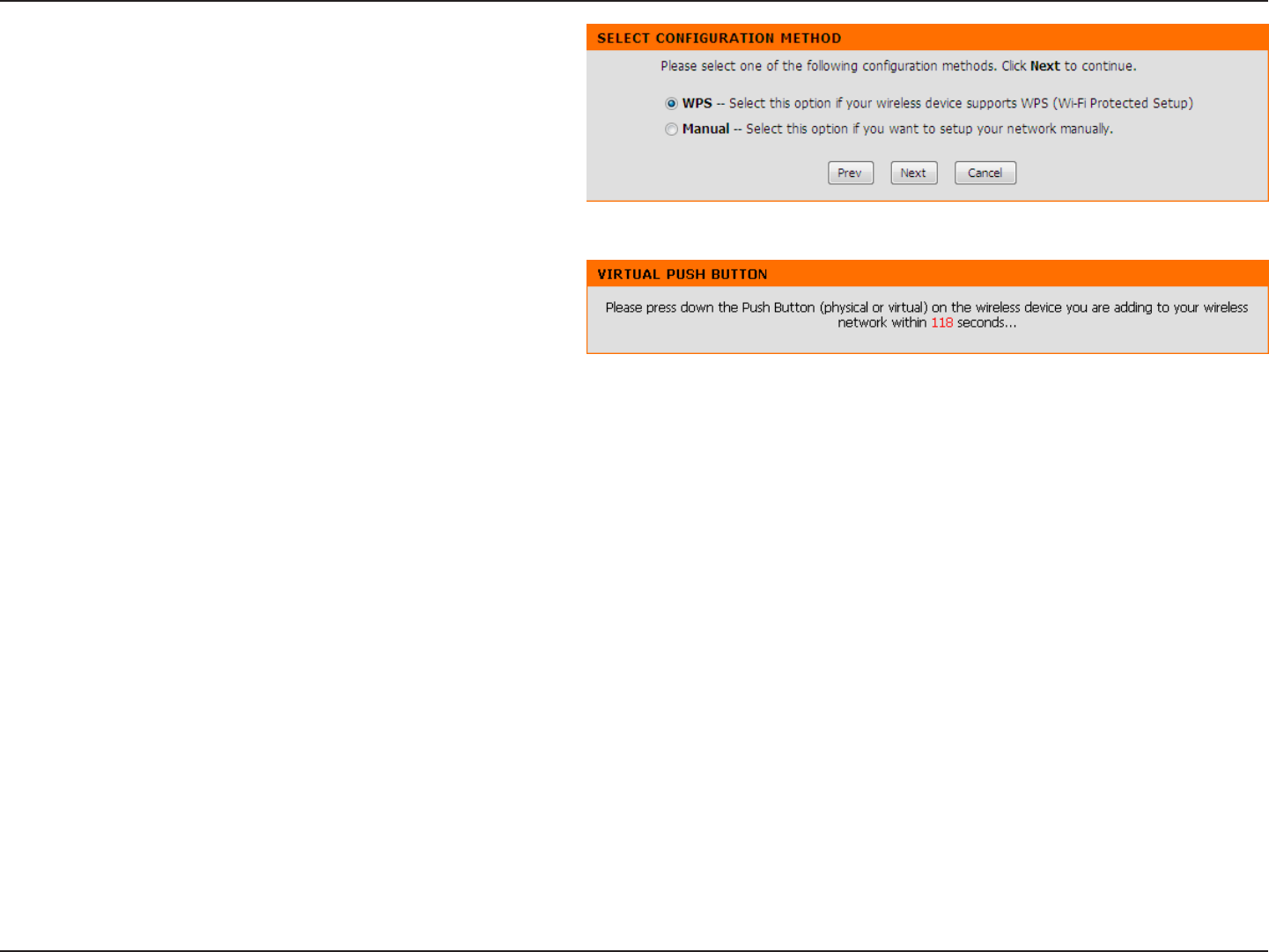
48D-Link DAP-1350 User Manual
Section 3 - Conguration
Select WPS as the conguration method only if your
wireless device supports Wi-Fi Protected Setup (WPS).
For Manual setup, skip to the next page.
Click Next to continue.
On the device you want to connect to, start the PBC
process on the device. You will have 2 minutes to start
the PBC process on both devices.
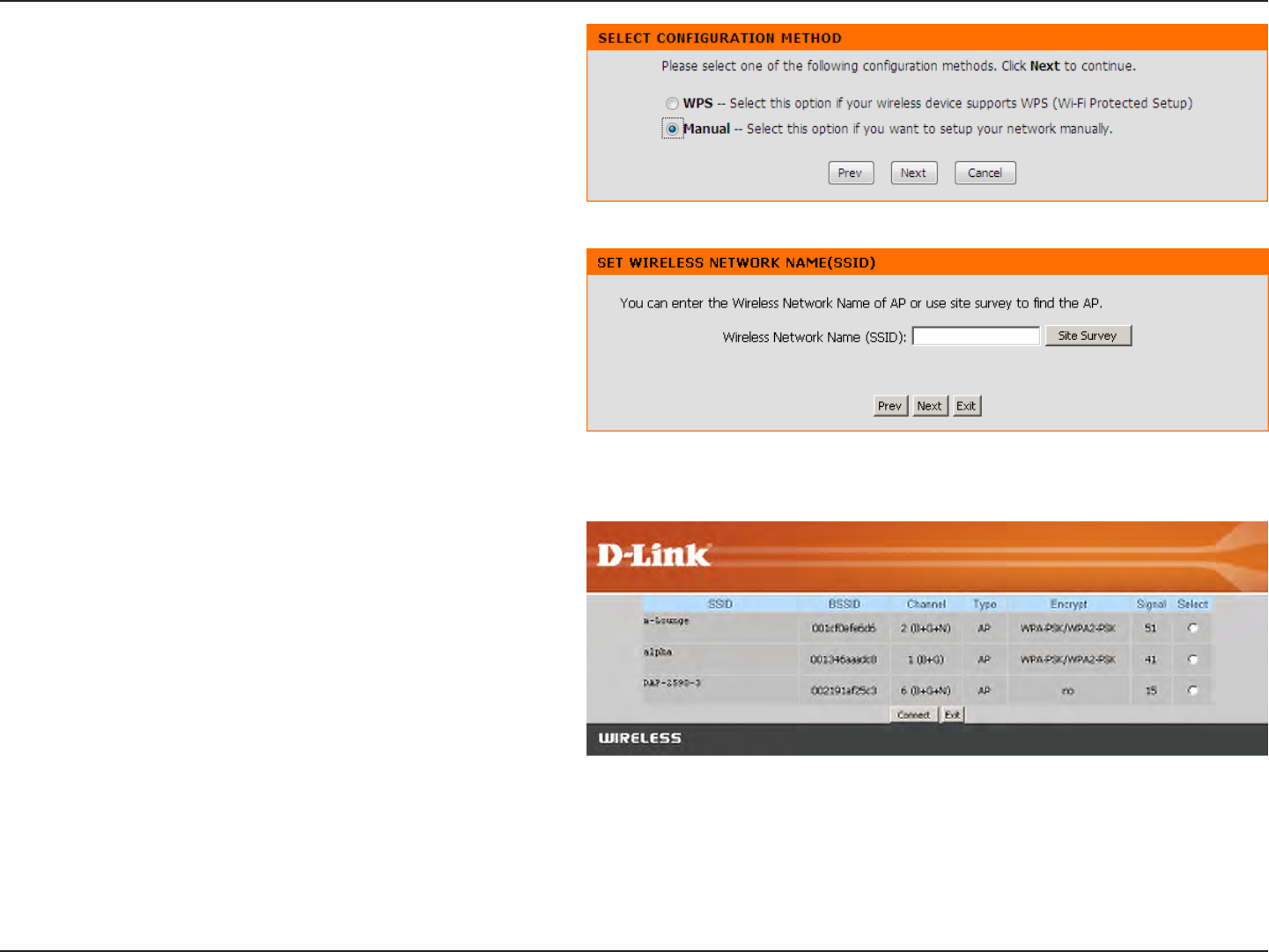
49D-Link DAP-1350 User Manual
Section 3 - Conguration
Enter the network name (SSID) of the network you want
to connect to. If you do not know the exact name or
would like to search for the wireless network, click Site
Survey.
Find your access point from the list, click the radio
button in the right column, and click Connect.
Select Manual as the conguration method to set up
your network manually.
Click Next to continue.
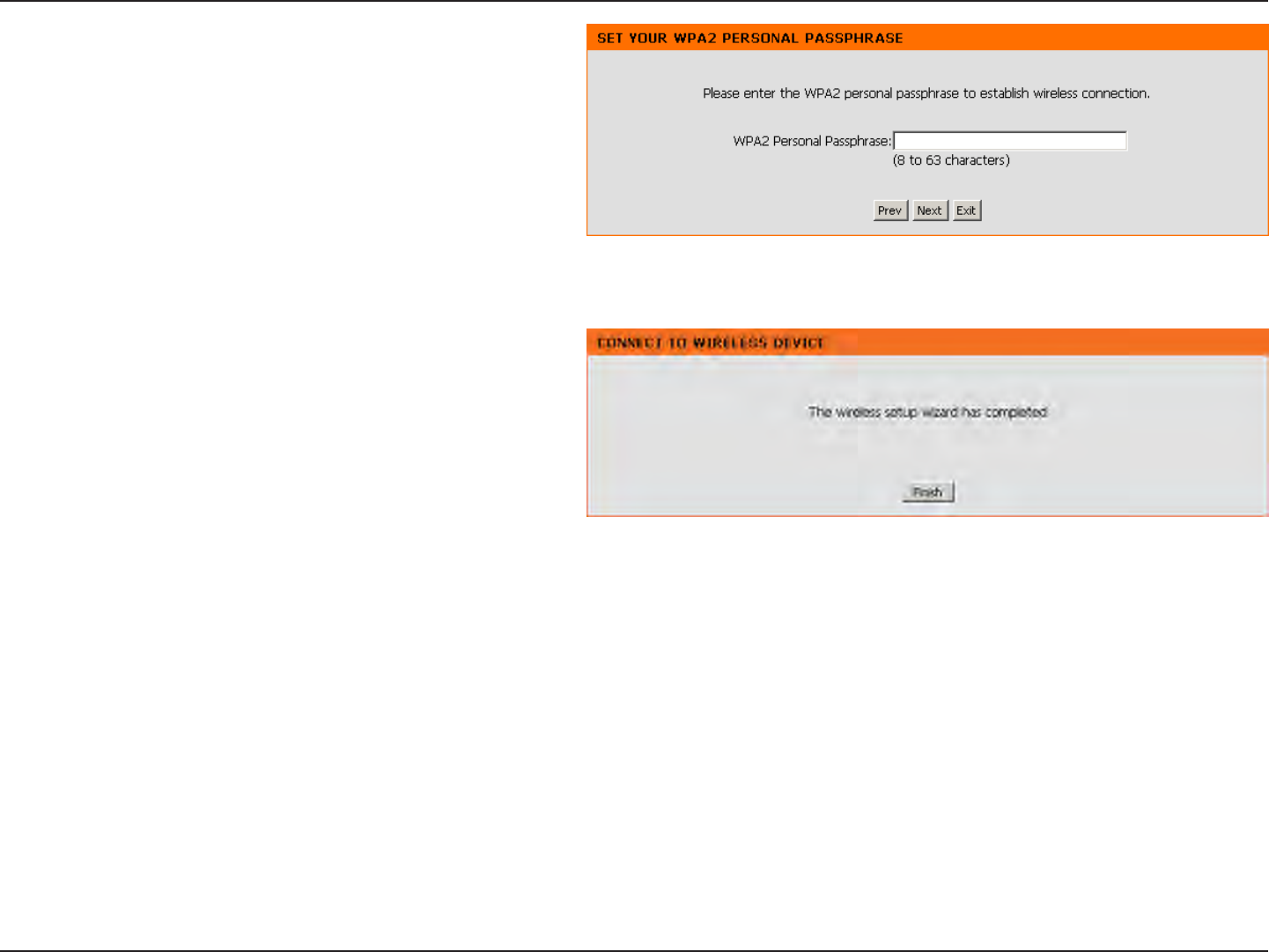
50D-Link DAP-1350 User Manual
Section 3 - Conguration
If you select WPA or WPA2, enter the wireless security
password. Click Next to complete the Setup Wizard.
The Wireless Setup Wizard is complete. Click Finish to
reboot the device.
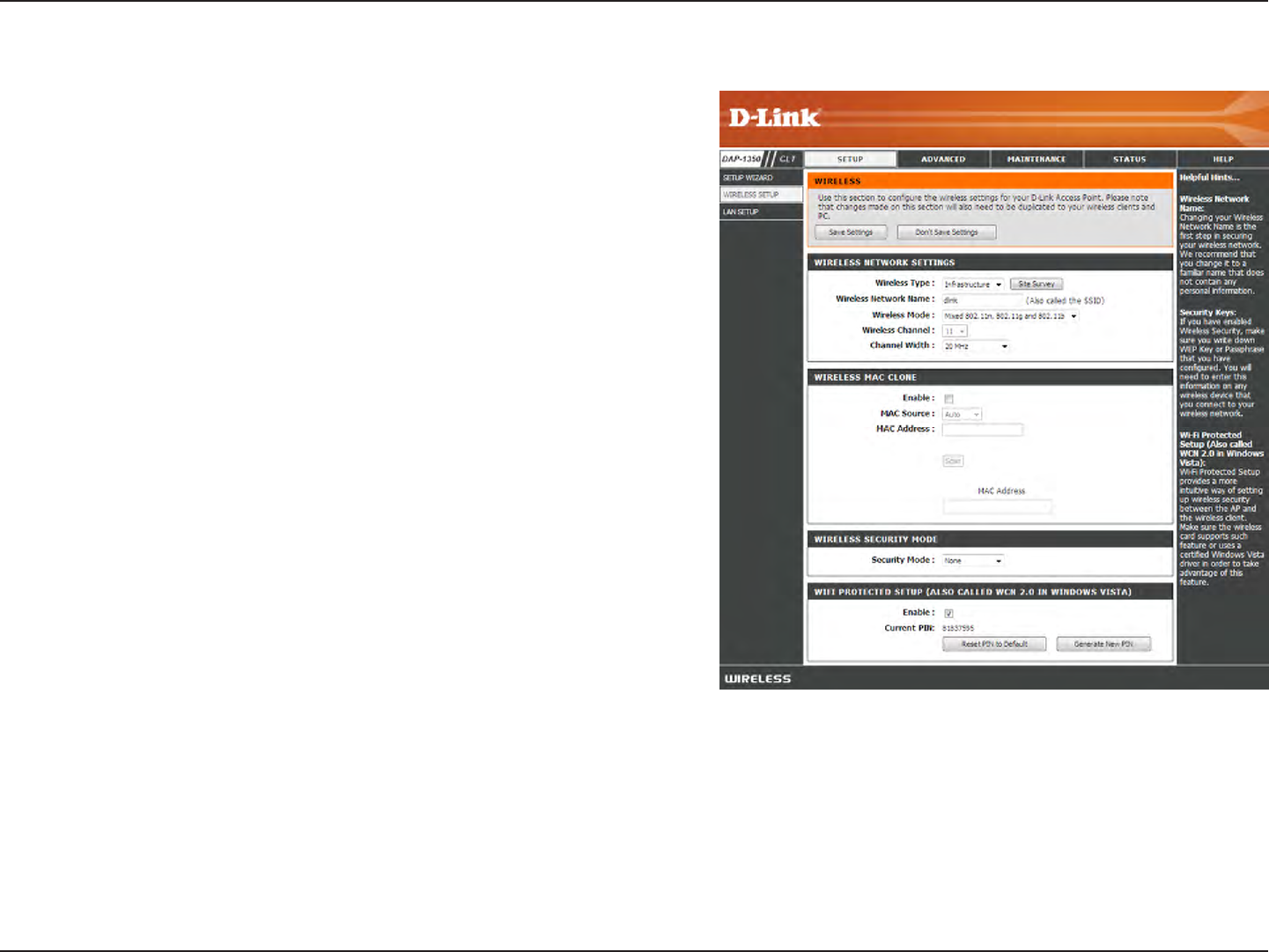
51D-Link DAP-1350 User Manual
Section 3 - Conguration
Manual Wireless Setup
Wireless Type:
Site Survey:
Wireless Network
Name:
Wireless Mode:
Wireless Channel:
Channel Width:
Wireless MAC Clone:
Wireless Security
Mode:
WPS:
Select Infrastructure if connecting to an access point or
wireless router, or select Ad-Hoc if connecting to another
wireless client.
Click Site Survey to display a list of wireless networks in your
area. You may select the wireless access point to connect to.
Enter the SSID of the wireless network you want to connect
to. If you do not know for sure, click Site Survey and select it
from the list, if available.
Select the appropriate 802.11 mode based on the wireless
clients in your network. Select Mixed 802.11b/g, 802.11n
Only, or Mixed 802.11b/g/n from the drop-down menu.
The channel will automatically change to the channel of the
AP you are connected to.
Select the Channel Width:
Auto 20/40 - Select if you are using both 802.11n and
non-802.11n wireless devices.
20MHz - Select if you are not using any 802.11n wireless clients.
You can clone the MAC address of the device connected via
Ethernet to the DAP-1350.
Select a wireless security setting. Options are None, WEP, WPA, or WPA2. See the Wireless Security section in this manual for a
detailed explanation of the wireless security options.
Select Enable if you want to congure the DAP-1350 with Wi-Fi Protection setup.
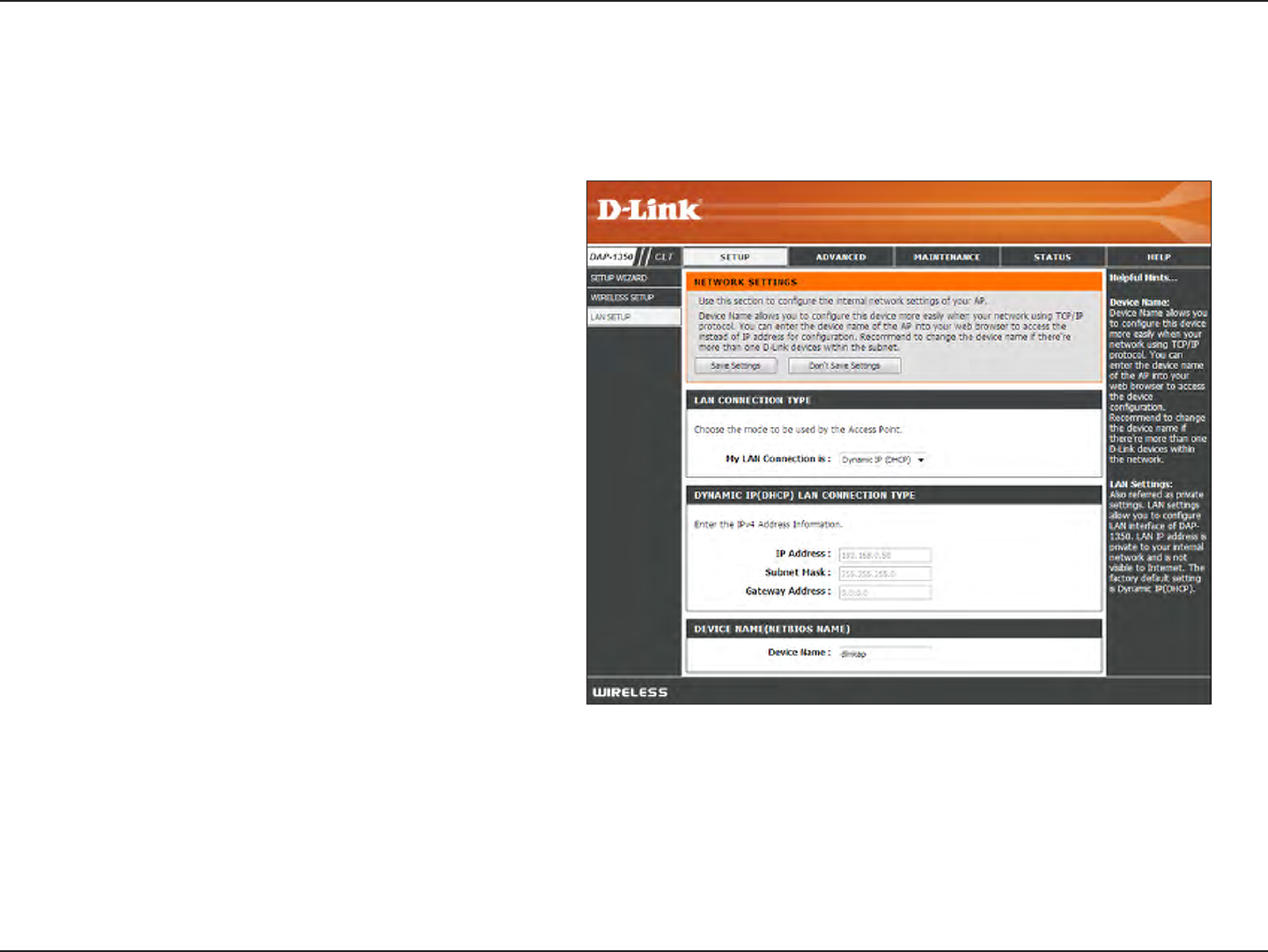
52D-Link DAP-1350 User Manual
Section 3 - Conguration
LAN Settings
This section will allow you to change the local network settings of the access point and to congure the DHCP settings.
My LAN
Connection is:
IP Address:
Subnet Mask:
Default Gateway:
Device Name:
Use the drop-down menu to select Dynamic
IP (DHCP) to automatically obtain an IP address
on the LAN/private network or select Static IP
to manually enter the IP settings.
192.168.0.50 is the default IP Address of the
DAP-1350.
255.255.255.0 is the default subnet mask. All
devices on the network must have the same
subnet mask to communicate on the network.
Enter the IP Address of the gateway in your
network.
Enter the Device Name of the AP. It is
recommended to change the Device Name if
there is more than one D-Link device within the
subnet.
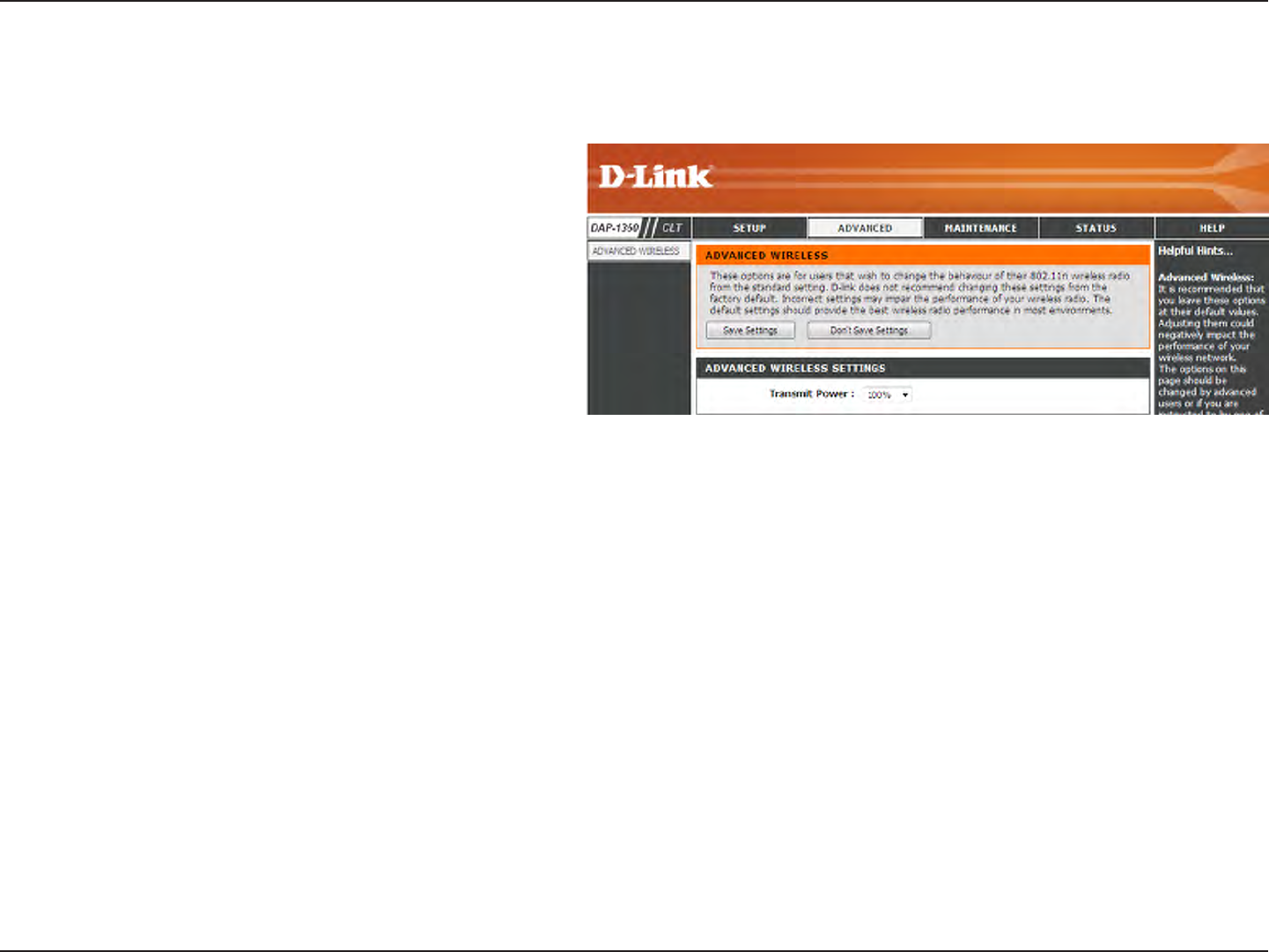
53D-Link DAP-1350 User Manual
Section 3 - Conguration
Advanced Wireless
Transmit Power: Sets the transmit power of the antennas.
Note: Transmit power is regulated by international
standard. Users are forbidden to change its
maximum limit.
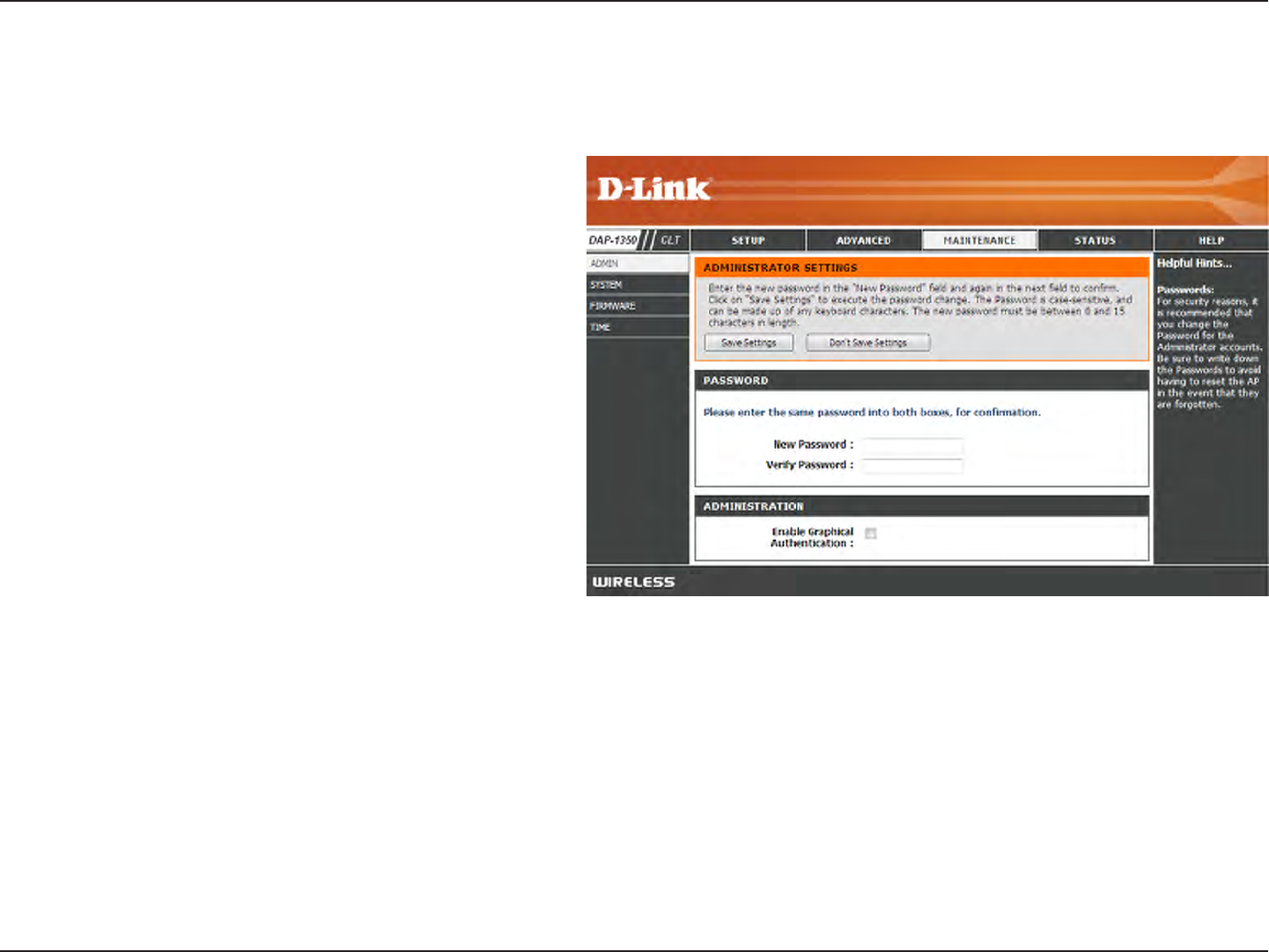
54D-Link DAP-1350 User Manual
Section 3 - Conguration
Enter a new password for the Administrator Login
Name. The administrator can make changes to the
settings.
Enter the same password that you entered in the
previous textbox in order to conrm its accuracy.
Enables a challenge-response test to require users
to type letters or numbers from a distorted image
displayed on the screen to prevent online hackers
and unauthorized users from gaining access to your
router’s network settings.
Admin
This page will allow you to change the Administrator password. The administrator password has read/write access.
Password:
Verify
Password:
Enable
Graphical
Authentication:
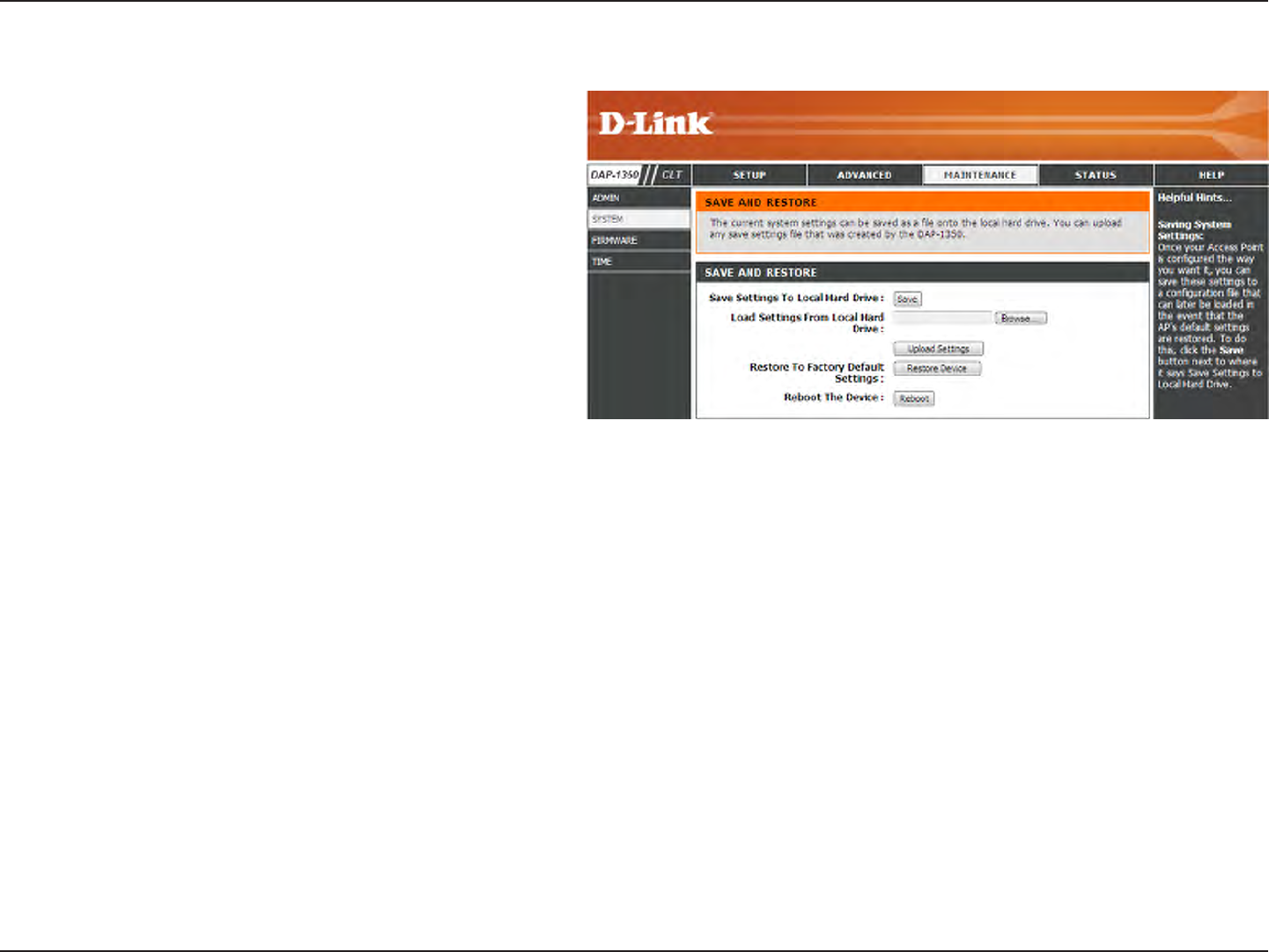
55D-Link DAP-1350 User Manual
Section 3 - Conguration
Save to Local
Hard Drive:
Load from Local
Hard Drive:
Restore to Factory
Default:
Reboot the Device:
Use this option to save the current access point
conguration settings to a le on the hard disk
of the computer you are using. Click the Save
button. You will then see a le dialog where
you can select a location and le name for the
settings.
Use this option to load previously saved access
point conguration settings. Click Browse to nd
a previously saved conguration le. Then, click
the Upload Settings button to transfer those
settings to the access point.
This option will restore all conguration settings
back to the settings that were in eect at the
time the access point was shipped from the
factory. Any settings that have not been saved
will be lost, including any rules that you have
created. If you want to save the current access
point conguration settings, use the Save button
above.
Note: Restoring the factory default settings
will not reset the Wi-Fi Protected Status to Not
Congured.
Click to reboot the access point.
System
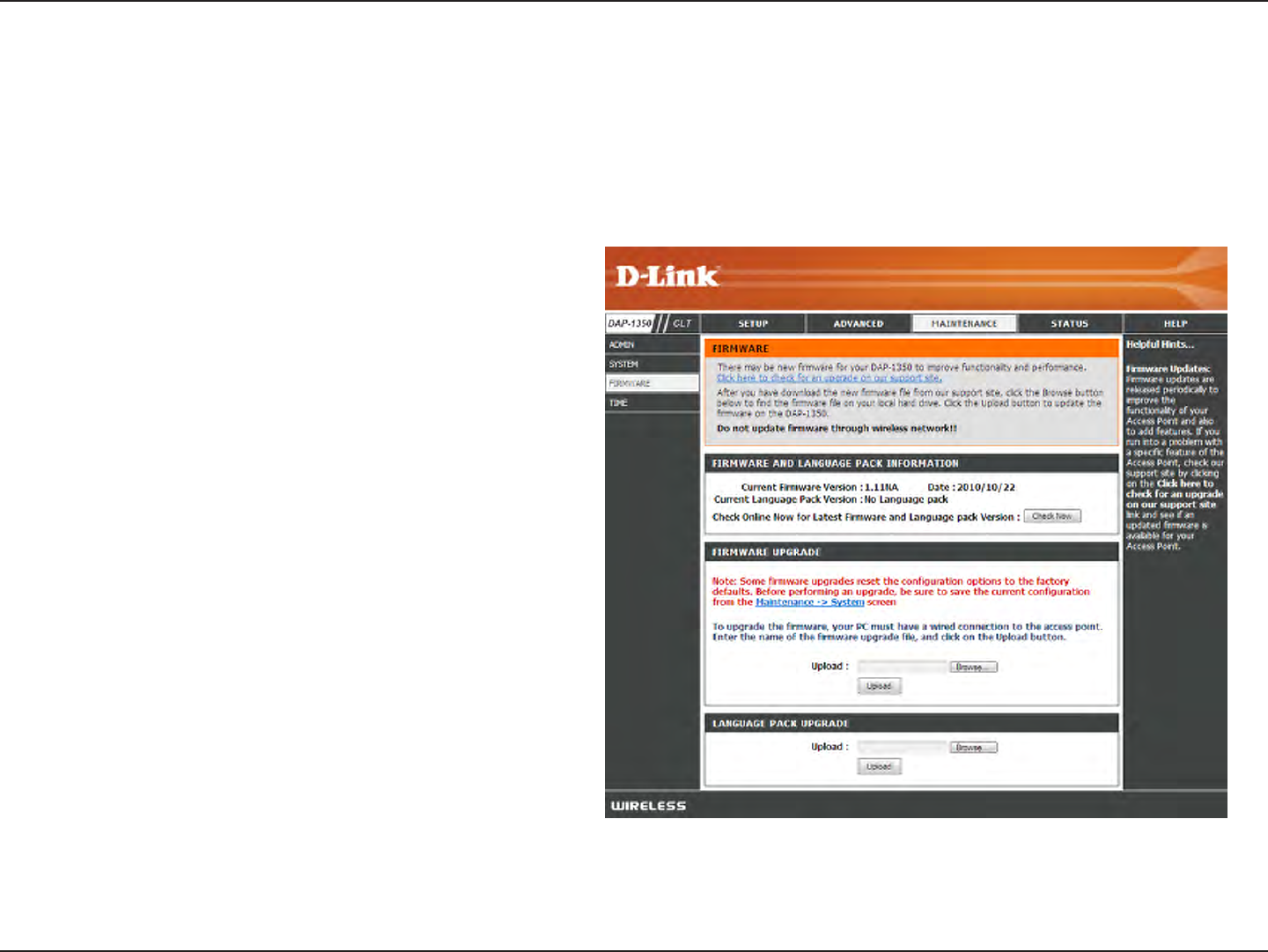
56D-Link DAP-1350 User Manual
Section 3 - Conguration
Firmware
Upgrade:
Browse:
Upload:
Click on Check Now to nd out if there is an updated
rmware; if so, download the new rmware to your
hard drive.
After you have downloaded the new rmware, click
Browse to locate the rmware update on your hard
drive. Click Upload to complete the rmware upgrade.
Once you have a rmware update on your computer,
use this option to browse for the le and then upload
the information into the access point.
Firmware
You can upgrade the rmware of the access point here. Make sure the rmware you want to use is on the local hard drive of
the computer. Click on Browse to locate the rmware le to be used for the update. Please check the D-Link support website
for rmware updates at http://support.dlink.com. You can download rmware upgrades to your hard drive from this site.
After you have downloaded the new language pack,
click Browse to locate the language pack le on your
hard drive. Click Upload to complete the language
pack upgrade.
Note: In most cases you must unzip the le rst before
uploading.
Language Pack
You can change the language of the web UI by uploading
available language packs.
Browse:
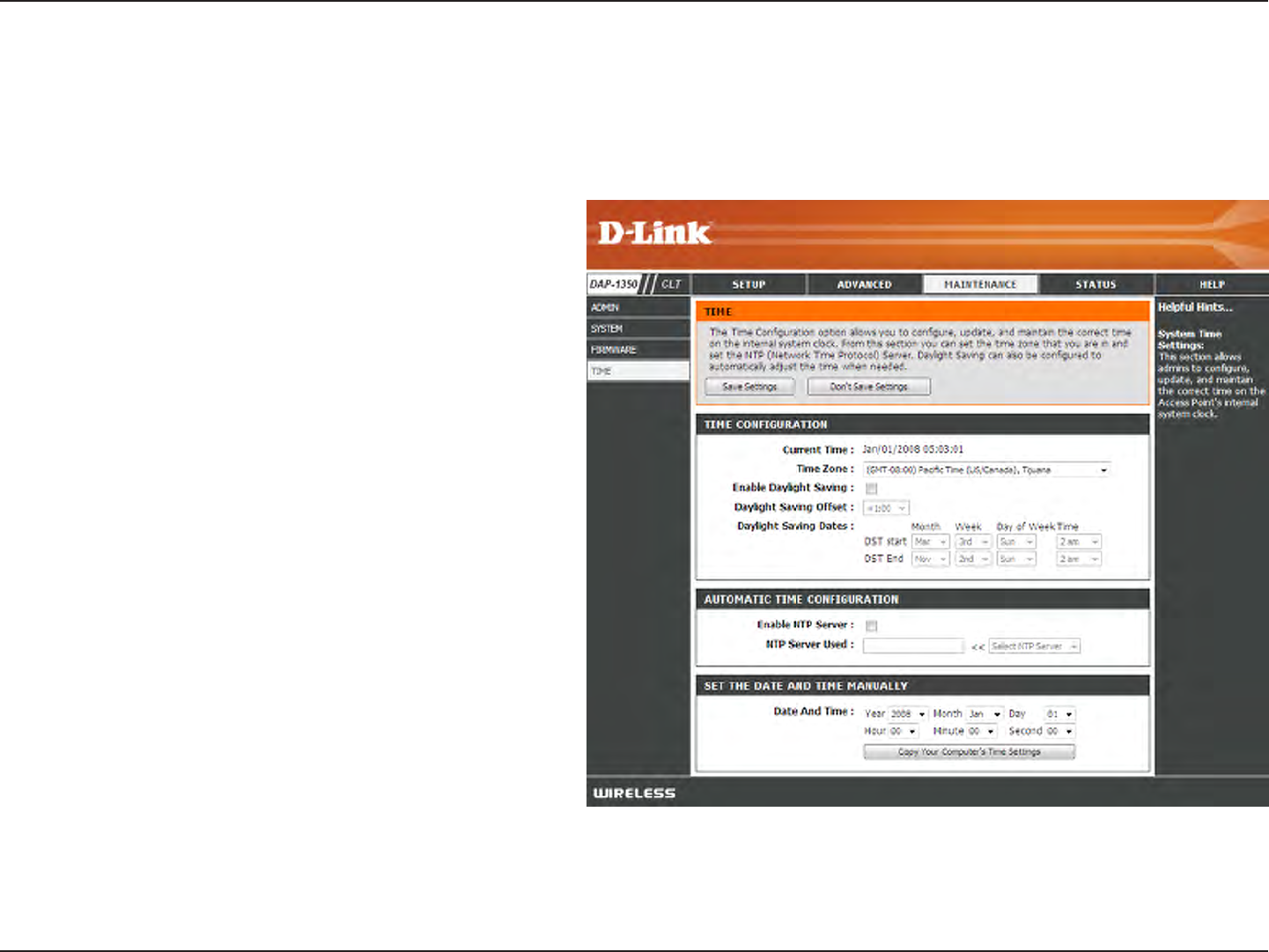
57D-Link DAP-1350 User Manual
Section 3 - Conguration
Time Zone:
Enable Daylight
Saving:
Enable NTP Server:
NTP Server Used:
Date and Time:
Select the Time Zone from the drop-down menu.
To select Daylight Saving time manually, click the
Enable Daylight Saving check box. Next use the
drop-down menu to select a Daylight Saving
Oset and then enter a start date and an end date
for daylight saving time.
NTP is short for Network Time Protocol. NTP
synchronizes computer clock times in a network
of computers. Check this box to use a NTP server.
This will only connect to a server on the Internet,
not a local server.
Enter the NTP server or select one from the drop-
down menu.
To manually input the time, enter the values in
these elds for the Year, Month, Day, Hour, Minute,
and Second and then click Save Settings. You
can also click the Copy Your Computer’s Time
Settings button at the bottom of the screen.
Time
The Time Conguration option allows you to congure, update, and maintain the correct time on the internal system clock.
From this section you can set the time zone that you are in. Daylight Saving can also be congured to automatically adjust the
time when needed.
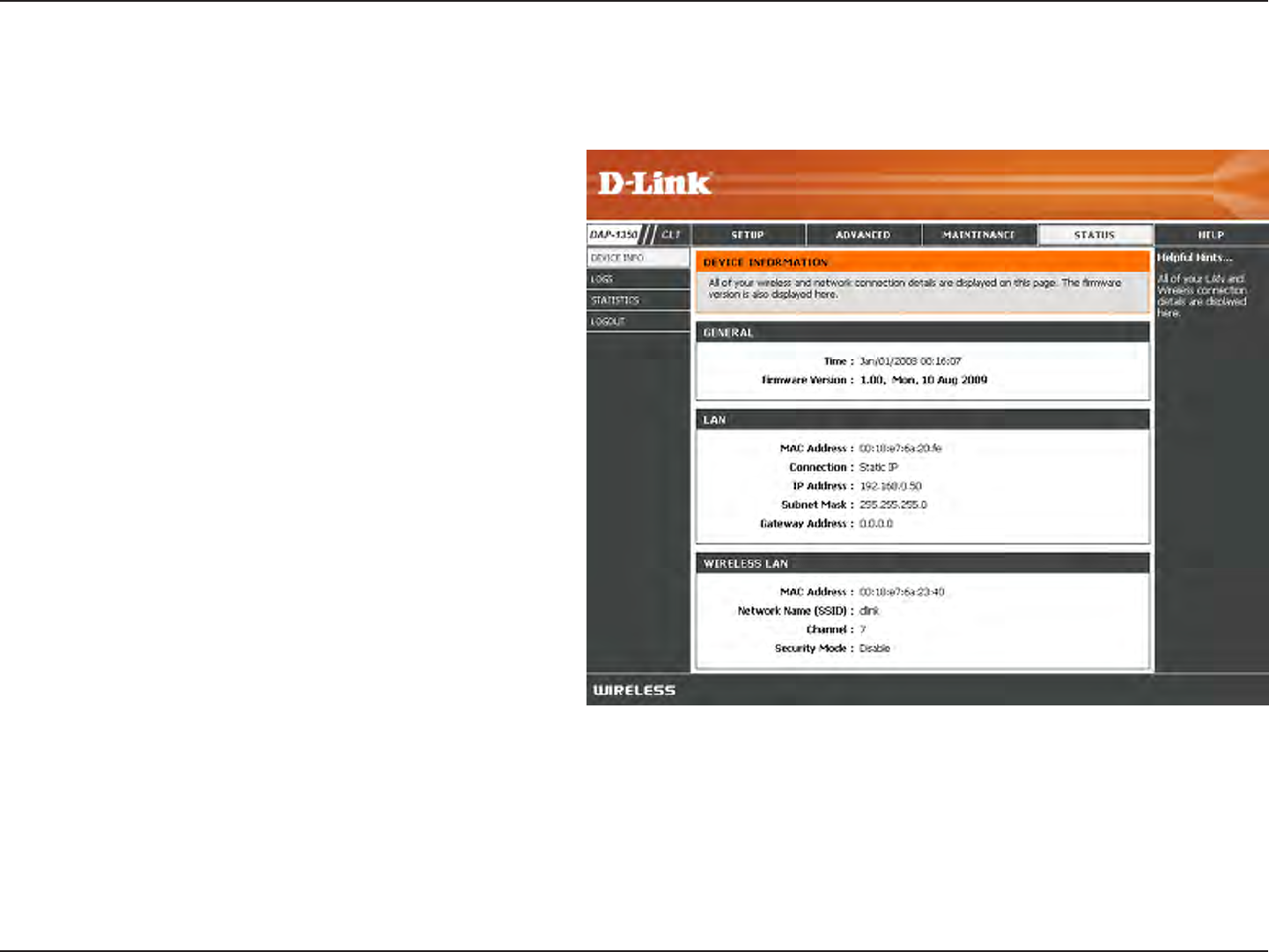
58D-Link DAP-1350 User Manual
Section 3 - Conguration
General:
LAN:
Wireless LAN:
Displays the access point’s time and firmware
version.
Displays the MAC address and the private (local) IP
settings for the access point.
Displays the wireless MAC address and your
wireless settings such as SSID and Channel.
This page displays the current information for the DAP-1350. It will display the LAN and wireless LAN information.
Device Info
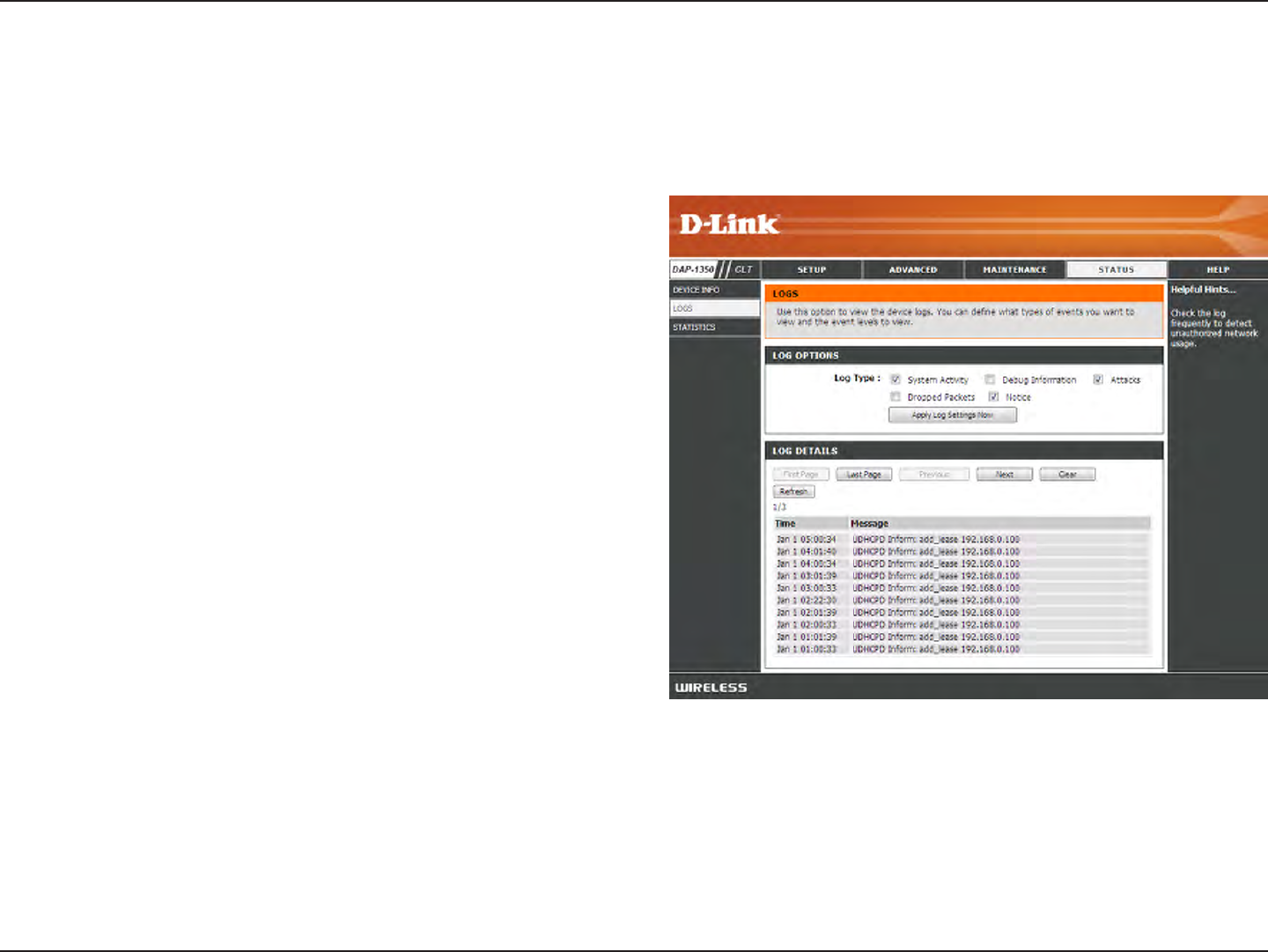
59D-Link DAP-1350 User Manual
Section 3 - Conguration
Log Options:
First Page:
Last Page:
Previous:
Next:
Clear:
Log Settings:
Refresh:
You can select the types of messages that you want
to display from the log: System Activity, Debug
Information, Attacks, Dropped Packets, and Notice.
Select and click Apply Log Settings Now.
This button directs you to the rst page of the log.
This button directs you to the last page of the log.
This button directs you to the previous page of the log.
This button directs you to the next page of the log.
This button clears all current log content.
This button opens a new menu where you can congure
the log settings.
This button refreshes the log.
Logs
The DAP-1350 keeps a running log of events and activities occurring on the AP. If the AP is rebooted, the logs are automatically
cleared. You can save the log les under Log Settings.
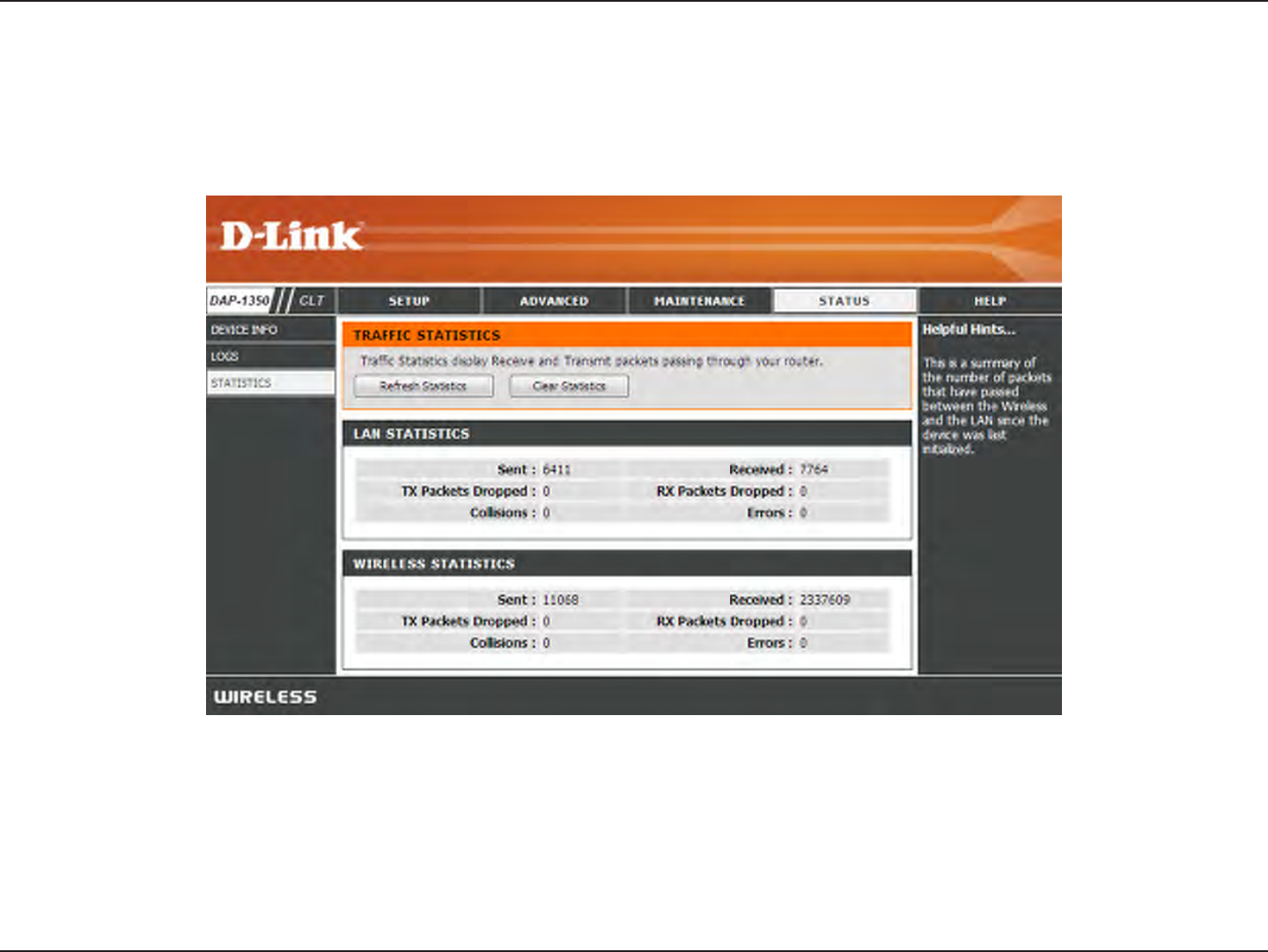
60D-Link DAP-1350 User Manual
Section 3 - Conguration
Statistics
The DAP-1350 keeps statistics of the trac that passes through it. You can view the amount of packets that pass through the LAN
and wireless portions of the network. The trac counter will reset if the access point is rebooted.
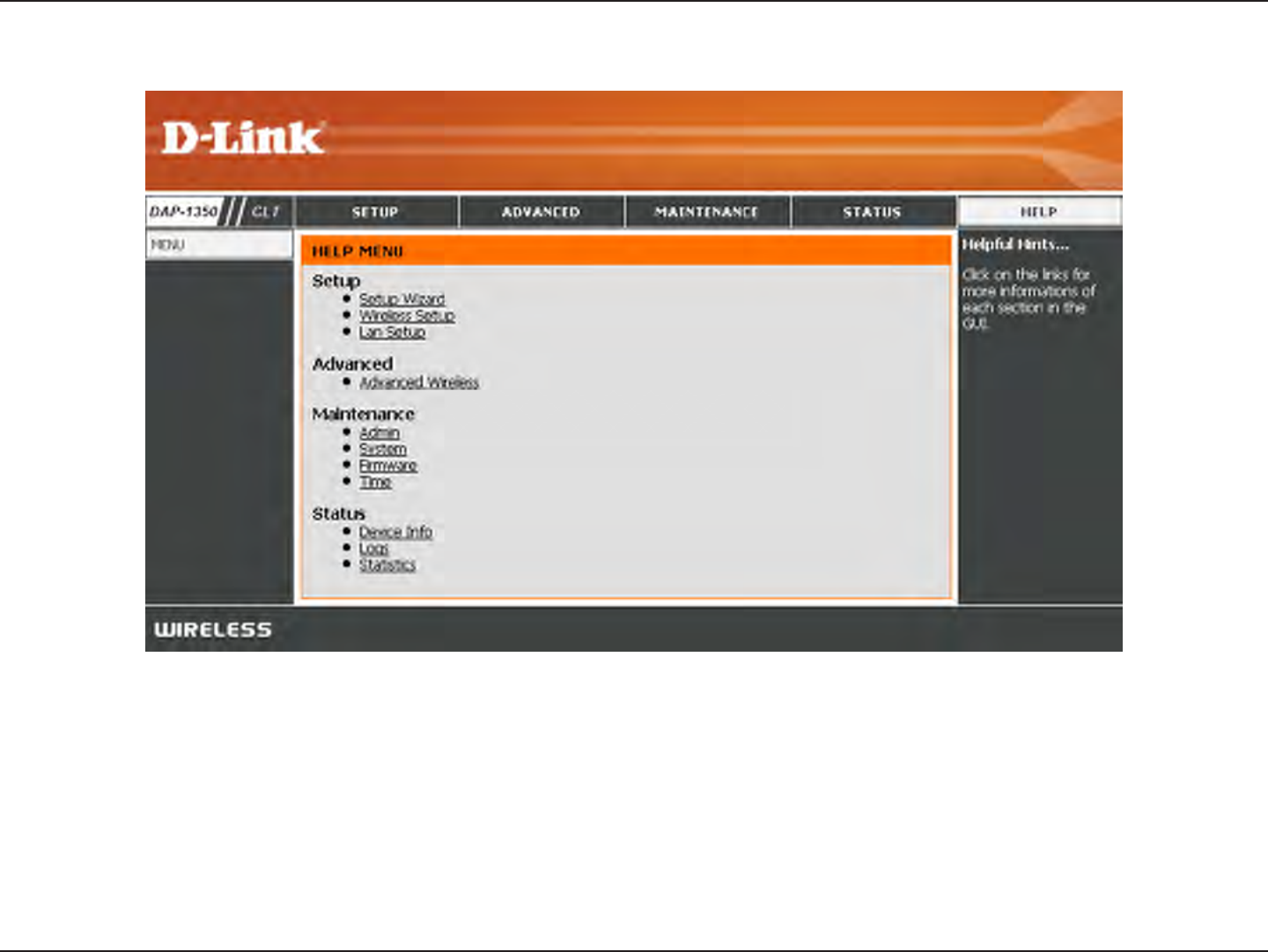
61D-Link DAP-1350 User Manual
Section 3 - Conguration
Help
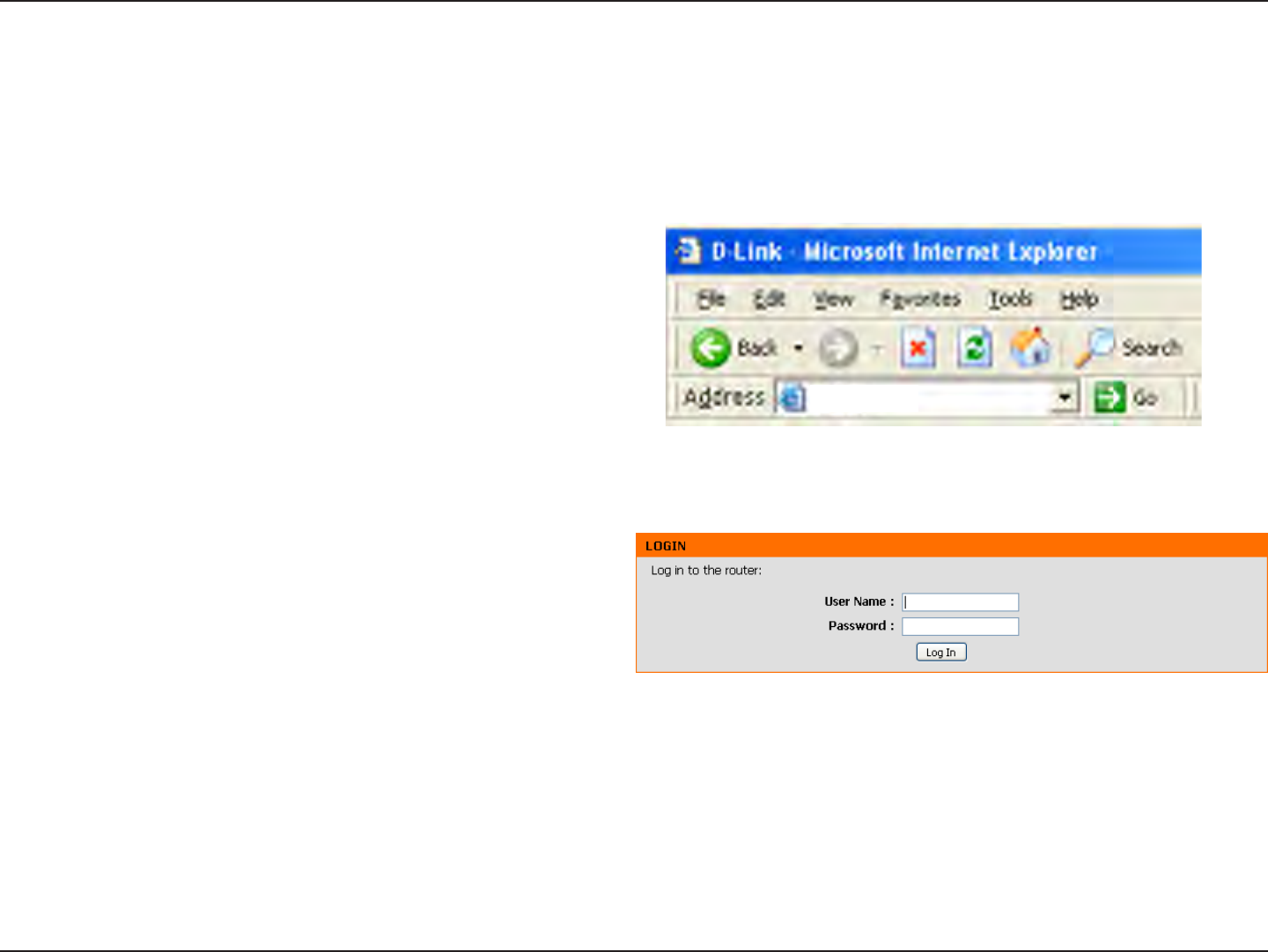
62D-Link DAP-1350 User Manual
Section 3 - Conguration
Router Mode
If you wish to change the default settings or optimize the
performance of the DAP-1350, you may use the web-based
conguration utility.
To access the conguration utility, open a web browser
such as Internet Explorer and enter http://dlinkap or
http://192.168.0.50 in the address eld.
Type admin and then enter your password. Leave the
password blank by default.
If you get a Page Cannot be Displayed error, please refer to
the Troubleshooting section for assistance.
Change the mode selector to RT on the device. Connect an Ethernet cable from the Ethernet port on the DAP-1350 to your
broadband modem. You will need to connect wirelessly to the DAP-1350 to congure it.
http://dlinkap
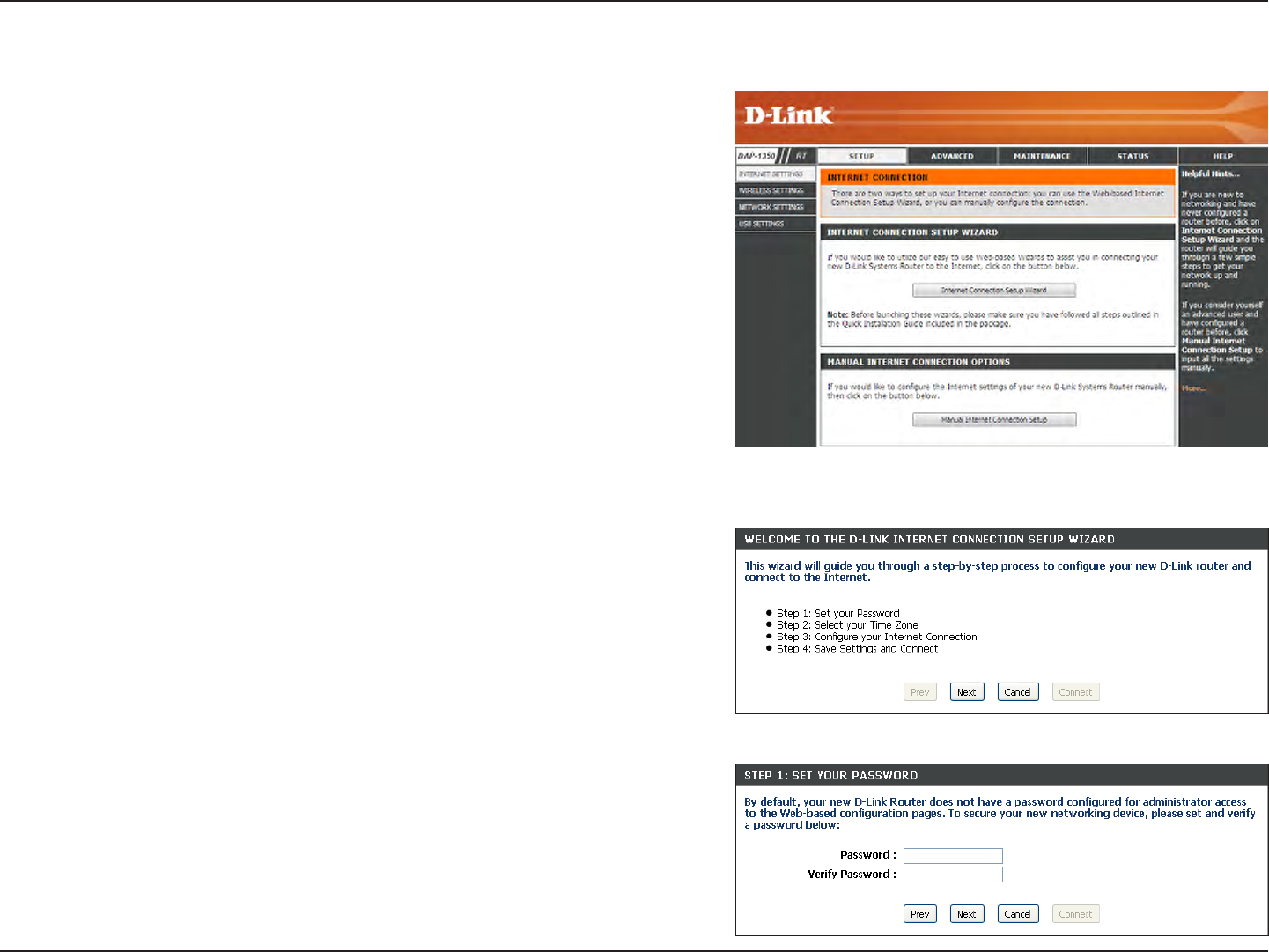
63D-Link DAP-1350 User Manual
Section 3 - Conguration
Click Launch Internet Connection Setup Wizard to begin.
If you want to enter your settings without running the wizard, click
Manual Internet Conguration Setup and skip to page 65.
Setup Wizard
Click Next to continue.
Create a new password and then click Next to continue.
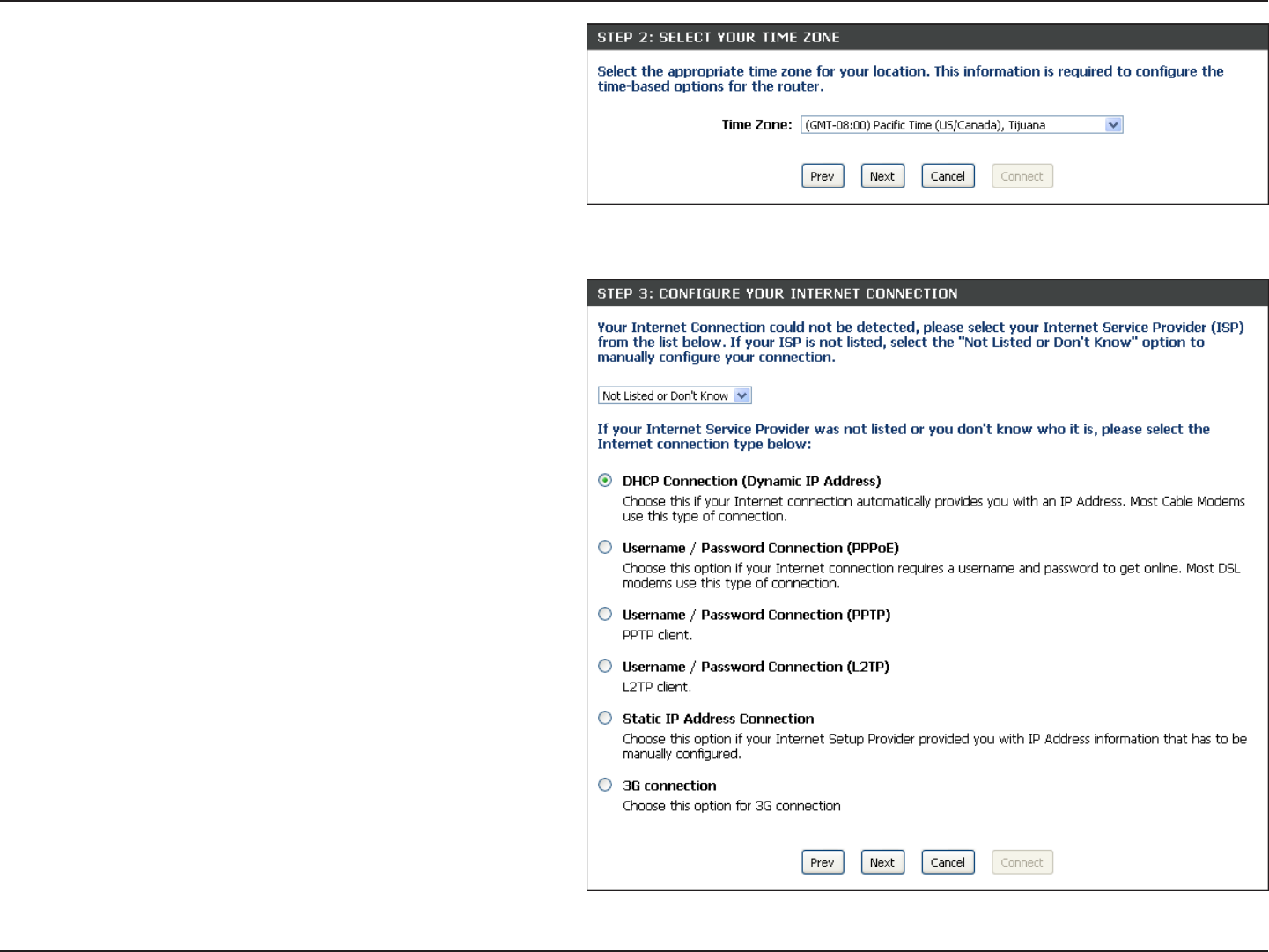
64D-Link DAP-1350 User Manual
Section 3 - Conguration
Select your time zone from the drop-down menu and
then click Next to continue.
Select the type of Internet connection you use and then
click Next to continue.
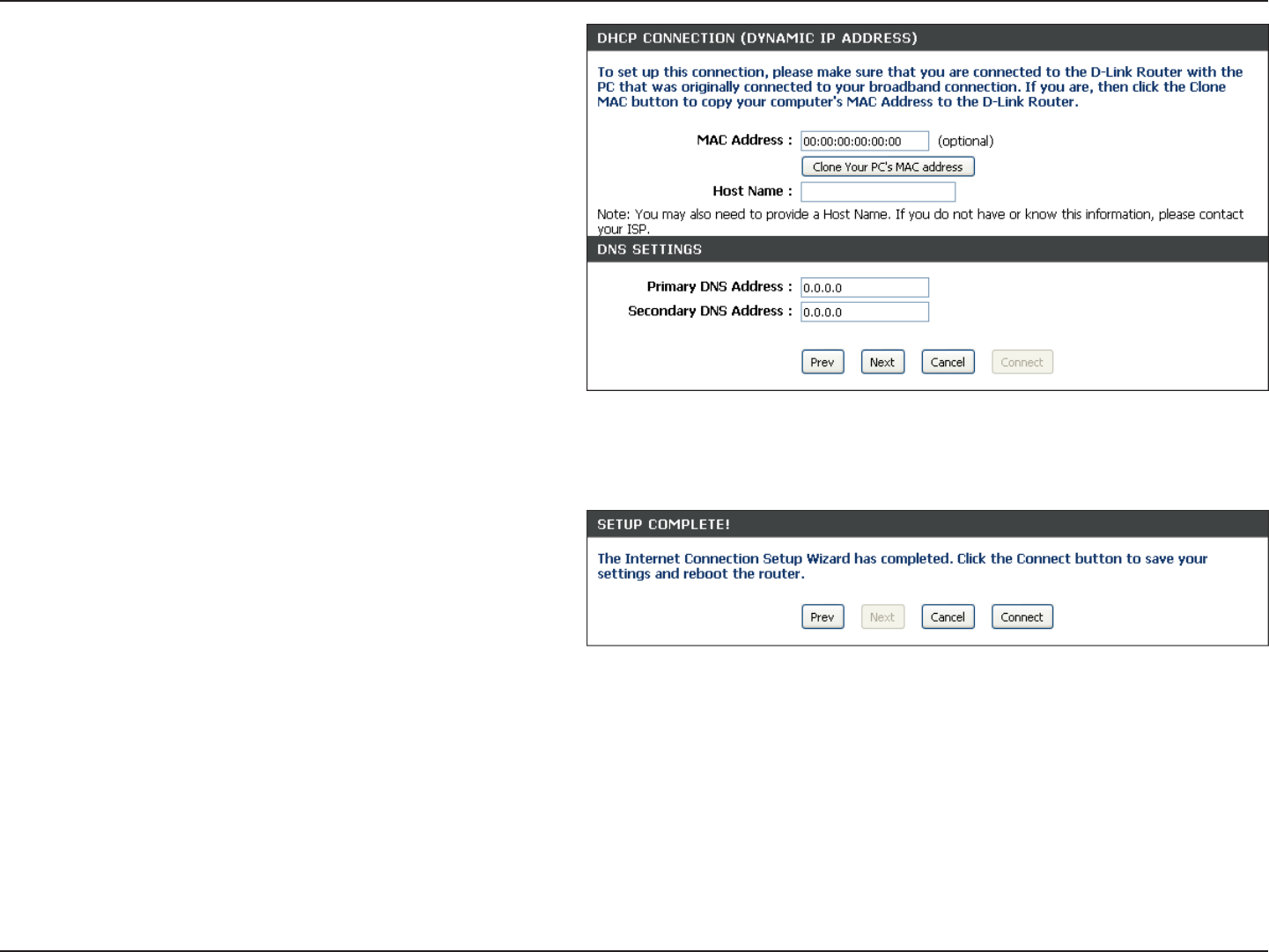
65D-Link DAP-1350 User Manual
Section 3 - Conguration
If you selected Dynamic, you may need to enter the
MAC address of the computer that was last connected
directly to your modem. If you are currently using that
computer, click Clone Your PC’s MAC Address and then
click Next to continue.
The Host Name is optional but may be required by some
ISPs. The default host name is the device name of the
Router and may be changed.
Click Connect to save your settings. Once the router
is nished rebooting, click Continue. Please allow 1-2
minutes to connect.
Close your browser window and reopen it to test your
Internet connection. It may take a few tries to initially
connect to the Internet.
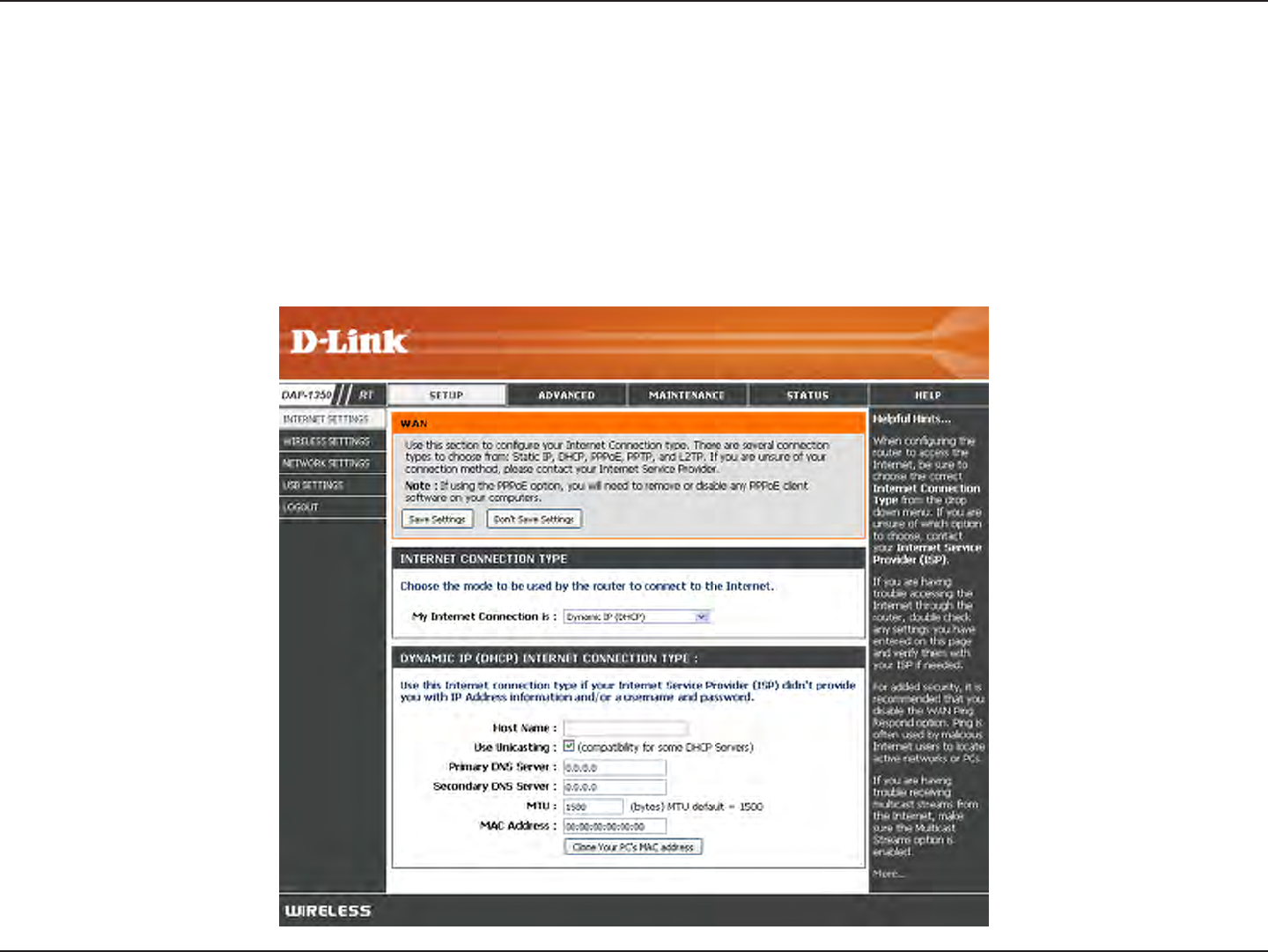
66D-Link DAP-1350 User Manual
Section 3 - Conguration
Internet Setup
If you opt to set up your Internet connection manually, you will be redirected to a WAN page that allows you to select your
Internet type and enter the correct conguration parameters.
Select your Internet connection type using the “My Internet Connection is” drop-down menu.
Click the Save Settings button when you have congured the connection.
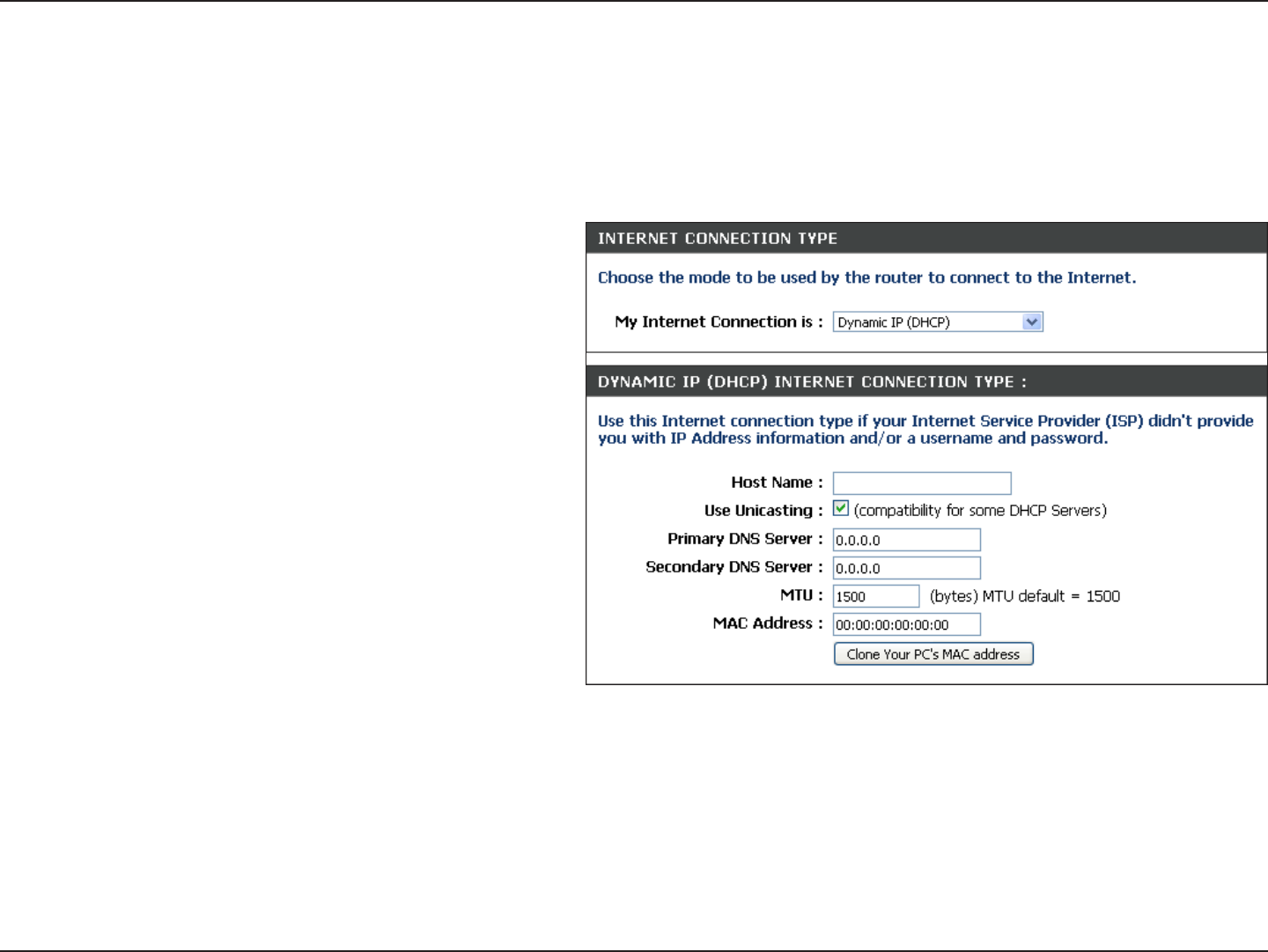
67D-Link DAP-1350 User Manual
Section 3 - Conguration
Dynamic IP (DHCP)
Select Dynamic IP(DHCP) to obtain IP Address information automatically from your ISP. Select this option if your ISP does not
give you any IP number to use. This option is commonly used for Cable modem services.
Host Name:
Use Unicasting:
DNS Server:
MTU:
MAC Address:
The Host Name is optional but may be required
by some ISPs.
Select if you are having problems obtaining an
IP address from your DHCP server.
Enter the Primary and Secondary DNS server
IP address assigned by your ISP.
You may need to change the MTU (Maximum
Transmission Unit) for optimal performance
with your specic ISP. The default MTU size is
1500.
The default MAC address is set to the Ethernet
MAC address your DAP-1350. You can click
the Clone Your PC’s MAC Address button to
replace the AP’s MAC address with the MAC
address of the PC that you used to register
with your ISP. It is not recommended that
you change the default MAC address unless
required by your ISP.
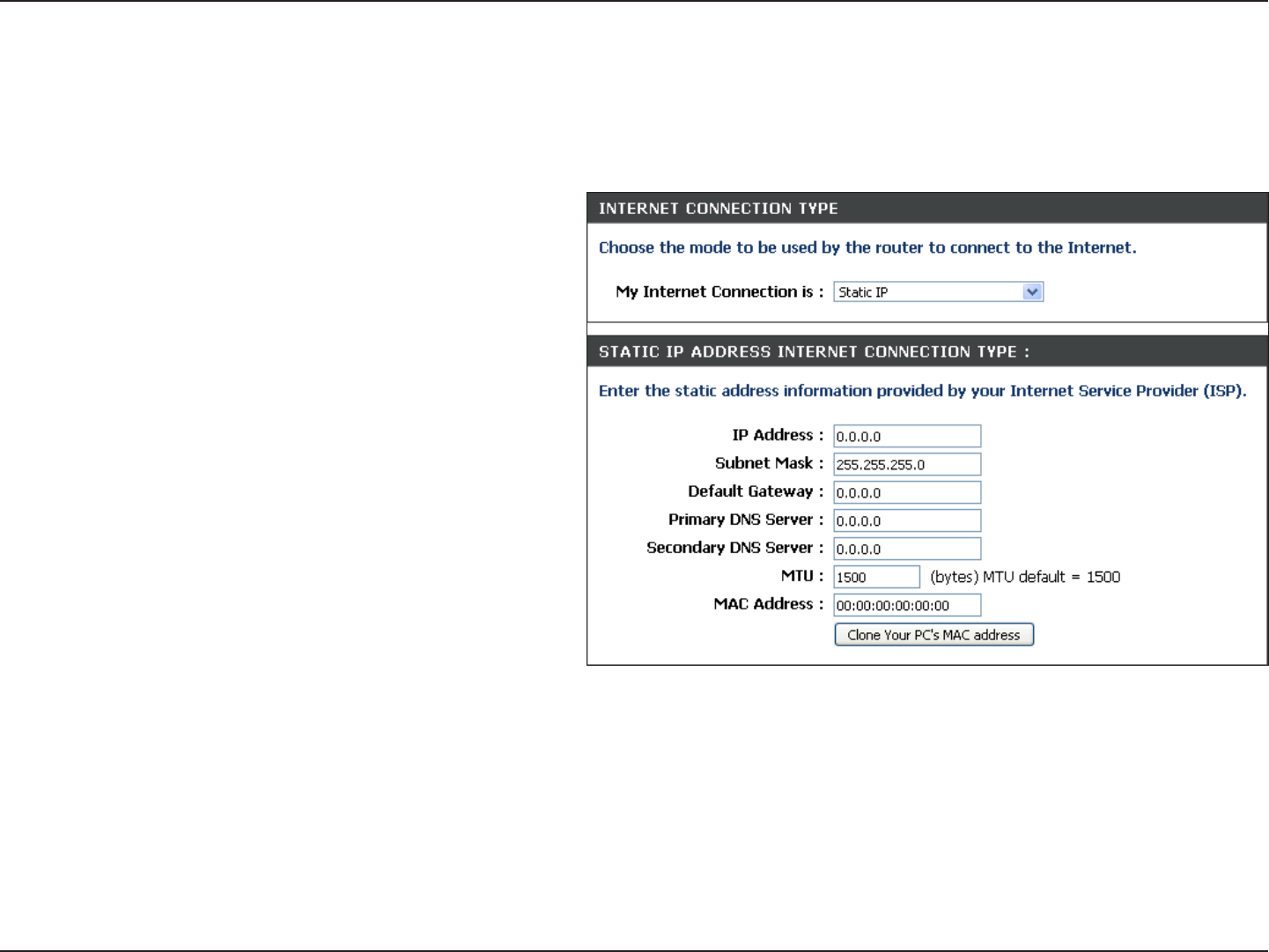
68D-Link DAP-1350 User Manual
Section 3 - Conguration
Static IP
Select Static IP if all WAN IP information is provided to you by your ISP. You will need to enter in the IP address, subnet mask,
gateway address, and DNS address(es) provided to you by your ISP.
IP Address:
Subnet Mask:
Default Gateway:
Primary DNS Server:
Secondary DNS Server:
MTU:
Clone MAC Address:
Enter the IP Address provided by your ISP
(Internet Service Provider).
255.255.255.0 is the default subnet mask.
All devices on the network must have the
same subnet mask to communicate on the
network.
Enter the IP Address of the gateway in your
network.
Enter the Primary DNS (Domain Name
System) server IP address assigned by your
ISP.
Enter the Secondary DNS (optional) server IP
address assigned by your ISP.
You may need to change the MTU (Maximum
Transmission Unit) for optimal performance
with your specic ISP. The default MTU size is 1500.
The default MAC address is set to the MAC address on the AP (Access Point). You can click the Clone Your PC’s MAC Address
button to replace the AP’s MAC address with the MAC address of your Ethernet card. It is not recommended that you change
the default MAC address unless required by your ISP.
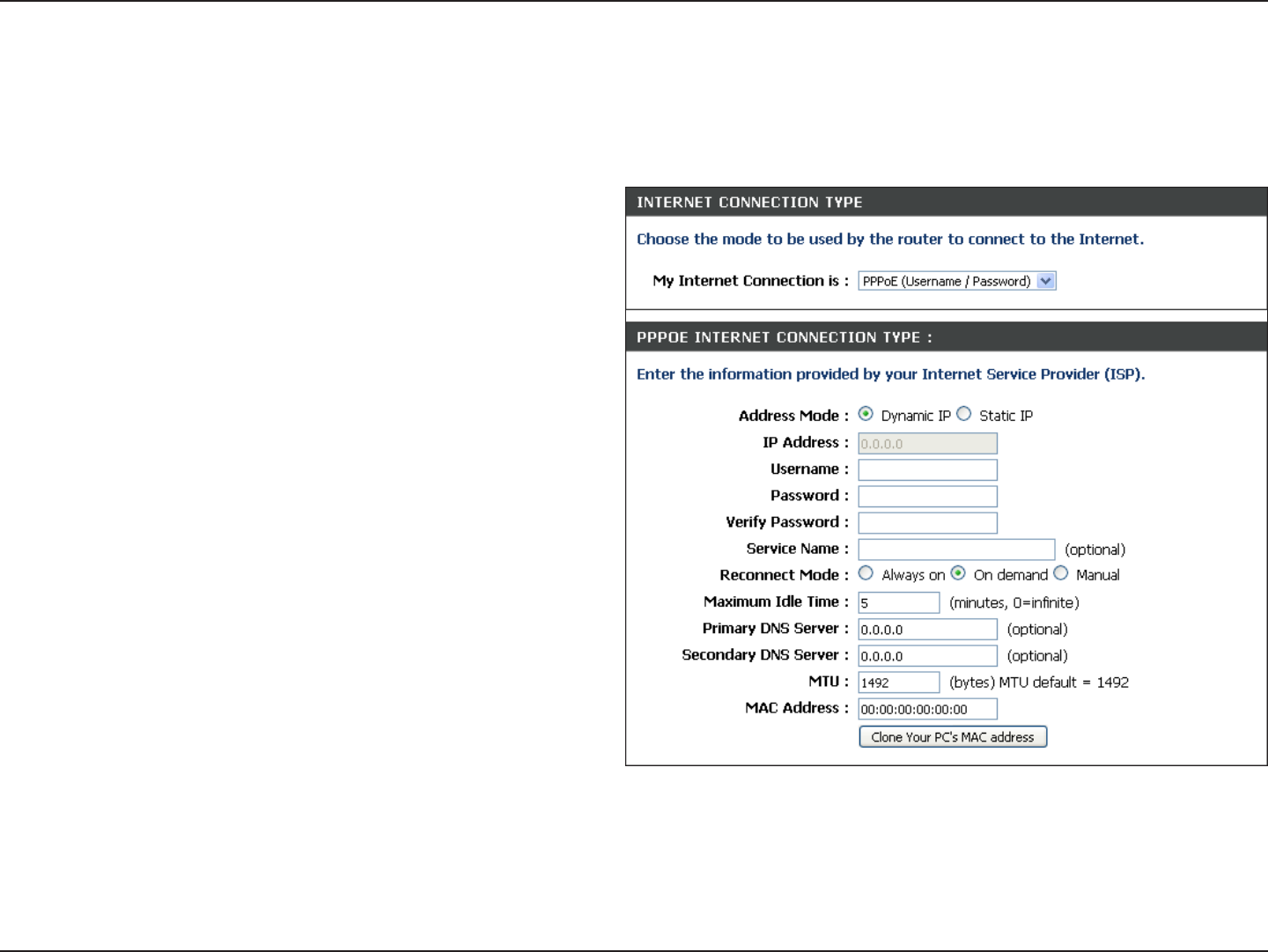
69D-Link DAP-1350 User Manual
Section 3 - Conguration
PPPoE
Select PPPoE (Point-to-Point Protocol over Ethernet) if your ISP uses a PPPoE connection. Your ISP will provide you with a
username and password. This option is typically used for DSL services. Make sure to remove your PPPoE software from your
computer. The software is no longer needed and will not work through the DAP-1350.
Username:
Password:
Service Name:
Reconnect Mode:
Maximum Idle Time:
DNS Servers:
MTU:
Clone MAC Address:
Enter your PPPoE user name.
Enter your PPPoE password and then retype the
password in the next box.
Enter the ISP Service Name (optional).
Select Always on, On Demand or Manual.
Enter the time (in minutes) where the router will
disconnect if idle for the time specied.
Enter the Primary and Secondary DNS (Domain
Name System) server IP address assigned by your
ISP.
You may need to change the MTU (Maximum
Transmission Unit) for optimal performance with
your specic ISP. The default MTU size is 1400.
The default MAC address is set to the MAC address
on the AP (Access Point). You can click the Clone
Your PC’s MAC Address button to replace the
AP’s MAC address with the MAC address of your
Ethernet card. It is not recommended that you change the default MAC address unless required by your ISP.
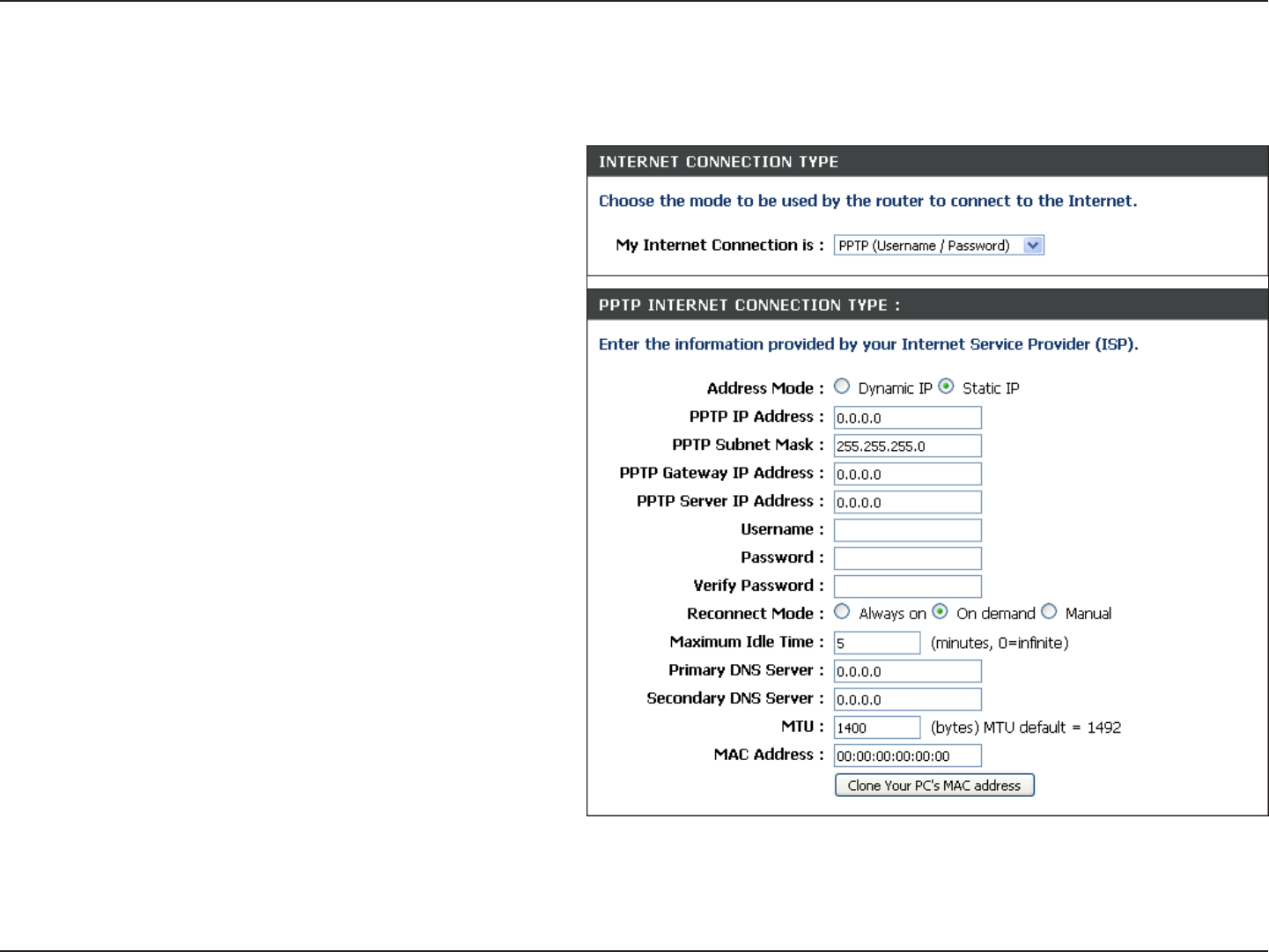
70D-Link DAP-1350 User Manual
Section 3 - Conguration
PPTP
Choose PPTP (Point-to-Point Tunneling Protocol) if your ISP uses a PPTP connection. Your ISP will provide you with a username
and password. This option is typically used for DSL services.
PPTP IP Address:
PPTP Subnet Mask:
PPTP Server IP Address:
Username:
Password:
Reconnect Mode:
Maximum Idle Time:
DNS Servers:
MTU:
Clone MAC Address:
Enter the IP address (Static PPTP only).
Enter the subnet mask.
Enter the Server IP Address provided by your
ISP.
Enter your PPTP username.
Enter your PPTP password and then retype
the password in the next box.
Select Always on, On Demand or Manual.
Enter the time (in minutes) where the router
will disconnect if idle for the time specied.
Enter the Primary and Secondary DNS
(Domain Name System) server IP address
assigned by your ISP.
You may need to change the MTU (Maximum
Transmission Unit) for optimal performance
with your specic ISP. The default MTU size
is 1400.
The default MAC address is set to the MAC
address on the AP (Access Point). You can click the Clone Your PC’s MAC Address button to replace the AP’s MAC address with
the MAC address of your Ethernet card. It is not recommended that you change the default MAC address unless required by
your ISP.
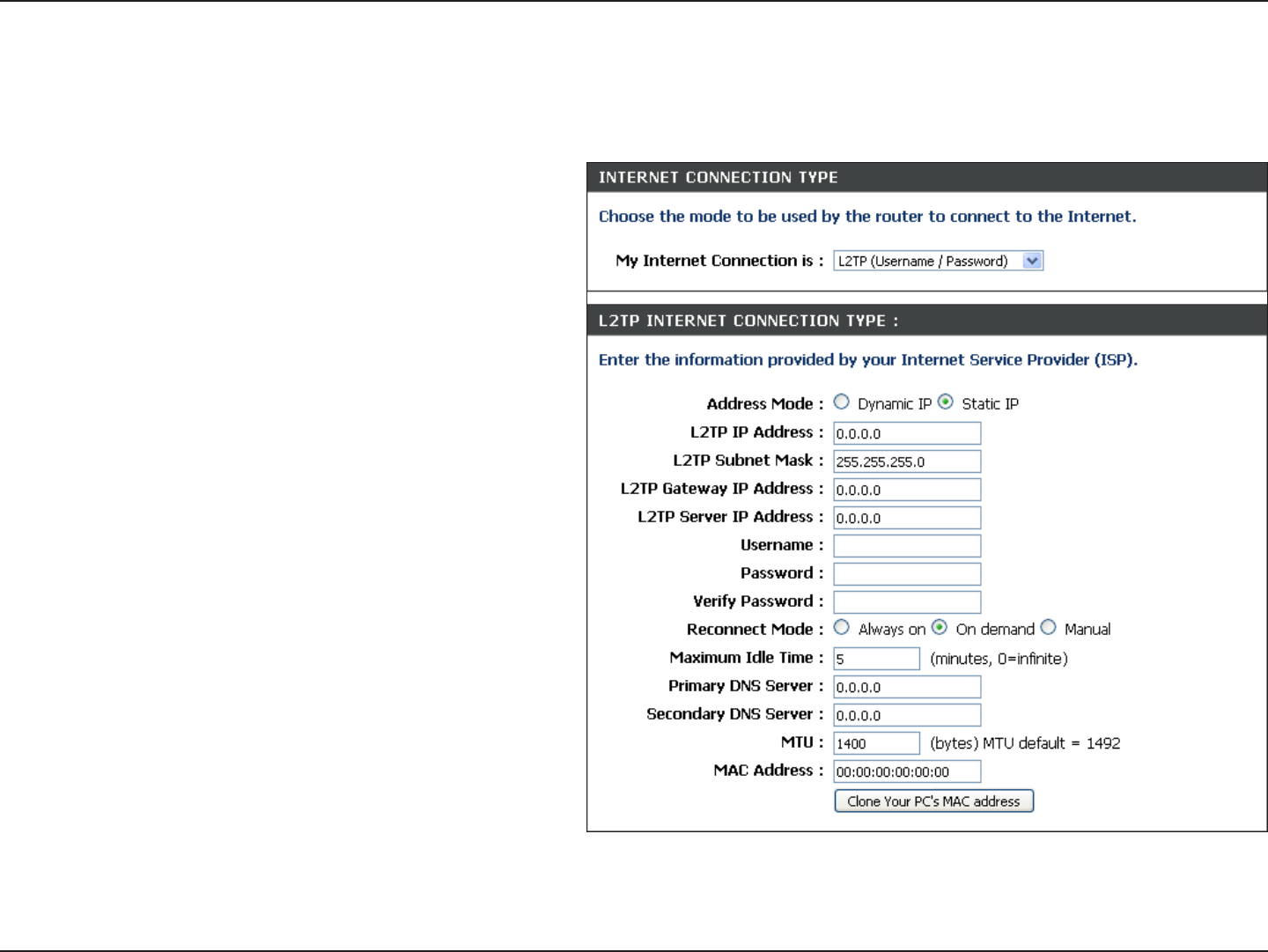
71D-Link DAP-1350 User Manual
Section 3 - Conguration
L2TP
Choose L2TP (Point-to-Point Tunneling Protocol) if your ISP uses a L2TP connection. Your ISP will provide you with a username
and password. This option is typically used for DSL services.
PPTP IP Address:
PPTP Subnet Mask:
PPTP Server IP Address:
Username:
Password:
Reconnect Mode:
Maximum Idle Time:
DNS Servers:
MTU:
Clone MAC Address:
Enter the IP address (Static PPTP only).
Enter the subnet mask.
Enter the Server IP Address provided by your
ISP.
Enter your PPTP username.
Enter your PPTP password and then retype
the password in the next box.
Select Always on, On Demand or Manual.
Enter the time (in minutes) where the router
will disconnect if idle for the time specied.
Enter the Primary and Secondary DNS
(Domain Name System) server IP address
assigned by your ISP.
You may need to change the MTU (Maximum
Transmission Unit) for optimal performance
with your specic ISP. The default MTU size
is 1400.
The default MAC address is set to the MAC
address on the AP (Access Point). You can click
the Clone Your PC’s MAC Address button to replace the AP’s MAC address with the MAC address of your Ethernet card. It is
not recommended that you change the default MAC address unless required by your ISP.
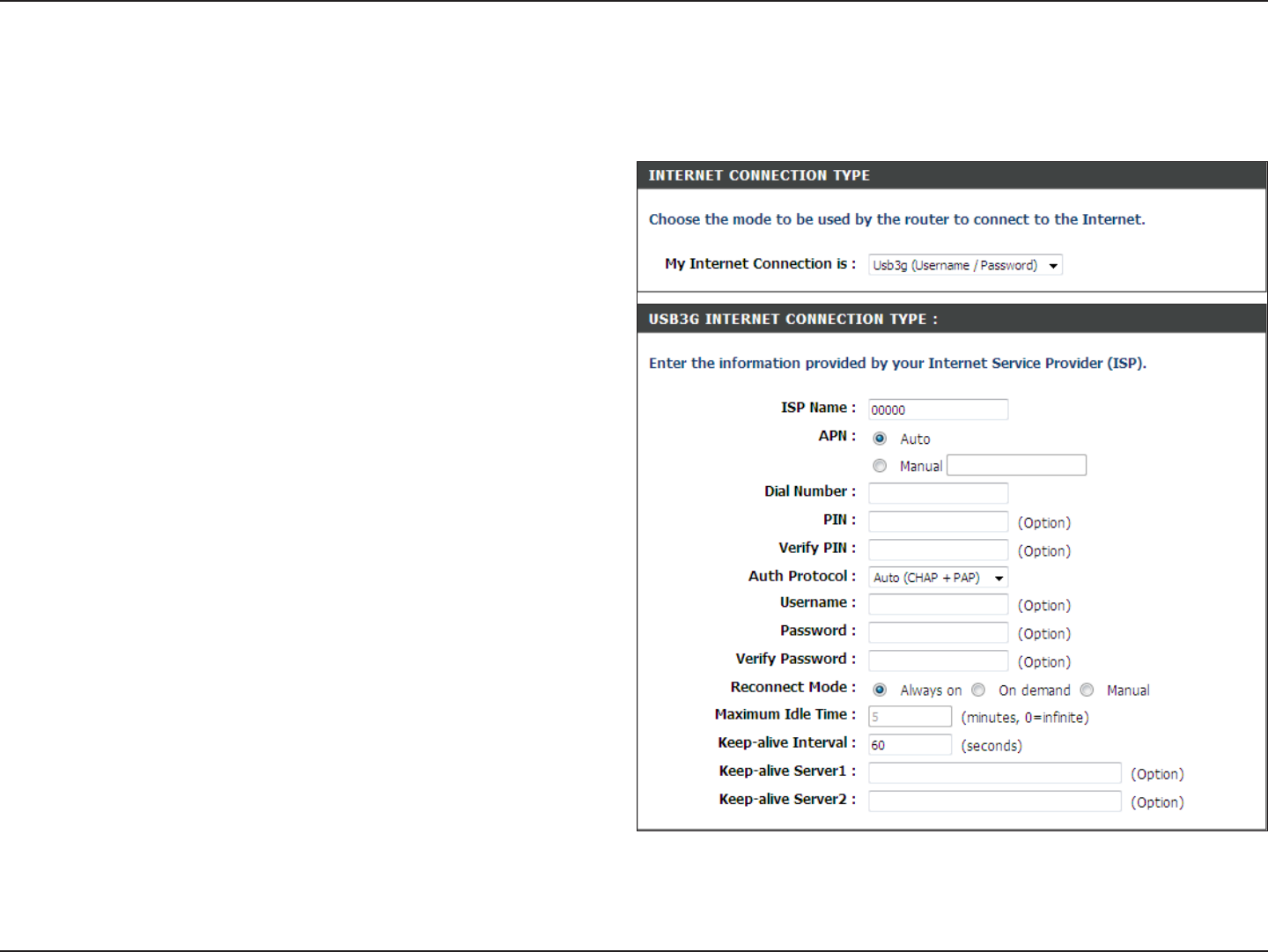
72D-Link DAP-1350 User Manual
Section 3 - Conguration
USB3G
Choose USB3g if you are using an USB 3G adapter for your Internet connection.
ISP Name:
APN:
Dial Number:
PIN:
Verify PIN:
Auth Protocol:
Username:
Password:
Verify Password:
Reconnect Mode:
Maximum Idle Time:
Keep-alive Interval:
Keep-alive Server 1:
Keep-alive Server 2:
Enter your Internet Service Provider (ISP) name.
Select Auto or Manual. If you select manual, enter the
Access Point Name (APN) for your 3G service provider.
Enter the dial number for your 3G service provider.
Enter your PIN.
Enter your PIN again to verify.
Select the protocol from the drop-down menu.
Enter your username.
Enter your password.
Enter your password again to verify.
Select the reconnect mode (Always on, On Demand,
or Manual).
Enter the maximum amount of time the Internet
connection should be maintained during inactivity. To
disable this feature, enable the Always-on reconnect
mode.
Enter the keep-alive interval (in seconds). When idle, the
DAP-1350 will send keep-alive alerts so your connection
will not be dropped.
Enter your primary keep-alive server.
Enter your secondary keep-alive server.
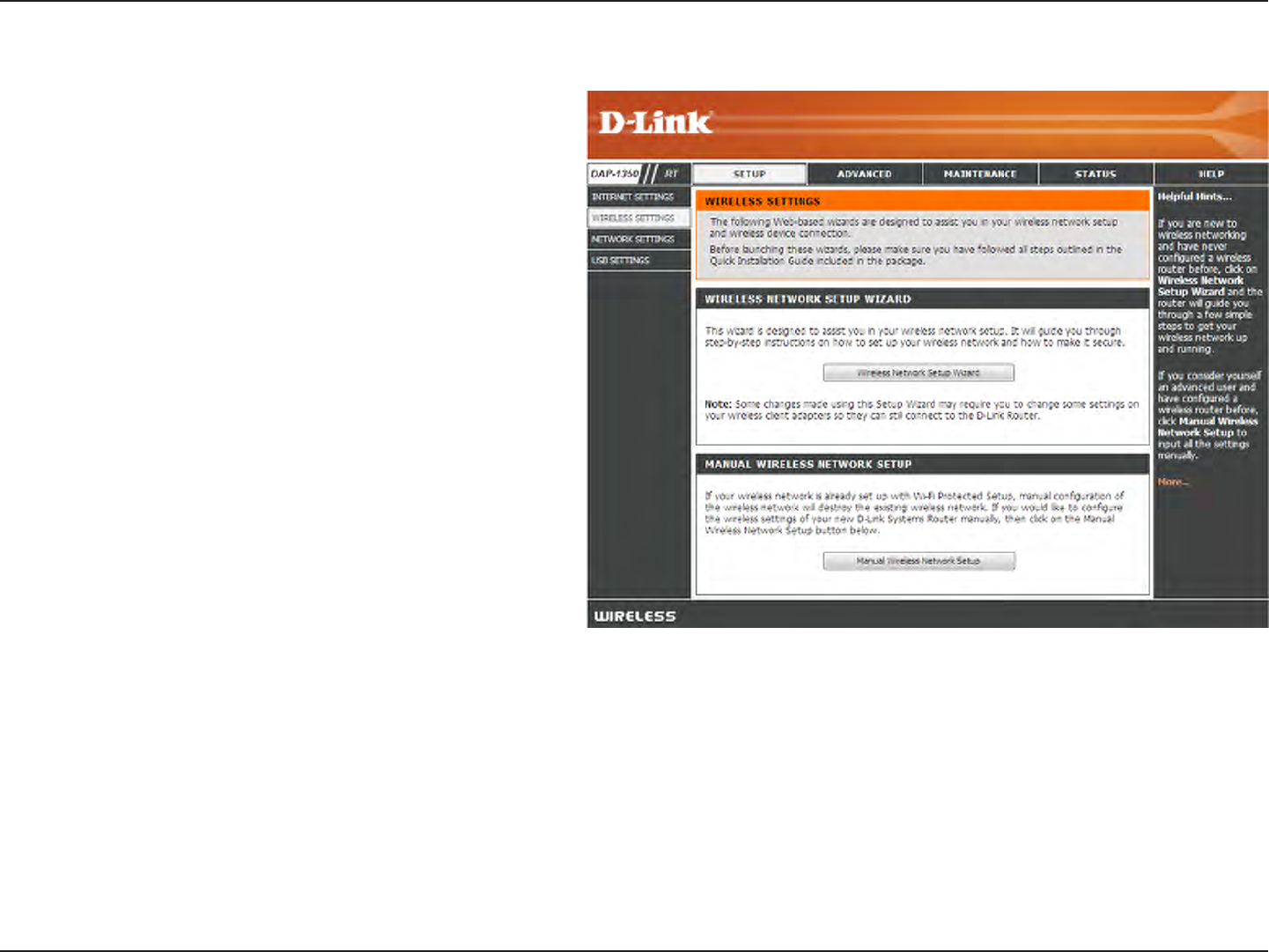
73D-Link DAP-1350 User Manual
Section 3 - Conguration
Wireless Setup Wizard
You may click Wireless Network Setup Wizard to
quickly congure your router. Refer to the next page.
If you want to enter your settings without running the
wizard, click Manual Wireless Network Setup and skip
to page 77.
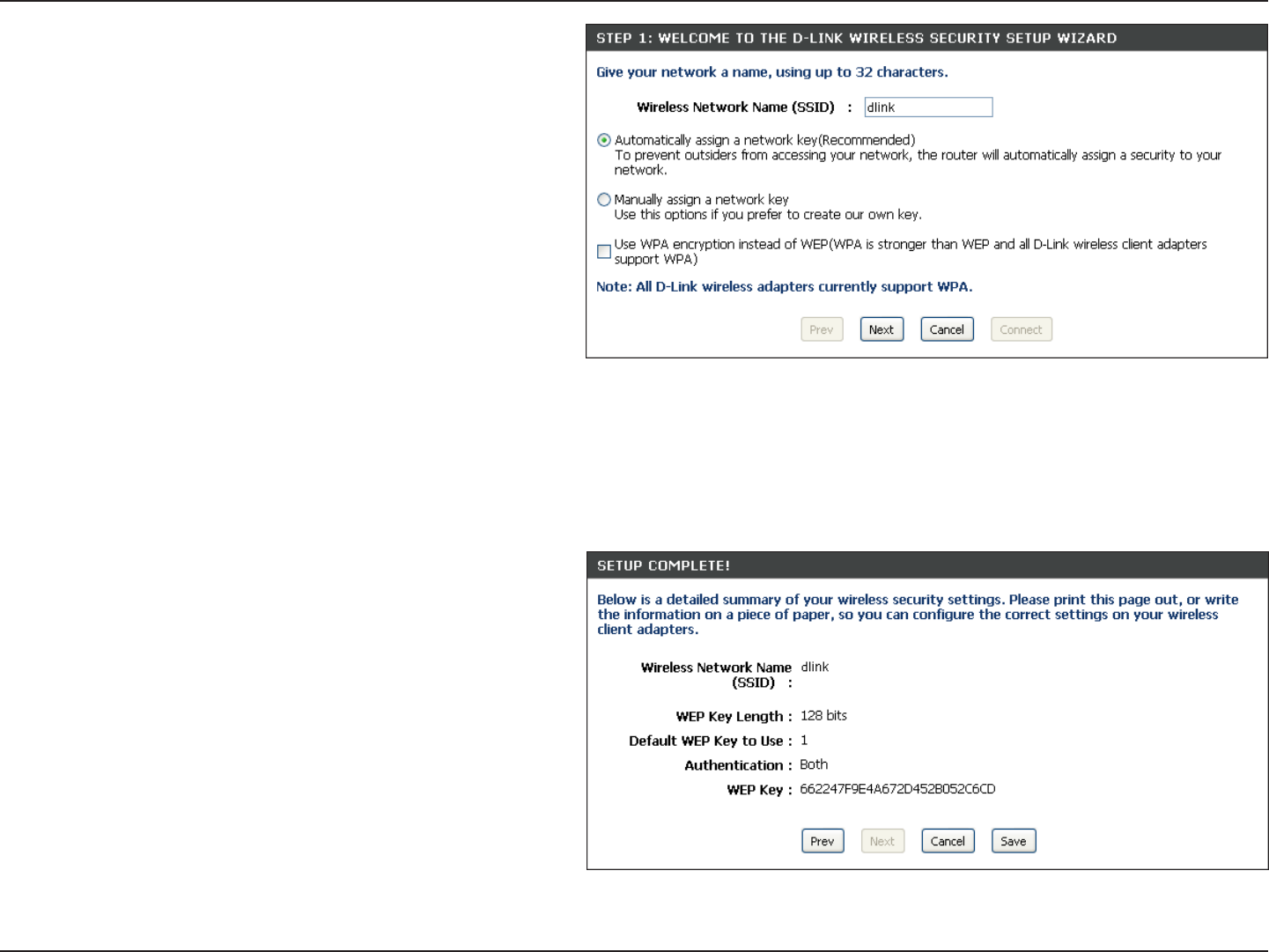
74D-Link DAP-1350 User Manual
Section 3 - Conguration
Type your desired wireless network name (SSID).
Automatically: Select this option to automatically
generate the router’s network key and click Next.
Manually: Select this option to manually enter
your network key and click Next.
If you selected Automatically, the summary window
will display your settings. Write down the security key
and enter this on your wireless clients. Click Save to
save your settings.
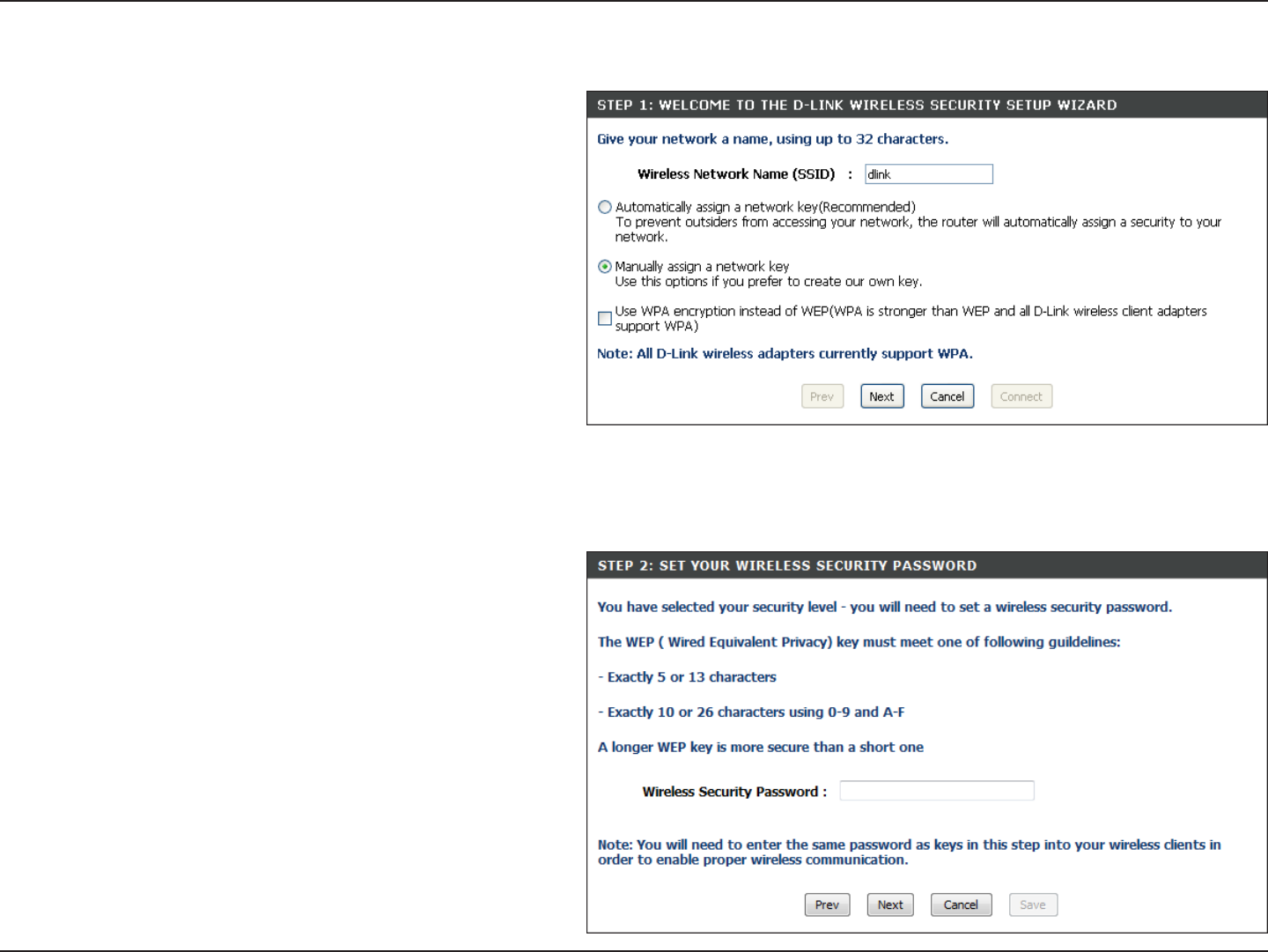
75D-Link DAP-1350 User Manual
Section 3 - Conguration
If you selected Manually assign a network key as the
conguration method, enter your network key. This key
must be entered on your wireless clients.
Check the Use WPA encryption instead of WEP box to
use WPA Encryption instead of WEP.
Click Next to continue.
For WEP encryption, enter a Network Key exactly 5 or
13 characters long or exactly 10 or 26 characters using
0-9 and A-F.
Click Next to continue.
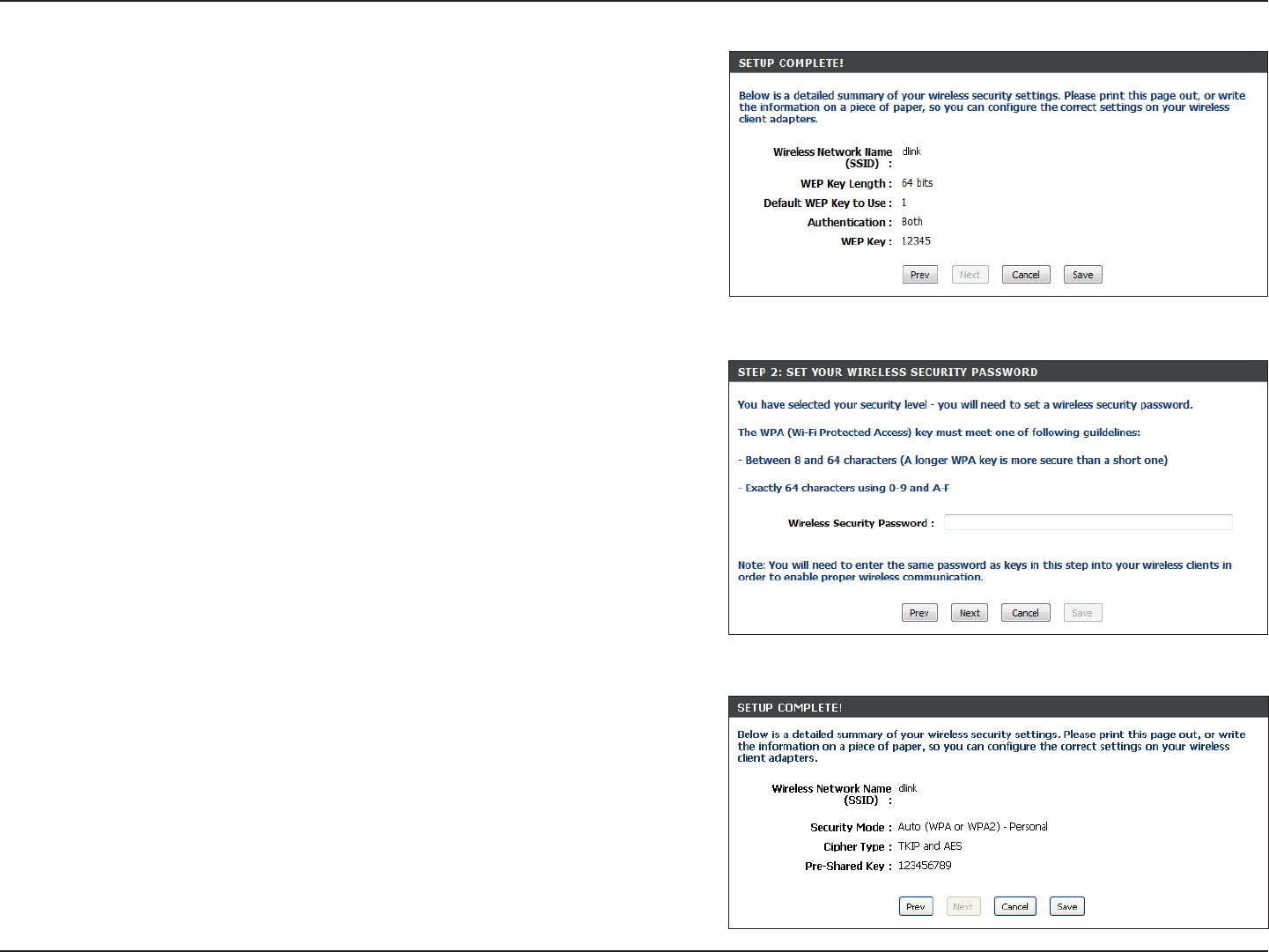
76D-Link DAP-1350 User Manual
Section 3 - Conguration
If you select WPA, enter the wireless security password (8-32
characters). Click Next to complete the Setup Wizard.
Click Next to continue.
The summary screen will appear.
Click Save to continue.
The summary screen will appear.
Click Save to continue.
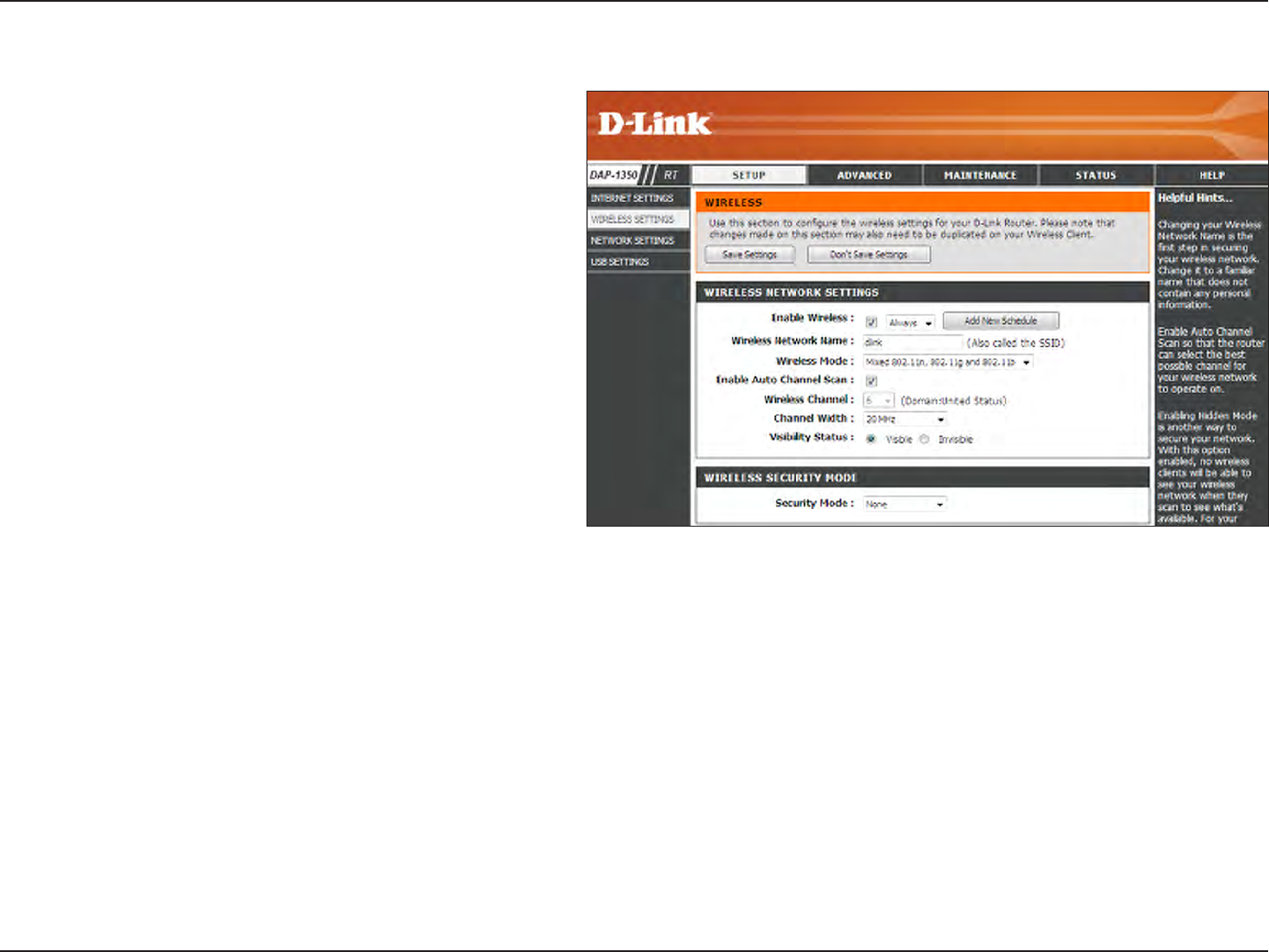
77D-Link DAP-1350 User Manual
Section 3 - Conguration
Wireless Settings
Enable Wireless:
Wireless Network
Name:
Wireless Mode:
Enable Auto
Channel Scan:
Wireless Channel:
Channel Width:
Visibility Status:
Wireless Security
Mode:
Select this to turn the Wi-Fi module on and o.
Use the drop-down box to select if you want to
use a schedule. Click Add New Schedule to add
or change a schedule.
Enter a wireless network name (SSID) for your
network (up to 32 characters).
Select one of the following:
802.11n Only - Select if you are only using 802.11n
wireless clients.
Mixed 802.11n and 802.11g - Select if you are
using a mix of 802.11n and 11g wireless clients.
Mixed 802.11n, 802.11g and 802.11b - Select
if you are using a mix of 802.11n, 11g, and 11b
wireless clients.
Check this box to have the device automatically
scan for the best available channel.
Select a wireless channel. It is recommended to use channels 1,6, or 11.
Select the appropriate channel width between 20MHz or Auto 20/40MHz from the drop-down menu.
Select Invisible if you do not want the SSID of your wireless network to be broadcast by the DAP-1350. If Invisible is selected, the
SSID of the DAP-1350 will not be seen by Site Survey utilities so your wireless clients will have to know the SSID of your DAP-1350
in order to connect to it.
Select a wireless security setting. Options are None, WEP, WPA, or WPA2. Refer to the Wireless Security section of this manual for a
detailed explanation of the wireless security options.
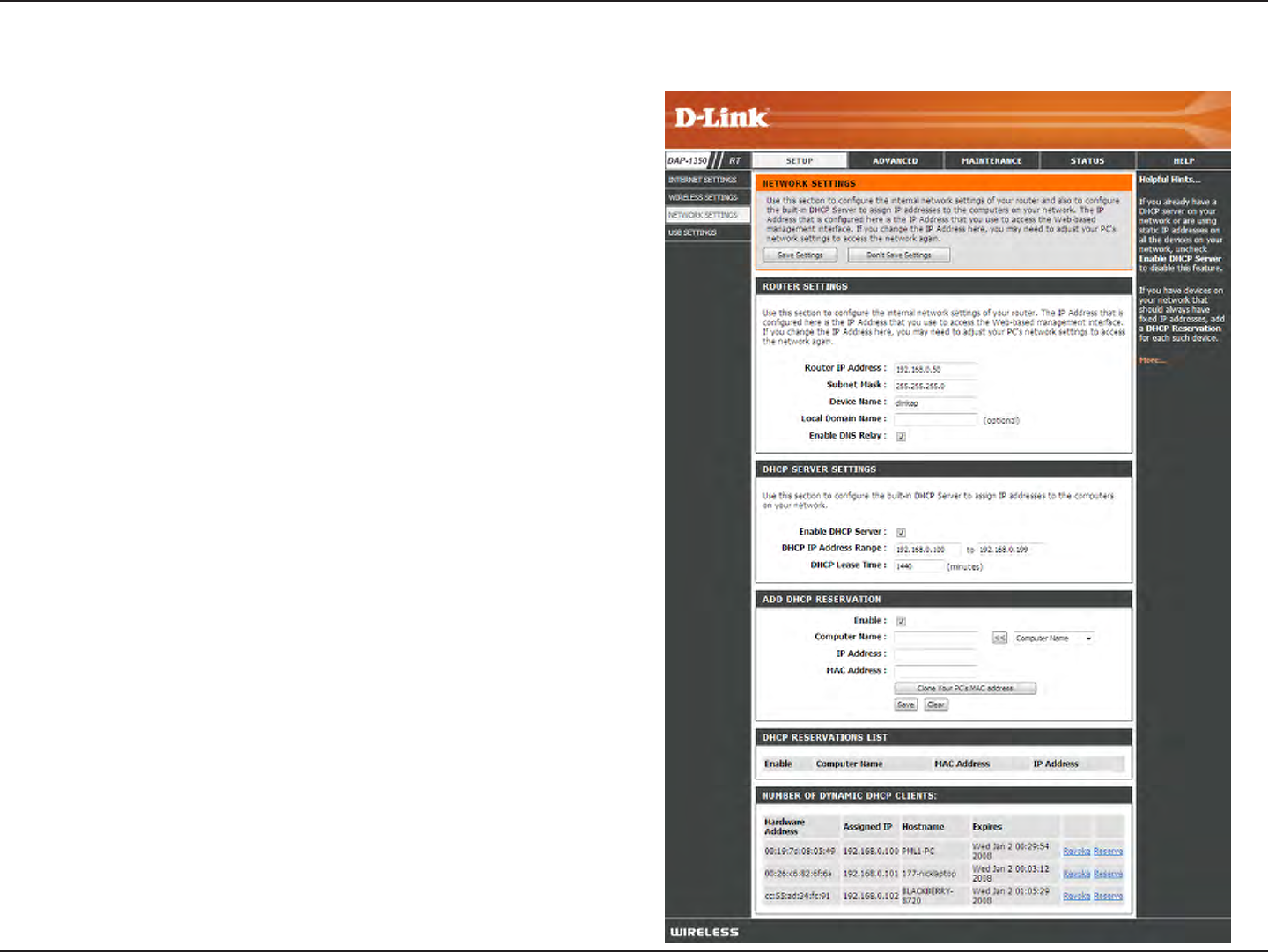
78D-Link DAP-1350 User Manual
Section 3 - Conguration
Network Settings
Enter the IP address of the router. The default IP address
is 192.168.0.1.
If you change the IP address, once you click Apply, you
will need to enter the new IP address in your browser to
get back into the conguration utility.
Enter the Subnet Mask. The default subnet mask is
255.255.255.0.
Enter a name for the DAP-1350.
Enter the Domain name (Optional).
Uncheck the box to transfer the DNS server information
from your ISP to your computers. If checked, your
computers will use the router for a DNS server.
IP Address:
Subnet Mask:
Device Name:
Local Domain:
Enable DNS Relay:
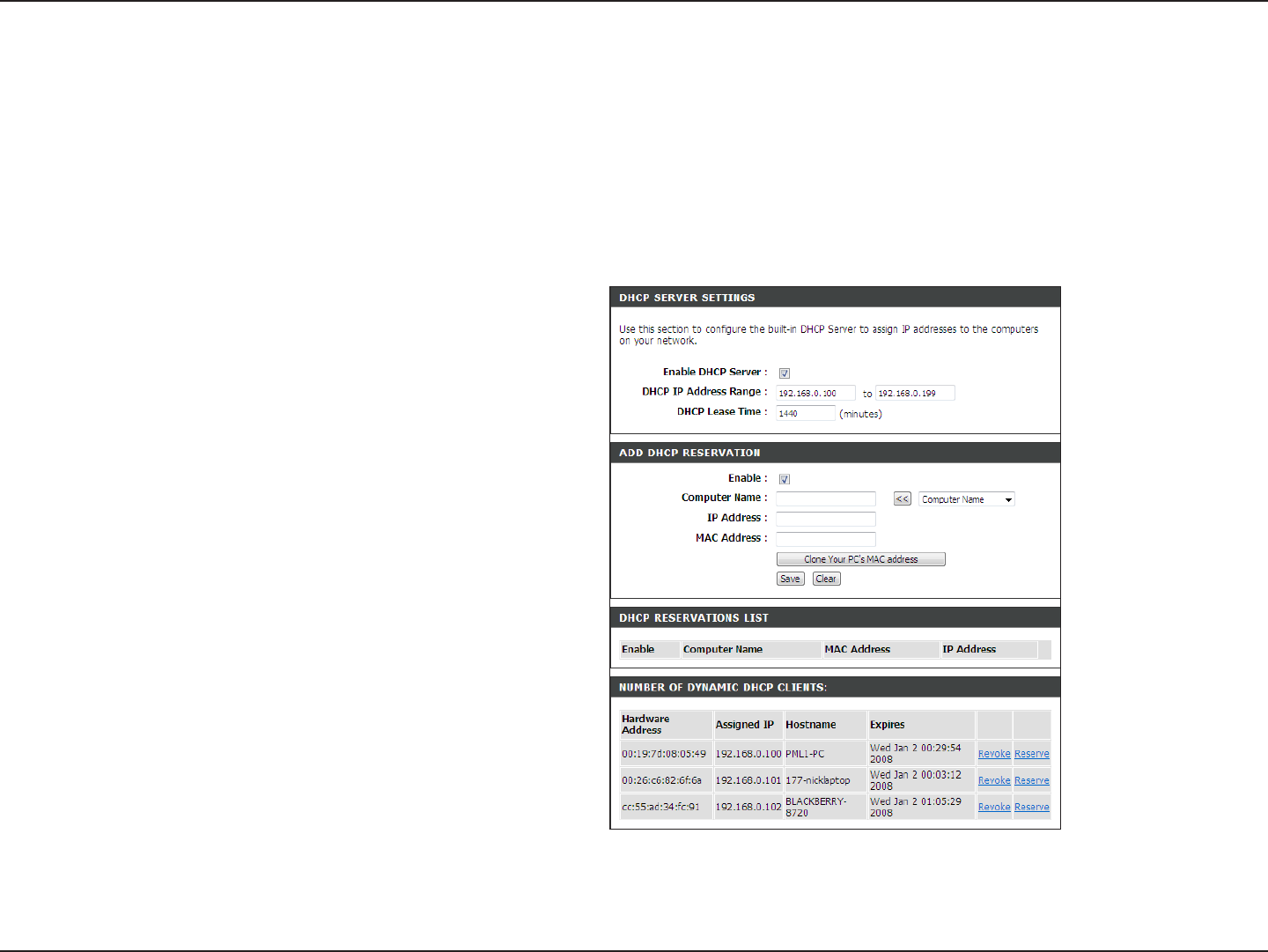
79D-Link DAP-1350 User Manual
Section 3 - Conguration
Check this box to enable the DHCP server on your
router. Uncheck to disable this function.
Enter the starting and ending IP addresses for the
DHCP server’s IP assignment.
Note: If you statically (manually) assign IP
addresses to your computers or devices, make sure
the IP addresses are outside of this range or you
may have an IP conict.
The length of time for the IP address lease. Enter
the Lease time in minutes.
Refer to the next page for the DHCP Reservation
function.
Enable DHCP
Server:
DHCP IP Address
Range:
DHCP Lease Time:
Add DHCP
Reservation:
DHCP Server Settings
DHCP stands for Dynamic Host Control Protocol. The DAP-1350 has a built-in DHCP server. The DHCP Server will automatically
assign an IP address to the computers on the LAN/private network. Be sure to set your computers to be DHCP clients by setting
their TCP/IP settings to “Obtain an IP Address Automatically.” When you turn your computers on, they will automatically load
the proper TCP/IP settings provided by the DAP-1350. The DHCP Server will automatically allocate an unused IP address from
the IP address pool to the requesting computer. You must specify the starting and ending address of the IP address pool.
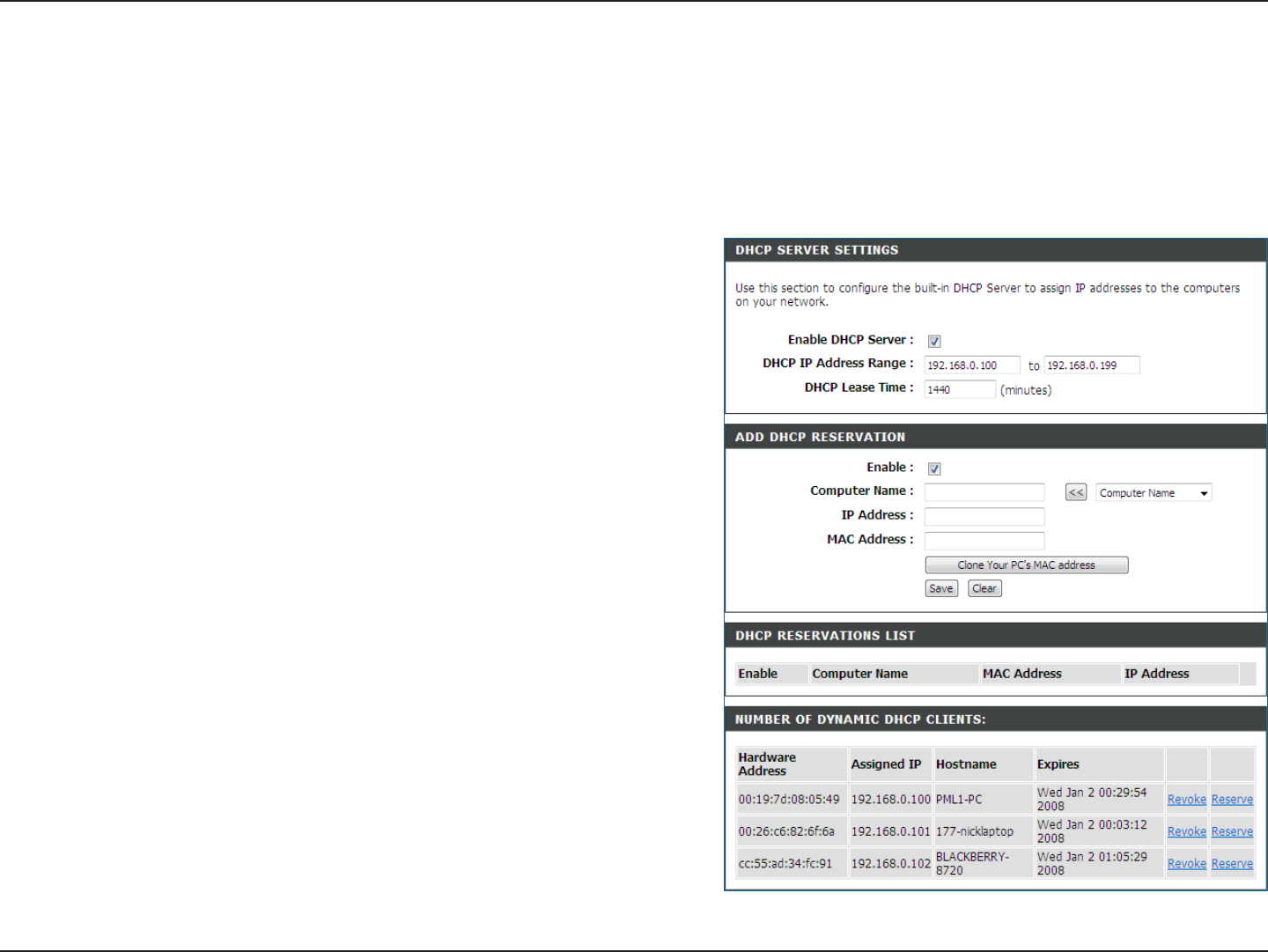
80D-Link DAP-1350 User Manual
Section 3 - Conguration
DHCP Reservation
If you want a computer or device to always have the same IP address assigned, you can create a DHCP reservation. The router
will assign the IP address only to that computer or device.
Note: This IP address must be within the DHCP IP Address Range.
Check this box to enable the reservation.
Enter the computer name or select from the drop-down menu
and click <<.
Enter the IP address you want to assign to the computer or device.
This IP Address must be within the DHCP IP Address Range.
Enter the MAC address of the computer or device.
If you want to assign an IP address to the computer you are
currently on, click this button to populate the elds.
Click Save to save your entry. You must click Save Settings at
the top to activate your reservations.
In this section you can see what LAN devices are currently leasing
IP addresses.
Enable:
Computer Name:
IP Address:
MAC Address:
Copy Your PC’s
MAC Address:
Save:
Number of
Dynamic DHCP
Clients:
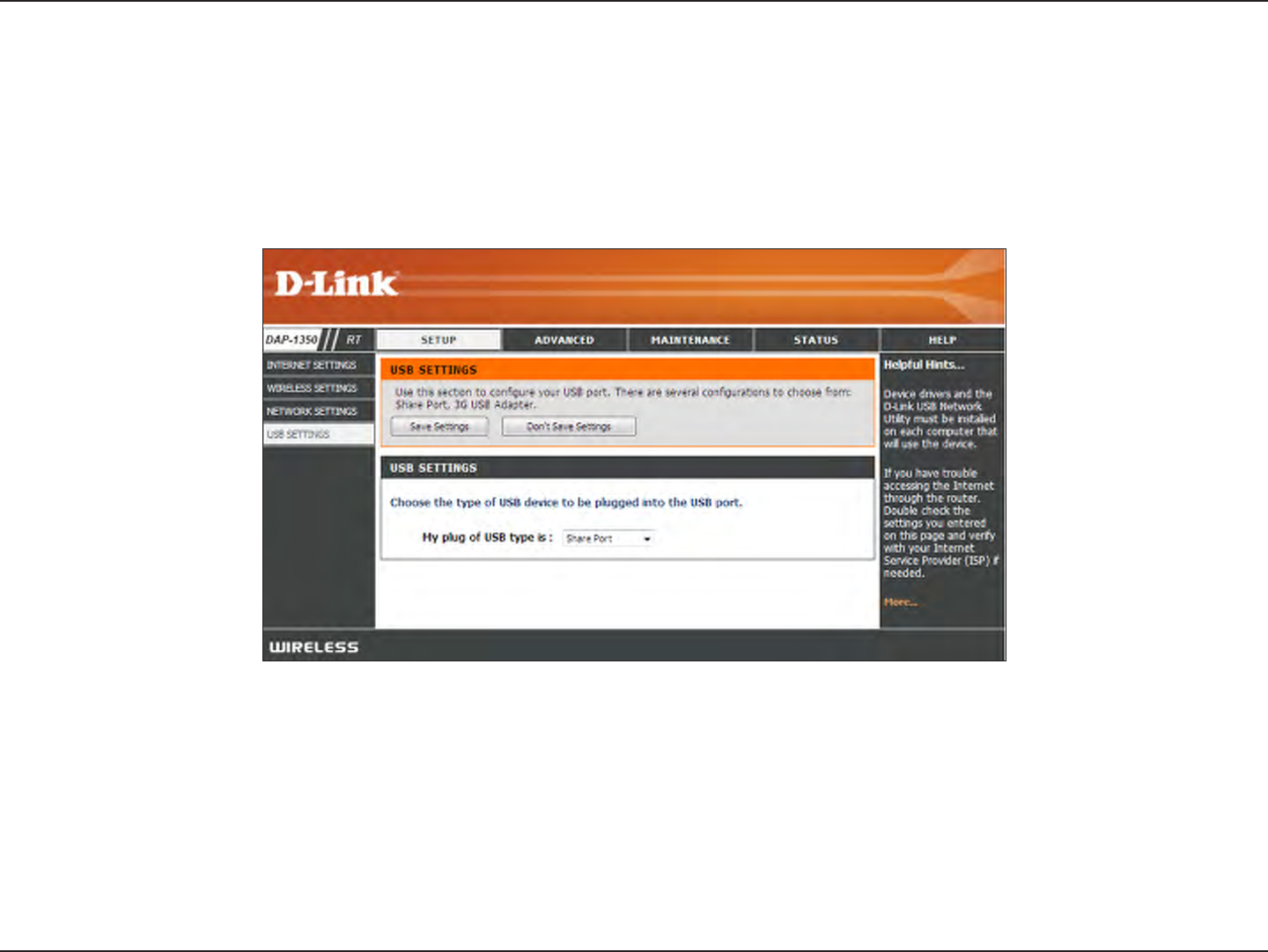
81D-Link DAP-1350 User Manual
Section 3 - Conguration
USB Settings
Use this section to congure your USB port. Share Port will be selected.
Note: If using the SharePort option, users will need to install the SharePort Utility into the computers to share the USB device through
the router. Please see the SharePort Manual on the CD for more information.
Note: The USB port may be used for 3G adapters. Currently only D-Link’s 3G cards will be supported.

82D-Link DAP-1350 User Manual
Section 3 - Conguration
The DAP-1350 can be congured as a virtual server so that remote users accessing Web or FTP services via the public IP address
can be automatically redirected to local servers in the LAN (Local Area Network).
The DAP-1350 rewall feature lters out unrecognized packets to protect your LAN network so all computers networked with
the DAP-1350 are invisible to the outside world. If you wish, you can make some of the LAN computers accessible from the
Internet by enabling Virtual Server. Depending on the requested service, the DAP-1350 redirects the external service request
to the appropriate server within the LAN network.
The DAP-1350 is also capable of port-redirection meaning incoming trac to a particular port may be redirected to a dierent
port on the server computer.
Each virtual service that is created will be listed at the bottom of the screen in the Virtual Servers List. There are
pre-dened virtual services already in the table. You may use them by enabling them and assigning the server IP to use that
particular virtual service.
For a list of ports for common applications, please visit http://www.dlink.com/support/faq/?prod_id=1191.
Virtual Server
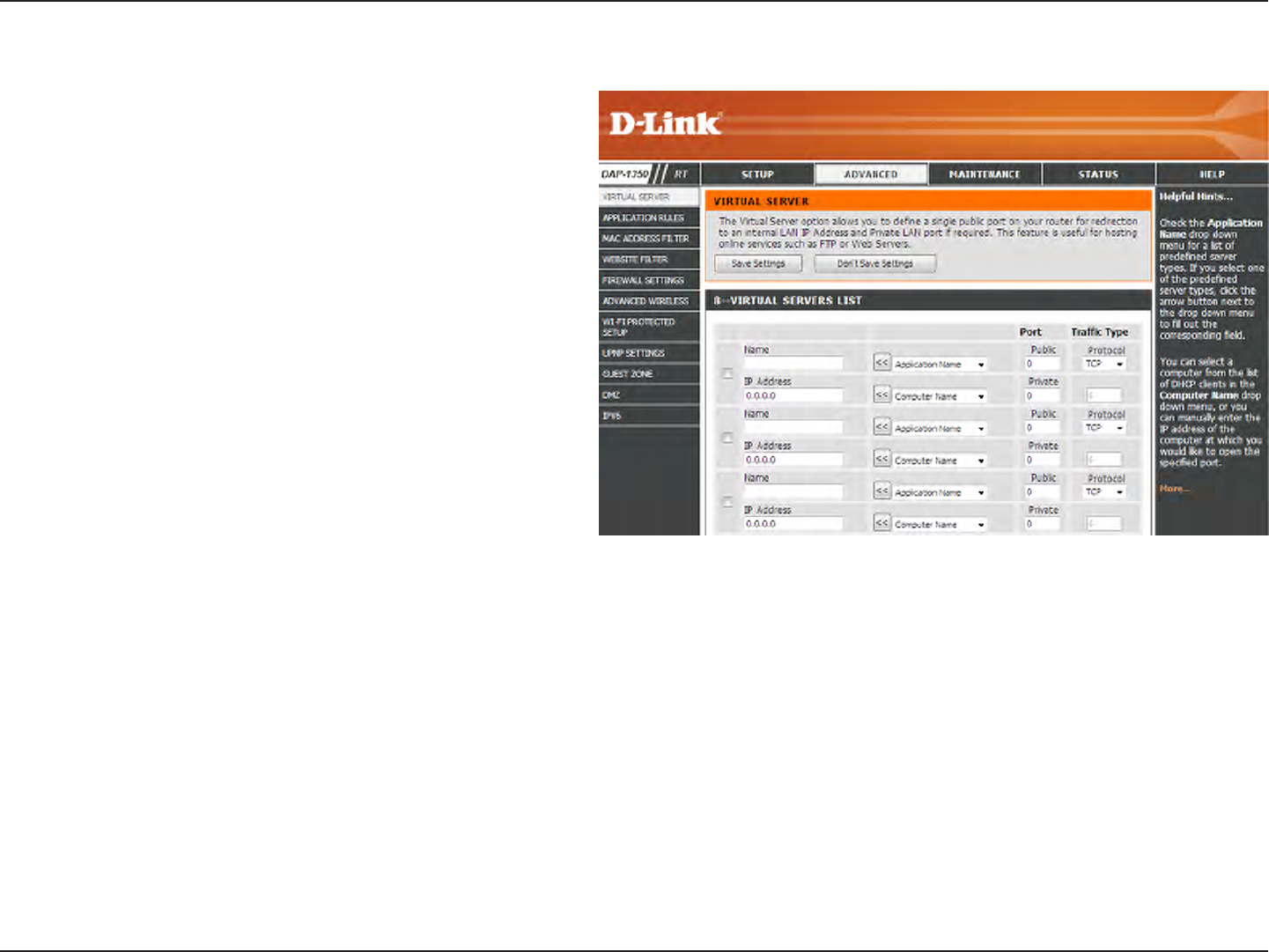
83D-Link DAP-1350 User Manual
Section 3 - Conguration
This will allow you to open ports (port forwarding).
Enter a name for the rule or select an application from
the drop-down menu. Select an application and click
<< to populate the elds.
Enter the IP address of the computer on your local
network that you want to allow the incoming service
to. If your computer is receiving an IP address
automatically from the router (DHCP), you computer
will be listed in the “Computer Name” drop-down
menu. Select your computer and click <<.
Enter the port that you want to open next to Private
Port and Public Port. The private and public ports
are usually the same. The public port is the port seen
from the Internet side, and the private port is the
port being used by the application on the computer
within your local network.
Select TCP, UDP, Both, or Other from the drop-down
menu.
Name:
IP Address:
Private Port/
Public Port:
Protocol Type:
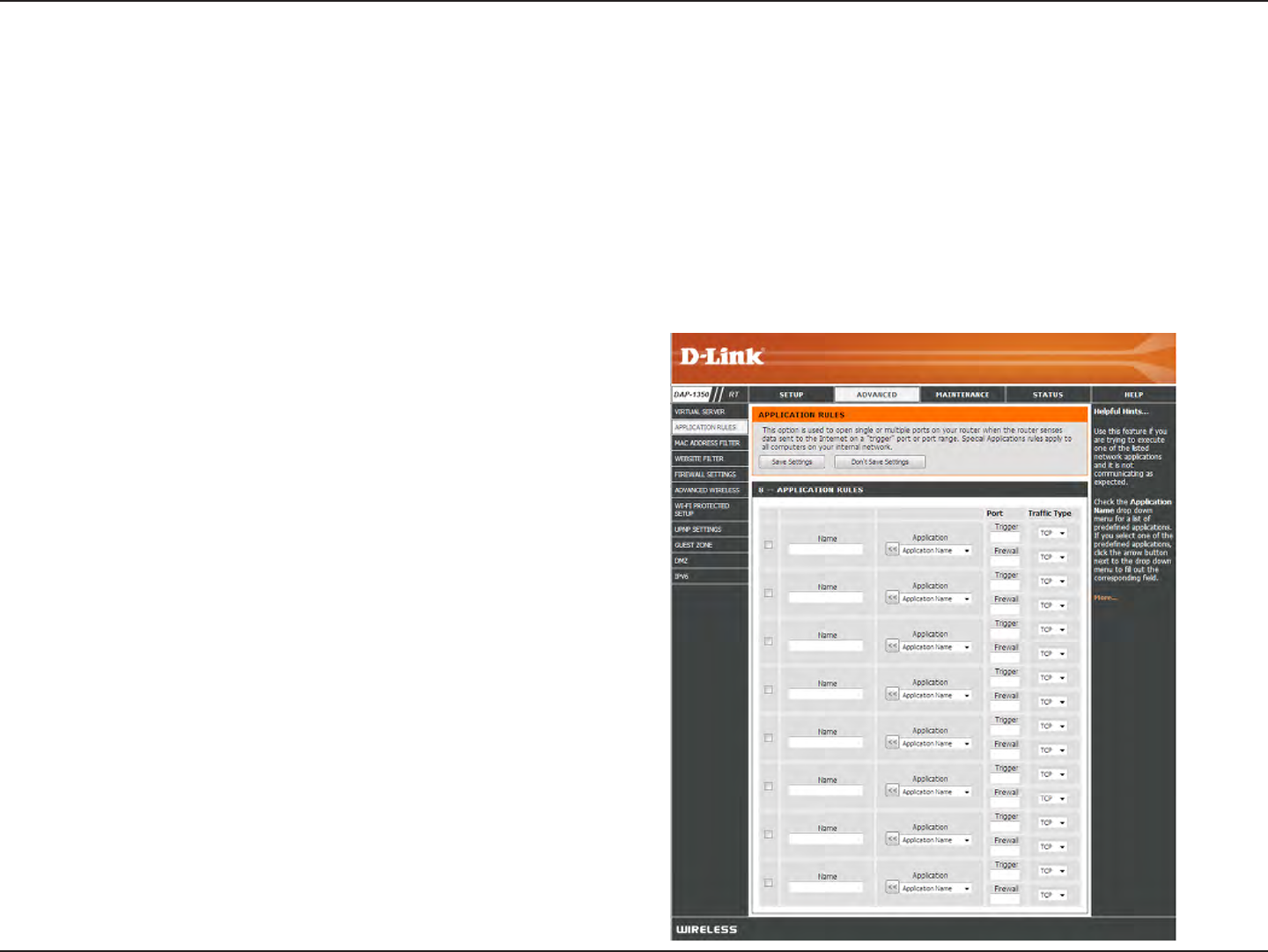
84D-Link DAP-1350 User Manual
Section 3 - Conguration
Application Rules
Enter a name for the rule. You may select a
pre-dened application from the drop-down menu and
click <<.
This is the port used to trigger the application. It can be
either a single port or a range of ports.
Select the protocol of the trigger port (TCP, UDP, or Both).
This is the port number on the Internet side that will be
used to access the application. You may dene a single port
or a range of ports. You can use a comma to add multiple
ports or port ranges.
Select the protocol of the rewall port (TCP, UDP, or Both).
Name:
Trigger:
Trac Type:
Firewall:
Trac Type:
Some applications require multiple connections, such as Internet gaming, video conferencing, Internet telephony and others.
These applications have diculties working through NAT (Network Address Translation). Special Applications makes some
of these applications work with the DAP-1350. If you need to run applications that require multiple connections, specify the
port normally associated with an application in the “Trigger Port” eld, select the protocol type as TCP or UDP, then enter the
rewall (public) ports associated with the trigger port to open them for inbound trac.
The DAP-1350 provides some predened applications in the table on the bottom of the web page. Select the application you
want to use and enable it.
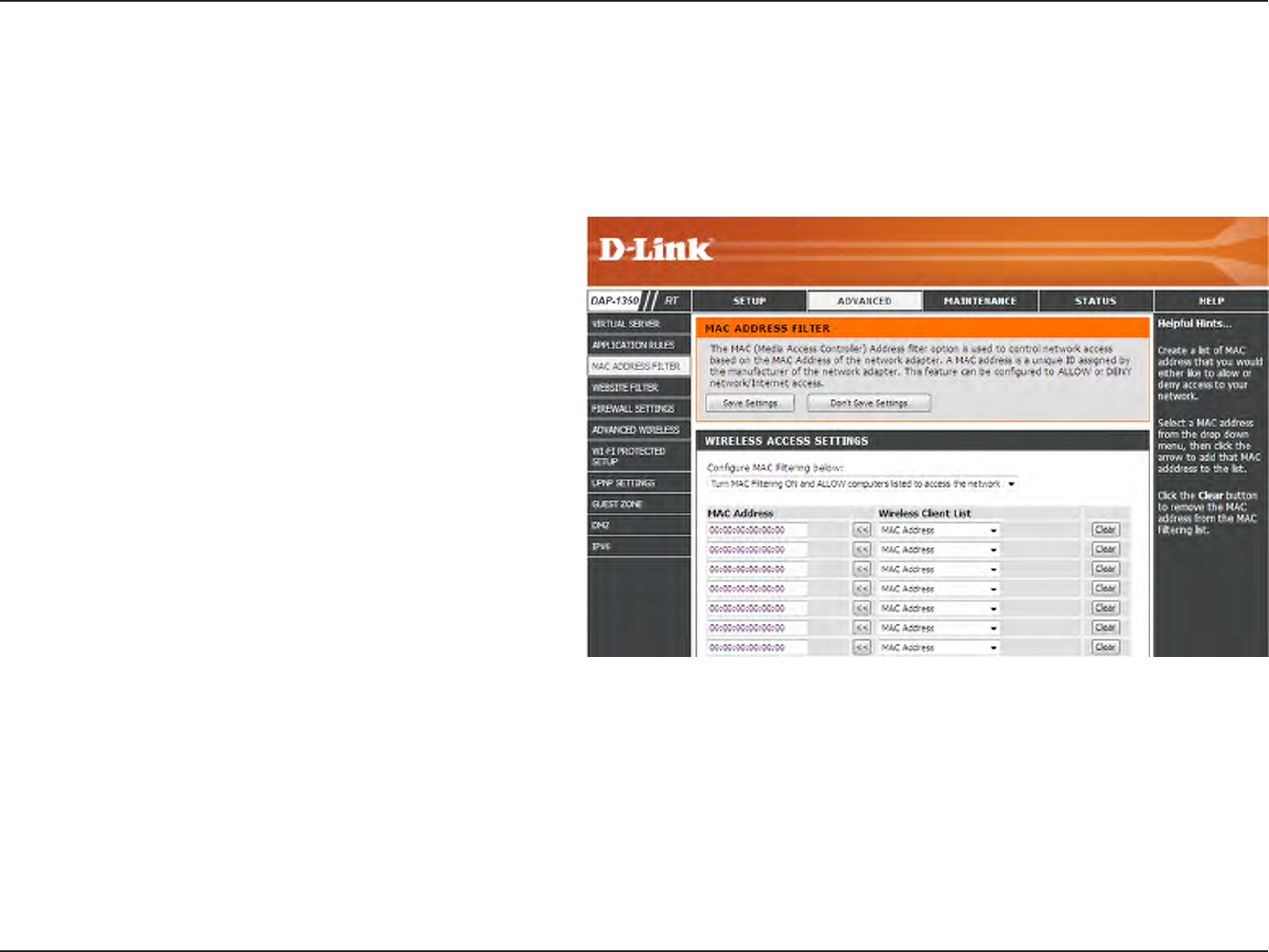
85D-Link DAP-1350 User Manual
Section 3 - Conguration
MAC Address Filter
Use MAC (Media Access Control) Filters to allow or deny LAN (Local Area Network) computers by their MAC addresses from
accessing the Network. You can either manually add a MAC address or select the MAC address from the list of clients that are
currently connected to the Broadband Router.
When Disable is selected, MAC addresses are not
used to control network access.
When Turn MAC Filtering ON and ALLOW
computers listed... is selected, only computers
with MAC addresses listed in the MAC Address List
are granted network access.
When Turn MAC Filtering ON and DISALLOW
computers listed... is selected, any computer
with a MAC address listed in the MAC Address List
is refused access to the network.
Enter the MAC address you would like to lter.
You can select a client currently connected to
your access point from the Wireless Client List
drop-down menu and then click << to populate
the MAC Address eld.
Click Save Settings to activate and save.
Click to remove the client from the MAC address
lter rule.
MAC Address
Filter:
MAC Address:
Clear:
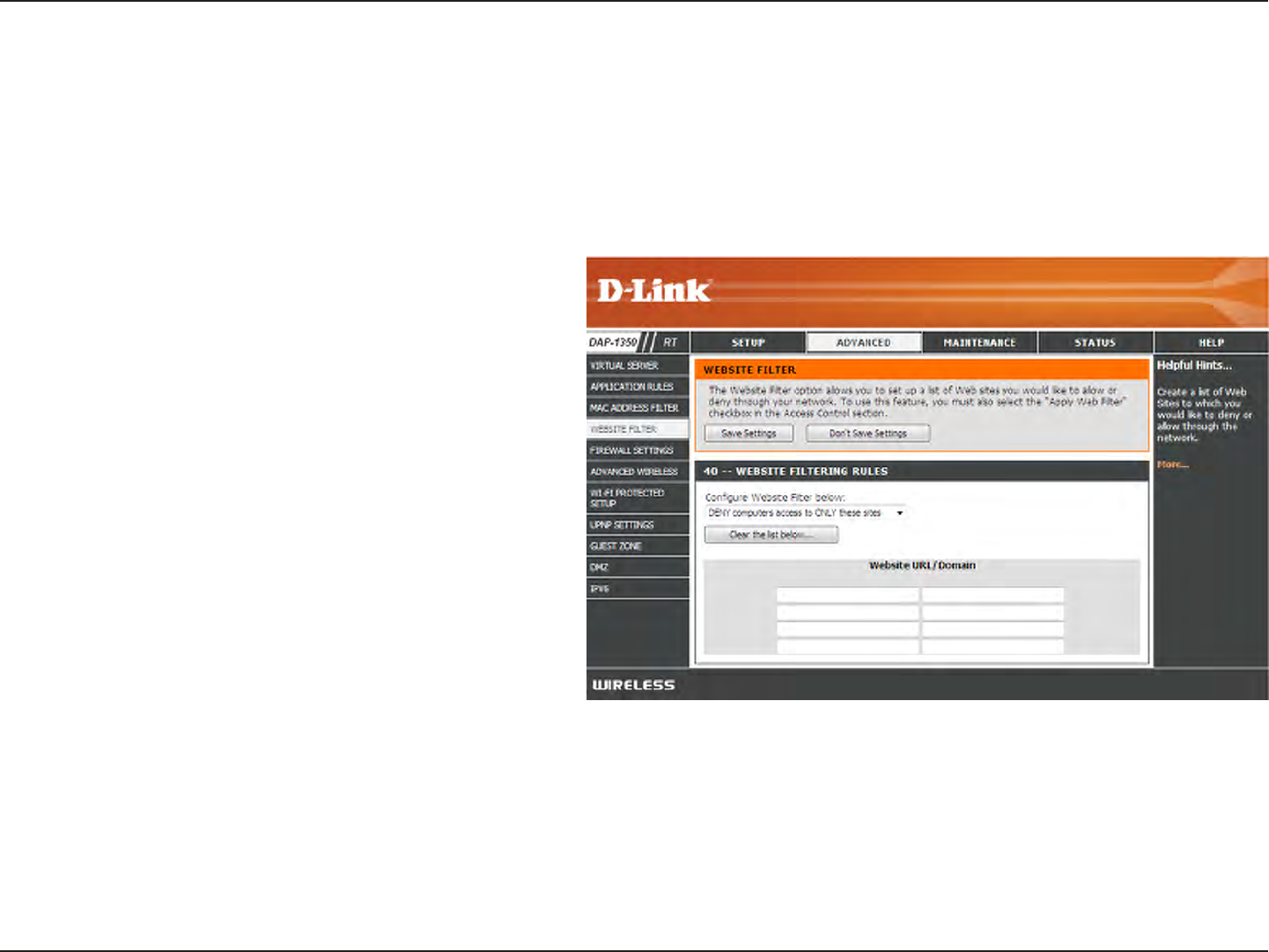
86D-Link DAP-1350 User Manual
Section 3 - Conguration
Enter the keywords or URLs that you want to block
(or allow). Any URL with the keyword in it will be
blocked.
Website URL/
Domain:
Website Filters are used to deny LAN computers from accessing specic web sites by the URL or domain. A URL is a specially
formatted text string that denes a location on the Internet. If any part of the URL contains the blocked word, the site will not
be accessible and the web page will not display. To use this feature, enter the text string to be blocked and click Save Settings.
The text to be blocked will appear in the list. To delete the text, click Clear the List Below.
Website Filters
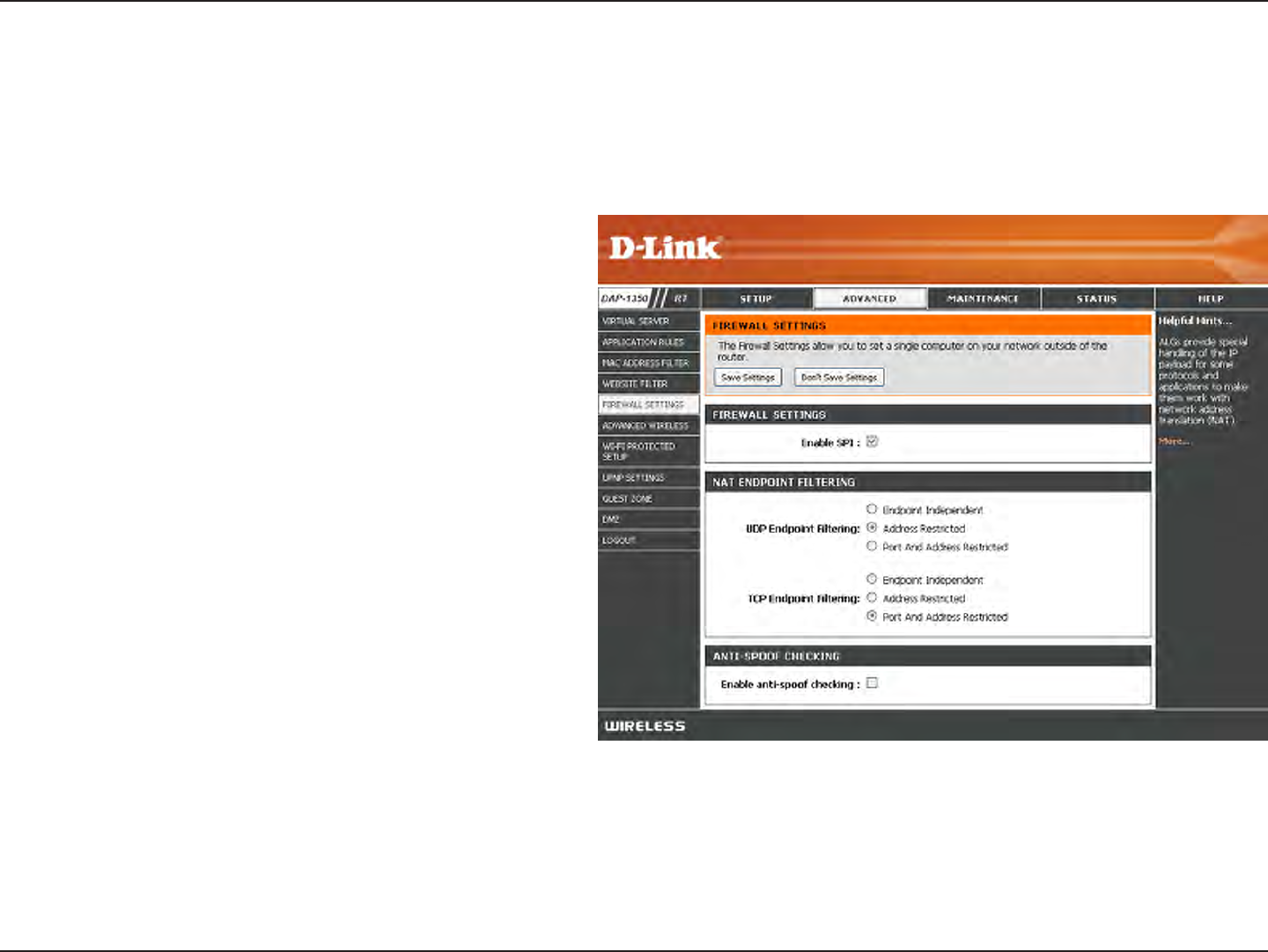
87D-Link DAP-1350 User Manual
Section 3 - Conguration
SPI (Stateful Packet Inspection, also known as
dynamic packet ltering) helps to prevent cyber
attacks by tracking more state per session. It
validates that the traffic passing through the
session conforms to the protocol.
Select one of the following for TCP and UDP
ports:
Endpoint Independent - Any incoming trac sent
to an open port will be forwarded to the application
that opened the port. The port will close if idle for
5 minutes.
Address Restricted - Incoming trac must match
the IP address of the outgoing connection.
Address + Port Restriction - Incoming trac must
match the IP address and port of the outgoing
connection.
Enable SPI:
NAT Endpoint
Filtering:
Firewall Settings
A rewall protects your network from the outside world. The D-Link DAP-1350 oers a rewall type functionality. The SPI
feature helps prevent cyber attacks. Sometimes you may want a computer exposed to the outside world for certain types of
applications. If you choose to expose a computer, you can enable DMZ. DMZ is short for Demilitarized Zone. This option will
expose the chosen computer completely to the outside world.
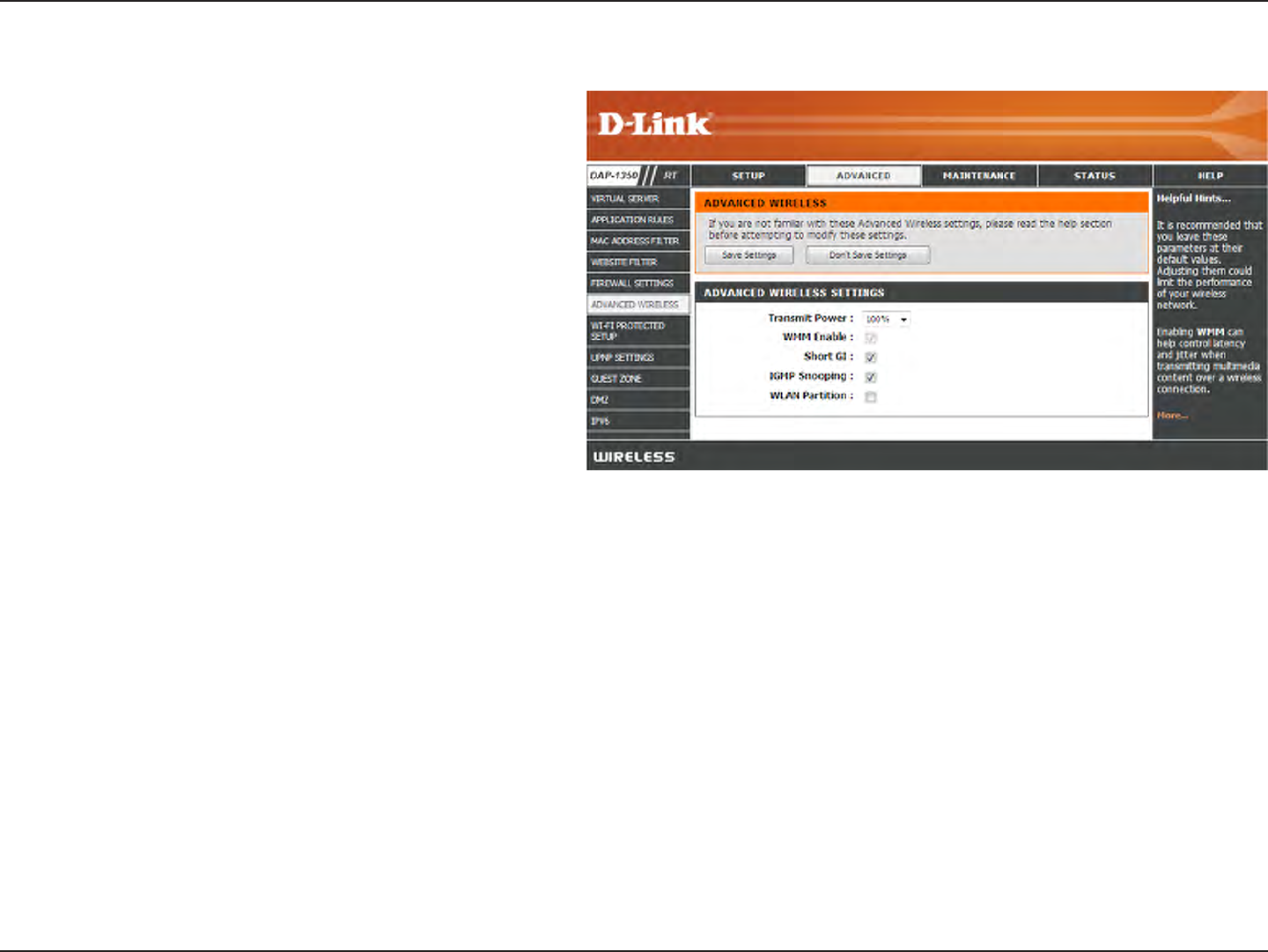
88D-Link DAP-1350 User Manual
Section 3 - Conguration
Advanced Wireless Settings
Transmit Power:
WMM Enable:
Short GI:
IGMP Snooping:
WLAN Partition:
Sets the transmit power of the antennas.
Note: Transmit power is regulated by international
standard. Users are forbidden to change its
maximum limit.
WMM is QoS for your wireless network. This will
improve the quality of video and voice applications
for your wireless clients.
Check this box to reduce the guard interval time
therefore increasing the data capacity. However, it’s
less reliable and may create higher data loss.
This enables IGMP snooping for the wireless
connection. We recommend enabling this if
you often use multicast services such as video
conferencing and streaming audio/video.
Check to enable WLAN Partition.
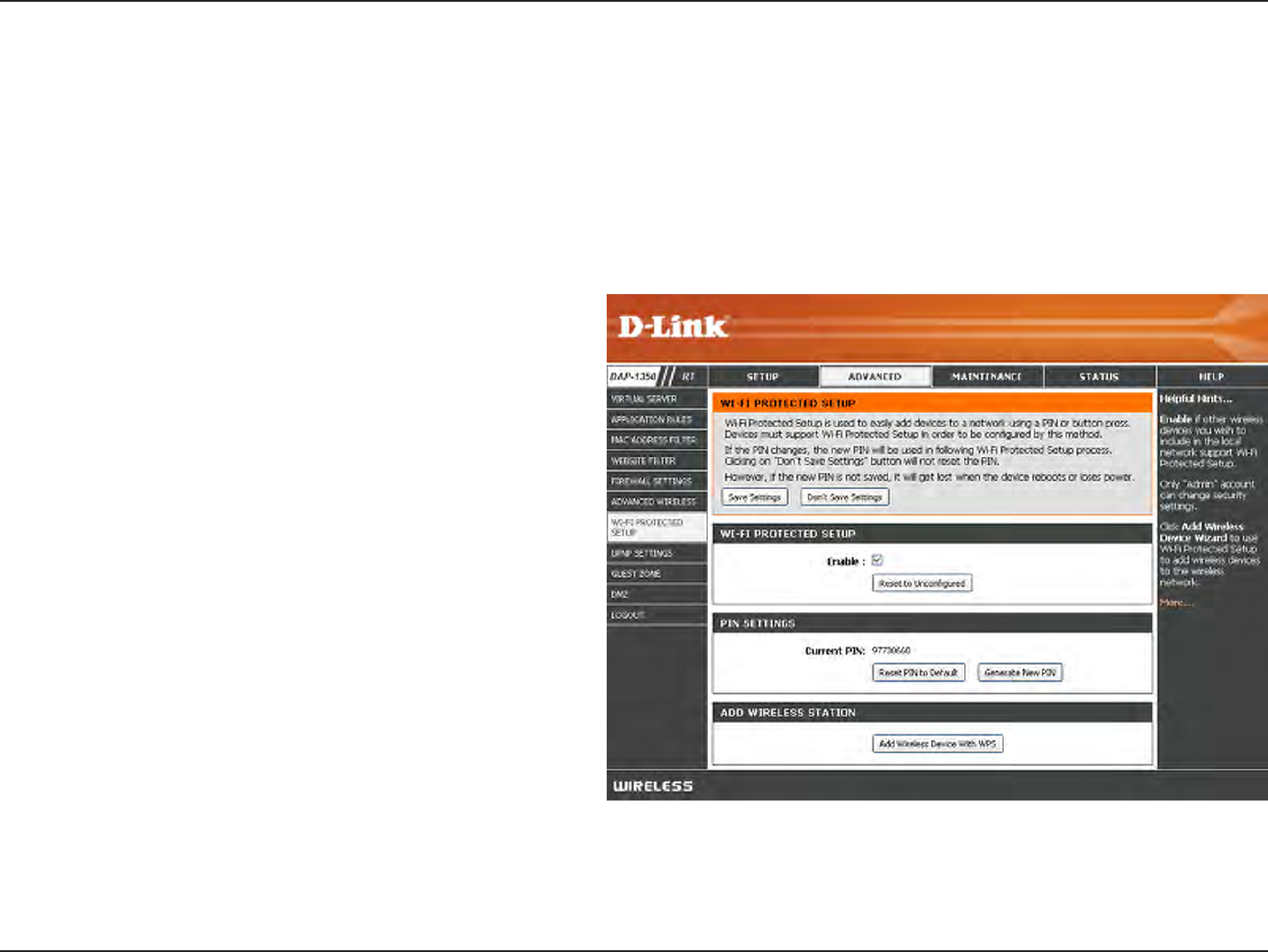
89D-Link DAP-1350 User Manual
Section 3 - Conguration
Enable the Wi-Fi Protected Setup feature.
Locking the wireless security settings prevents the
settings from being changed by the Wi-Fi Protected
Setup feature of the router. Devices can still be added
to the network using Wi-Fi Protected Setup. However,
the settings of the network will not change once this
option is checked.
A PIN is a unique number that can be used to add
the router to an existing network or to create a new
network. The default PIN may be printed on the
bottom of the router. For extra security, a new PIN can
be generated. You can restore the default PIN at any
time. Only the Administrator (“admin” account) can
change or reset the PIN.
Shows the current value of the router’s PIN.
Restore the default PIN of the router.
Create a random number that is a valid PIN. This becomes the router’s PIN. You can then copy this PIN to the user interface of the
registrar.
Enable:
Lock Wireless
Security Settings:
PIN Settings:
Current PIN:
Reset PIN to
Default:
Generate New
PIN:
Wi-Fi Protected Setup
Wi-Fi Protected Setup (WPS) System is a simplied method for securing your wireless network during the “Initial setup” as well
as the “Add New Device” processes. The Wi-Fi Alliance (WFA) has certied it across dierent products as well as manufactures.
The process is just as easy, as depressing a button for the Push-Button Method or correctly entering the 8-digit code for the
Pin-Code Method. The time reduction in setup and ease of use are quite benecial, while the highest wireless Security setting
of WPA2 is automatically used.
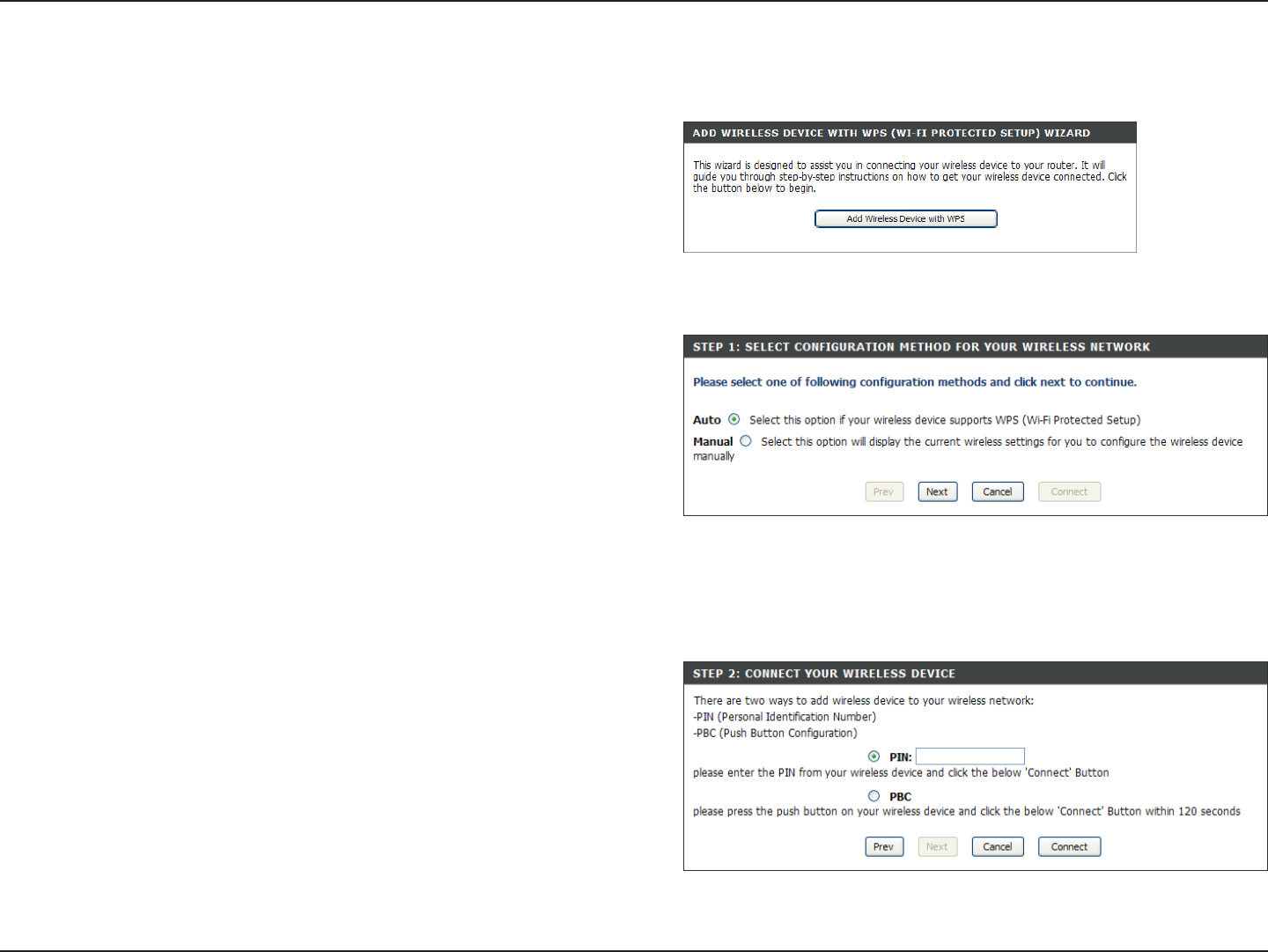
90D-Link DAP-1350 User Manual
Section 3 - Conguration
From the Setup > Wireless Settings screen, click Add Wireless
Device with WPS.
Add Wireless Device with WPS Wizard
PIN: Select this option to use PIN method. In order to use this
method you must know the wireless client’s 8 digit PIN and click
Connect.
PBC: Select this option to use PBC (Push Button) method to add a
wireless client. Click Connect.
Select Auto to add a wireless client using WPS (Wi-Fi Protected
Setup). Once you select Auto and click Connect, you will have a
120 second time limit to apply the settings to your wireless client(s)
and successfully establish a connection.
If you select Manual, a settings summary screen will appear. Write
down the security key and enter this on your wireless clients.
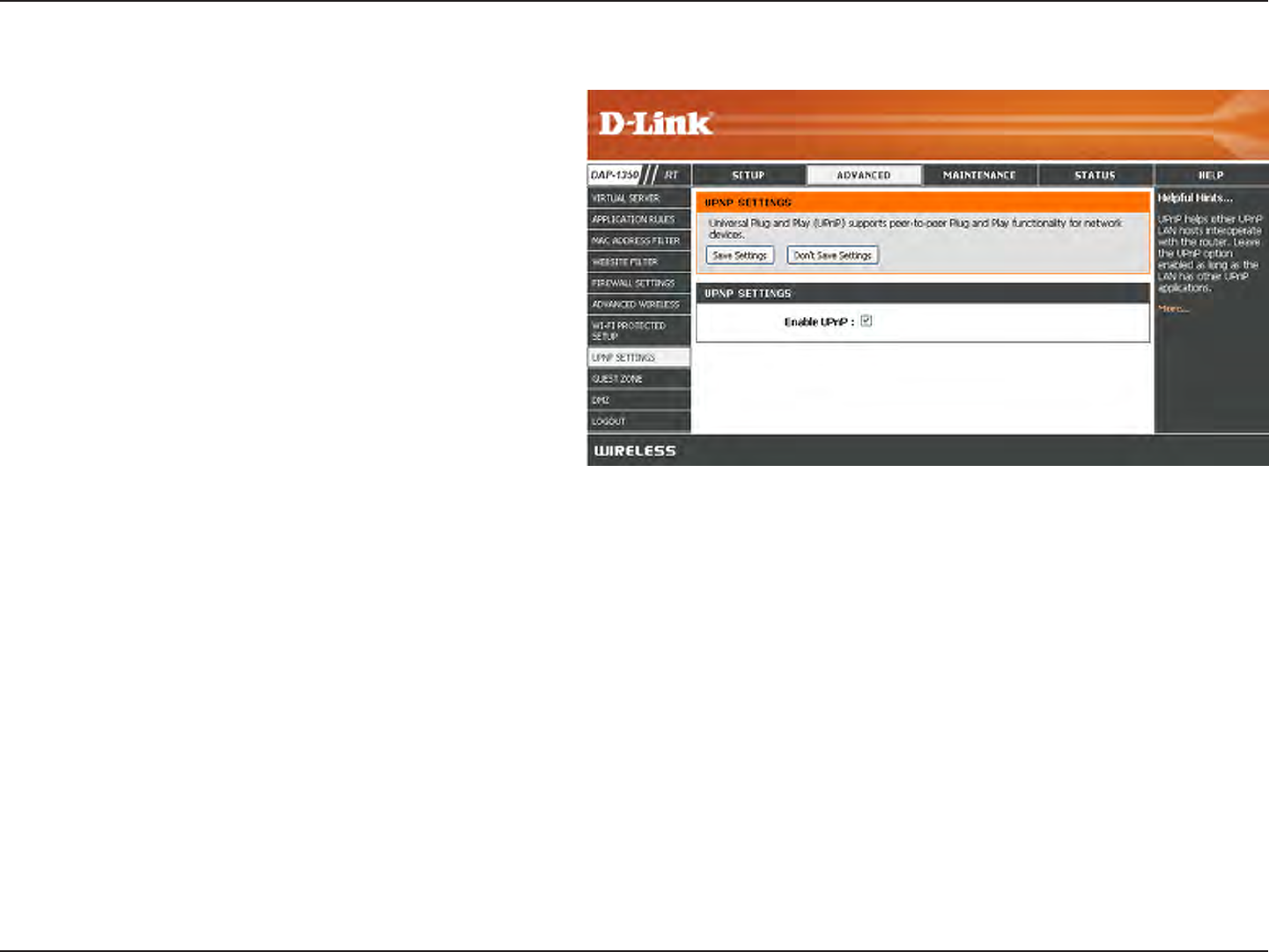
91D-Link DAP-1350 User Manual
Section 3 - Conguration
To use the Universal Plug and Play (UPnP™) feature
click on Enabled. UPnP provides compatibility
with networking equipment, software and
peripherals.
UPnP Settings:
UPnP Settings
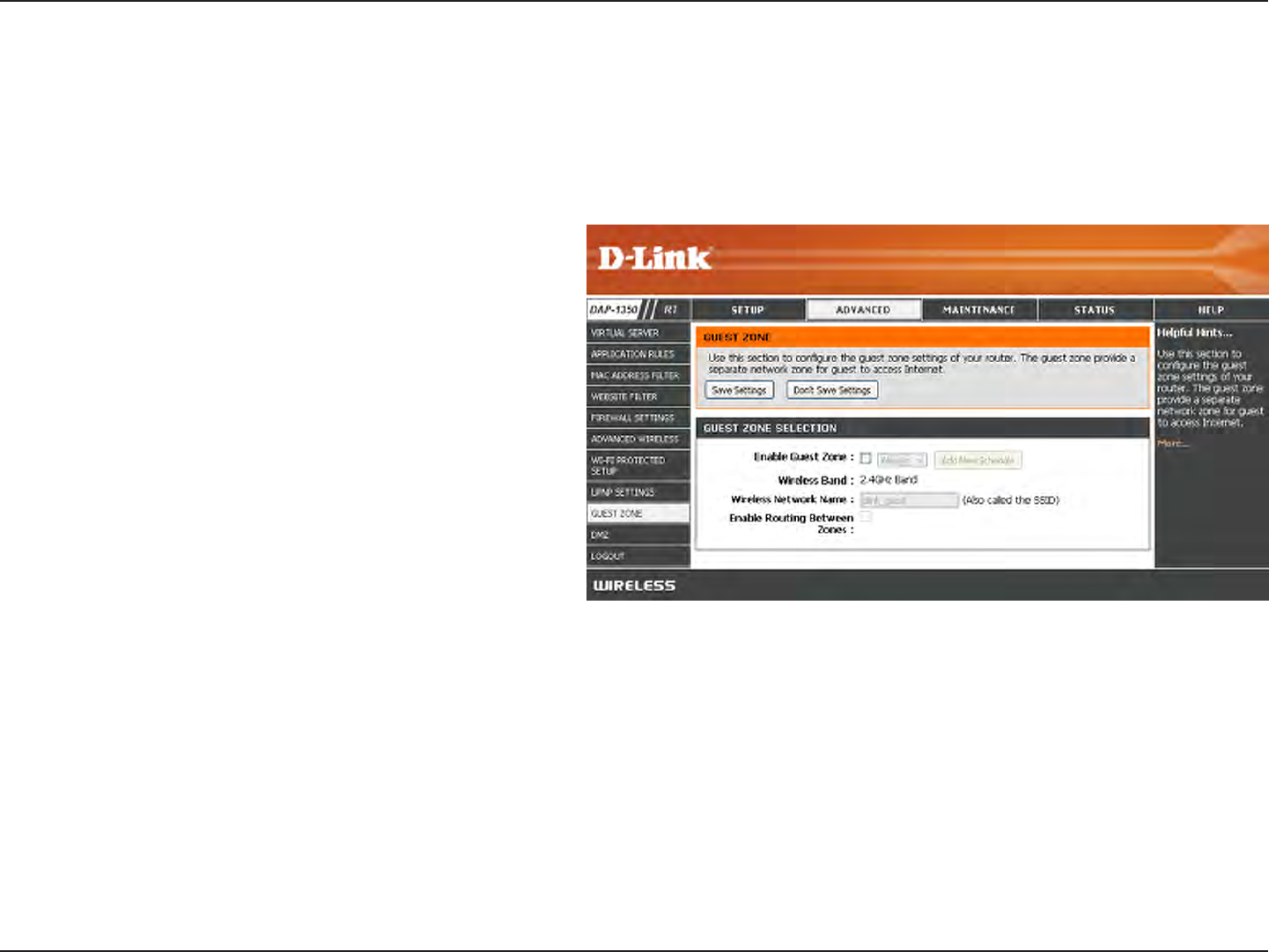
92D-Link DAP-1350 User Manual
Section 3 - Conguration
Guest Zone
Check to enable the Guest Zone feature.
The schedule of time when the Guest Zone will
be active. The schedule may be set to Always,
which will allow the particular service to always
be enabled. You can create your own times in the
Tools > Schedules section.
Enter a wireless network name (SSID) that is
dierent from your main wireless network.
Check to allow network connectivity between
the dierent zones created.
Select the type of security or encryption you
would like to enable for the guest zone.
Enable Guest Zone:
Schedule:
Wireless Network
Name:
Enable Routing
Between Zones:
Security Mode:
The Guest Zone feature will allow you to create temporary zones that can be used by guests to access the Internet. These zones
will be separate from your main wireless network.
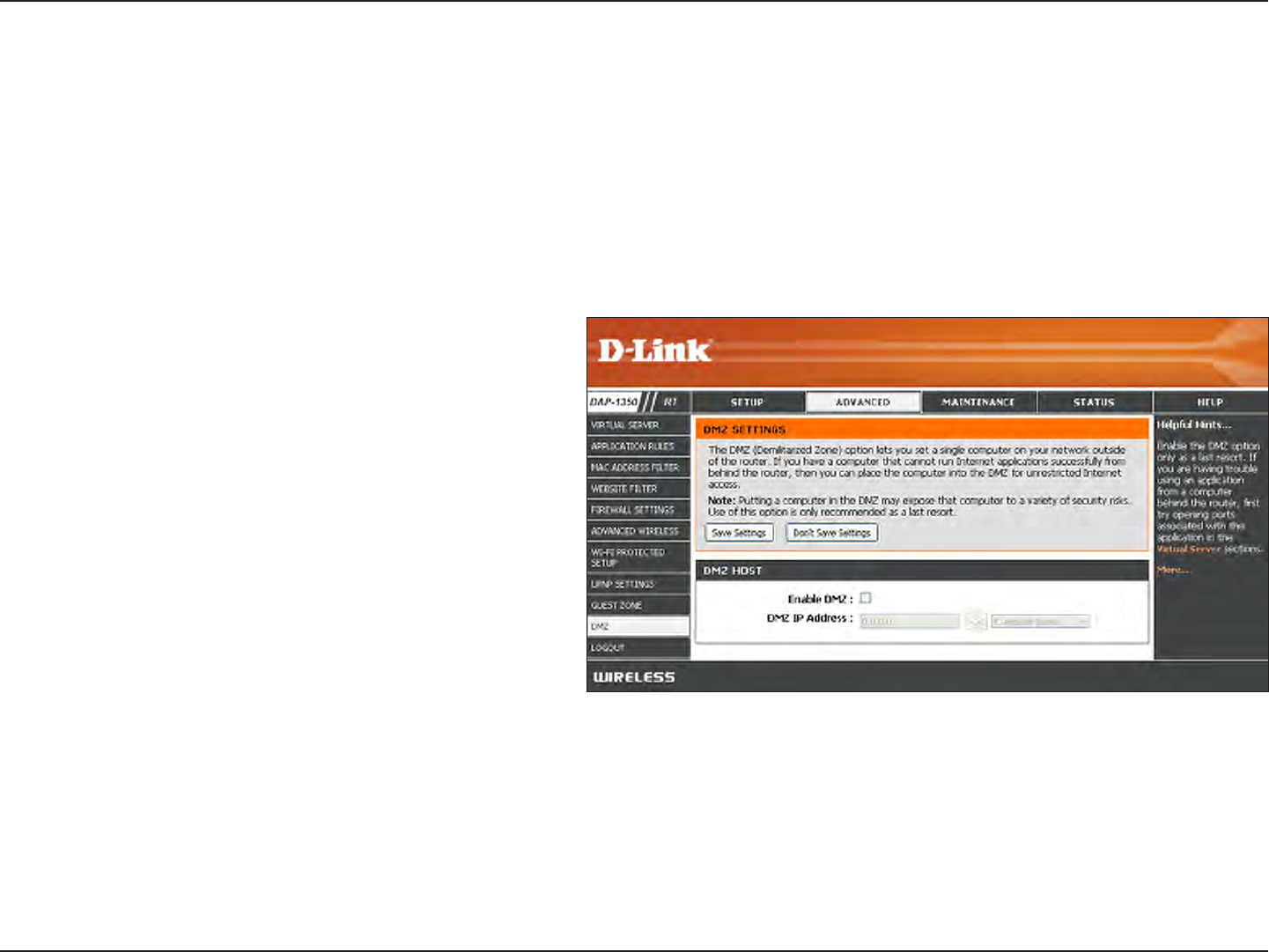
93D-Link DAP-1350 User Manual
Section 3 - Conguration
DMZ
Check this box to enable DMZ.
Enter the IP address of the computer you would
like to open all ports to. You can select a computer
from the Computer Name drop-down menu and
click << to enter the computer name into the DMZ
Host IP Address eld.
Enable DMZ:
DMZ Host IP
Address:
This feature allows you to set up a DMZ (Demilitarized Zone) host. If you have a client PC that cannot run Internet applications
properly from behind the DAP-1350, then you can set the client up for unrestricted Internet access. The DMZ allows a computer
to be exposed to the Internet. This feature is useful for gaming purposes. Enter the IP address of the computer that will be the
DMZ host. Adding a client to the DMZ may expose your local network to a variety of security risks, so only use this option as
a last resort.
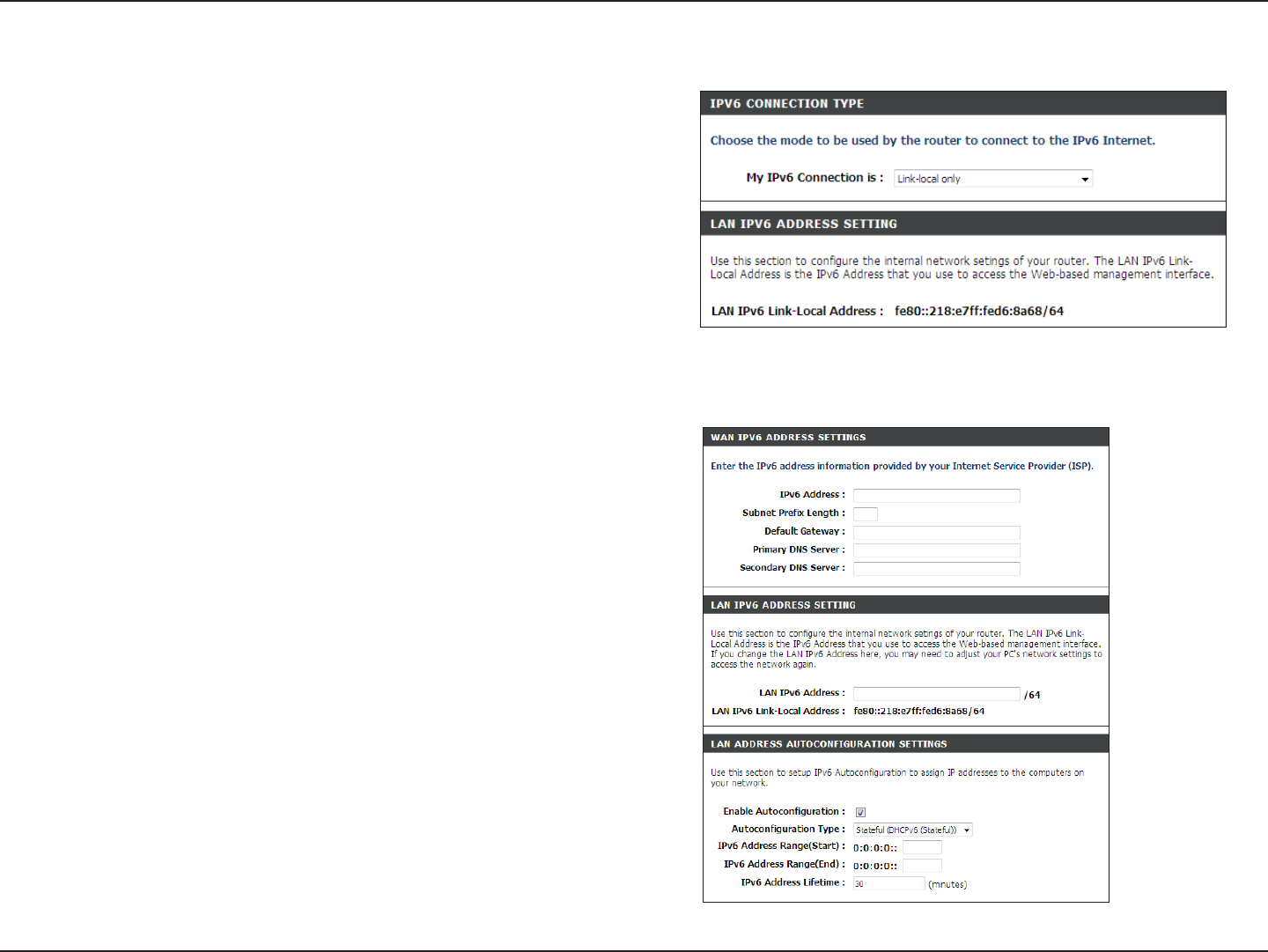
94D-Link DAP-1350 User Manual
Section 3 - Conguration
IPV6 Settings
My LAN
Connection Is:
LAN IPV6 Settings:
Select Link-Local Only from the drop-down menu.
Displays the IPv6 address of the router.
Static IPv6 (Stateful)
Select Static IPv6 from the drop-down menu.
Enter the address settings supplied by your Internet
provider (ISP).
Enter the LAN (local) IPv6 address for the router.
Displays the Router’s LAN Link-Local Address.
Check to enable the Autoconguration feature.
Select Stateful (DHCPv6 (Stateful)).
Enter the start IPv6 Address for the DHCPv6 range for
your local computers.
Enter the end IPv6 Address for the DHCPv6 range for
your local computers.
My IPv6 Connection:
WAN IPv6 Address
Settings:
LAN IPv6 Address:
LAN Link-Local Address:
Enable
Autoconguration:
Autoconguration Type:
IPv6 Address Range
Start:
IPv6 Address Range End:
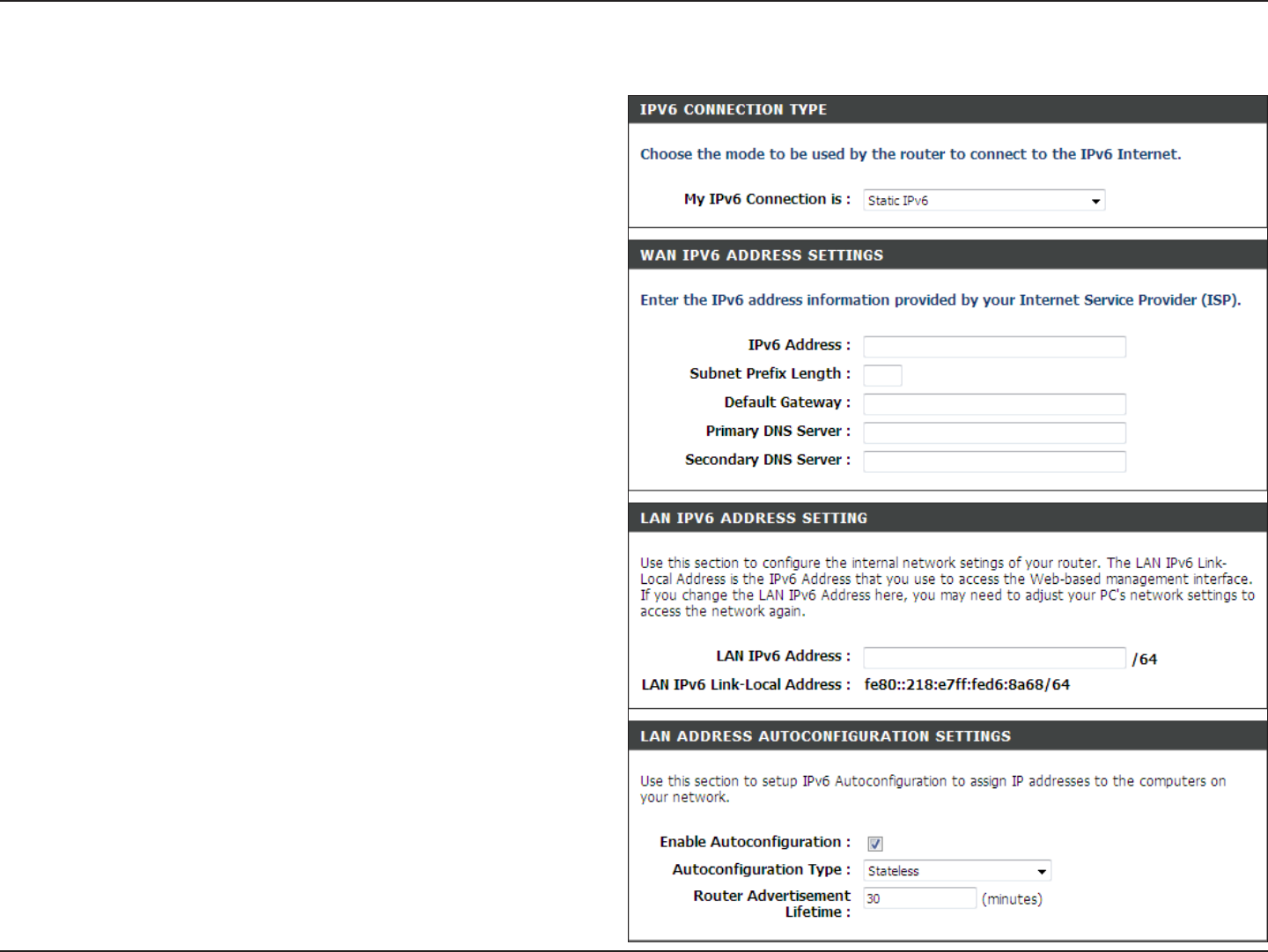
95D-Link DAP-1350 User Manual
Section 3 - Conguration
My IPv6 Connection:
WAN IPv6 Address
Settings:
LAN IPv6 Address:
LAN Link-Local Address:
Enable
Autoconguration:
Autoconguration Type:
Router Advertisement
Lifetime:
Select Static IPv6 from the drop-down menu.
Enter the address settings supplied by your
Internet provider (ISP).
Enter the LAN (local) IPv6 address for the router.
Displays the Router’s LAN Link-Local Address.
Check to enable the Autoconguration feature.
Select Stateless.
Enter the Router Advertisement Lifetime (in
minutes).
Static IPv6 (Stateless)
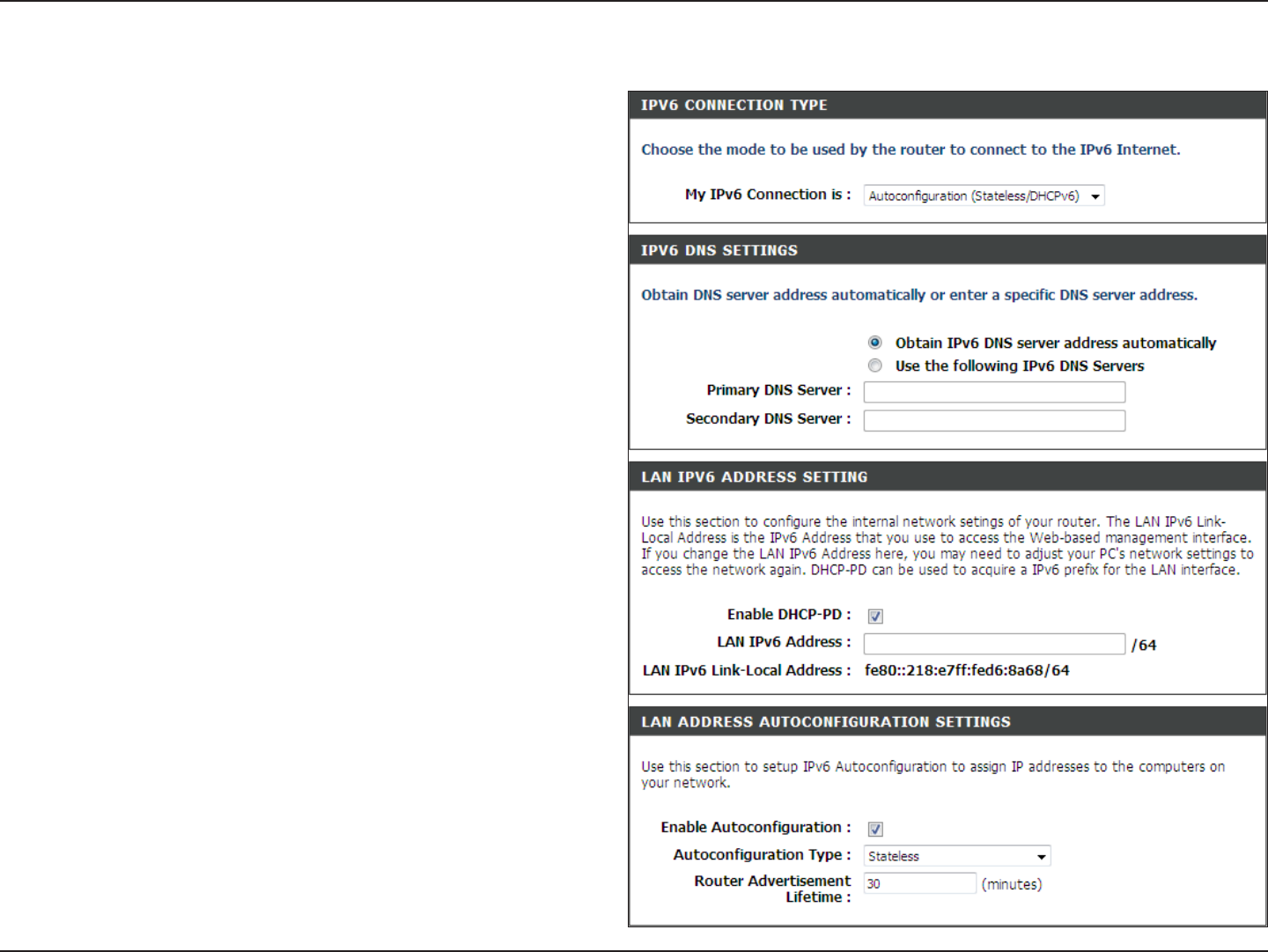
96D-Link DAP-1350 User Manual
Section 3 - Conguration
Select Autoconguration (Stateless/DHCPV6
from the drop-down menu.
Select Obtain IPv6 DNS server address
automatically.
Check the Enable DHCP-PD box to automatically
acquire an IPv6 prex for the LAN interface. Enter
the LAN (local) IPv6 address for the router.
Displays the Router’s LAN Link-Local Address.
Check to enable the Autoconguration feature.
Select Stateless.
Enter the Router Advertisement Lifetime (in
minutes).
Autoconguration IPv6 (Stateless)
My IPv6 Connection:
IPv6 DNS
Settings:
LAN IPv6 Address:
LAN Link-Local Address:
Enable
Autoconguration:
Autoconguration Type:
Router Advertisement
Lifetime:
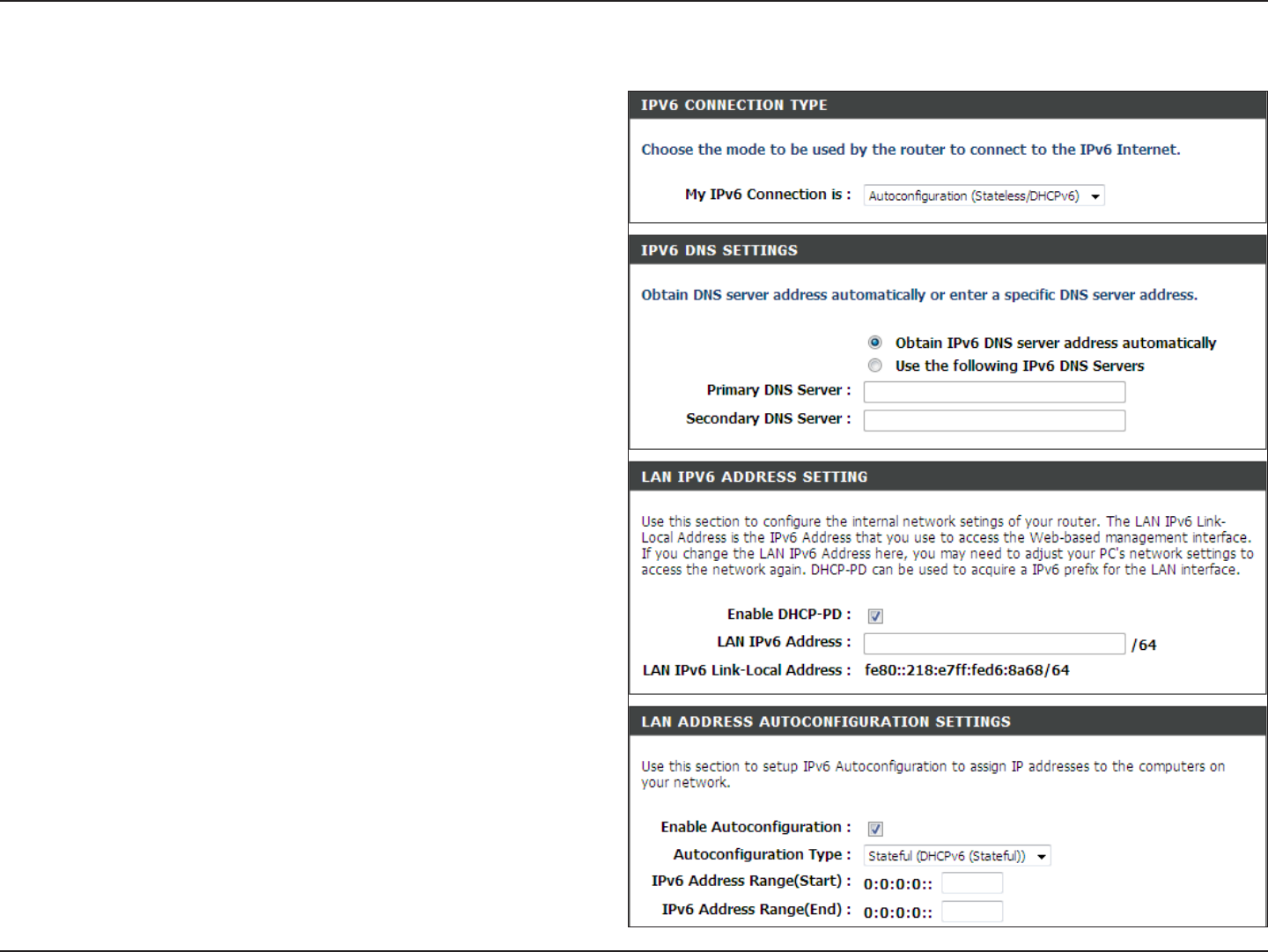
97D-Link DAP-1350 User Manual
Section 3 - Conguration
Select Autoconguration (Stateless/DHCPV6
from the drop-down menu.
Select Obtain IPv6 DNS server address
automatically.
Check the Enable DHCP-PD box to automatically
acquire an IPv6 prex for the LAN interface. Enter
the LAN (local) IPv6 address for the router.
Displays the Router’s LAN Link-Local Address.
Check to enable the Autoconguration feature.
Select Stateful (DHCPv6 (Stateful)).
Enter the start IPv6 Address for the DHCPv6
range for your local computers.
Enter the end IPv6 Address for the DHCPv6 range
for your local computers.
Autoconguration IPv6 (Stateful)
My IPv6 Connection:
IPv6 DNS
Settings:
LAN IPv6 Address:
LAN Link-Local Address:
Enable
Autoconguration:
Autoconguration Type:
IPv6 Address Range
Start:
IPv6 Address Range
End:
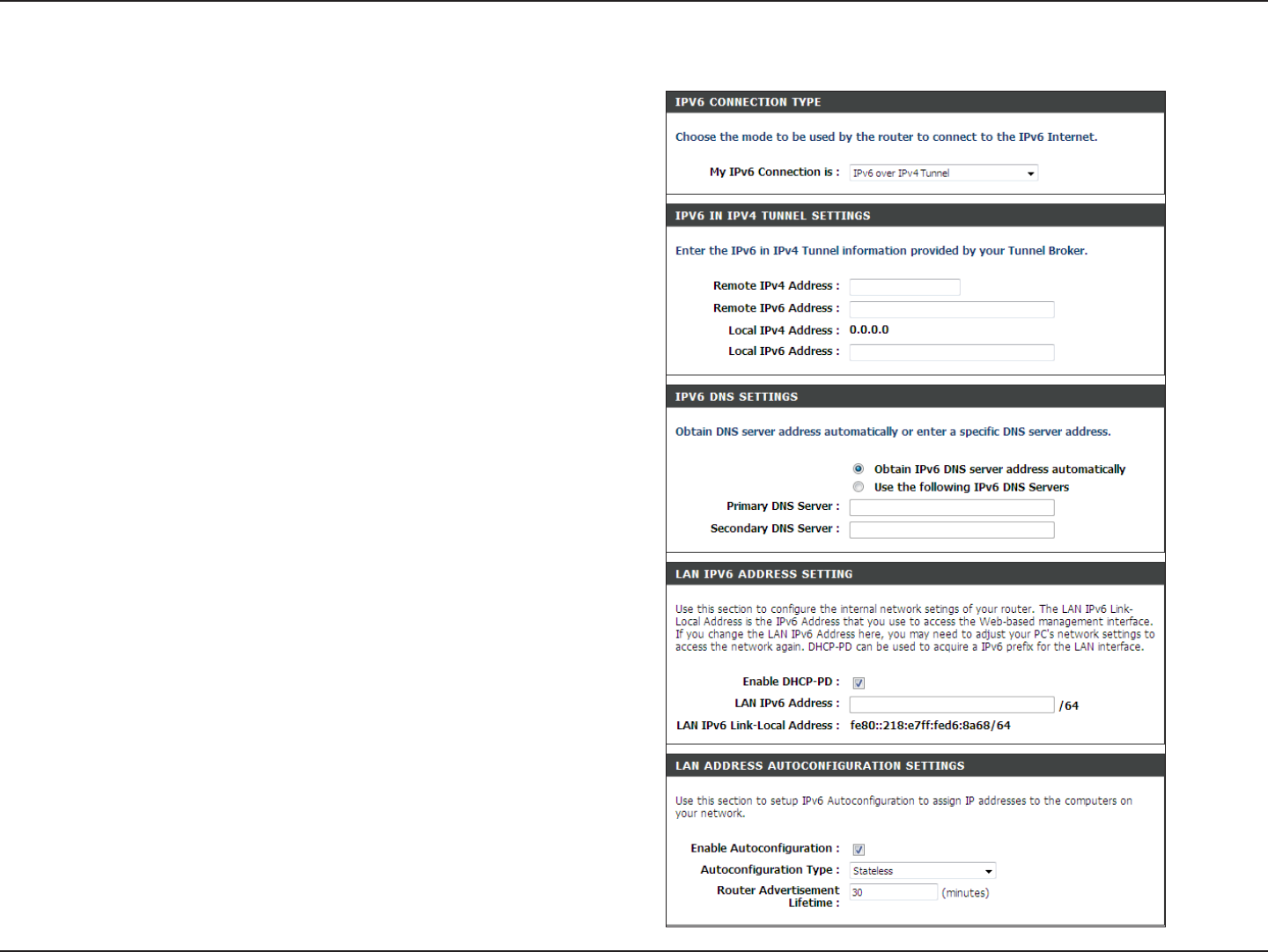
98D-Link DAP-1350 User Manual
Section 3 - Conguration
Select IPv6 over IPv4 Tunnel from the drop-down
menu.
Enter the settings supplied by your Internet
provider (ISP).
Enter the LAN (local) IPv6 address for the router.
Displays the Router’s LAN Link-Local Address.
Check to enable the Autoconguration feature.
Select Stateless.
Enter the Router Advertisement Lifetime (in
minutes).
IPv6 over IPv4 Tunnel (Stateless)
My IPv6 Connection:
IPv6 in IPv4 Tunnel
Settings:
LAN IPv6 Address:
LAN Link-Local
Address:
Enable
Autoconguration:
Autoconguration Type:
Router Advertisement
Lifetime:
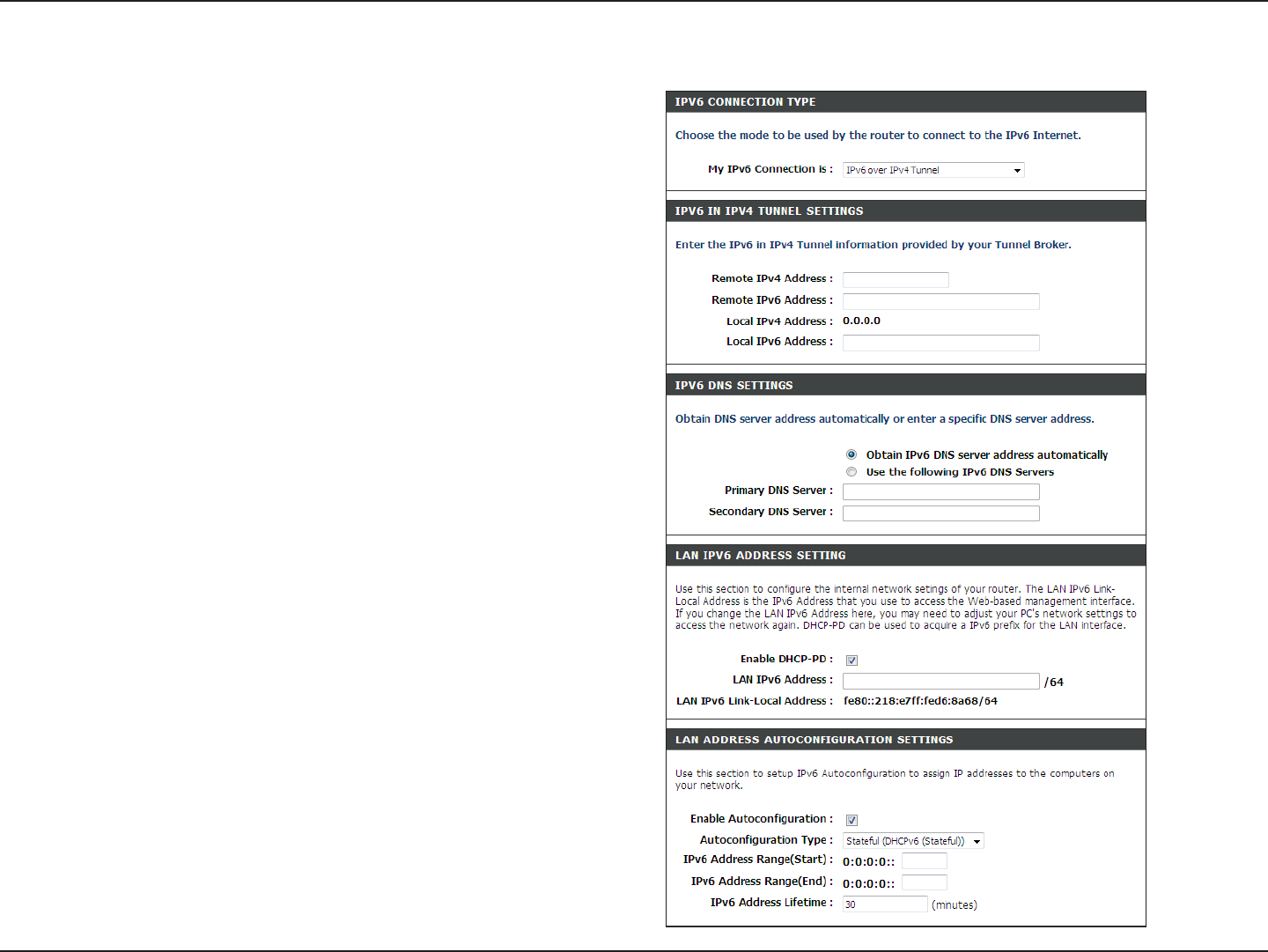
99D-Link DAP-1350 User Manual
Section 3 - Conguration
Select IPv6 over IPv4 Tunnel from the drop-down
menu.
Enter the settings supplied by your Internet
provider (ISP).
Enter the LAN (local) IPv6 address for the router.
Displays the Router’s LAN Link-Local Address.
Check to enable the Autoconguration feature.
Select Stateful (DHCPv6 (Stateful)).
Enter the start IPv6 Address for the DHCPv6 range
for your local computers.
Enter the end IPv6 Address for the DHCPv6 range
for your local computers.
Enter the IPv6 Address Lifetime (in minutes).
IPv6 over IPv4 Tunnel (Stateful)
My IPv6 Connection:
IPv6 in IPv4 Tunnel
Settings:
LAN IPv6 Address:
LAN Link-Local
Address:
Enable
Autoconguration:
Autoconguration
Type:
IPv6 Address Range
Start:
IPv6 Address Range
End:
IPv6 Address Lifetime:
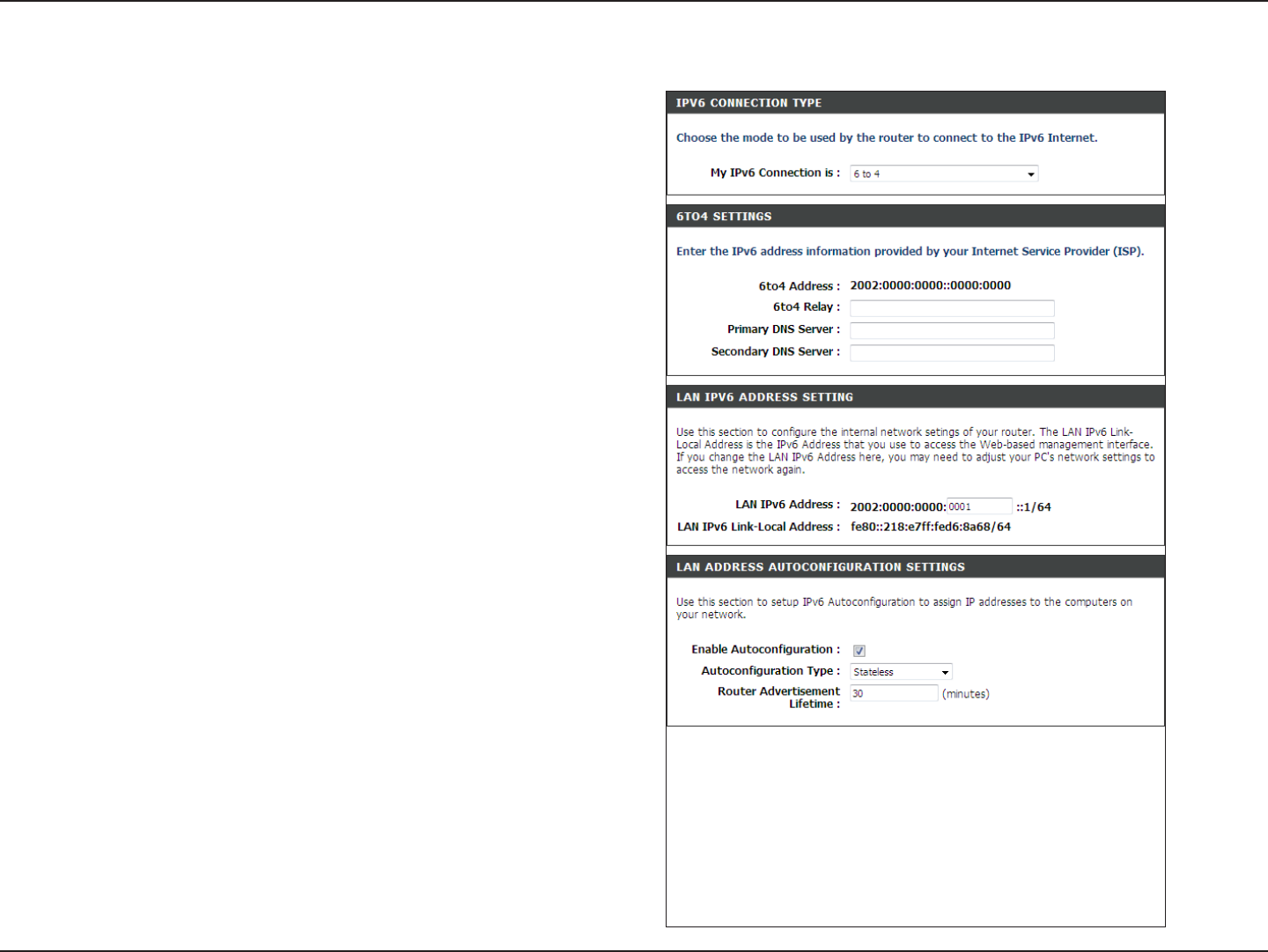
100D-Link DAP-1350 User Manual
Section 3 - Conguration
Select 6 to 4 from the drop-down menu.
Enter the IPv6 settings supplied by your Internet
provider (ISP).
Enter the primary and secondary DNS server
addresses.
Enter the LAN (local) IPv6 address for the router.
Displays the Router’s LAN Link-Local Address.
Check to enable the Autoconguration feature.
Select Stateless.
Enter the Router Advertisement Lifetime (in
minutes).
6 to 4 Tunneling (Stateless)
My IPv6 Connection:
6 to 4 Settings:
Primary/Secondary
DNS Address:
LAN IPv6 Address:
LAN Link-Local
Address:
Enable
Autoconguration:
Autoconguration
Type:
Router Advertisement
Lifetime:
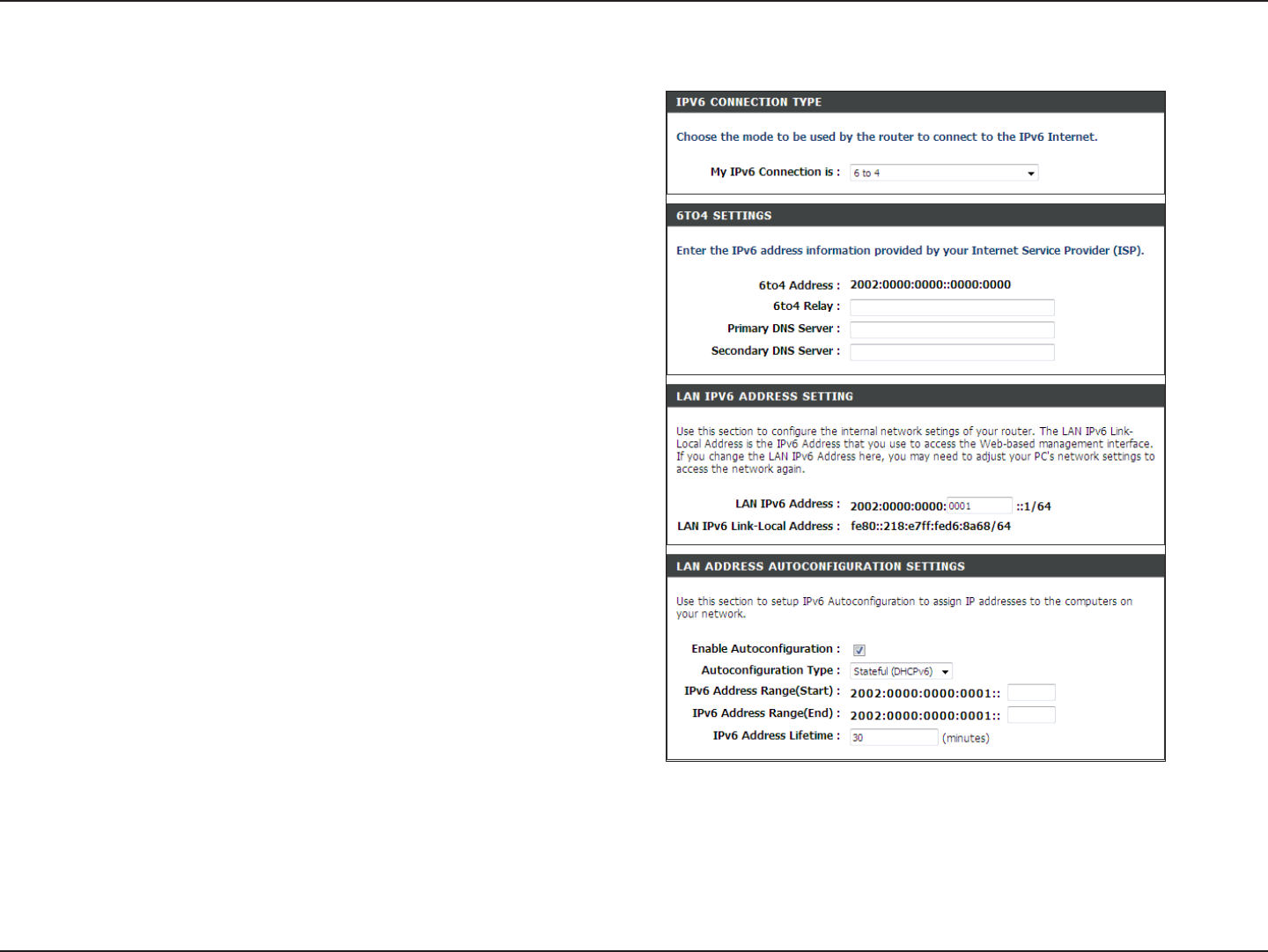
101D-Link DAP-1350 User Manual
Section 3 - Conguration
Select 6 to 4 from the drop-down menu.
Enter the IPv6 settings supplied by your Internet
provider (ISP).
Enter the primary and secondary DNS server
addresses.
Enter the LAN (local) IPv6 address for the router.
Displays the Router’s LAN Link-Local Address.
Check to enable the Autoconguration feature.
Select Stateful (DHCPv6).
Enter the start IPv6 Address for the DHCPv6 range
for your local computers.
Enter the end IPv6 Address for the DHCPv6 range
for your local computers.
Enter the IPv6 Address Lifetime (in minutes).
6 to 4 Tunneling (Stateful)
My IPv6 Connection:
6 to 4 Settings:
Primary/Secondary
DNS Address:
LAN IPv6 Address:
LAN Link-Local
Address:
Enable
Autoconguration:
Autoconguration
Type:
IPv6 Address Range
Start:
IPv6 Address Range
End:
IPv6 Address Lifetime:
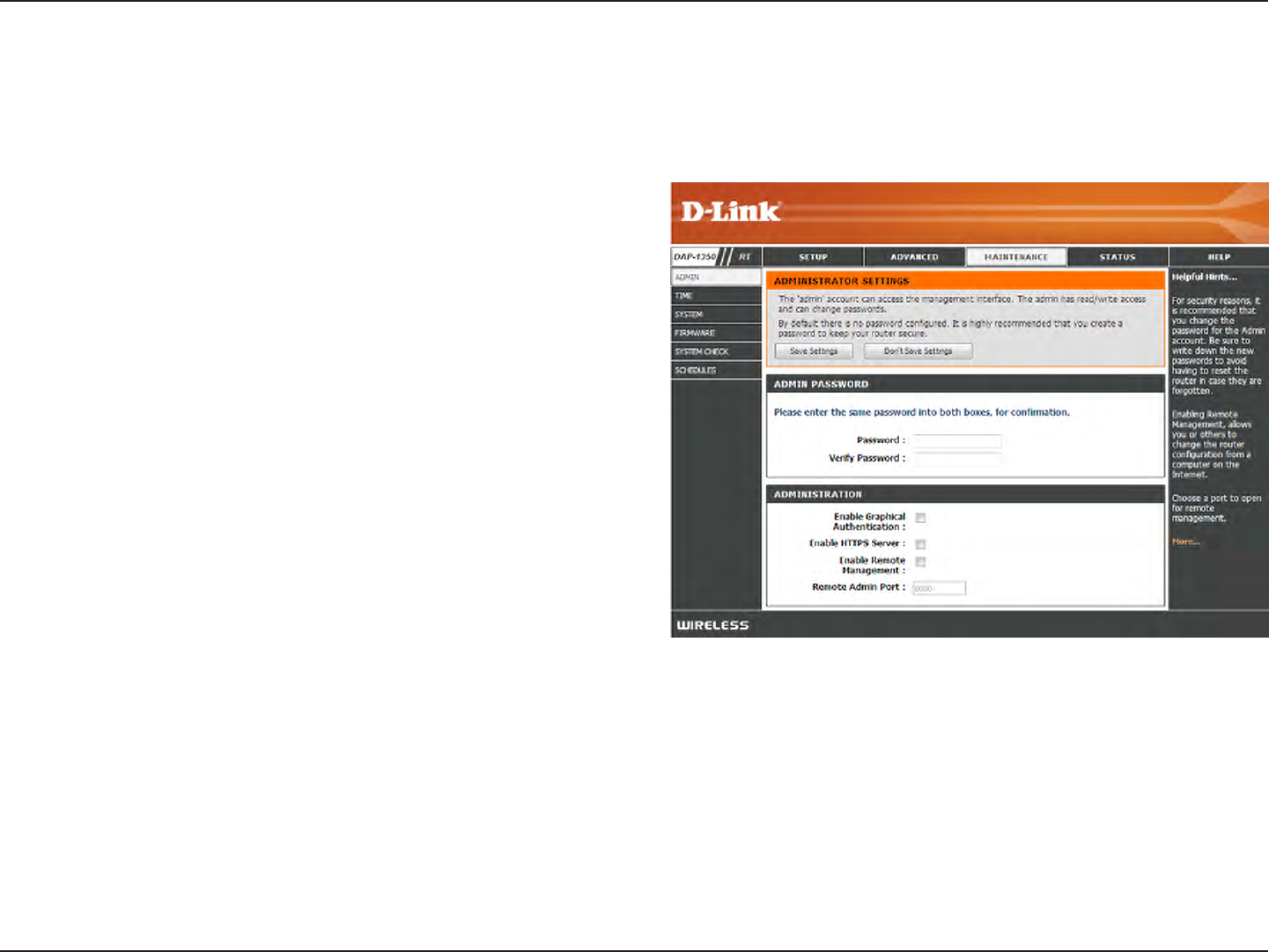
102D-Link DAP-1350 User Manual
Section 3 - Conguration
Enter a new password for the Administrator Login Name. The
administrator can make changes to the settings.
Enables a challenge-response test to require users to type
letters or numbers from a distorted image displayed on the
screen to prevent online hackers and unauthorized users from
gaining access to your router’s network settings.
Check to enable HTTPS to connect to the router securely.
Remote management allows the DAP-1350 to be congured
from the Internet by a web browser. A username and
password is still required to access the Web-Management
interface. In general, only a member of your network can
browse the built-in web pages to perform Administrator
tasks. This feature enables you to perform Administrator tasks
from the remote (Internet) host.
The port number used to access the DAP-1350.
Admin Password:
Enable Graphical
Authentication:
Enable HTTPS
Server:
Remote
Management:
Remote Admin
Port:
Administrator Settings
This page will allow you to change the Administrator password. You can also enable Remote Management. There are two
accounts that can access the management interface through the web browser.
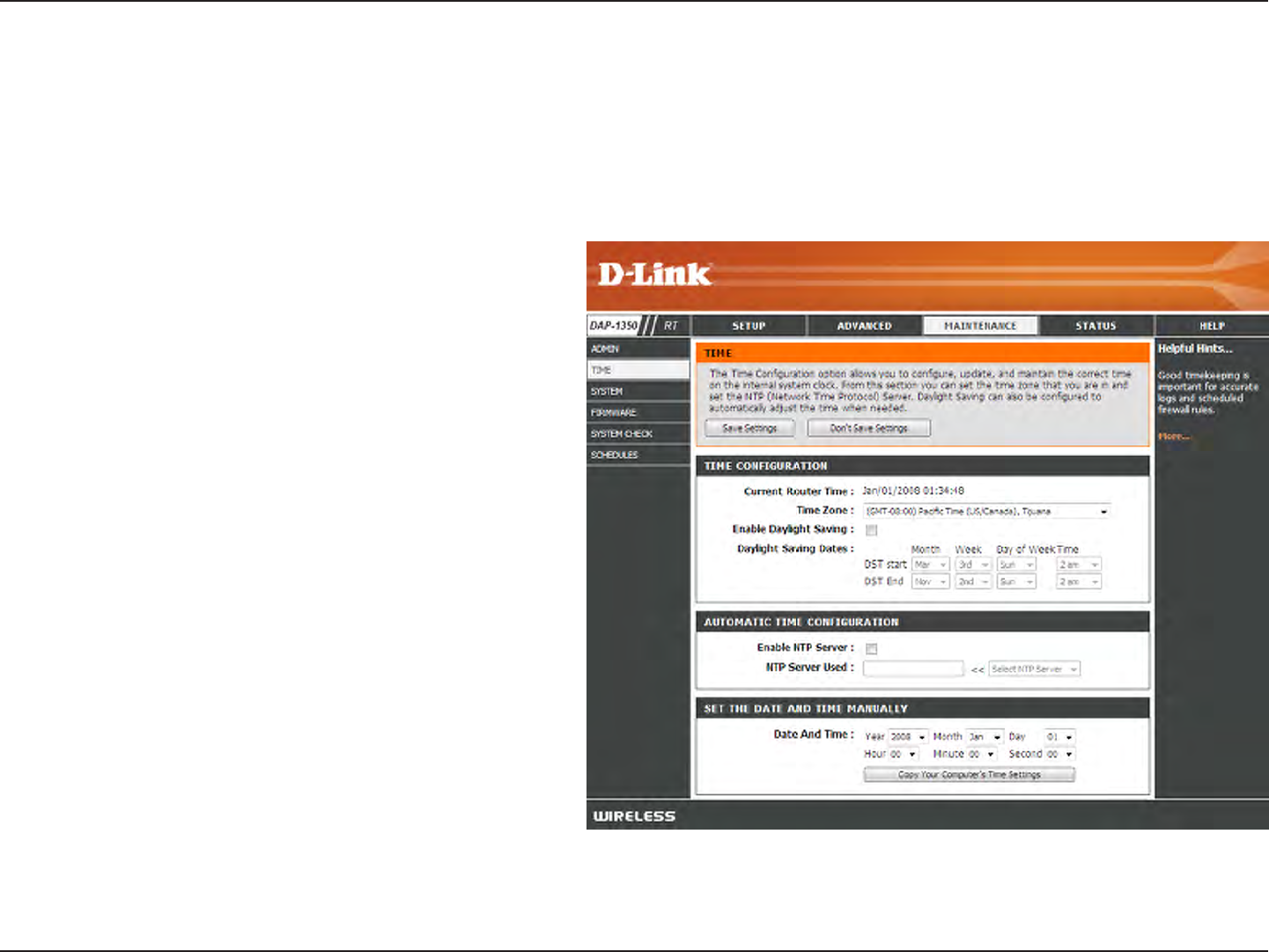
103D-Link DAP-1350 User Manual
Section 3 - Conguration
Time Settings
Select the Time Zone from the drop-down menu.
To select Daylight Saving time manually, select
enabled or disabled, and enter a start date and an
end date for daylight saving time.
NTP is short for Network Time Protocol. NTP
synchronizes computer clock times in a network
of computers. Check this box to use a NTP server.
This will only connect to a server on the Internet,
not a local server.
Enter the NTP server or select one from the drop-
down menu.
To manually input the time, enter the values in
these elds for the Year, Month, Day, Hour, Minute,
and Second and then click Set Time. You can also
click Copy Your Computer’s Time Settings.
Time Zone:
Daylight Saving:
Enable NTP
Server:
NTP Server Used:
Manual:
The Time Conguration option allows you to congure, update, and maintain the correct time on the internal system clock.
From this section you can set the time zone that you are in and set the Time Server. Daylight Saving can also be congured to
automatically adjust the time when needed.
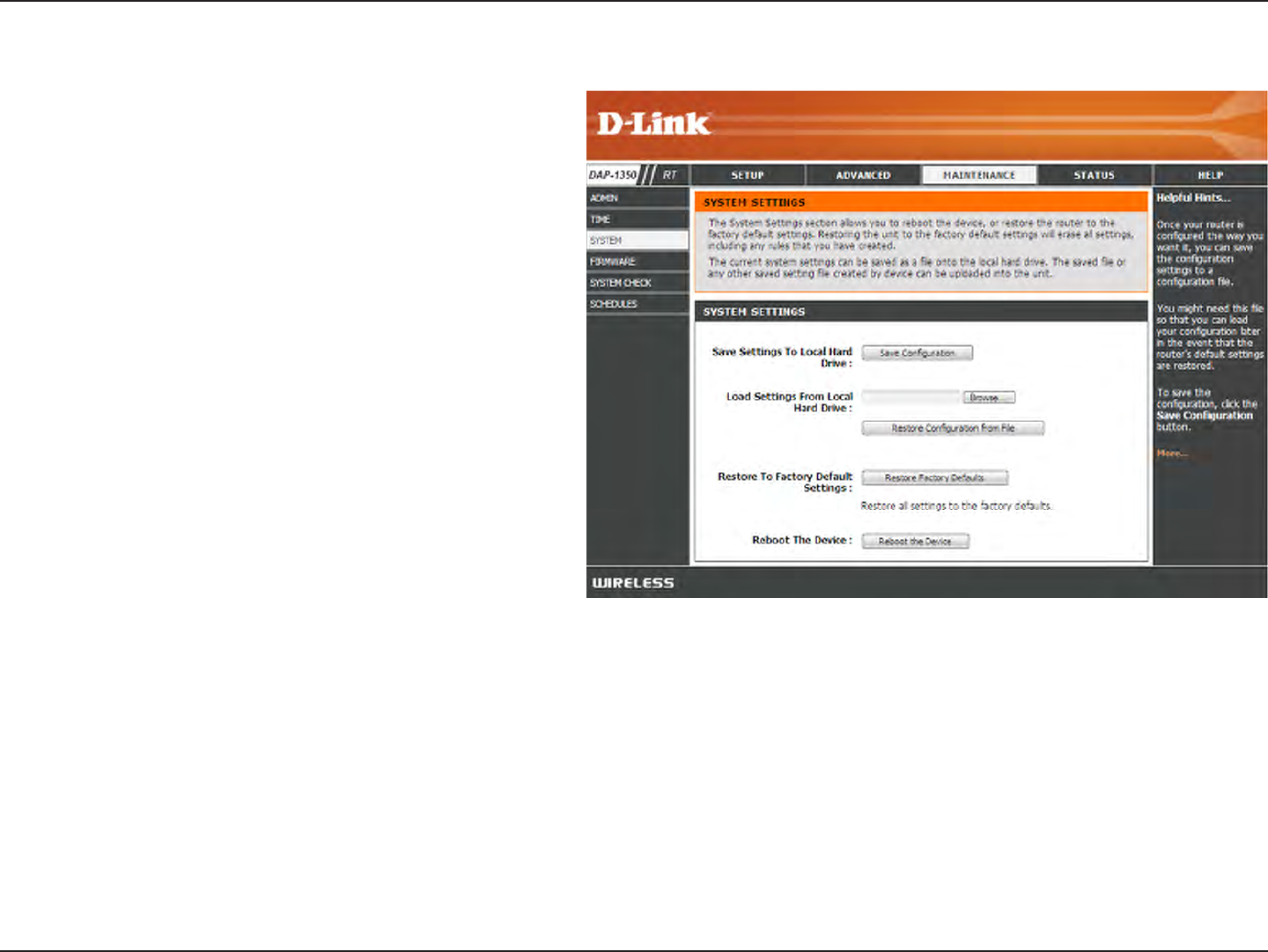
104D-Link DAP-1350 User Manual
Section 3 - Conguration
Use this option to save the current router
conguration settings to a le on the hard disk
of the computer you are using. First, click the
Save button. You will then see a le dialog, where
you can select a location and le name for the
settings.
Use this option to load previously saved router
conguration settings. First, use the Browse control
to find a previously save file of configuration
settings. Then, click the Restore Conguration
from File button to transfer those settings to the
router.
This option will restore all conguration settings
back to the settings that were in effect at the
time the router was shipped from the factory.
Any settings that have not been saved will be
lost, including any rules that you have created. If
you want to save the current router conguration
settings, use the Save button above.
Click to reboot the router.
Save Settings to
Local Hard Drive:
Load Settings
from Local Hard
Drive:
Restore to
Factory Default
Settings:
Reboot Device:
System Settings
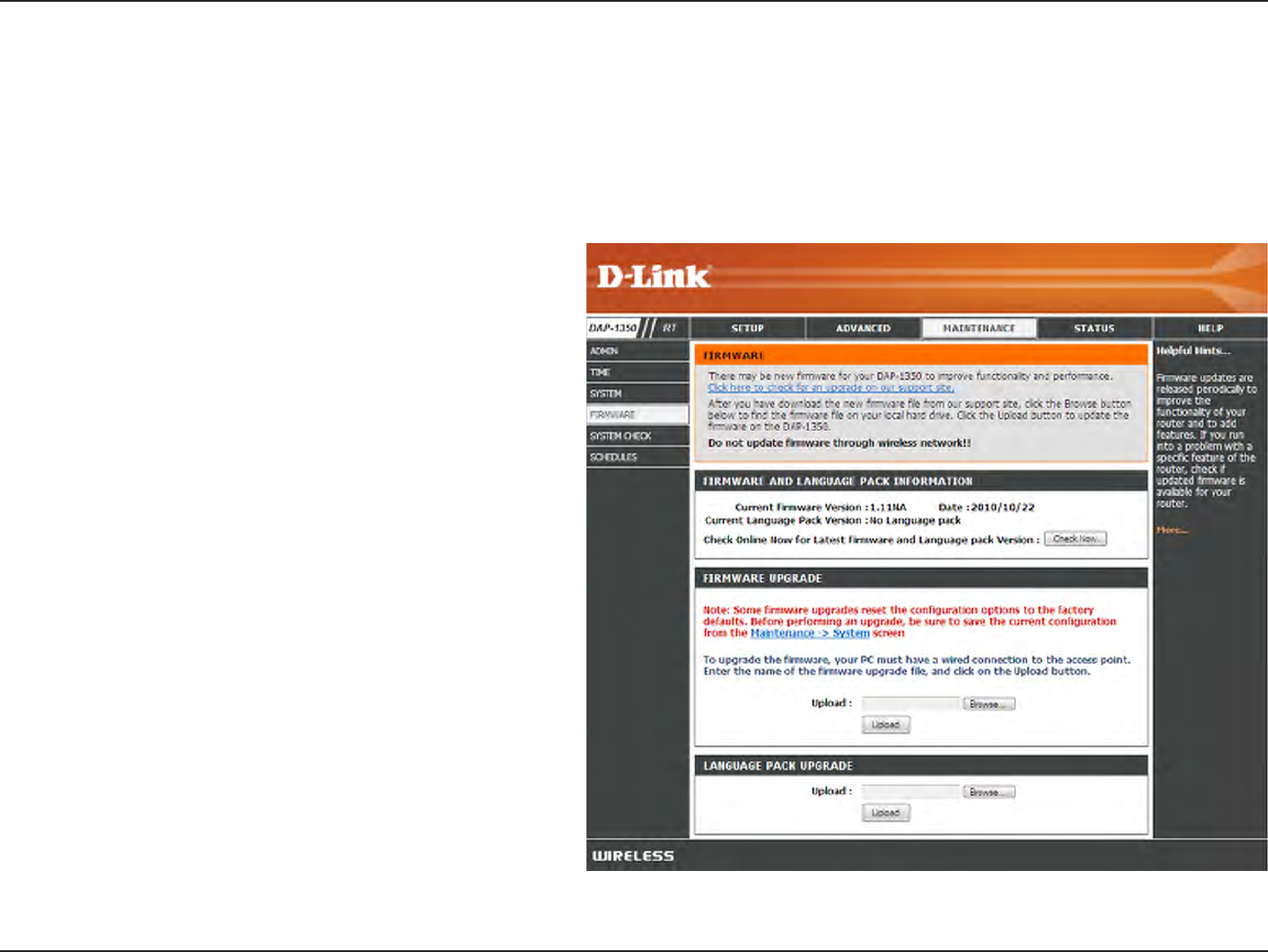
105D-Link DAP-1350 User Manual
Section 3 - Conguration
Click on Check Now to nd out if there is an updated
rmware; if so, download the new rmware to your
hard drive.
After you have downloaded the new firmware,
click Browse to locate the rmware update on your
hard drive. Click Upload to complete the rmware
upgrade.
Firmware
Upgrade:
Browse:
Firmware Update
You can upgrade the rmware of the Router here. Make sure the rmware you want to use is on the local hard drive of the
computer. Click on Browse to locate the rmware le to be used for the update. Please check the D-Link support site for
rmware updates at http://www.dlink.com/support. You can download rmware upgrades to your hard drive from the D-Link
support site.
After you have downloaded the new language pack,
click Browse to locate the language pack le on your
hard drive. Click Upload to complete the language
pack upgrade.
Note: In most cases you must unzip the le rst
before uploading.
Language Pack
You can change the language of the web UI by uploading
available language packs.
Browse:
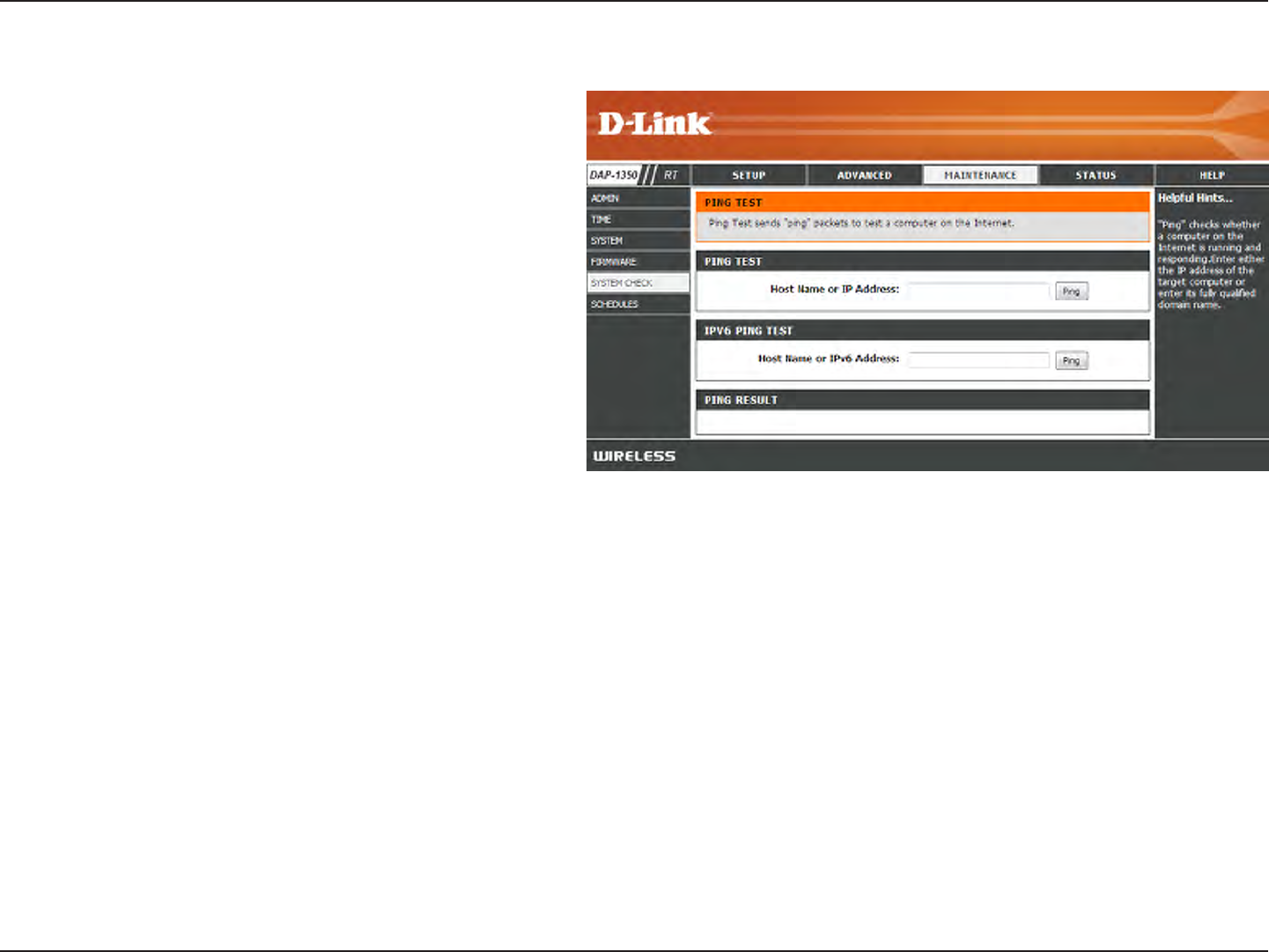
106D-Link DAP-1350 User Manual
Section 3 - Conguration
Ping Test/IPv6 Ping
Test:
Ping Result:
The Ping Test is used to send Ping packets to test if
a computer or device is on the Internet. Enter the
IP Address that you wish to ping, and click Ping.
The results of your ping attempts will be displayed
here.
System Check
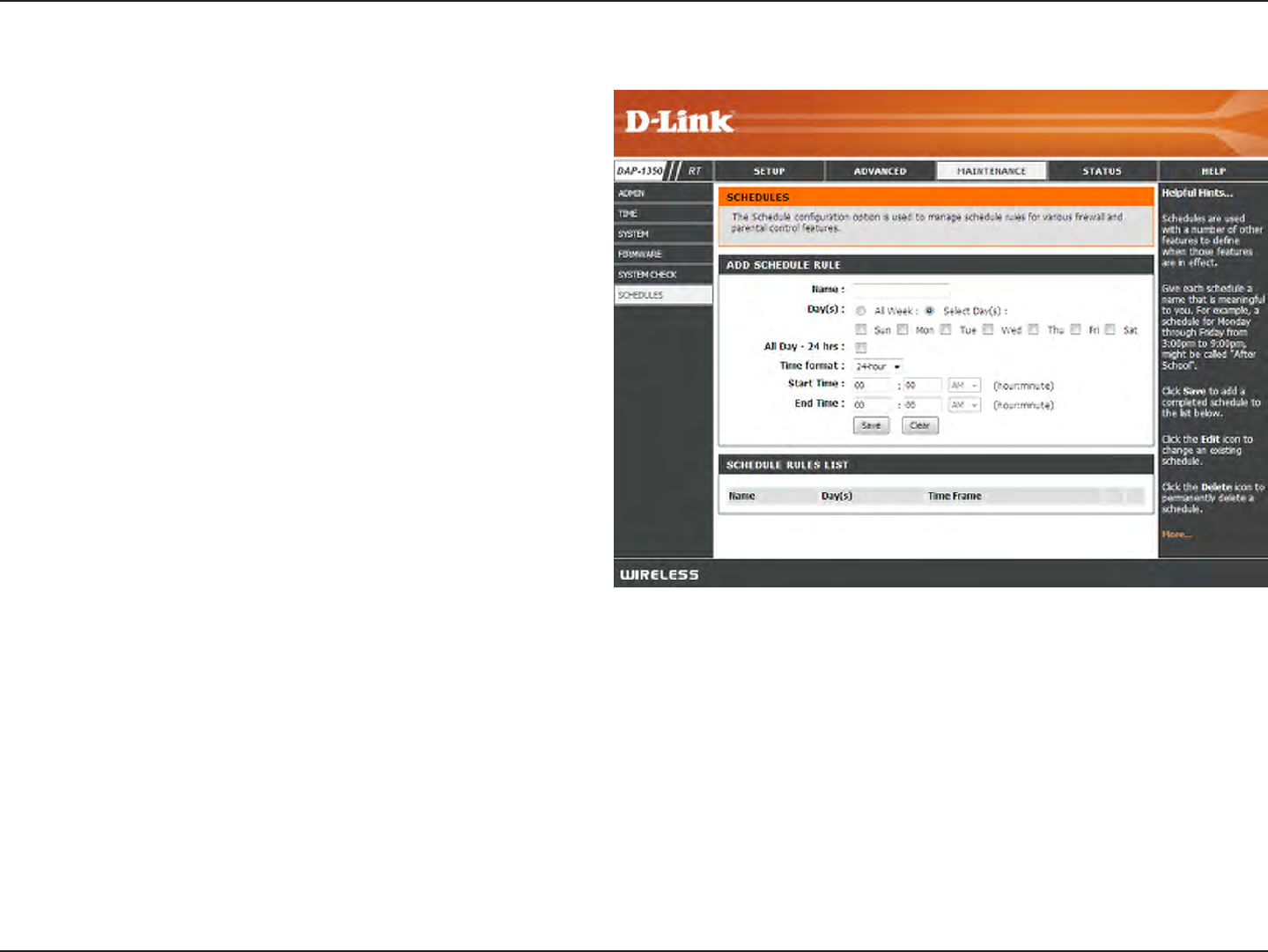
107D-Link DAP-1350 User Manual
Section 3 - Conguration
Enter a name for your new schedule.
Select a day, a range of days, or All Week to include
every day.
Check All Day - 24hrs or enter a start and end time
for your schedule.
Click Save to save your schedule. You must click
Save Settings at the top for your schedules to go
into eect.
The list of schedules will be listed here. Click the
Edit icon to make changes or click the Delete icon
to remove the schedule.
Name:
Days:
Time:
Save:
Schedule Rules
List:
Schedules
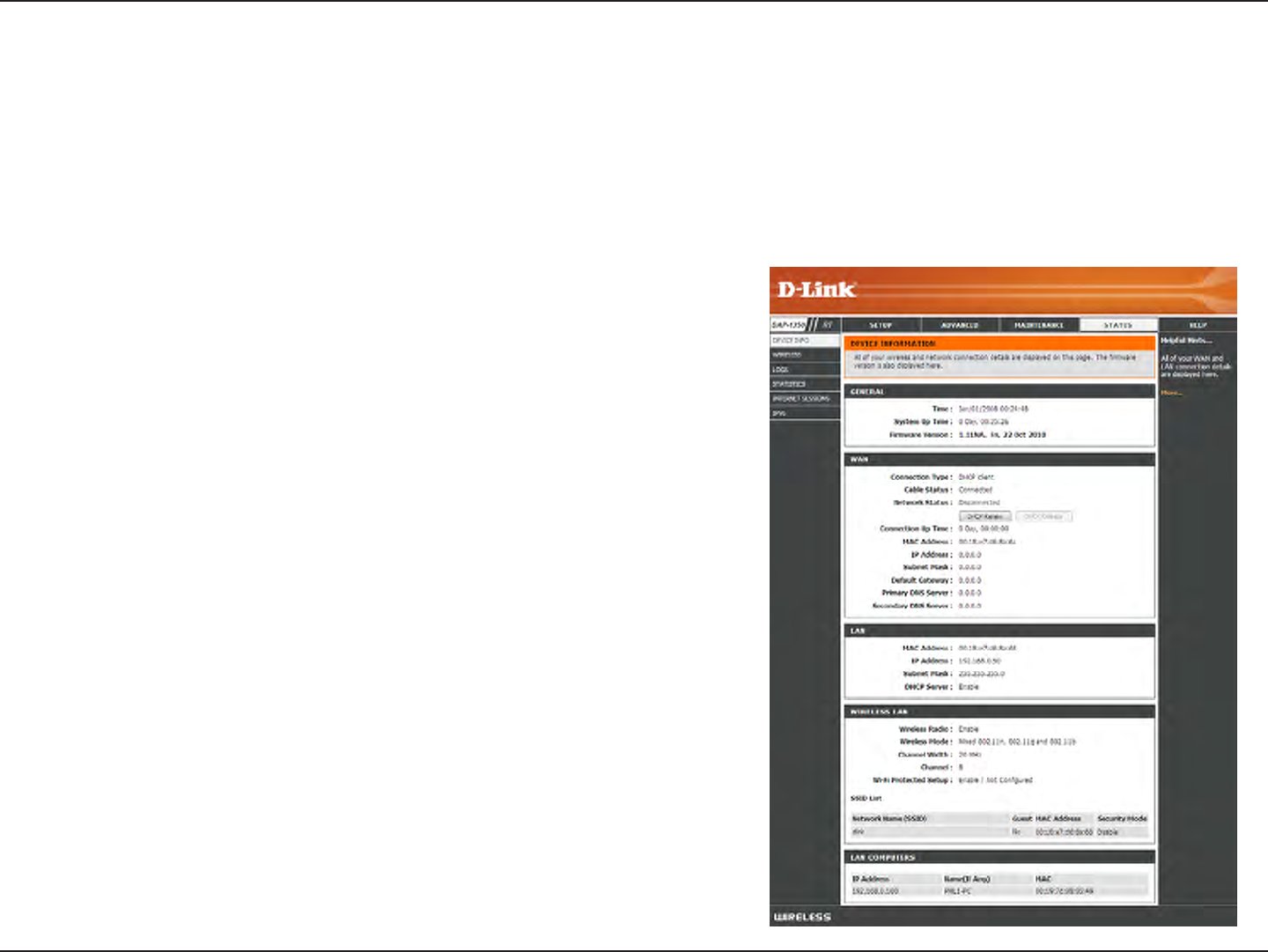
108D-Link DAP-1350 User Manual
Section 3 - Conguration
This page displays the current information for the DAP-1350. It will display the LAN, WAN (Internet), and Wireless information.
If your Internet connection is set up for a Dynamic IP address then a Release button and a Renew button will be displayed. Use Release to disconnect
from your ISP and use Renew to connect to your ISP.
If your Internet connection is set up for PPPoE, a Connect button and a Disconnect button will be displayed. Use Disconnect to drop the PPPoE
connection and use Connect to establish the PPPoE connection.
Displays the router’s time and rmware version.
Displays the MAC address and the public IP settings for the router.
Displays the MAC address and the private (local) IP settings for the
router.
Displays the wireless MAC address and your wireless settings such
as SSID and Channel.
Displays computers and devices that are connected to the router
via Ethernet and that are receiving an IP address assigned by the
router (DHCP).
General:
WAN:
LAN:
Wireless LAN:
LAN Computers:
Device Information
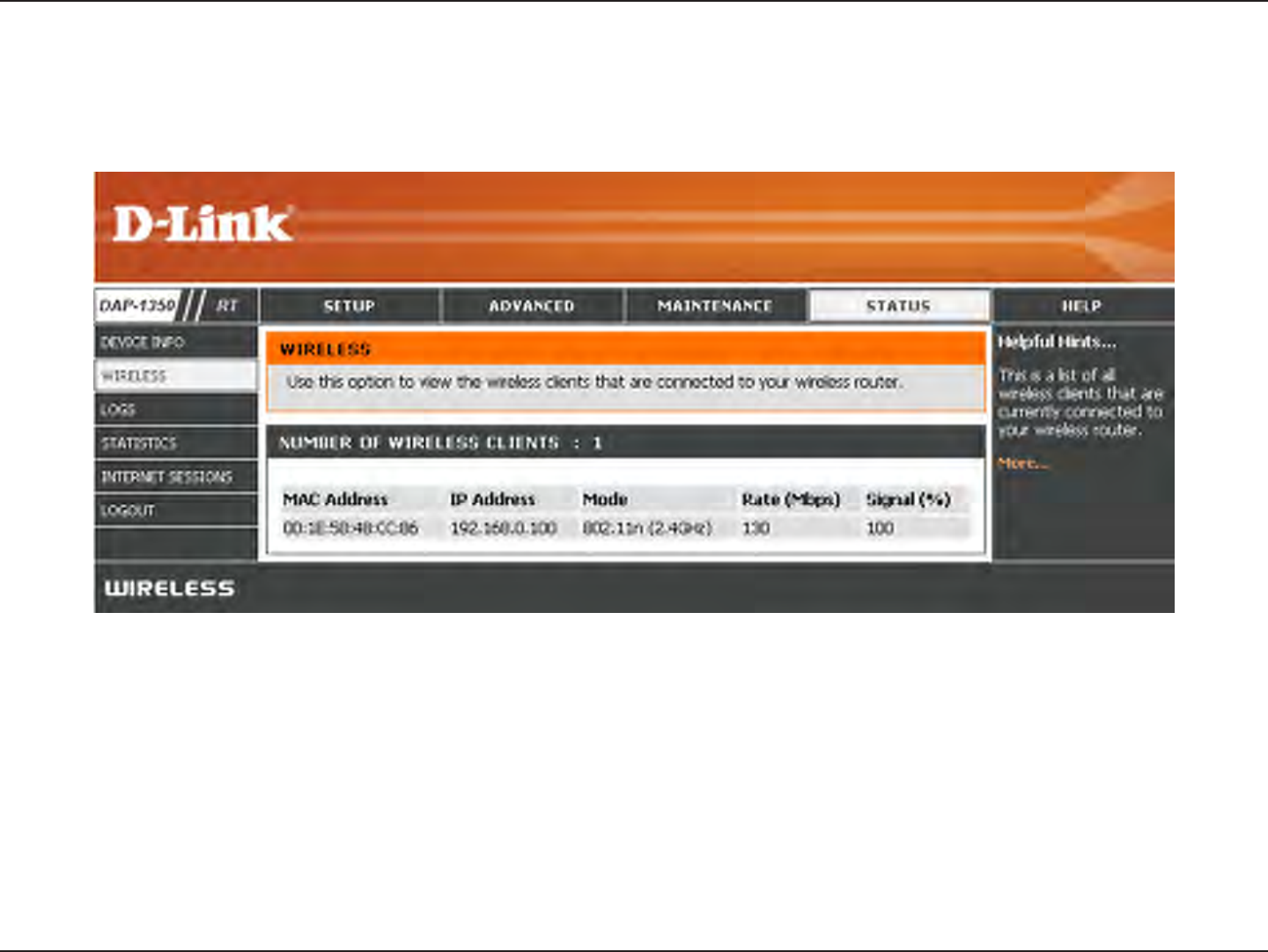
109D-Link DAP-1350 User Manual
Section 3 - Conguration
The wireless client table displays a list of current connected wireless clients. This table also displays the connection rate and
MAC address of the connected wireless clients.
Wireless
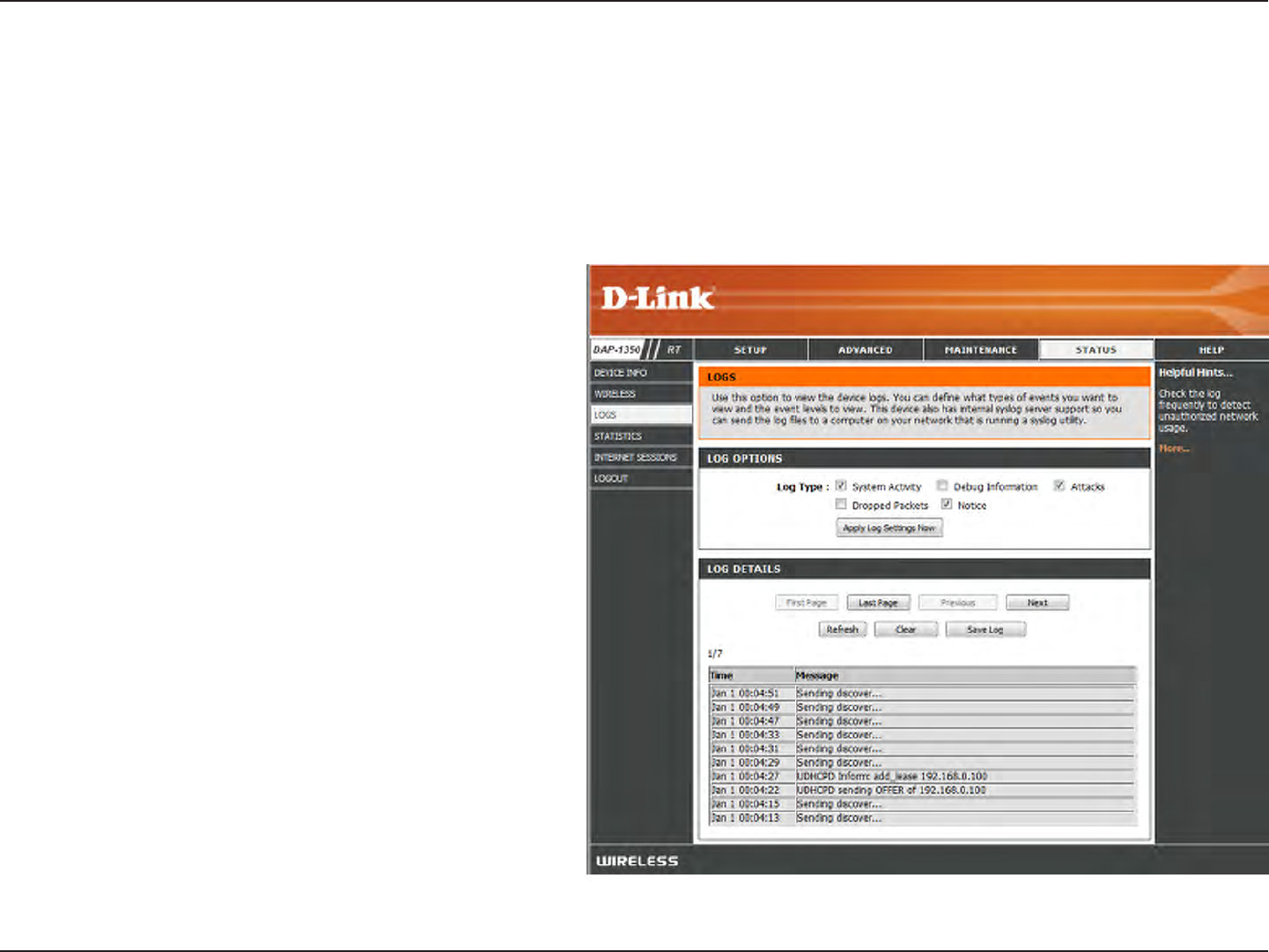
110D-Link DAP-1350 User Manual
Section 3 - Conguration
Logs
Log Options:
First Page:
Last Page:
Previous:
Next:
Clear:
Log Settings:
Refresh:
Save Log:
You can select the types of messages that you
want to display from the log: System Activity,
Debug Information, Attacks, Dropped Packets,
and Notice. Select and click Apply Log Settings
Now.
This button directs you to the rst page of the
log.
This button directs you to the last page of the
log.
This button directs you to the previous page of
the log.
This button directs you to the next page of the
log.
This button clears all current log content.
This button opens a new menu where you can
congure the log settings.
This button refreshes the log.
This option will save the router log to a le on your
computer.
The router automatically logs (records) events of possible interest in it’s internal memory. If there isn’t enough internal memory
for all events, logs of older events are deleted but logs of the latest events are retained. The Logs option allows you to view
the router logs. You can dene what types of events you want to view and the level of the events to view. This router also has
external Syslog Server support so you can send the log les to a computer on your network that is running a Syslog utility.
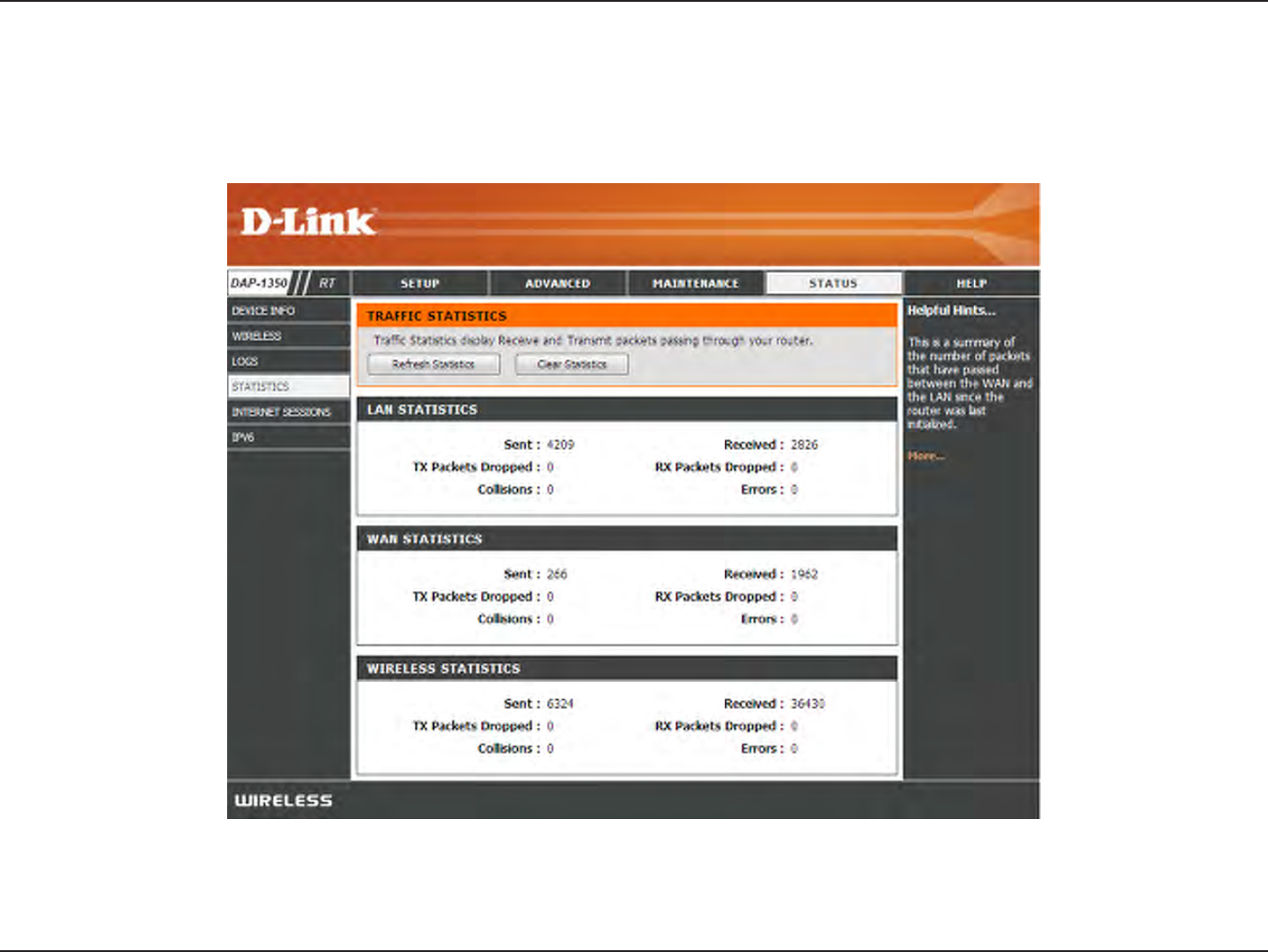
111D-Link DAP-1350 User Manual
Section 3 - Conguration
Statistics
The screen below displays the Trac Statistics. Here you can view the amount of packets that pass through the DAP-1350 on the
Internet, wireless, and the LAN ports. The trac counter will reset if the device is rebooted.
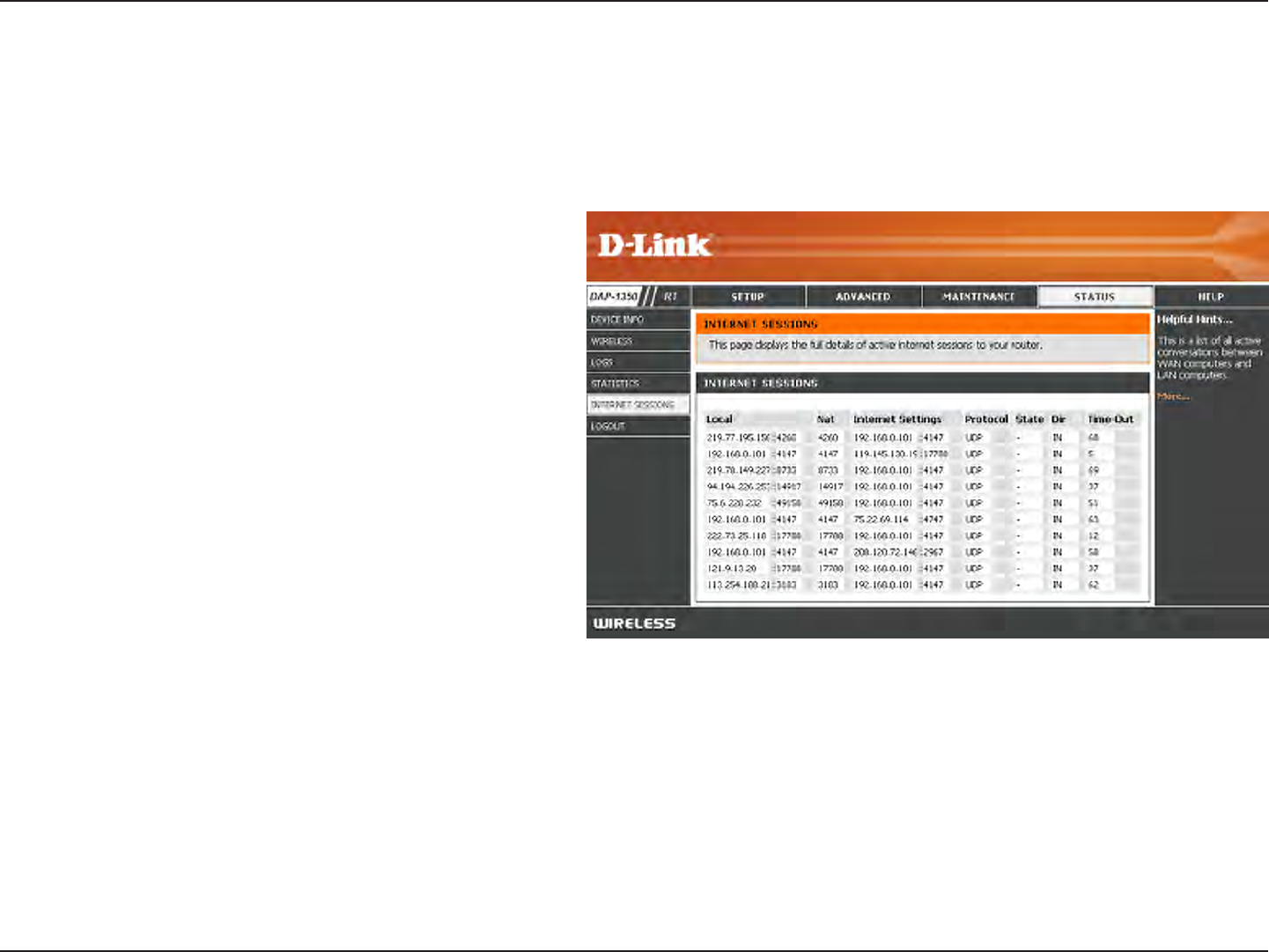
112D-Link DAP-1350 User Manual
Section 3 - Conguration
Internet Sessions
The Internet Sessions page displays full details of active Internet sessions through your router. An Internet session is a conversation
between a program or application on a LAN-side computer and a program or application on a WAN-side computer.
Local:
NAT:
Internet:
Protocol:
State:
The IP address and, where appropriate, port number
of the local application.
The port number of the LAN-side application as
viewed by the WAN-side application.
The IP address and, where appropriate, port number
of the application on the Internet.
The communications protocol used for the
conversation.
State for sessions that use the TCP protocol:
NO: None -- This entry is used as a placeholder for a
future connection that may occur.
SS: SYN Sent -- One of the systems is attempting to
start a connection.
EST: Established -- the connection is passing data.
FW: FIN Wait -- The client system has requested that the connection be stopped.
CW: Close Wait -- The server system has requested that the connection be stopped.
TW: Time Wait -- Waiting for a short time while a connection that was in FIN Wait is fully closed.
LA: Last ACK -- Waiting for a short time while a connection that was in Close Wait is fully closed.
CL: Closed -- The connection is no longer active but the session is being tracked in case there are any retransmitted packets still
pending.

113D-Link DAP-1350 User Manual
Section 3 - Conguration
Dir:
Priority:
Time Out:
The direction of initiation of the conversation:
Out - Initiated from LAN to WAN.
In - Initiated from WAN to LAN.
The preference given to outbound packets of this conversation by the QoS Engine logic. Smaller numbers represent higher
priority.
The number of seconds of idle time until the router considers the session terminated. The initial value of Time Out depends on the
type and state of the connection.
300 seconds - UDP connections.
240 seconds - Reset or closed TCP connections. The connection does not close instantly so that lingering packets can pass
or the connection can be re-established.
7800 seconds - Established or closing TCP connections.
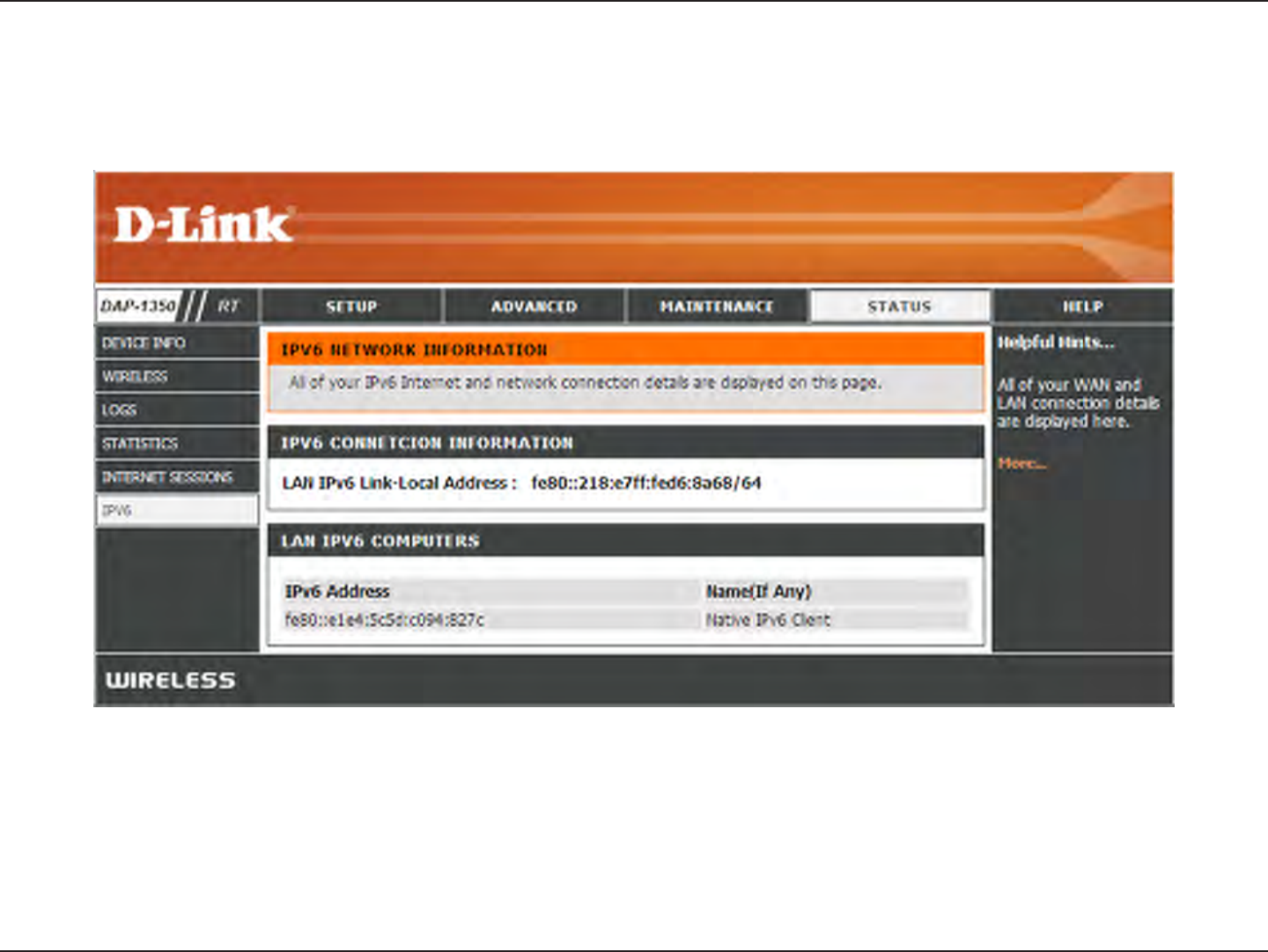
114D-Link DAP-1350 User Manual
Section 3 - Conguration
The screen below displays the IPv6 Internet and network connection details.
IPv6
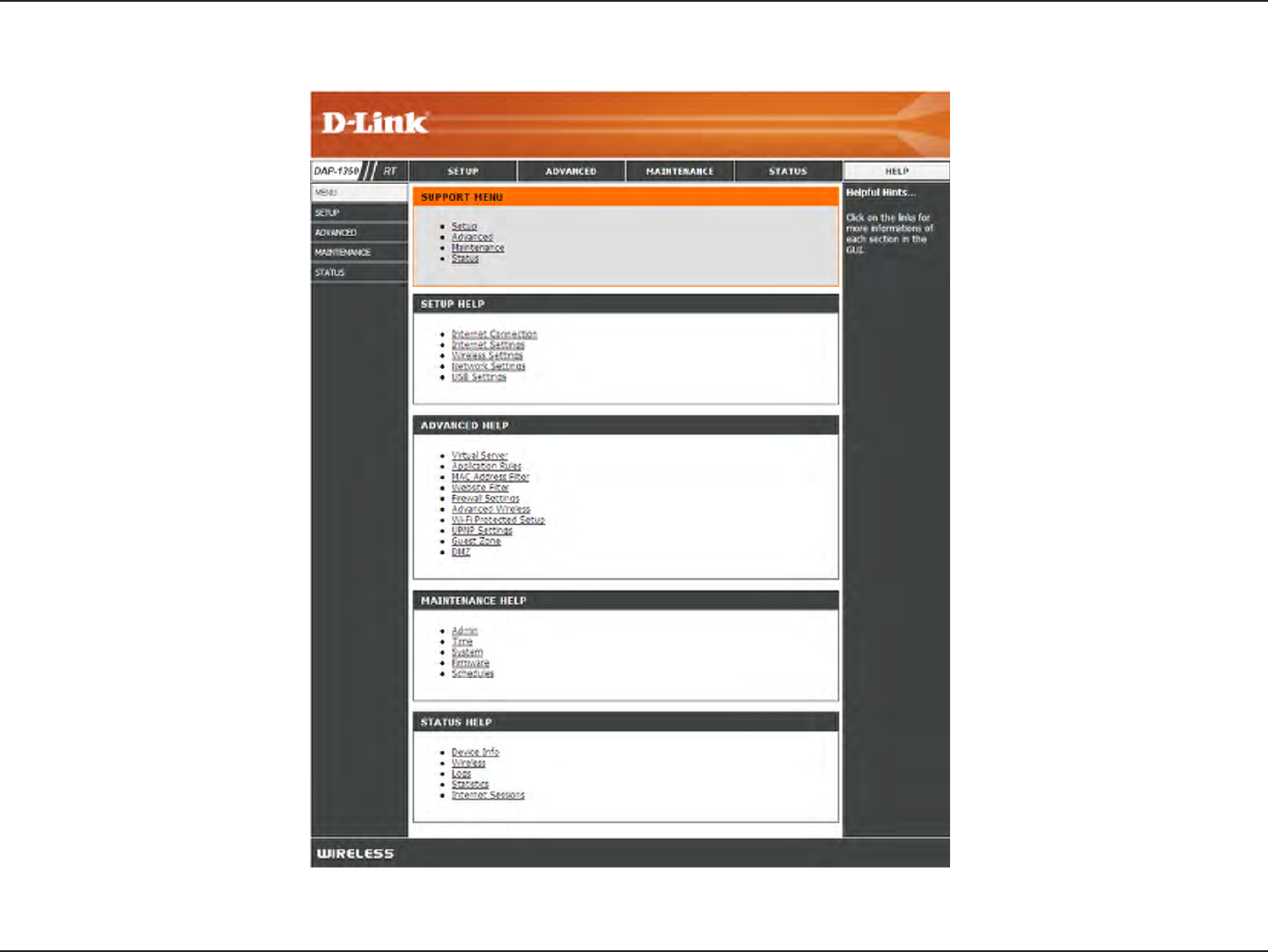
115D-Link DAP-1350 User Manual
Section 3 - Conguration
Help

116D-Link DAP-1350 User Manual
Section 4 - Security
Wireless Security
This section will show you the dierent levels of security you can use to protect your data from intruders. The DAP-1350 oers
the following types of security:
• WPA2 (Wi-Fi Protected Access 2) • WPA2-PSK (Pre-Shared Key)
• WPA (Wi-Fi Protected Access) • WPA-PSK (Pre-Shared Key)
• WEP (Wired Equivalent Privacy)
What is WEP?
WEP stands for Wired Equivalent Privacy. It is based on the IEEE 802.11 standard and uses the RC4 encryption algorithm. WEP
provides security by encrypting data over your wireless network so that it is protected as it is transmitted from one wireless
device to another.
To gain access to a WEP network, you must know the key. The key is a string of characters that you create. When using WEP,
you must determine the level of encryption. The type of encryption determines the key length. 128-bit encryption requires a
longer key than 64-bit encryption. Keys are dened by entering in a string in HEX (hexadecimal - using characters 0-9, A-F) or
ASCII (American Standard Code for Information Interchange – alphanumeric characters) format. ASCII format is provided so
you can enter a string that is easier to remember. The ASCII string is converted to HEX for use over the network. Four keys can
be dened so that you can change keys easily.

117D-Link DAP-1350 User Manual
Section 4 - Security
What is WPA?
WPA, or Wi-Fi Protected Access, is a Wi-Fi standard that was designed to improve the security features of WEP (Wired Equivalent
Privacy).
The 2 major improvements over WEP:
• Improved data encryption through the Temporal Key Integrity Protocol (TKIP). TKIP scrambles the keys using a
hashing algorithm and, by adding an integrity-checking feature, ensures that the keys haven’t been tampered
with. WPA2 is based on 802.11i and uses Advanced Encryption Standard (AES) instead of TKIP.
• User authentication, which is generally missing in WEP, through the extensible authentication protocol (EAP).
WEP regulates access to a wireless network based on a computer’s hardware-specic MAC address, which is
relatively simple to be snied out and stolen. EAP is built on a more secure public-key encryption system to
ensure that only authorized network users can access the network.
WPA-PSK/WPA2-PSK uses a passphrase or key to authenticate your wireless connection. The key is an alpha-numeric password
between 8 and 63 characters long. The password can include symbols (!?*&_) and spaces. This key must be the exact same key
entered on your wireless bridge or access point.
WPA/WPA2 incorporates user authentication through the Extensible Authentication Protocol (EAP). EAP is built on a more
secure public key encryption system to ensure that only authorized network users can access the network.
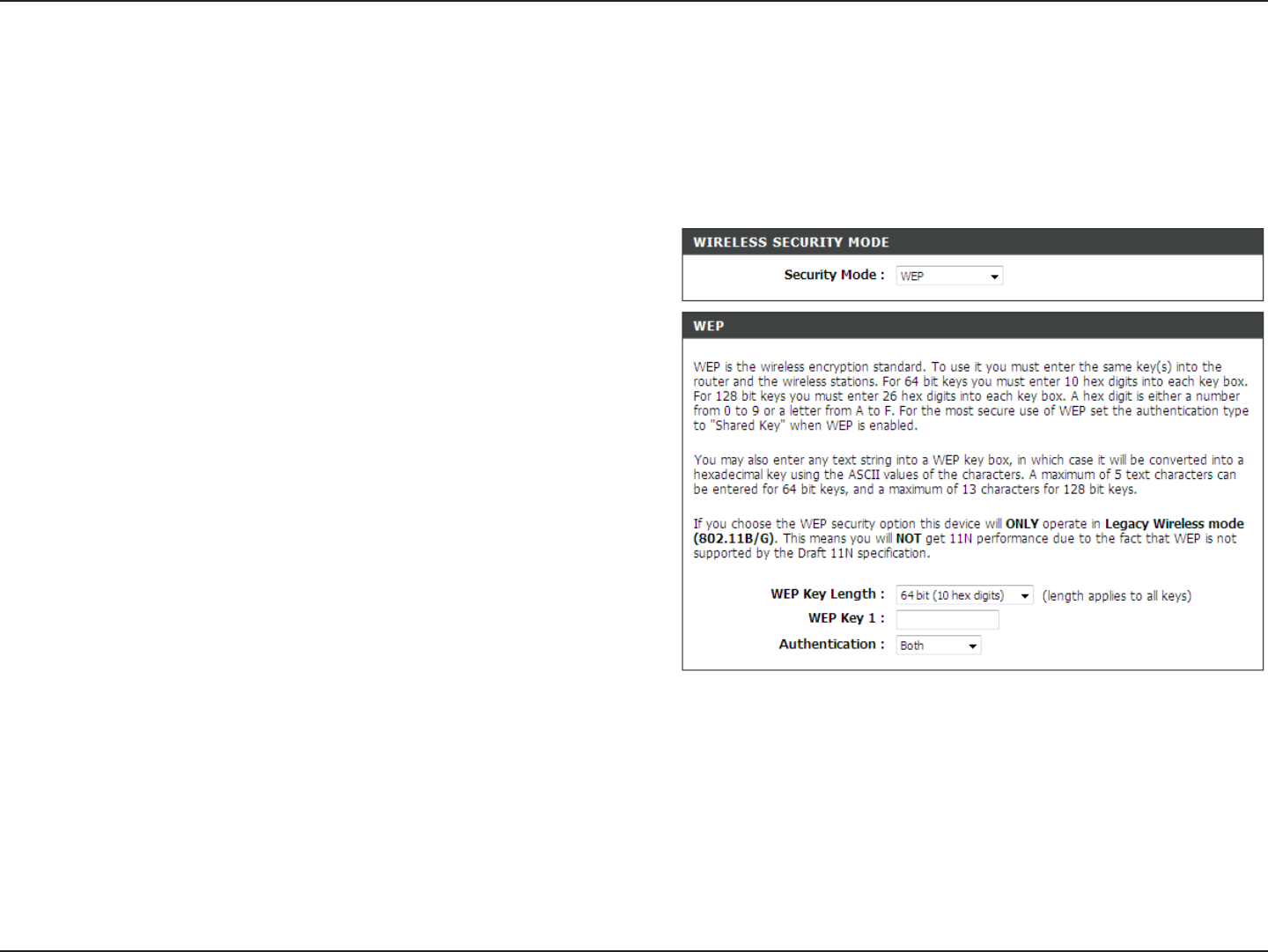
118D-Link DAP-1350 User Manual
Section 4 - Security
Congure WEP
It is recommended to enable encryption on your wireless access point before your wireless network adapters. Please establish
wireless connectivity before enabling encryption. Your wireless signal may degrade when enabling encryption due to the
added overhead.
1. Log into the web-based conguration by opening a web browser
and entering the IP address of the access point (192.168.0.50).
Click on Setup and then click Wireless Settings on the left side.
2. Next to Security Mode in the Wireless Security Mode section,
select Enable WEP Wireless Security (Basic).
3. Next to Authentication, select Open or Shared Key.
4. Next to WEP Encryption, select 64-bit or 128-bit encryption.
5. Next to Key Type, select either Hex or ASCII.
Hex (recommended) - Letters A-F and numbers 0-9 are valid. ASCII
- All numbers and letters are valid.
6. Next to Key 1, enter a WEP key that you create. Make sure you
enter this key exactly on all your wireless devices.
7. Click Save Settings at the top of the window to save your settings. If you are conguring the access point with a wireless
adapter, you will lose connectivity until you enable WEP on your adapter and enter the same WEP key as you did on the
access point.
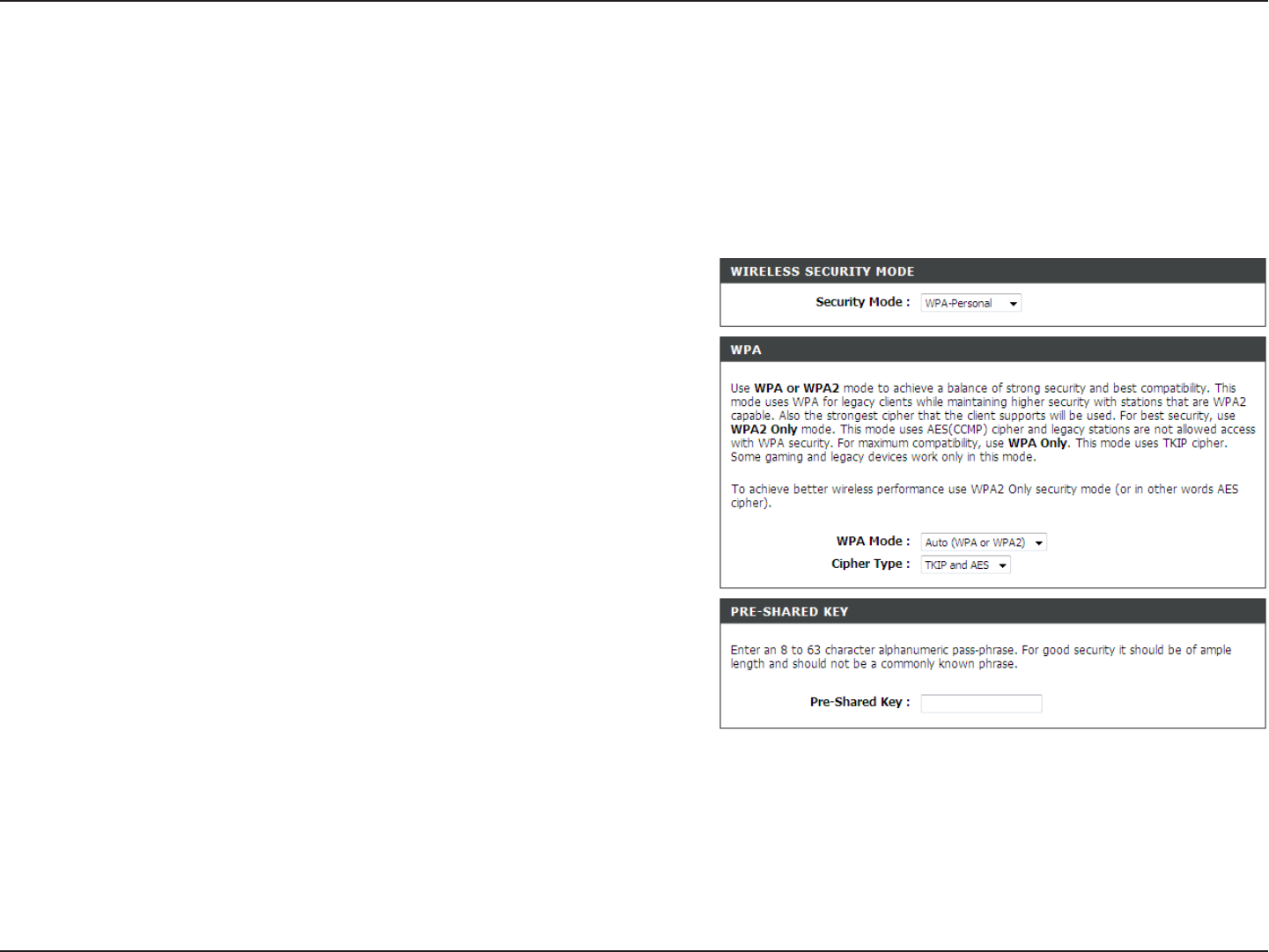
119D-Link DAP-1350 User Manual
Section 4 - Security
Congure WPA/WPA2 Personal
It is recommended to enable encryption on your wireless access point before your wireless network adapters. Please establish
wireless connectivity before enabling encryption. Your wireless signal may degrade when enabling encryption due to the
added overhead.
1. Log into the web-based conguration by opening a web browser
and entering the IP address of the access point (192.168.0.50). Click
on Setup and then click Wireless Settings on the left side.
2. Next to Security Mode, select WPA-Personal.
3. Next to WPA Mode, select WPA, WPA2, or Auto.
4. Next to Cipher Type, select TKIP, AES, or Auto.
5. Next to Pre-Shared Key, enter a key. The key is entered as a
passphrase in ASCII format at both ends of the wireless connection.
The passphrase must be between 8-63 characters.
6. Click Save Settings at the top of the window to save your settings.
If you are conguring the access point with a wireless adapter, you
will lose connectivity until you enable WPA-PSK on your adapter
and enter the same passphrase as you did on the access point.
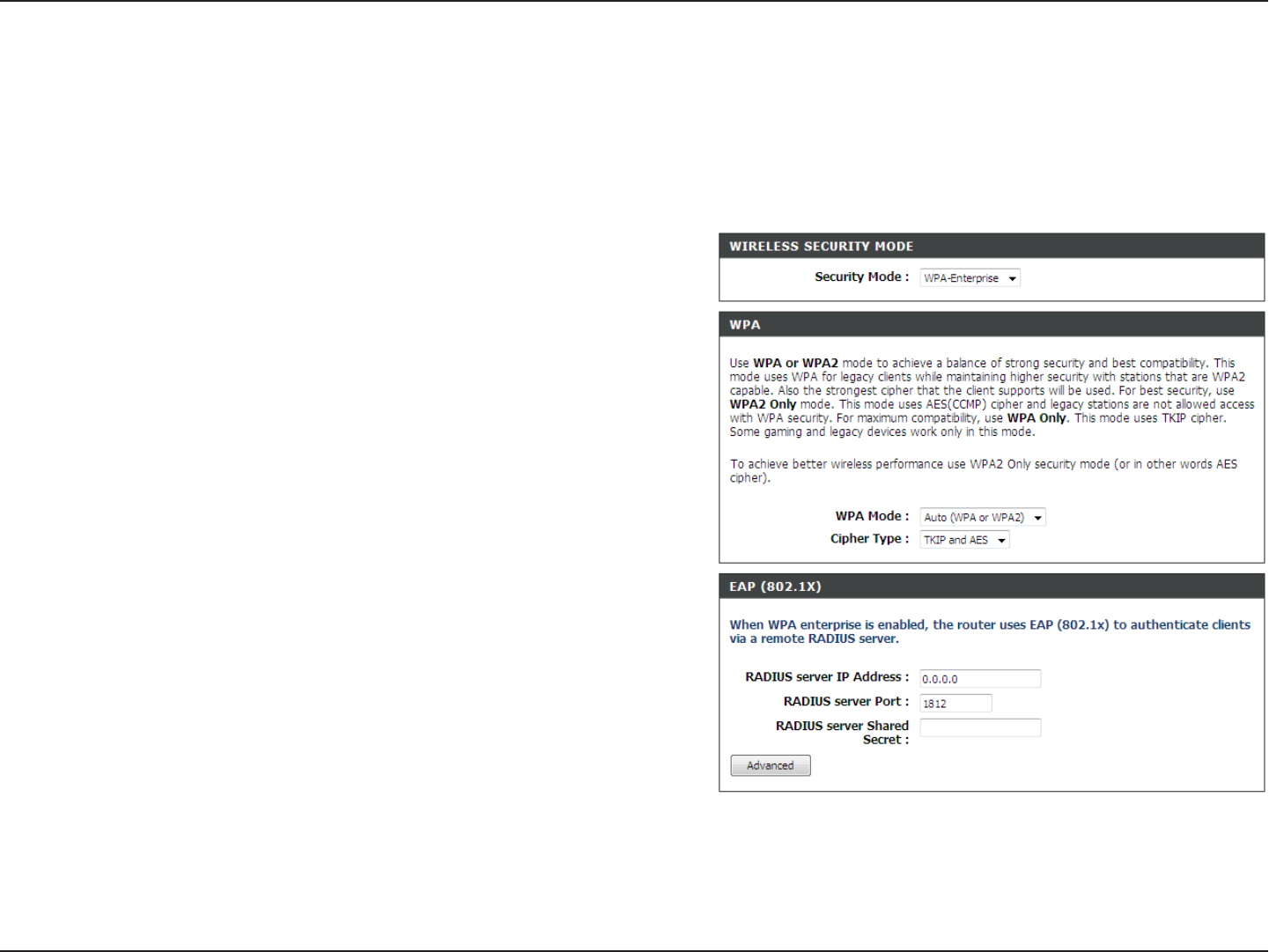
120D-Link DAP-1350 User Manual
Section 4 - Security
It is recommended to enable encryption on your wireless access point before your wireless network adapters. Please establish
wireless connectivity before enabling encryption. Your wireless signal may degrade when enabling encryption due to the
added overhead.
1. Log into the web-based conguration by opening a web browser
and entering the IP address of the access point (192.168.0.50). Click
on Setup and then click Wireless Settings on the left side.
2. Next to Security Mode, select WPA-Enterprise.
3. Next to WPA Mode, select WPA, WPA2, or Auto.
4. Next to Cipher Mode, select TKIP, AES, or Auto.
5. Next to RADIUS Server, enter the IP Address of your RADIUS server.
6. Next to Port, enter the port you are using with your RADIUS server.
1812 is the default port.
7. Next to Shared Secret, enter the security key.
8. Click Save Settings to save your settings.
Congure WPA/WPA2 Enterprise
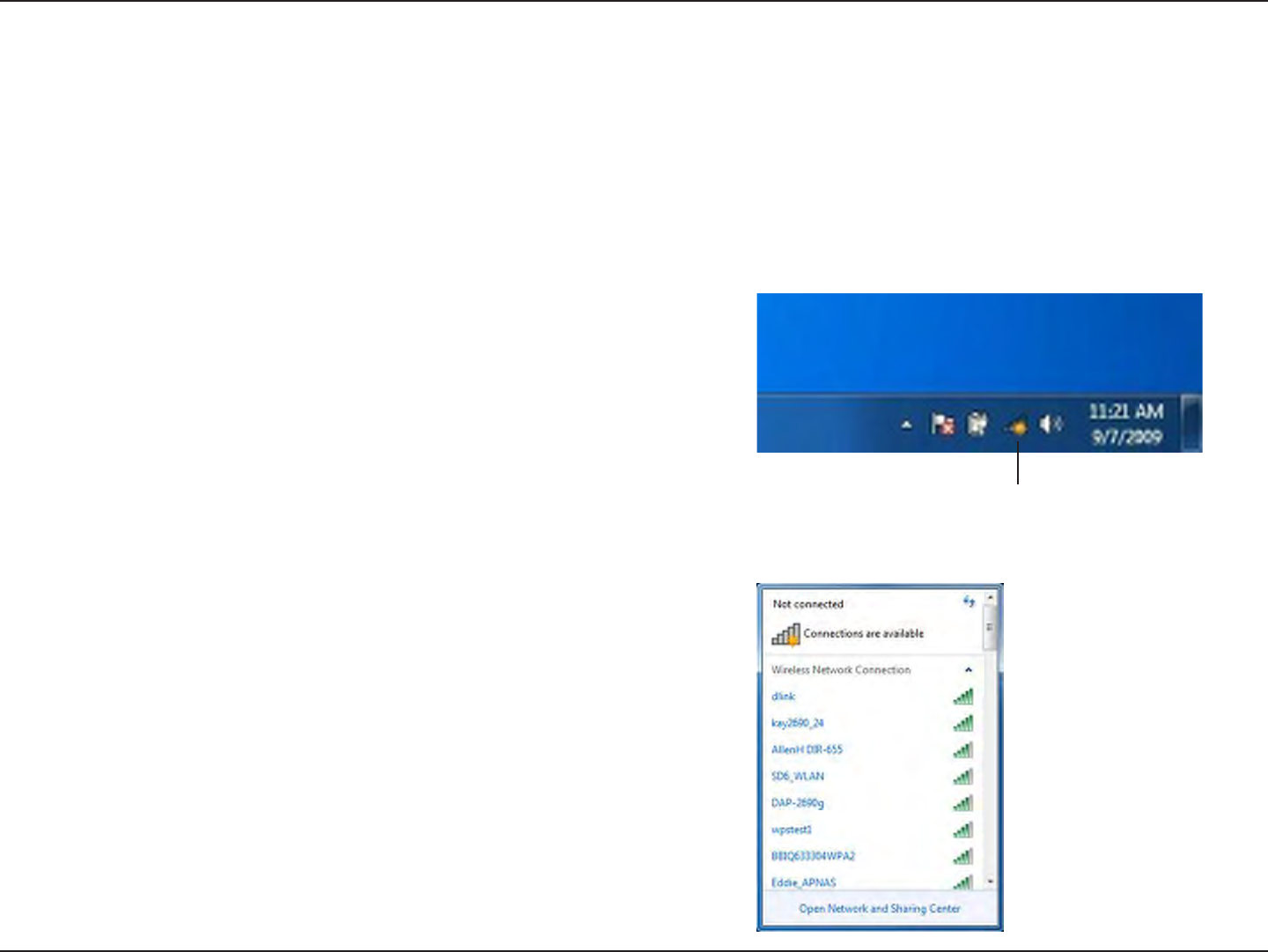
121D-Link DAP-1350 User Manual
Section 5 - Connecting to a Wireless Network
Using Windows® 7
It is recommended to enable wireless security (WPA/WPA2) on your wireless router or access point before conguring your
wireless adapter. If you are joining an existing network, you will need to know the security key or passphrase being used.
1. Click on the wireless icon in your system tray (lower-right corner).
2. The utility will display any available wireless networks in your area.
Connect to a Wireless Network
Wireless Icon
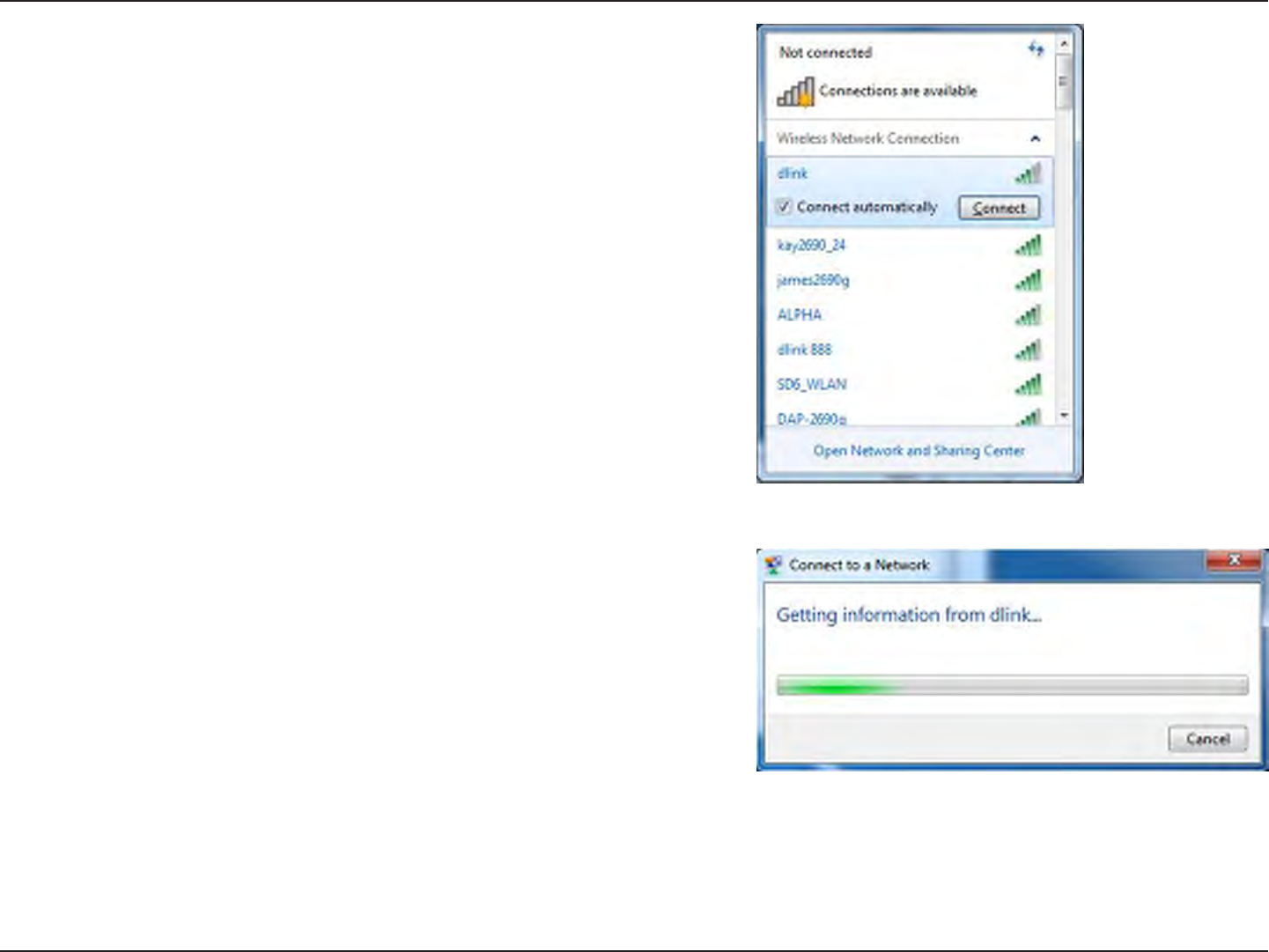
122D-Link DAP-1350 User Manual
Section 5 - Connecting to a Wireless Network
3. Highlight the wireless network (SSID) you would like to connect to
and click the Connect button.
If you get a good signal but cannot access the Internet, check your
TCP/IP settings for your wireless adapter. Refer to the Networking
Basics section in this manual for more information.
4. The following window appears while your computer tries to
connect to the router.
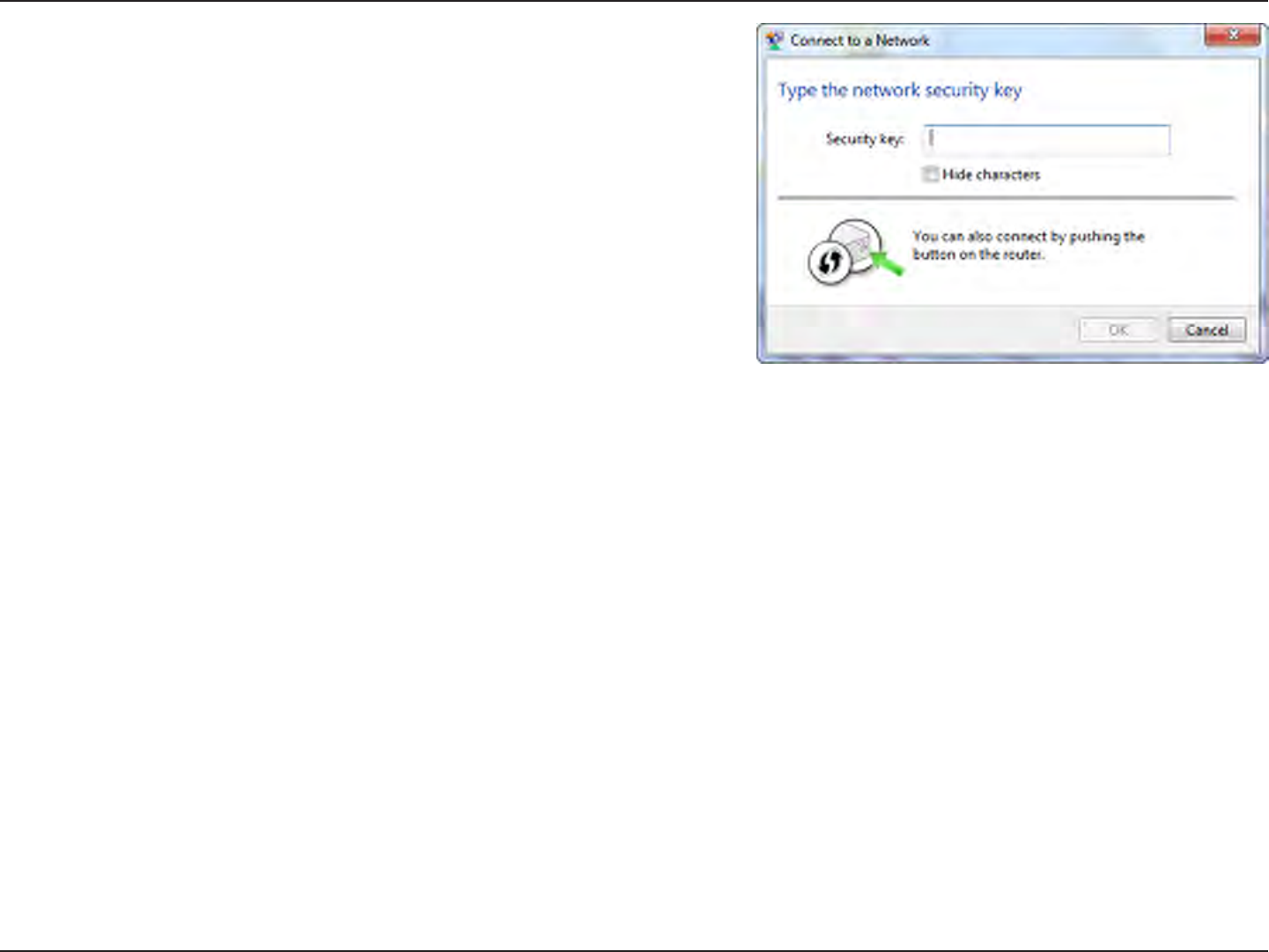
123D-Link DAP-1350 User Manual
Section 5 - Connecting to a Wireless Network
5. Enter the same security key or passphrase that is on your router
and click Connect. You can also connect by pushing the WPS
button on the router.
It may take 20-30 seconds to connect to the wireless network. If the
connection fails, please verify that the security settings are correct.
The key or passphrase must be exactly the same as on the wireless
router.
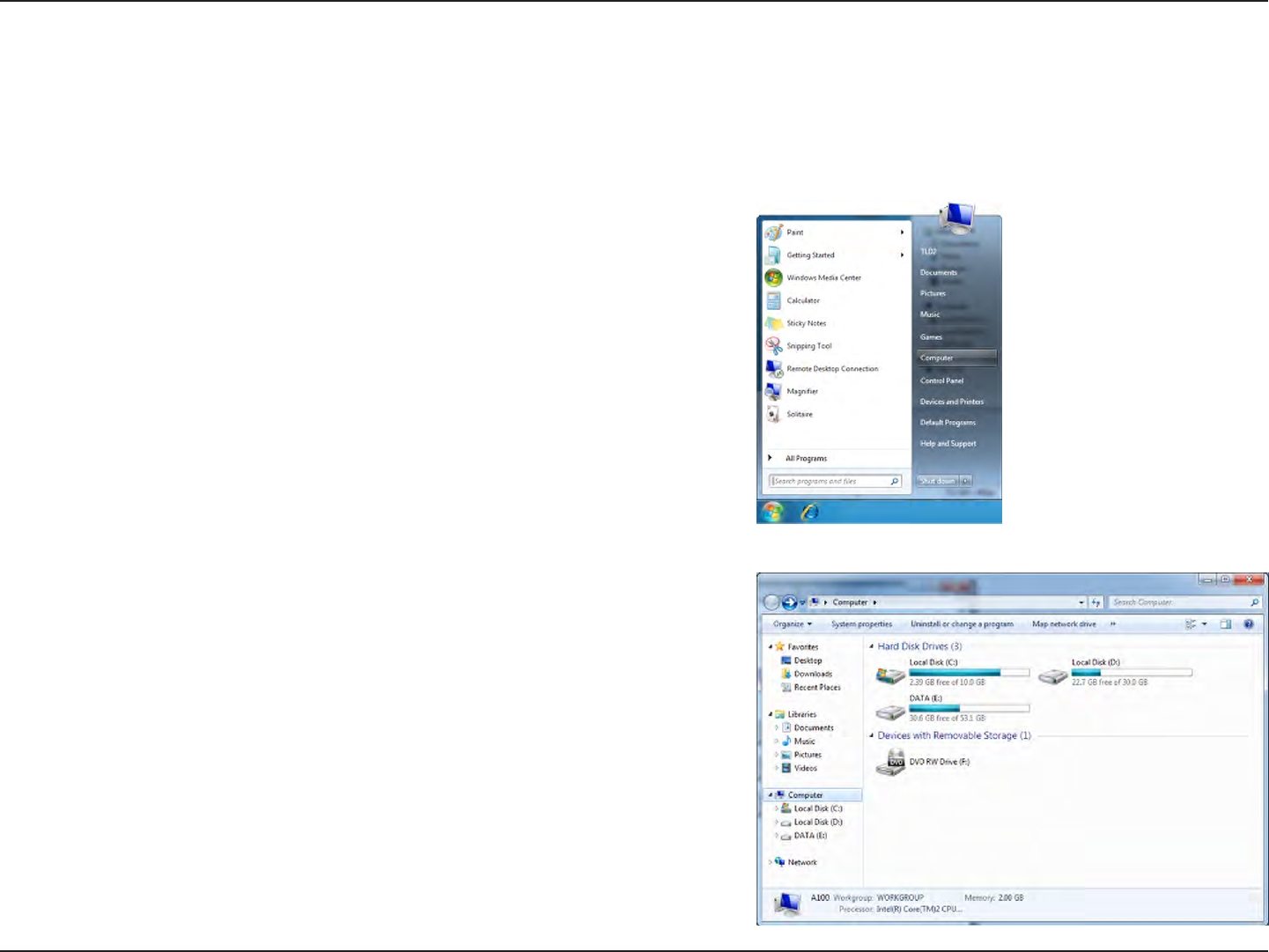
124D-Link DAP-1350 User Manual
Section 5 - Connecting to a Wireless Network
Congure WPS
The WPS feature of the DAP-1350 can be congured using Windows® 7. Carry out the following steps to use Windows® 7 to
congure the WPS feature:
1. Click the Start button and select Computer from the Start
menu.
2. Click the Network option.
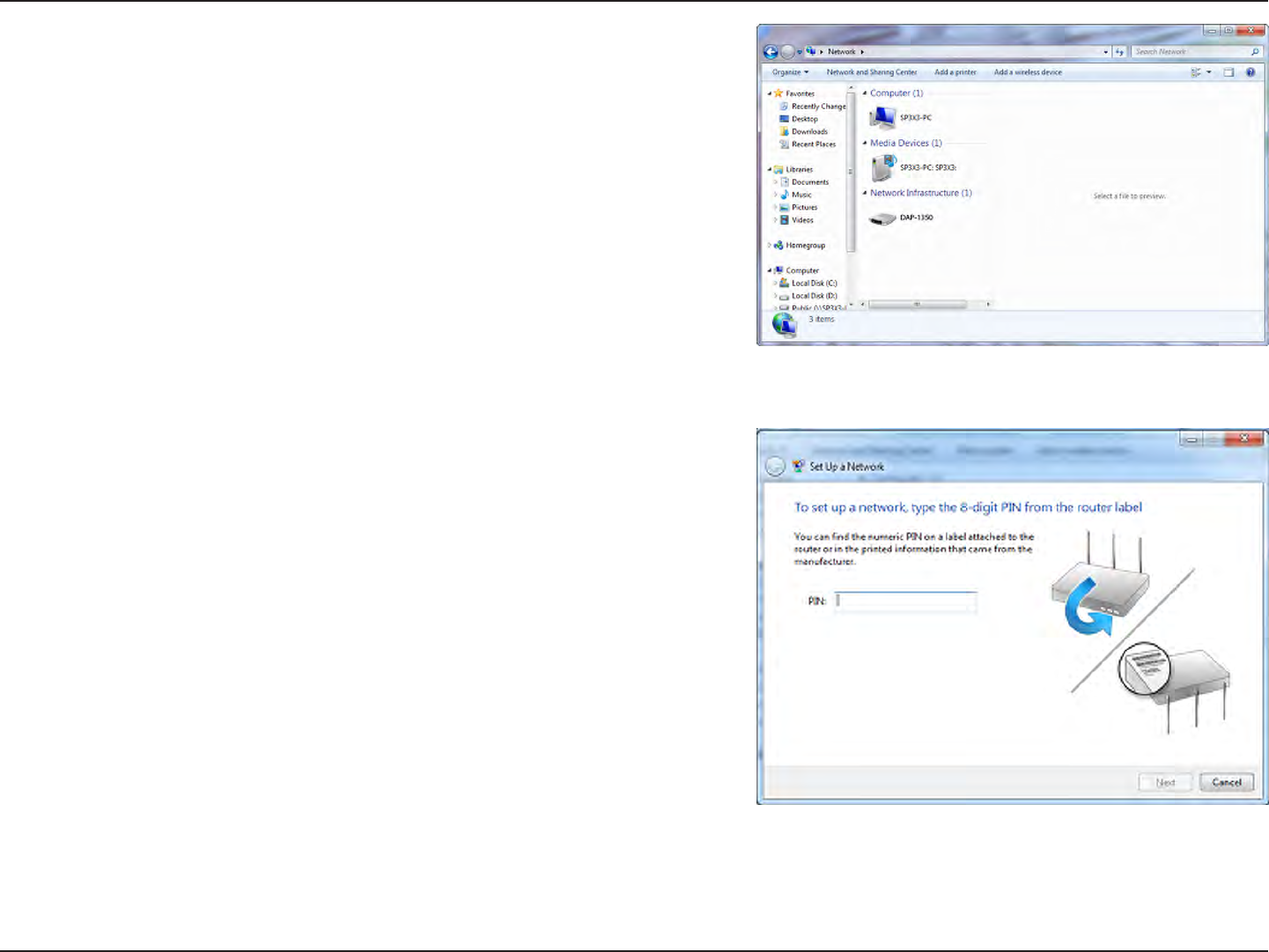
125D-Link DAP-1350 User Manual
Section 5 - Connecting to a Wireless Network
3. Double-click the DAP-1350. ®
4. Input the WPS PIN number (displayed in the WPS window on the
Router’s LCD screen or in the Setup > Wireless Setup menu in
the Router’s Web UI) and click Next.
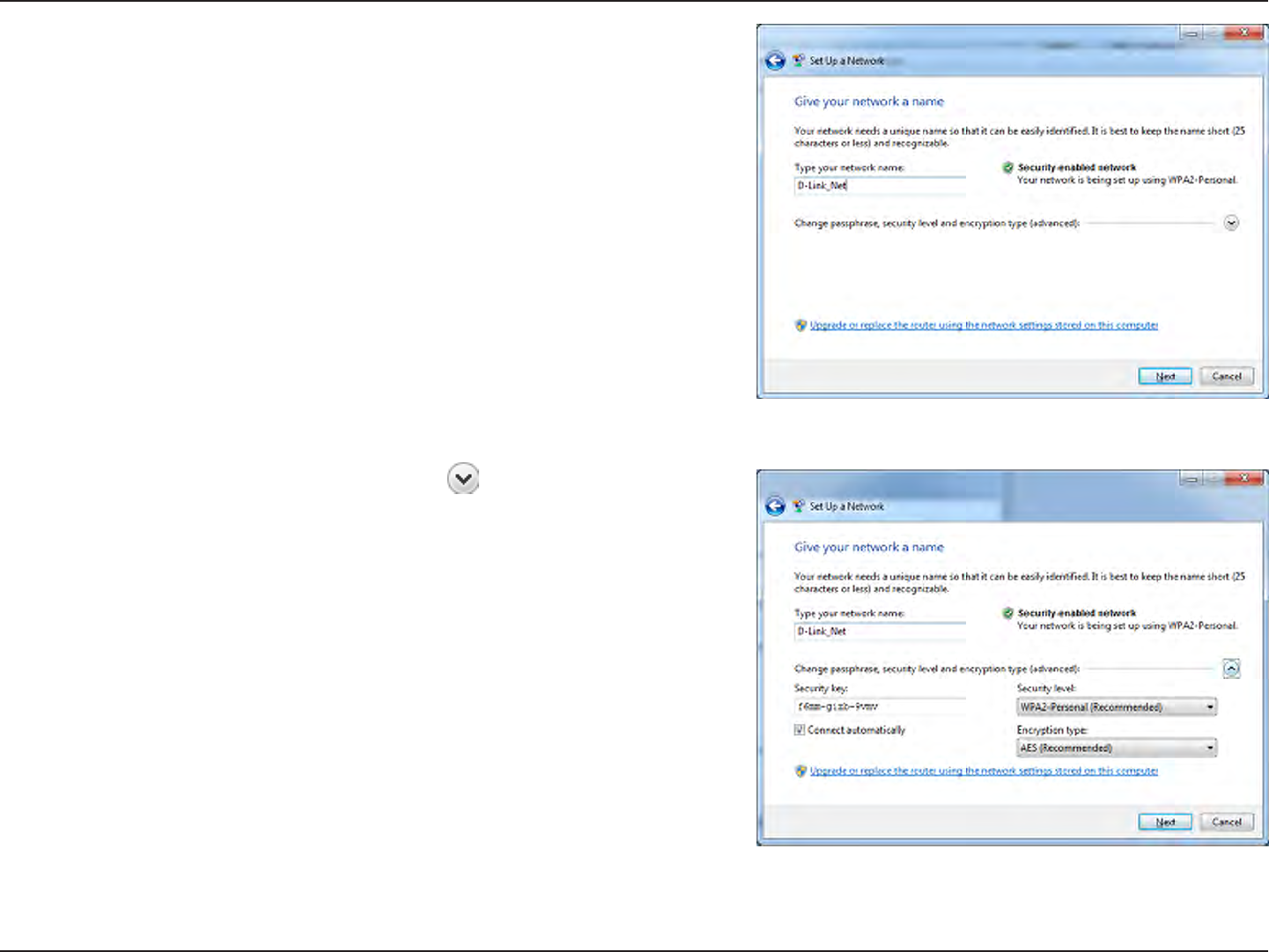
126D-Link DAP-1350 User Manual
Section 5 - Connecting to a Wireless Network
5. Type a name to identify the network.
6. To congure advanced settings, click the icon.
Click Next to continue.
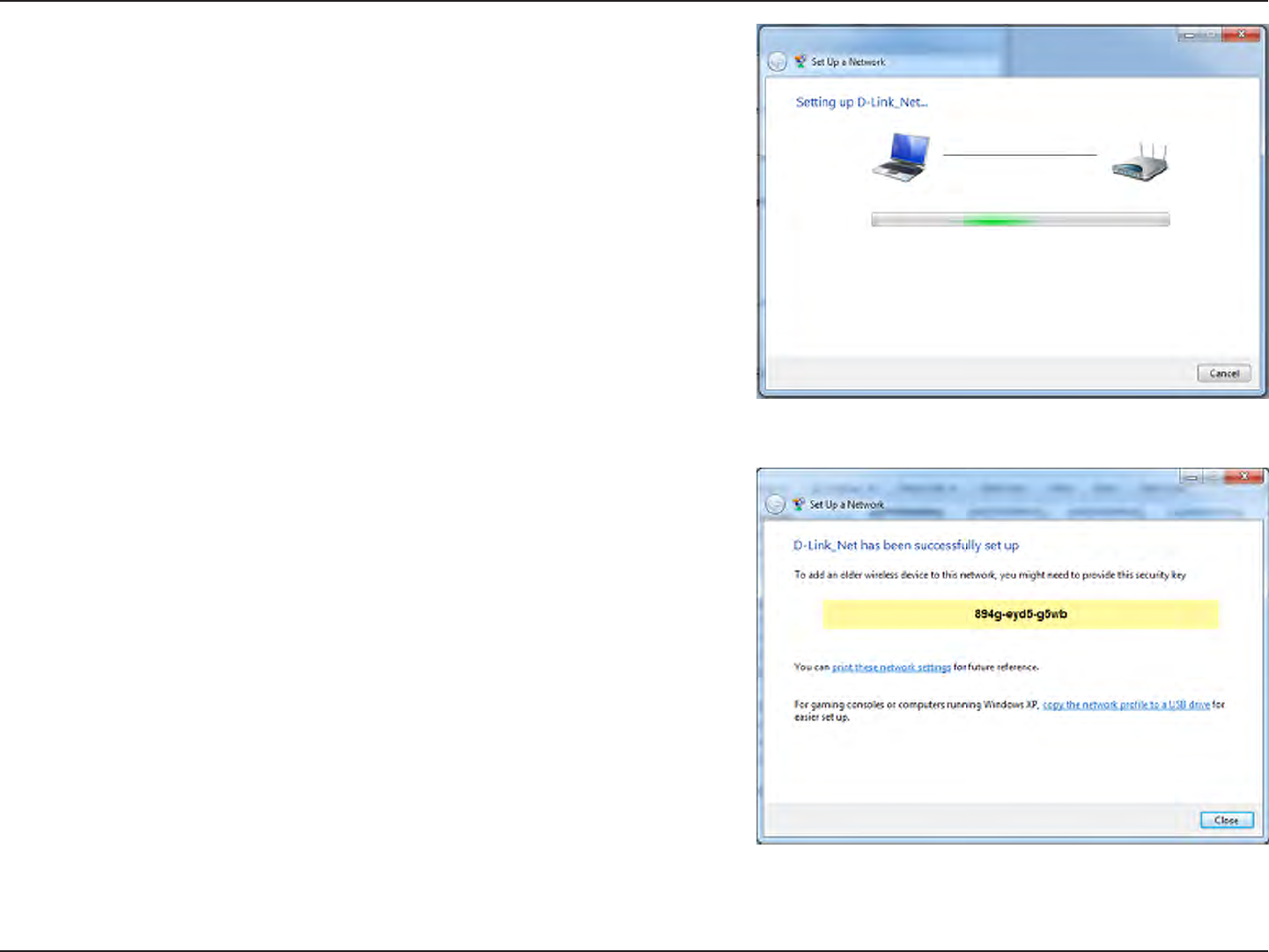
127D-Link DAP-1350 User Manual
Section 5 - Connecting to a Wireless Network
7. The following window appears while the Router is being
congured.
Wait for the conguration to complete.
8. The following window informs you that WPS on the router has
been setup successfully.
Make a note of the security key as you may need to provide this
security key if adding an older wireless device to the network in
the future.
9. Click Close to complete WPS setup.
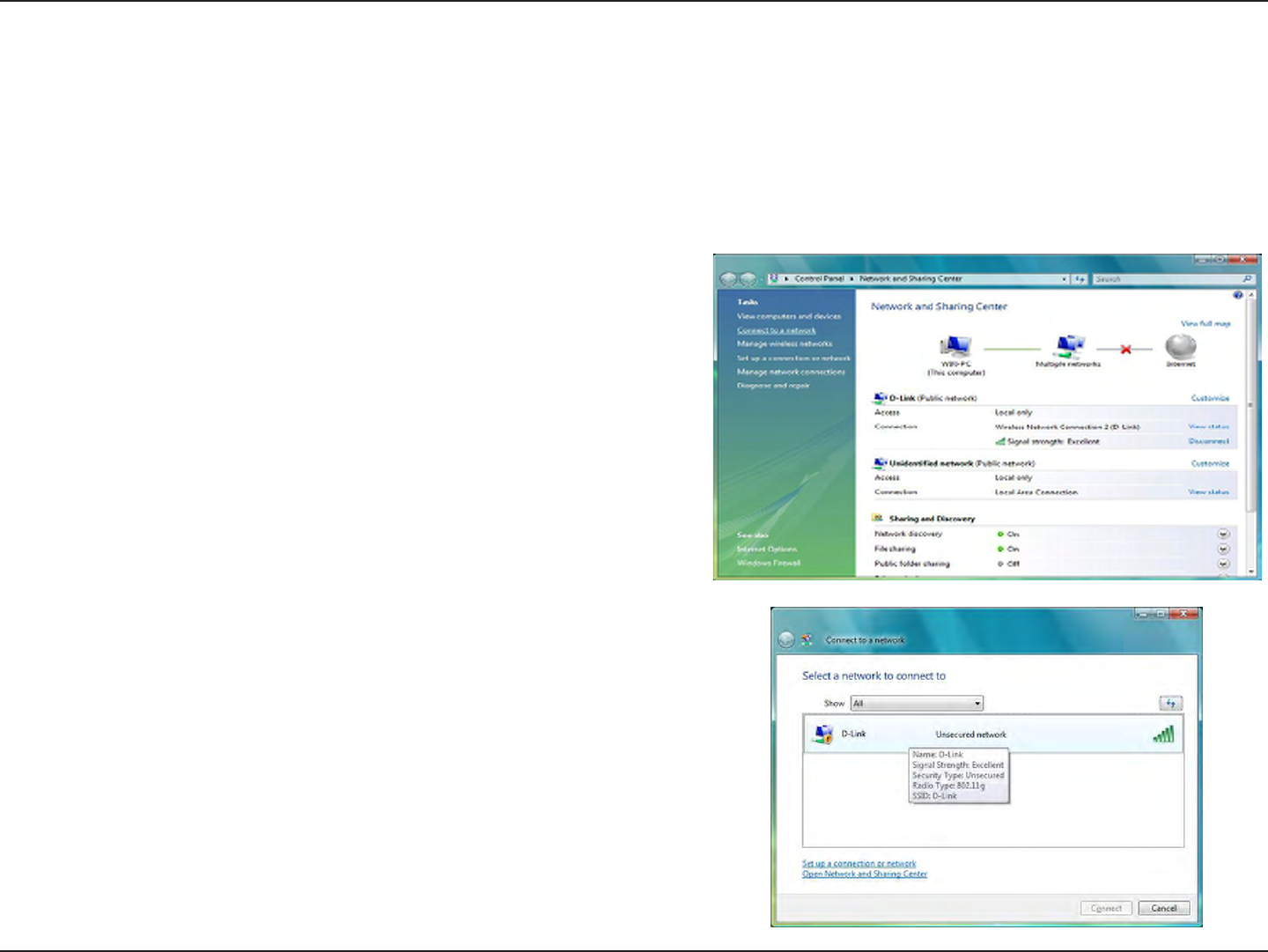
128D-Link DAP-1350 User Manual
Section 5 - Connecting to a Wireless Network
Using Windows Vista®
Windows Vista® users may use the convenient, built-in wireless utility. Follow these instructions:
From the Start menu, go to Control Panel, and then click on
Network and Sharing Center.
The utility will display any available wireless networks in your
area. Click on a network (displayed using the SSID) under Select a
network to connect to and then click the Connect button.
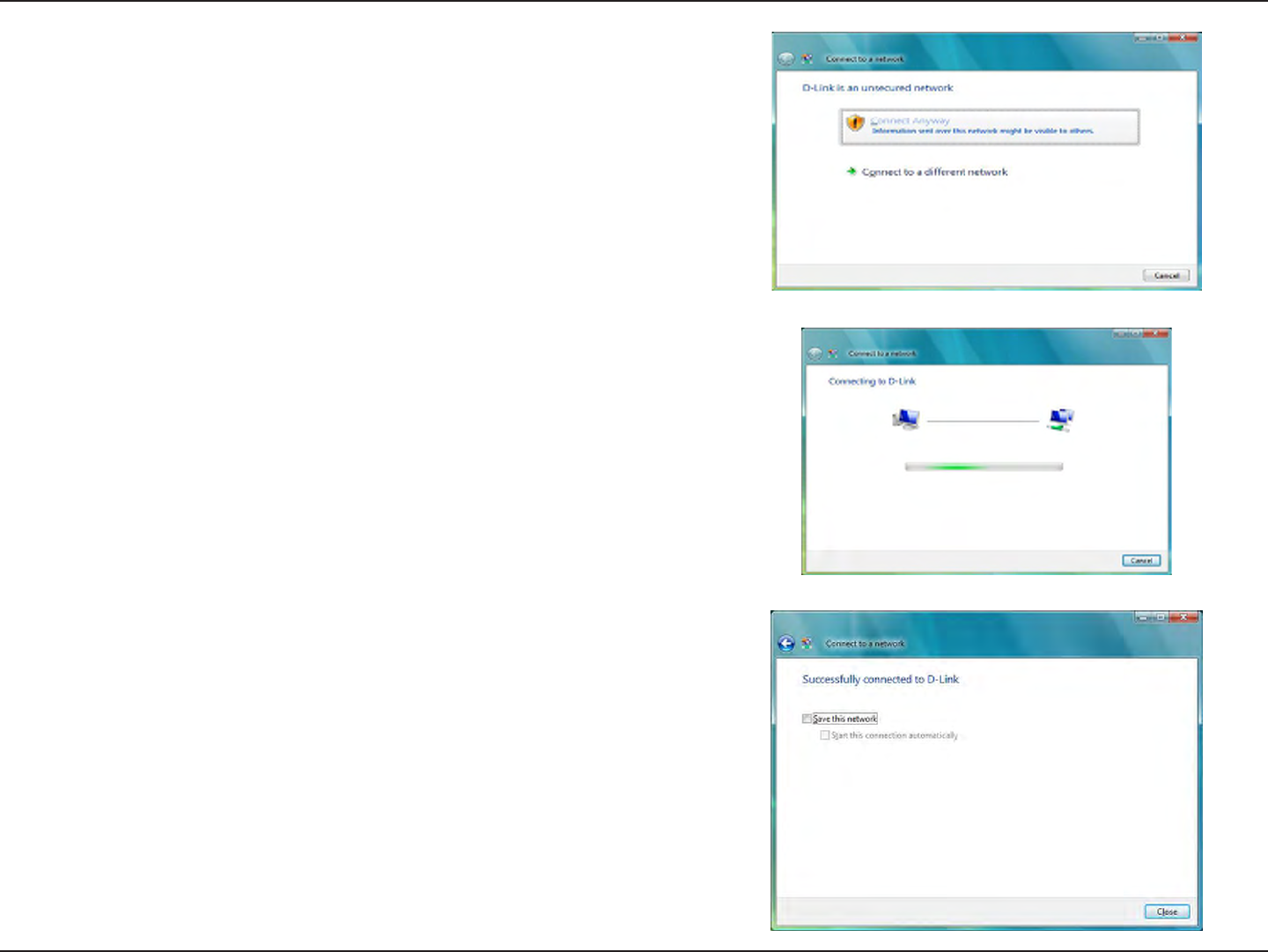
129D-Link DAP-1350 User Manual
Section 5 - Connecting to a Wireless Network
Click Connect Anyway to continue.
The utility will display the following window to indicate a
connection is being made.
The nal window indicates the establishment of a successful
connection.
The next two pages display the windows used to connect to either
a WEP or a WPA-PSK wireless network.
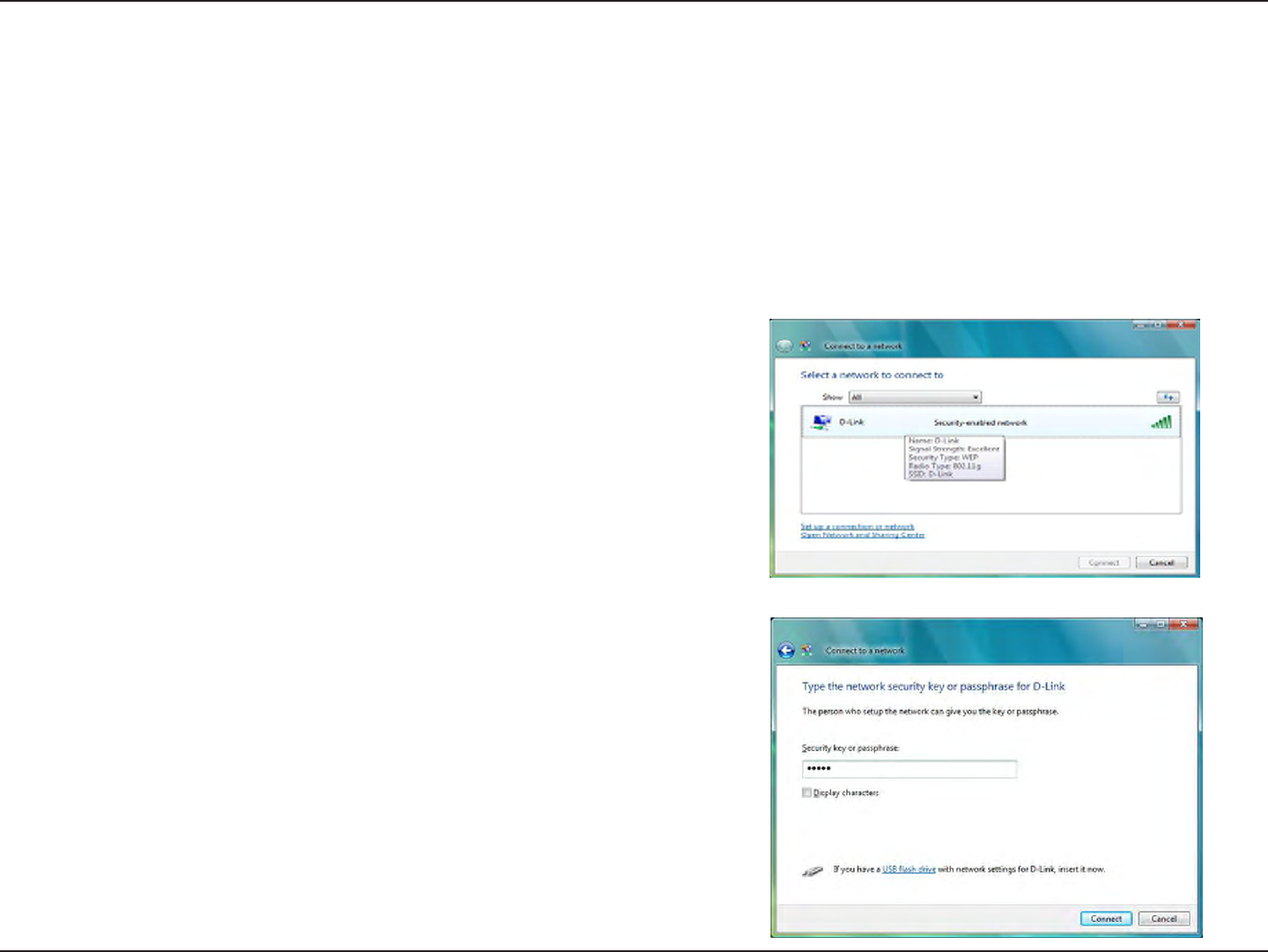
130D-Link DAP-1350 User Manual
Section 5 - Connecting to a Wireless Network
Click on a network (displayed using the SSID) using WEP under
Select a network to connect to and then click the Connect
button.
Enter the appropriate security key or passphrase in the eld
provided and then click the Connect button.
Congure WEP
It is recommended to enable WEP on your wireless bridge or access point before conguring your wireless adapter. If you are
joining an existing network, you will need to know the WEP key being used.
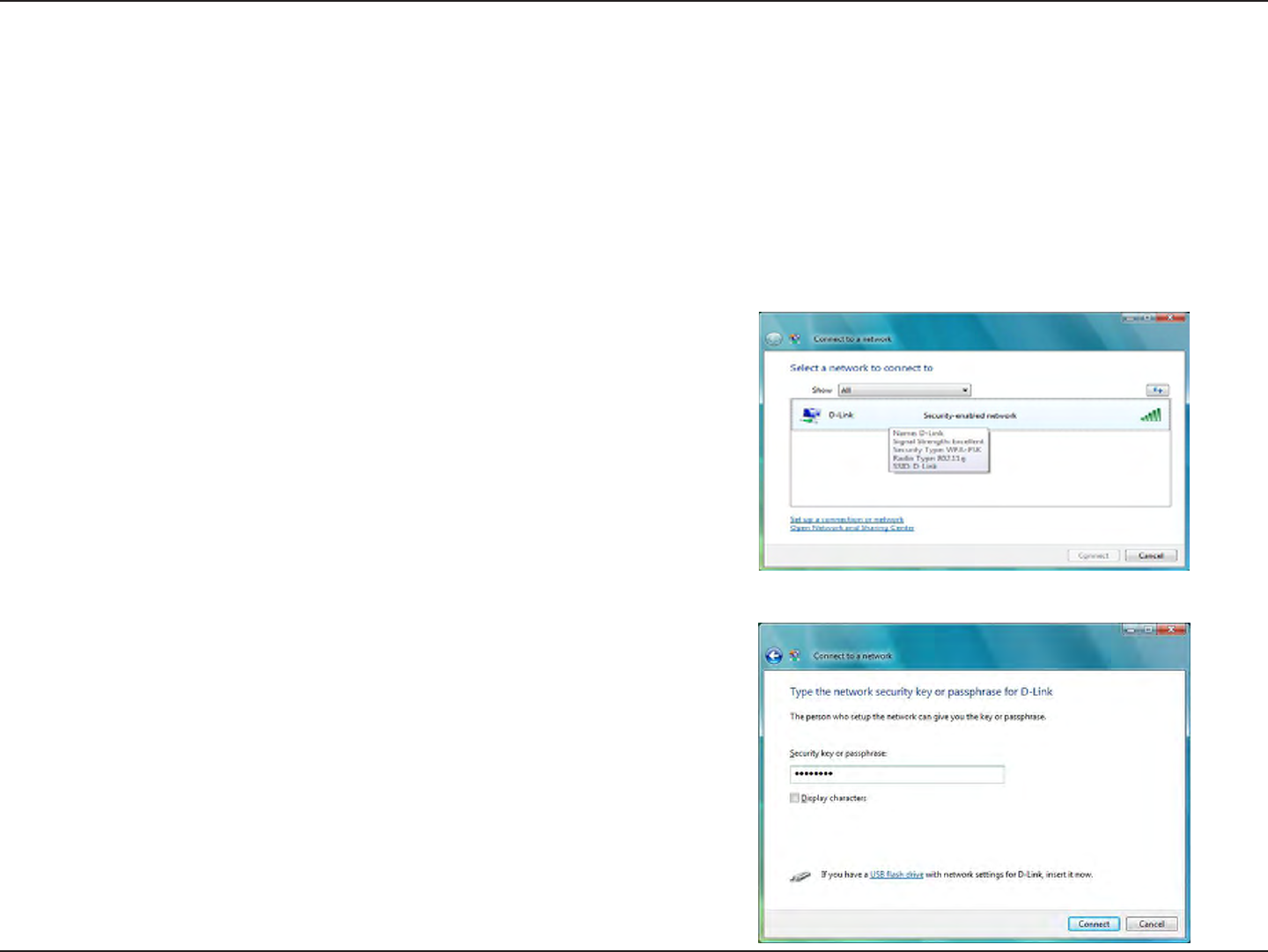
131D-Link DAP-1350 User Manual
Section 5 - Connecting to a Wireless Network
Click on a network (displayed using the SSID) using WPA-PSK
under Select a network to connect to and then click the Connect
button.
Enter the appropriate security key or passphrase in the eld provided
and then click the Connect button.
Congure WPA-PSK
It is recommended to enable WEP on your wireless bridge or access point before conguring your wireless adapter. If you are
joining an existing network, you will need to know the WEP key being used.
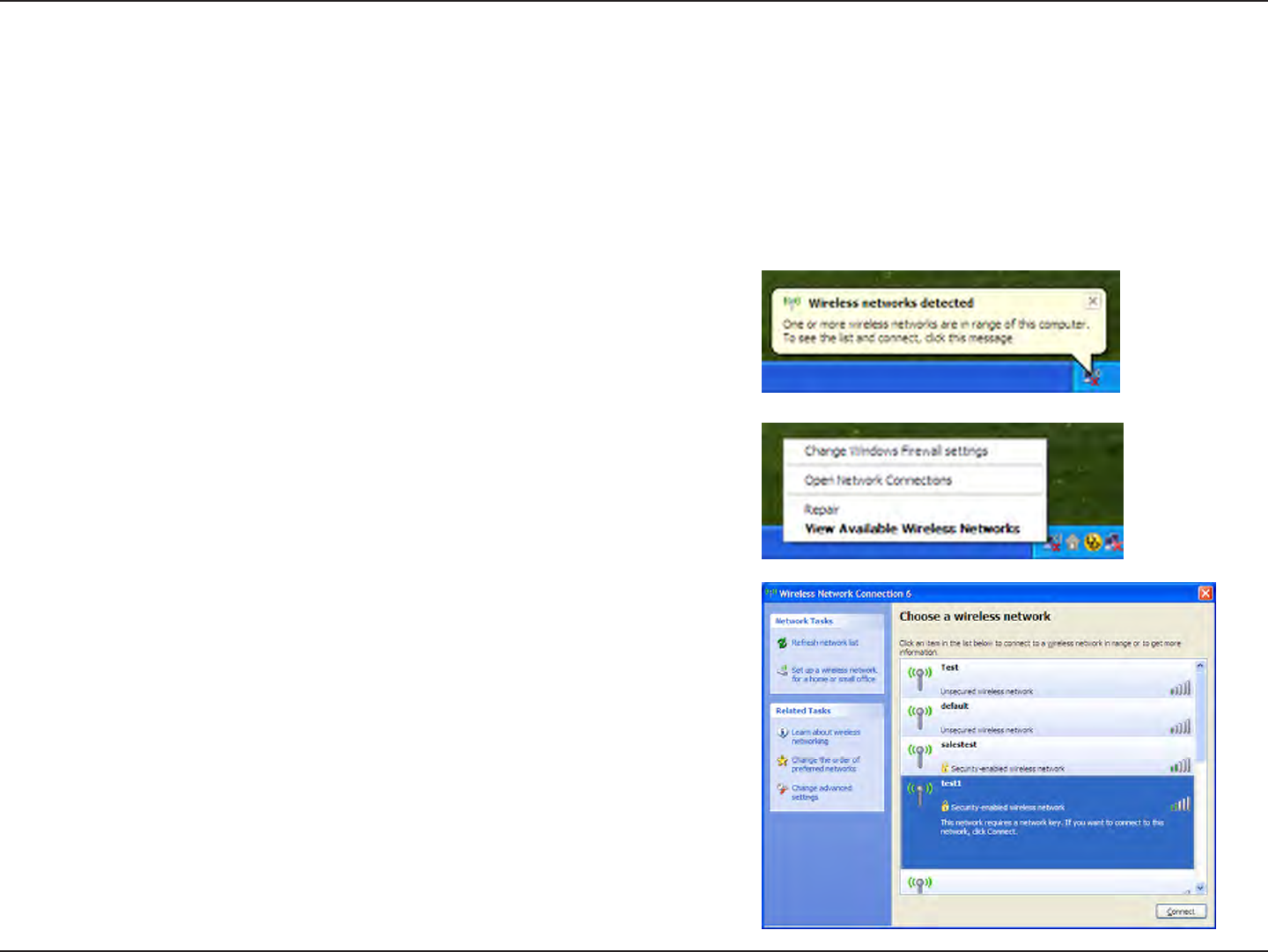
132D-Link DAP-1350 User Manual
Section 5 - Connecting to a Wireless Network
Using Windows® XP
Windows® XP users may use the built-in wireless utility (Zero Conguration Utility). The following instructions are for Service
Pack 2 users. If you are using another company’s utility or Windows® 2000, please refer to the user manual of your wireless
adapter for help with connecting to a wireless network. Most utilities will have a “site survey” option similar to the Windows®
XP utility as seen below.
Right-click on the wireless computer icon in your system tray
(lower-right corner next to the time). Select View Available
Wireless Networks.
If you receive the Wireless Networks Detected bubble, click on
the center of the bubble to access the utility.
or
The utility will display any available wireless networks in your area.
Click on a network (displayed using the SSID) and click the Connect
button.
If you get a good signal, but cannot access the Internet, check you
TCP/IP settings for your wireless adapter. Refer to the Networking
Basics section in this manual for more information.
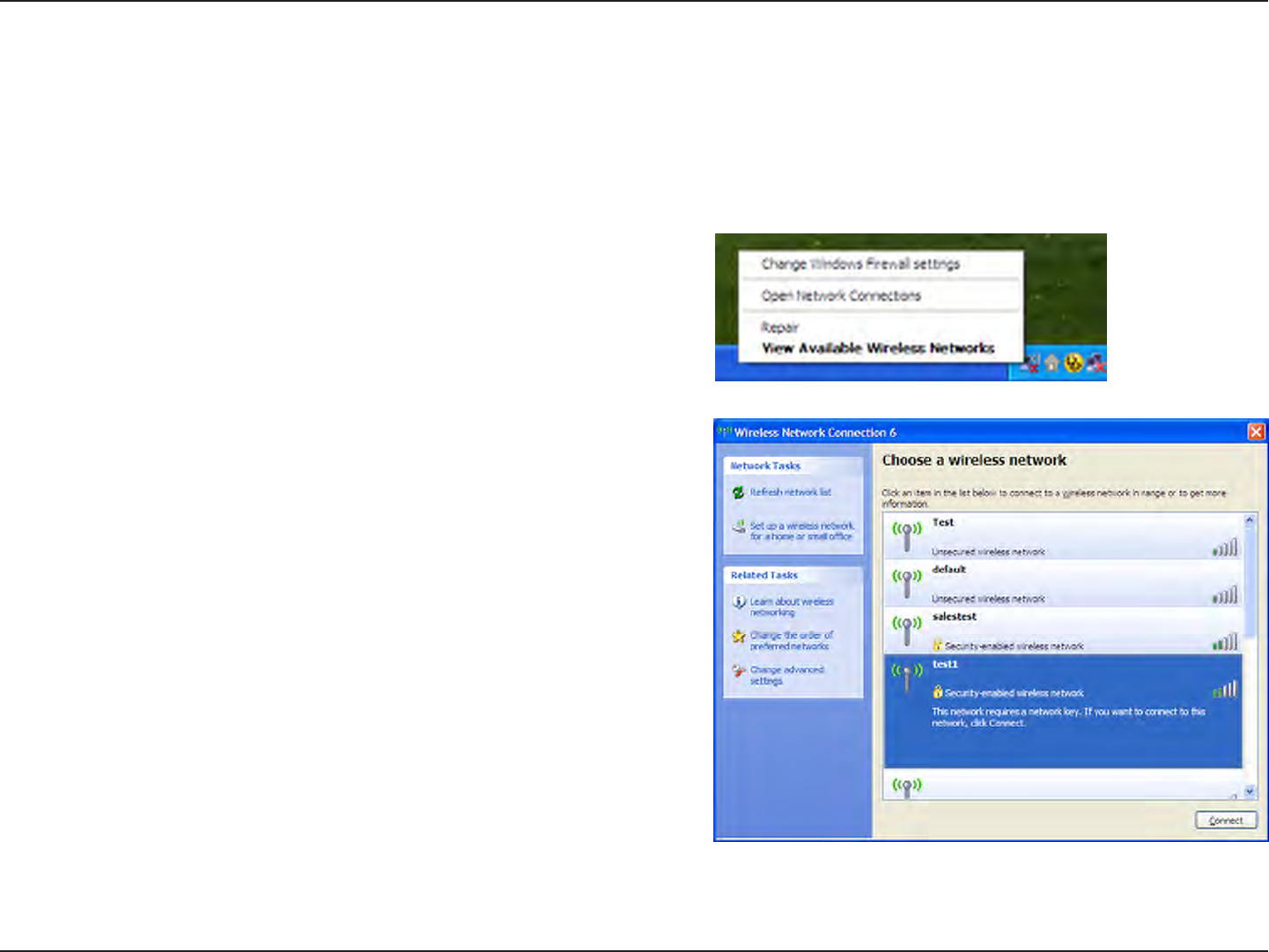
133D-Link DAP-1350 User Manual
Section 5 - Connecting to a Wireless Network
Congure WEP
It is recommended to enable WEP on your wireless bridge or access point before conguring your wireless adapter. If you are
joining an existing network, you will need to know the WEP key being used.
2. Highlight the wireless network (SSID) you would like to
connect to and click Connect.
1. Open the Windows® XP Wireless Utility by right-clicking
on the wireless computer icon in your system tray
(lower-right corner of screen). Select View Available
Wireless Networks.
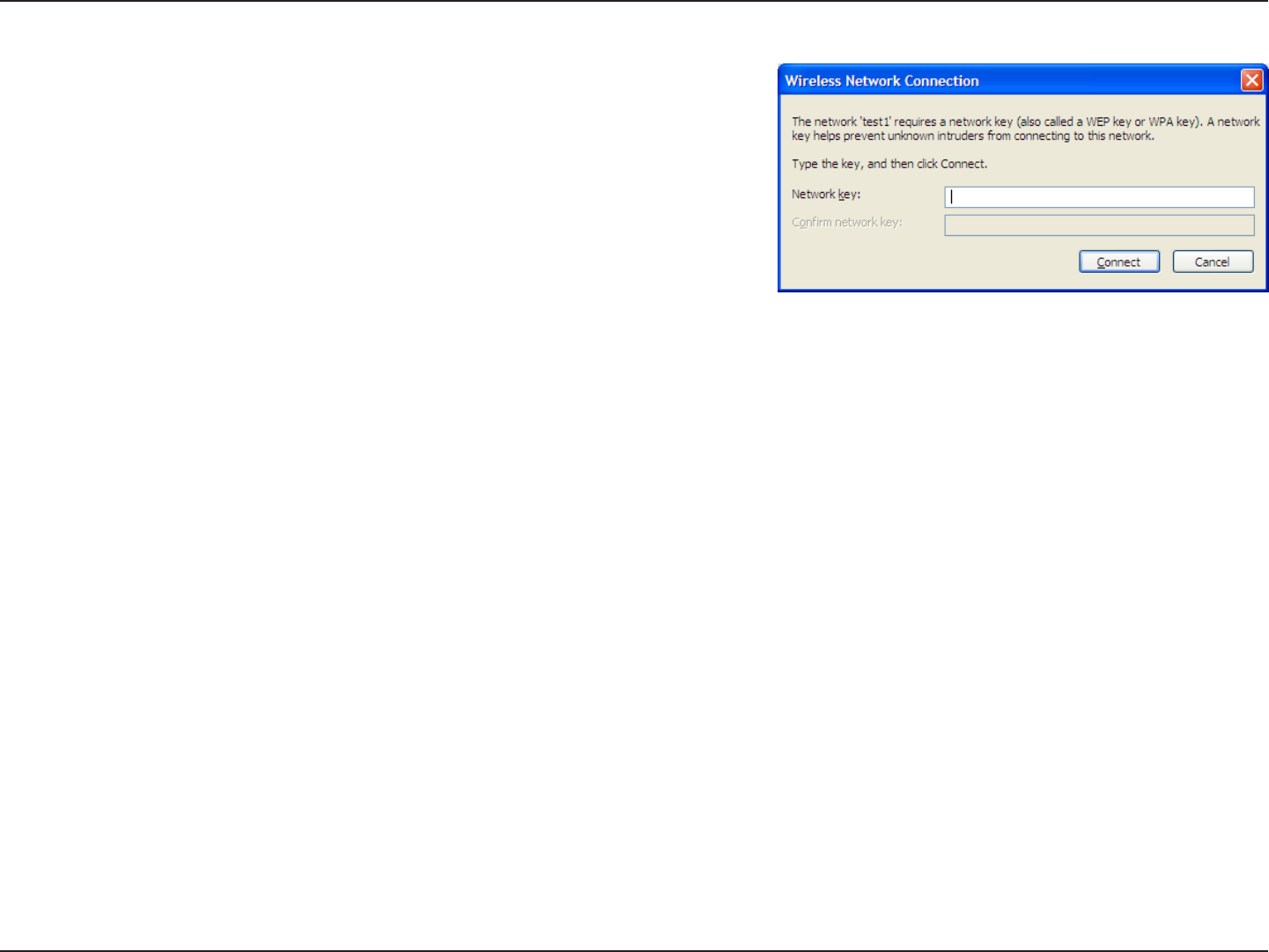
134D-Link DAP-1350 User Manual
Section 5 - Connecting to a Wireless Network
3. The Wireless Network Connection box will appear. Enter the same WEP
key that is on your access point and click Connect.
It may take 20-30 seconds to connect to the wireless network. If the
connection fails, please verify that the WEP settings are correct. The WEP
key must be exactly the same as on the wireless access point.
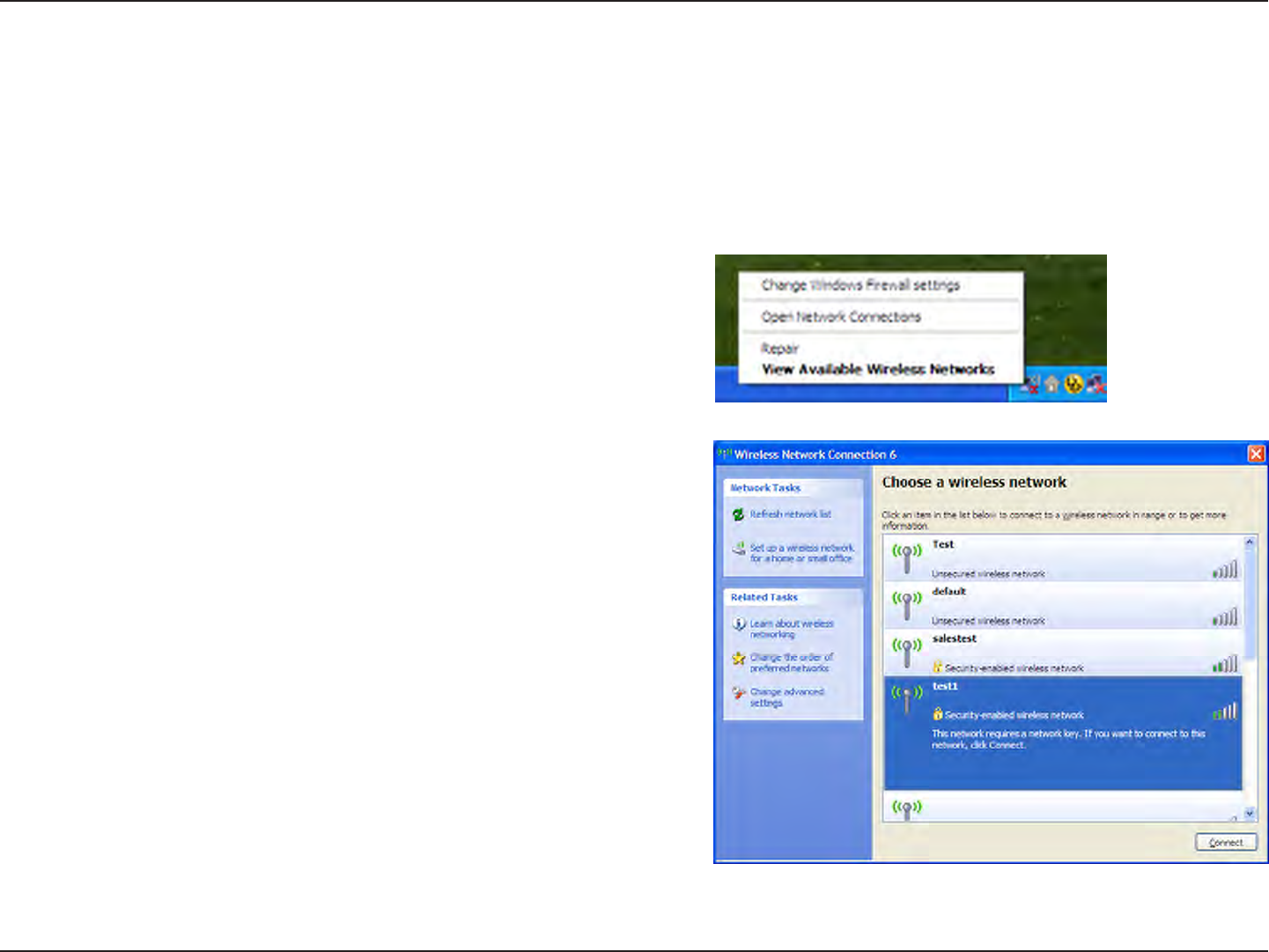
135D-Link DAP-1350 User Manual
Section 5 - Connecting to a Wireless Network
Congure WPA-PSK
It is recommended to enable WEP on your wireless bridge or access point before conguring your wireless adapter. If you are
joining an existing network, you will need to know the WEP key being used.
2. Highlight the wireless network (SSID) you would like to connect
to and click Connect.
1. Open the Windows® XP Wireless Utility by right-clicking
on the wireless computer icon in your system tray
(lower-right corner of screen). Select View Available Wireless
Networks.
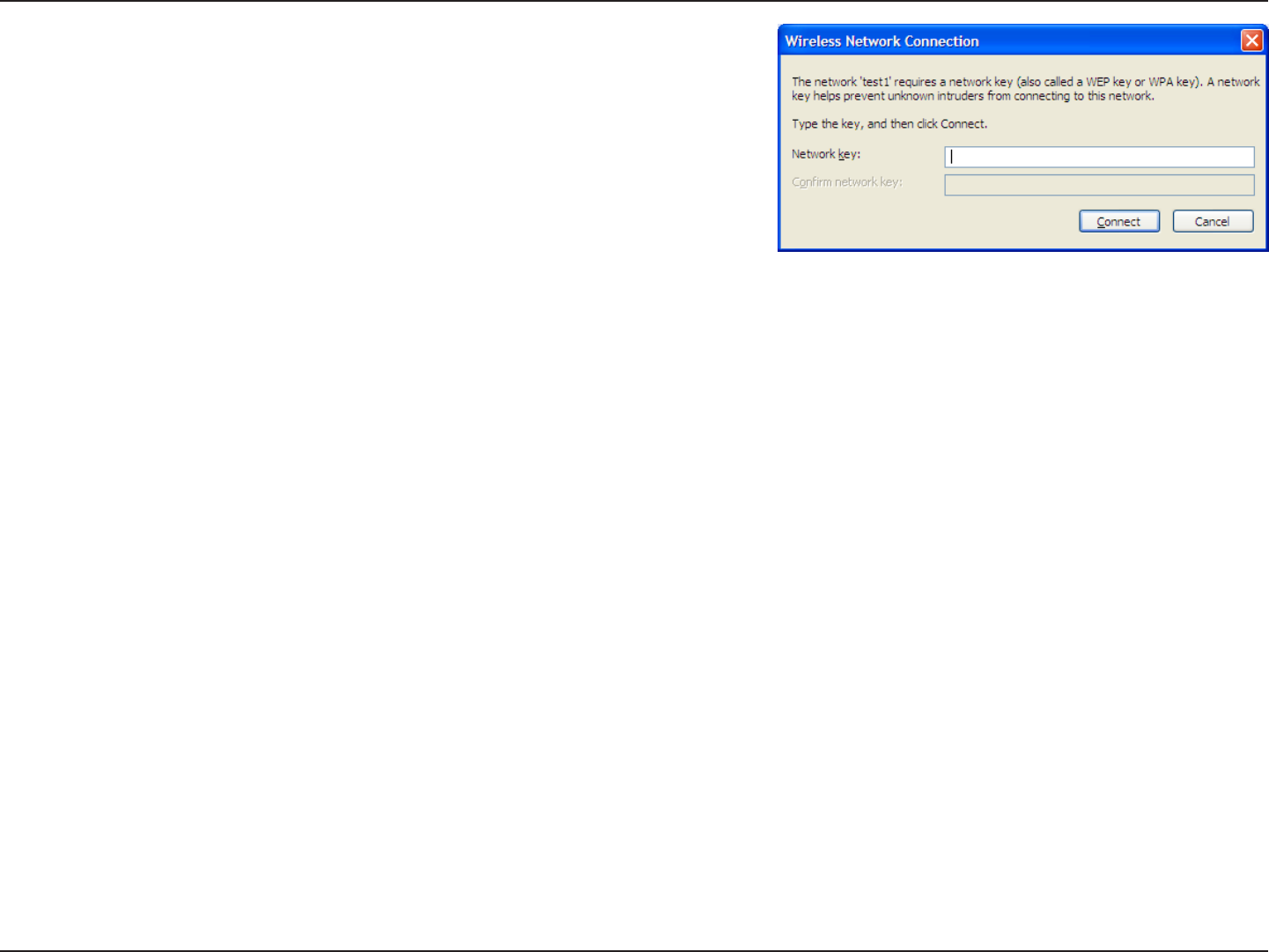
136D-Link DAP-1350 User Manual
Section 5 - Connecting to a Wireless Network
3. The Wireless Network Connection box will appear. Enter the WPA-PSK
passphrase and click Connect.
It may take 20-30 seconds to connect to the wireless network. If the
connection fails, please verify that the WPA-PSK settings are correct. The
WPA-PSK passphrase must be exactly the same as on the wireless access
point.

137D-Link DAP-1350 User Manual
Section 6 - Troubleshooting
Troubleshooting
This chapter provides solutions to problems that can occur during the installation and operation of the DAP-1350. Read the
following descriptions if you are having problems. (The examples below are illustrated in Windows® XP. If you have a dierent
operating system, the screenshots on your computer will look similar to the following examples.)
1. Why can’t I access the web-based conguration utility?
When entering the IP address of the D-Link access point (192.168.0.50 for example), you are not connecting to a website on
the Internet or have to be connected to the Internet. The device has the utility built-in to a ROM chip in the device itself. Your
computer must be on the same IP subnet to connect to the web-based utility.
• Make sure you have an updated Java-enabled web browser. We recommend the following:
- Microsoft Internet Explorer® 6.0 and higher
- Mozilla Firefox 3.0 and higher
- Google™ Chrome 2.0 and higher
- Apple Safari 3.0 and higher
• Verify physical connectivity by checking for solid link lights on the device. If you do not get a solid link light, try
using a dierent cable or connect to a dierent port on the device if possible. If the computer is turned o, the
link light may not be on.
• Disable any internet security software running on the computer. Software rewalls such as Zone Alarm, Black
Ice, Sygate, Norton Personal Firewall, and Windows® XP rewall may block access to the conguration pages.
Check the help les included with your rewall software for more information on disabling or conguring it.

138D-Link DAP-1350 User Manual
Section 6 - Troubleshooting
• Congure your Internet settings:
• Go to Start > Settings > Control Panel. Double-click the Internet Options Icon. From the Security tab, click
the button to restore the settings to their defaults.
• Click the Connection tab and set the dial-up option to Never Dial a Connection. Click the LAN Settings button.
Make sure nothing is checked. Click OK.
• Go to the Advanced tab and click the button to restore these settings to their defaults. Click OK three times.
• Close your web browser (if open) and open it.
• Access the web management. Open your web browser and enter the IP address of your D-Link access point in the address
bar. This should open the login page for your the web management.
• If you still cannot access the conguration, unplug the power to the access point for 10 seconds and plug back in. Wait about
30 seconds and try accessing the conguration. If you have multiple computers, try connecting using a dierent computer.
2. What can I do if I forgot my password?
If you forgot your password, you must reset your access point. Unfortunately this process will change all your settings back to
the factory defaults.
To reset the access point, locate the reset button (hole) on the rear panel of the unit. With the access point powered on, use a
paperclip to hold the button down for 5 seconds. Release the button and the access point will go through its reboot process.
Wait about 30 seconds to access the access point. The default IP address is 192.168.0.50. When logging in, the username is
admin and leave the password box empty.
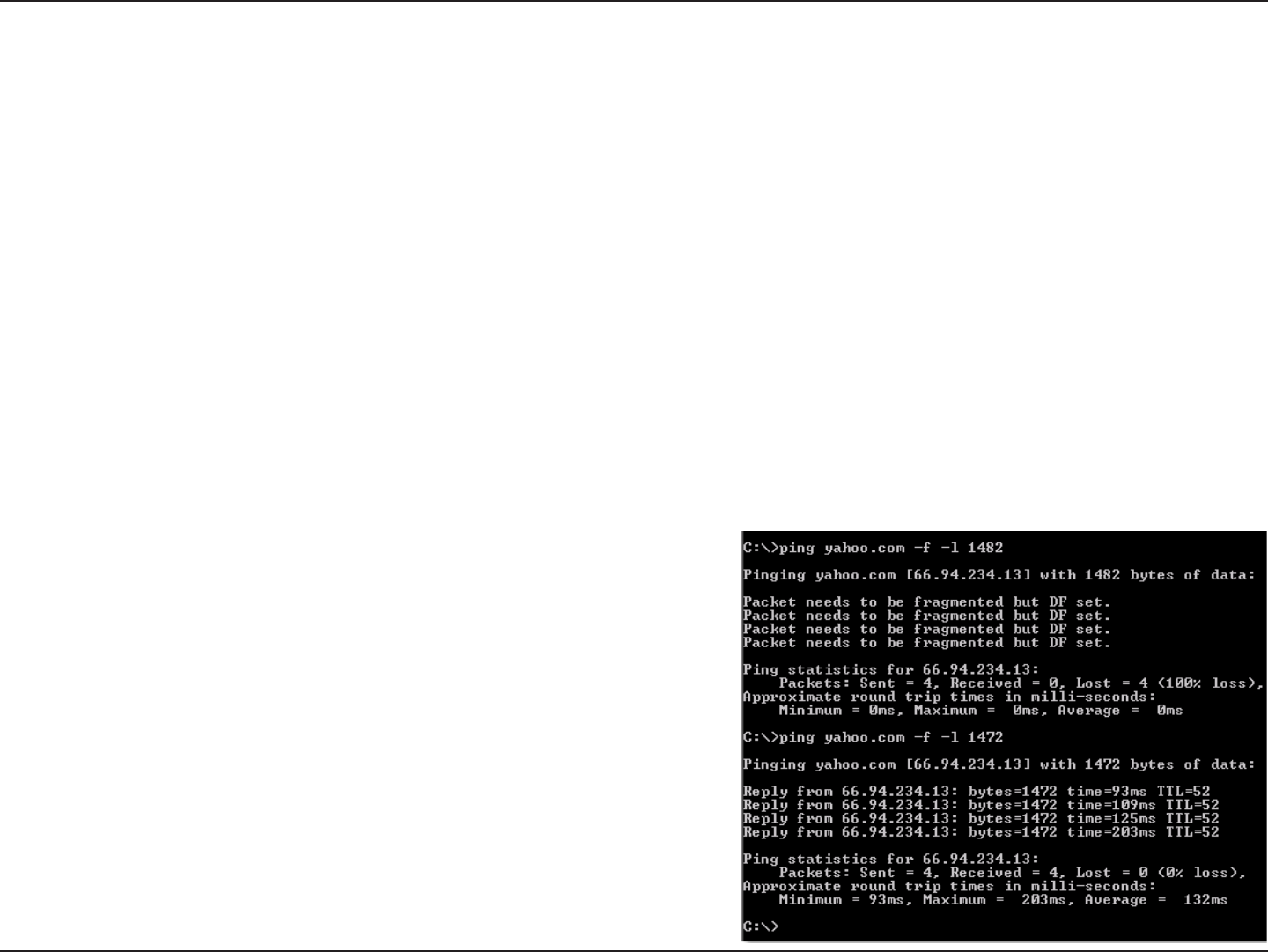
139D-Link DAP-1350 User Manual
Section 6 - Troubleshooting
3. Why can’t I connect to certain sites or send and receive emails when connecting through my pocket router (router
mode only)?
If you are having a problem sending or receiving email, or connecting to secure sites such as eBay, banking sites, and Hotmail,
we suggest lowering the MTU in increments of ten (Ex. 1492, 1482, 1472, etc).
Note: AOL DSL+ users must use MTU of 1400.
To nd the proper MTU Size, you’ll have to do a special ping of the destination you’re trying to go to. A destination
could be another computer, or a URL.
• Click on Start and then click Run.
• Windows® 95, 98, and Me users type in command (Windows® NT, 2000, XP, Vista®, and 7 users type in cmd) and
press Enter (or click OK).
• Once the window opens, you’ll need to do a special ping. Use the following syntax:
ping [url] [-f] [-l] [MTU value]
Example: ping yahoo.com -f -l 1472

140D-Link DAP-1350 User Manual
Section 6 - Troubleshooting
You should start at 1472 and work your way down by 10 each time. Once you get a reply, go up by 2 until you get a
fragmented packet. Take that value and add 28 to the value to account for the various TCP/IP headers. For example, lets say
that 1452 was the proper value, the actual MTU size would be 1480, which is the optimum for the network we’re working with
(1452+28=1480).
Once you nd your MTU, you can now congure your access point with the proper MTU size.
To change the MTU rate on your access point follow the steps below:
• Open your browser, enter the IP address of your access point (192.168.0.50) and click OK.
• Enter your username (admin) and password (blank by default). Click OK to enter the web conguration page
for the device.
• Click on Setup and then click Manual Congure.
• To change the MTU enter the number in the MTU eld and click Save Settings to save your settings.
• Test your email. If changing the MTU does not resolve the problem, continue changing the MTU in increments
of ten.

141D-Link DAP-1350 User Manual
Appendix A - Wireless Basics
D-Link wireless products are based on industry standards to provide easy-to-use and compatible high-speed wireless
connectivity within your home, business or public access wireless networks. Strictly adhering to the IEEE standard, the D-Link
wireless family of products will allow you to securely access the data you want, when and where you want it. You will be able
to enjoy the freedom that wireless networking delivers.
A wireless local area network (WLAN) is a cellular computer network that transmits and receives data with radio signals instead of
wires. Wireless LANs are used increasingly in both home and oce environments, and public areas such as airports, coee shops
and universities. Innovative ways to utilize WLAN technology are helping people to work and communicate more eciently.
Increased mobility and the absence of cabling and other xed infrastructure have proven to be benecial for many users.
Wireless users can use the same applications they use on a wired network. Wireless adapter cards used on laptop and desktop
systems support the same protocols as Ethernet adapter cards.
Under many circumstances, it may be desirable for mobile network devices to link to a conventional Ethernet LAN in order to
use servers, printers or an Internet connection supplied through the wired LAN. A Wireless Access point is a device used to
provide this link.
Wireless Basics

142D-Link DAP-1350 User Manual
Appendix A - Wireless Basics
What is Wireless?
Wireless or Wi-Fi technology is another way of connecting your computer to the network without using wires. Wi-Fi uses radio
frequency to connect wirelessly, so you have the freedom to connect computers anywhere in your home or oce.
D-Link is the worldwide leader and award winning designer, developer, and manufacturer of networking products. D-Link
delivers the performance you need at a price you can aord. D-Link has all the products you need to build your network.
How does wireless work?
Wireless works similar to how cordless phone work, through radio signals to transmit data from one point A to point B. But
wireless technology has restrictions as to how you can access the network. You must be within the wireless network range area
to be able to connect your computer. There are two dierent types of wireless networks Wireless Local Area Network (WLAN),
and Wireless Personal Area Network (WPAN).
Wireless Local Area Network (WLAN)
In a wireless local area network, a device called an Access Point (AP) connects computers to the network. The access point has
a small antenna attached to it, which allows it to transmit data back and forth over radio signals. With an indoor access point
as seen in the picture, the signal can travel up to 300 feet. With an outdoor access point the signal can reach out up to 30 miles
to serve places like manufacturing plants, industrial locations, college and high school campuses, airports, golf courses, and
many other outdoor venues.

143D-Link DAP-1350 User Manual
Appendix A - Wireless Basics
Wireless Personal Area Network (WPAN)
Bluetooth is the industry standard wireless technology used for WPAN. Bluetooth devices in WPAN operate in a range up to
30 feet away.
Compared to WLAN the speed and wireless operation range are both less than WLAN, but in return it doesn’t use nearly as
much power which makes it ideal for personal devices, such as mobile phones, PDAs, headphones, laptops, speakers, and other
devices that operate on batteries.
Who uses wireless?
Wireless technology has become so popular in recent years that almost everyone is using it, whether it’s for home, oce,
business, D-Link has a wireless solution for it.
Home
• Gives everyone at home broadband access
• Surf the web, check email, instant message, etc.
• Gets rid of the cables around the house
• Simple and easy to use
Small Oce and Home Oce
• Stay on top of everything at home as you would at oce
• Remotely access your oce network from home
• Share Internet connection and printer with multiple computers
• No need to dedicate oce space

144D-Link DAP-1350 User Manual
Appendix A - Wireless Basics
Where is wireless used?
Wireless technology is expanding everywhere not just at home or oce. People like the freedom of mobility and it’s becoming
so popular that more and more public facilities now provide wireless access to attract people. The wireless connection in public
places is usually called “hotspots”.
Using a D-Link Cardbus Adapter with your laptop, you can access the hotspot to connect to Internet from remote locations
like: Airports, Hotels, Coee Shops, Libraries, Restaurants, and Convention Centers.
Wireless network is easy to setup, but if you’re installing it for the rst time it could be quite a task not knowing where to start.
That’s why we’ve put together a few setup steps and tips to help you through the process of setting up a wireless network.
Tips
Here are a few things to keep in mind, when you install a wireless network.
Centralize your access point or Access Point
Make sure you place the bridge/access point in a centralized location within your network for the best performance. Try to
place the bridge/access point as high as possible in the room, so the signal gets dispersed throughout your home. If you have
a two-story home, you may need a repeater to boost the signal to extend the range.
Eliminate Interference
Place home appliances such as cordless telephones, microwaves, wireless speakers, and televisions as far away as possible from
the bridge/access point. This would signicantly reduce any interference that the appliances might cause since they operate
on same frequency.

145D-Link DAP-1350 User Manual
Appendix A - Wireless Basics
Security
Don’t let your next-door neighbors or intruders connect to your wireless network. Secure your wireless network by turning on
the WPA or WEP security feature on the access point. Refer to product manual for detail information on how to set it up.
There are basically two modes of networking:
• Infrastructure – All wireless clients will connect to an access point or wireless bridge.
• Ad-Hoc – Directly connecting to another computer, for peer-to-peer communication, using wireless network
adapters on each computer, such as two or more wireless network Cardbus adapters.
An Infrastructure network contains an Access Point or wireless bridge. All the wireless devices, or clients, will connect to the
wireless bridge or access point.
An Ad-Hoc network contains only clients, such as laptops with wireless cardbus adapters. All the adapters must be in Ad-Hoc
mode to communicate.
Wireless Modes
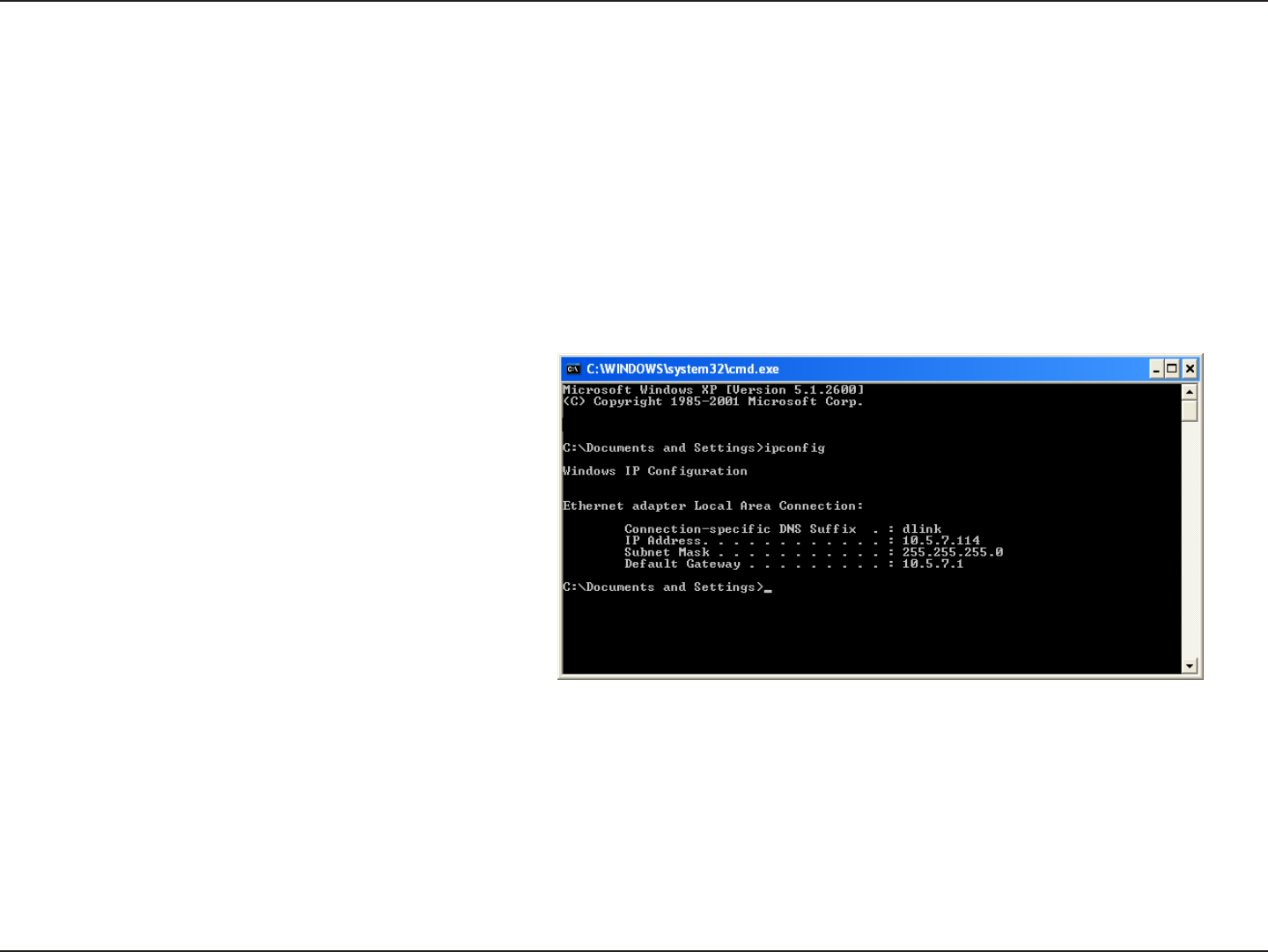
146D-Link DAP-1350 User Manual
Appendix B - Networking Basics
Networking Basics
Check your IP address
After you install your new D-Link adapter, by default, the TCP/IP settings should be set to obtain an IP address from a DHCP
server (i.e. wireless router) automatically. To verify your IP address, please follow the steps below.
Click on Start > Run. In the run box type cmd and click OK. (Windows® 7/ Vista® users type cmd in the Start Search box.)
At the prompt, type ipcong and press Enter.
This will display the IP address, subnet mask, and the
default gateway of your adapter.
If the address is 0.0.0.0, check your adapter installation,
security settings, and the settings on your access
point. Some rewall software programs may block a
DHCP request on newly installed adapters.
If you are connecting to a wireless network at a
hotspot (e.g. hotel, coffee shop, airport), please
contact an employee or administrator to verify their wireless network settings.
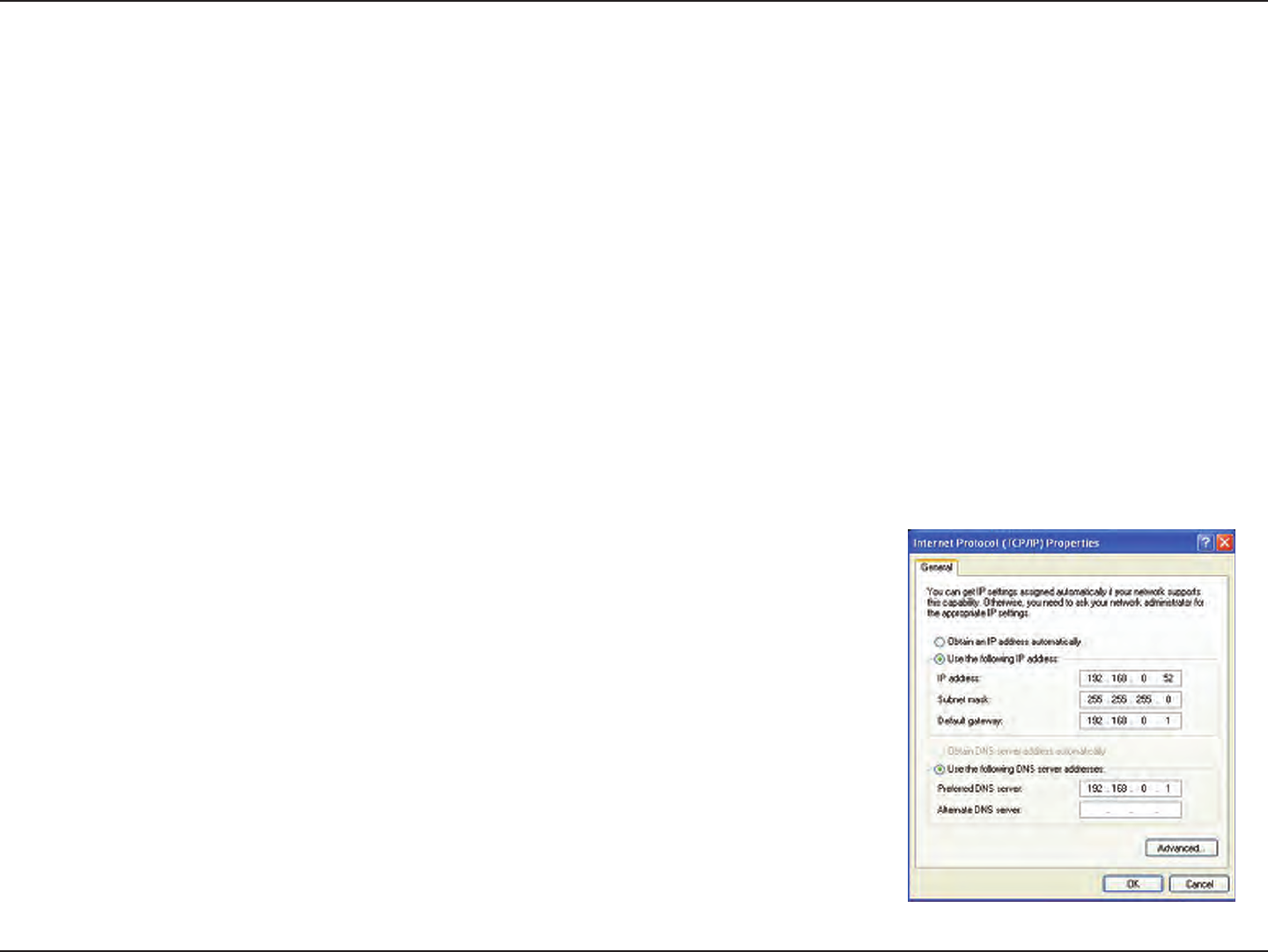
147D-Link DAP-1350 User Manual
Appendix B - Networking Basics
Statically Assign an IP address
If you are not using a DHCP capable gateway/router, or you need to assign a static IP address, please follow the steps below:
Step 1
Windows® 7 - Click on Start > Control Panel > Network and Internet > Network and Sharing Center > Change Adapter
Setting.
Windows Vista® - Click on Start > Control Panel > Network and Internet > Network and Sharing Center > Manage Network
Connections.
Windows® XP - Click on Start > Control Panel > Network Connections.
Windows® 2000 - From the desktop, right-click My Network Places > Properties.
Step 2
Right-click on the Local Area Connection which represents your network adapter and select Properties.
Step 3
Highlight Internet Protocol (TCP/IP) and click Properties.
Step 4
Click Use the following IP address and enter an IP address that is on the same subnet
as your network or the LAN IP address on your router.
Example: If the router´s LAN IP address is 192.168.0.1, make your IP address 192.168.0.X
where X is a number between 2 and 99. Make sure that the number you choose is not in
use on the network. Set Default Gateway the same as the LAN IP address of your router
(192.168.0.1).
Set Primary DNS the same as the LAN IP address of your router (192.168.0.1). The
Secondary DNS is not needed or you may enter a DNS server from your ISP.
Step 5
Click OK twice to save your settings.

148D-Link DAP-1350 User Manual
Appendix C - Technical Specications
Technical Specications
Standards
• IEEE 802.11n
• IEEE 802.11g
• IEEE 802.3
• IEEE 802.3u
Security
• Wi-Fi Protected Access (WPA, WPA2)®
• Wi-Fi Protected Setup™ (WPS)
- WPS Push Button
- PIN
Interface Type
• 1 10/100 LAN/WAN Port
• 1 USB Port for SharePort™
• 1 Push-Button (for Wi-Fi Protected Setup™)
Antenna Type
• Embedded Antennas
Wireless Signal Rates1
• 300Mbps • 108Mbps
• 54Mbps • 48Mbps
• 36Mbps • 24Mbps
• 18Mbps • 12Mbps
• 11Mbps • 9Mbps
• 6Mbps • 5.5Mbps
• 2Mbps • 1Mbps
Maximum Operating Voltage
• 5V 2.5A
Modulation
• DQPSK
• DBPSK
• CCK
• OFDM
Frequency Range2
• 2.4GHz to 2.483GHz
LEDs
• Power
• Ethernet
• WLAN
Operating Temperature
• 32°F to 104°F ( 0°C to 40°C )
Humidity
• 90% maximum (non-condensing)
Safety & Emissions
• FCC Class B
• IC
• Wi-Fi®
Dimensions
• W3.6” x D2.6” x H0.8” (91.4mm x 66mm x 20.3mm)
Weight
• 0.5lbs (0.23kg)
1Maximum wireless signal rate derived from IEEE Standard 802.11g and 802.11n specications. Actual data throughput will vary. Network conditions and environmental factors,
including volume of network trac, building materials and construction, and network overhead, lower actual data throughput rate. Environmental conditions will adversely
aect wireless signal range.
2Range varies depending on country’s regulation.

149D-Link DAP-1350 User Manual
Appendix E - Warranty
Warranty
CE Mark Warning:
This is a Class B product. In a domestic environment, this product may cause radio interference, in which case the user may be required
to take adequate measures.
Federal Communication Commission Interference Statement
This equipment has been tested and found to comply with the limits for a Class B digital device, pursuant to Part 15 of the FCC Rules.
These limits are designed to provide reasonable protection against harmful interference in a residential installation. This equipment
generates, uses and can radiate radio frequency energy and, if not installed and used in accordance with the instructions, may cause
harmful interference to radio communications. However, there is no guarantee that interference will not occur in a particular installation.
If this equipment does cause harmful interference to radio or television reception, which can be determined by turning the equipment off
and on, the user is encouraged to try to correct the interference by one of the following measures:
- Reorient or relocate the receiving antenna.
- Increase the separation between the equipment and receiver.
- Connect the equipment into an outlet on a circuit different from that to which the receiver is connected.
- Consult the dealer or an experienced radio/TV technician for help.
This device complies with Part 15 of the FCC Rules. Operation is subject to the following two conditions: (1) This device may not cause
harmful interference, and (2) this device must accept any interference received, including interference that may cause undesired operation.
FCC Caution: Any changes or modications not expressly approved by the party responsible for compliance could void the user’s authority
to operate this equipment.
IEEE 802.11b or 802.11g operation of this product in the U.S.A. is rmware-limited to channels 1 through 11.
IMPORTANT NOTE:
FCC Radiation Exposure Statement:
This equipment complies with FCC radiation exposure limits set forth for an uncontrolled environment. This equipment
should be installed and operated with minimum distance 20cm between the radiator & your body.
This transmitter must not be co-located or operating in conjunction with any other antenna or transmitter.

150D-Link DAP-1350 User Manual
Appendix E - Warranty
Industry Canada Statement
This device complies with RSS-210 of the Industry Canada Rules. Operation is subject to the following two conditions:
1) this device may not cause interference and
2) this device must accept any interference, including interference that may cause undesired operation of the device
IMPORTANT NOTE:
IC Radiation Exposure Statement:
This equipment complies with IC radiation exposure limits set forth for an uncontrolled environment. This equipment
should be installed and operated with minimum distance 20cm between the radiator and your body.
The availability of some specic channels and/or operational frequency bands are country dependent and are rmware programmed at
the factory to match the intended destination. The rmware setting is not accessible by the end user.
For Taiwan 警語:
經型式認證合格之低功率射頻電機,非經許可,公司、商號或使用者均不得擅自變更頻率、加大功率或變更原設計之特性及功能。
低功率射頻電機之使用不得影響飛航安全及干擾合法通信;經發現有干擾現象時,應立即停用,並改善至無干擾時方得繼續使用。前項合
法通信,指依電信法規定作業之無線電通信。低功率射頻電機須忍受合法通信或工業、科學及醫療用電波輻射性電機設備之干擾。